Impact of Social Media Marketing Analysis 2022
VerifiedAdded on 2022/09/23
|105
|23526
|64
AI Summary
A critical analysis on how digital marketing can affect Consumer Behavior. I'm uploading Structure of dissertation to be followed. My research proposal file And a sample dissertation of my friend. Please follow all this file instructions.
Contribute Materials
Your contribution can guide someone’s learning journey. Share your
documents today.
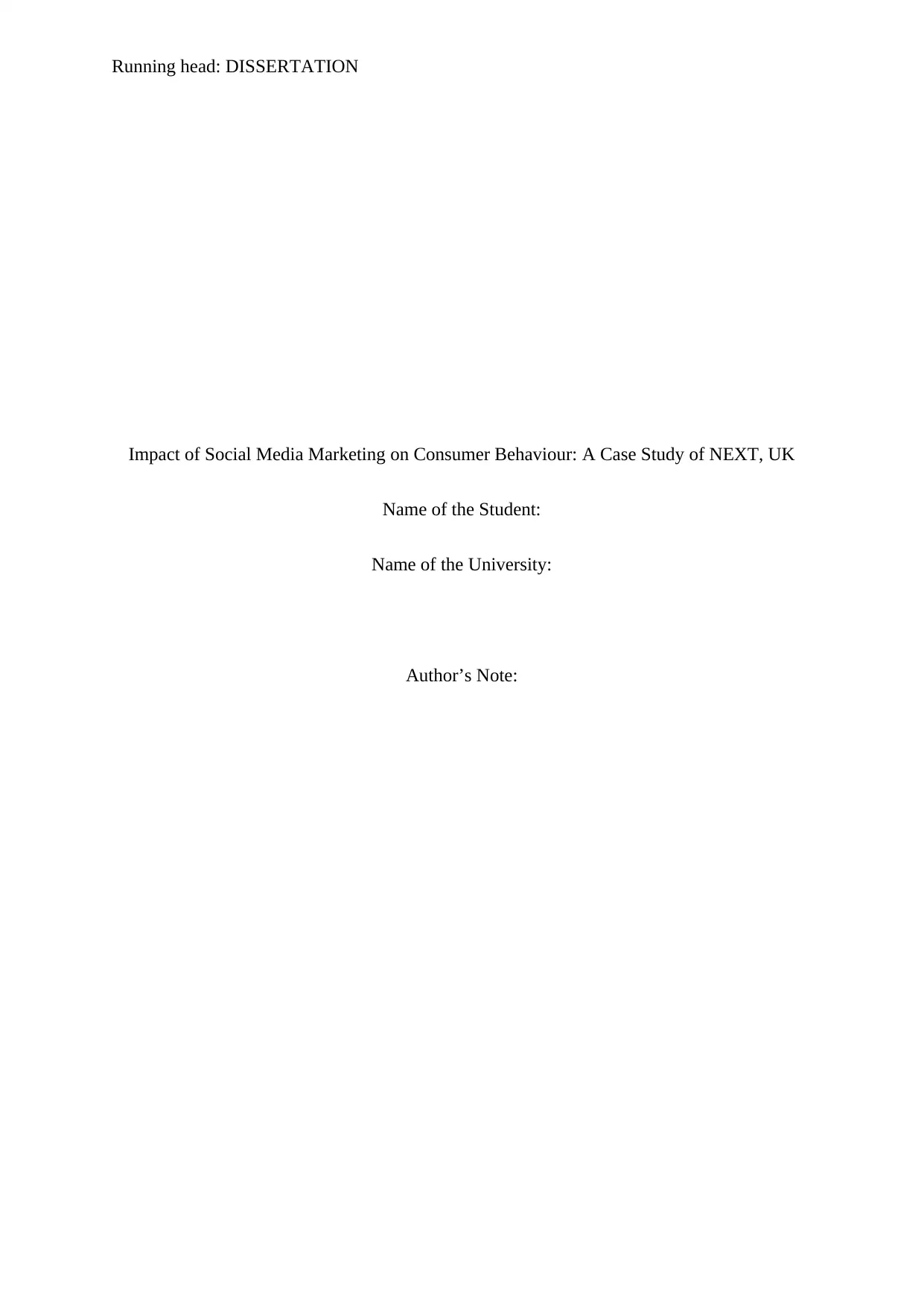
Running head: DISSERTATION
Impact of Social Media Marketing on Consumer Behaviour: A Case Study of NEXT, UK
Name of the Student:
Name of the University:
Author’s Note:
Impact of Social Media Marketing on Consumer Behaviour: A Case Study of NEXT, UK
Name of the Student:
Name of the University:
Author’s Note:
Secure Best Marks with AI Grader
Need help grading? Try our AI Grader for instant feedback on your assignments.
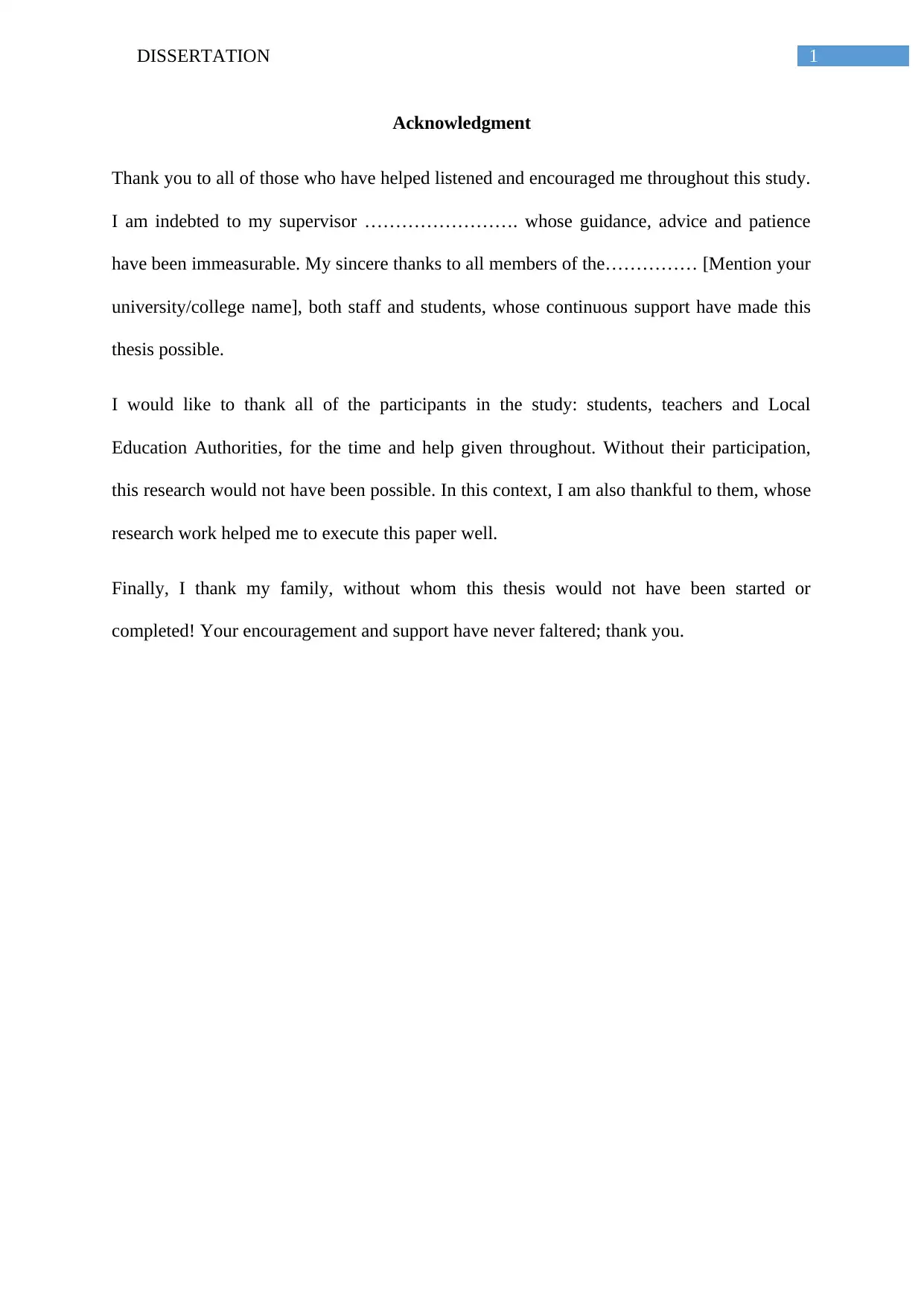
1DISSERTATION
Acknowledgment
Thank you to all of those who have helped listened and encouraged me throughout this study.
I am indebted to my supervisor ……………………. whose guidance, advice and patience
have been immeasurable. My sincere thanks to all members of the…………… [Mention your
university/college name], both staff and students, whose continuous support have made this
thesis possible.
I would like to thank all of the participants in the study: students, teachers and Local
Education Authorities, for the time and help given throughout. Without their participation,
this research would not have been possible. In this context, I am also thankful to them, whose
research work helped me to execute this paper well.
Finally, I thank my family, without whom this thesis would not have been started or
completed! Your encouragement and support have never faltered; thank you.
Acknowledgment
Thank you to all of those who have helped listened and encouraged me throughout this study.
I am indebted to my supervisor ……………………. whose guidance, advice and patience
have been immeasurable. My sincere thanks to all members of the…………… [Mention your
university/college name], both staff and students, whose continuous support have made this
thesis possible.
I would like to thank all of the participants in the study: students, teachers and Local
Education Authorities, for the time and help given throughout. Without their participation,
this research would not have been possible. In this context, I am also thankful to them, whose
research work helped me to execute this paper well.
Finally, I thank my family, without whom this thesis would not have been started or
completed! Your encouragement and support have never faltered; thank you.
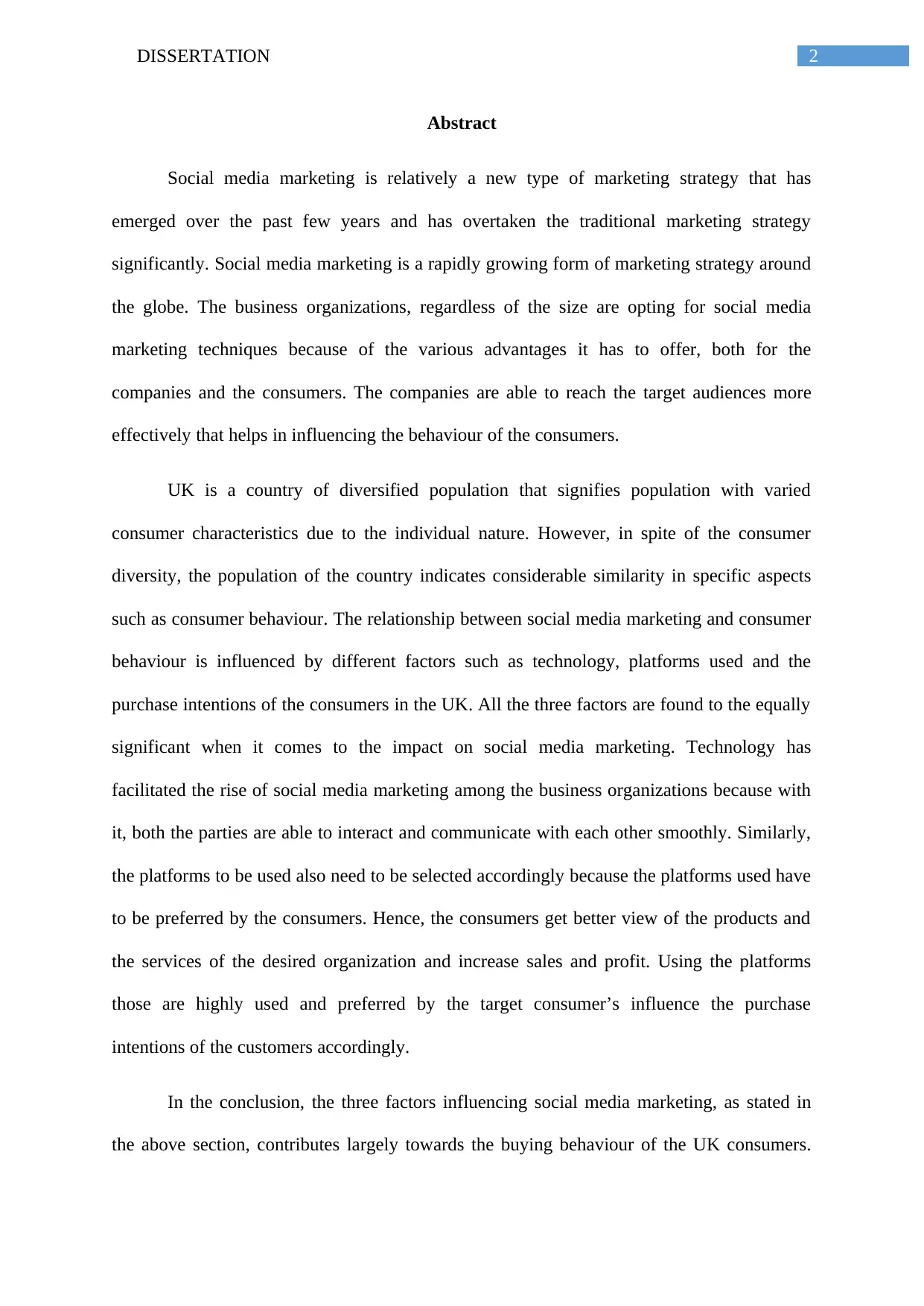
2DISSERTATION
Abstract
Social media marketing is relatively a new type of marketing strategy that has
emerged over the past few years and has overtaken the traditional marketing strategy
significantly. Social media marketing is a rapidly growing form of marketing strategy around
the globe. The business organizations, regardless of the size are opting for social media
marketing techniques because of the various advantages it has to offer, both for the
companies and the consumers. The companies are able to reach the target audiences more
effectively that helps in influencing the behaviour of the consumers.
UK is a country of diversified population that signifies population with varied
consumer characteristics due to the individual nature. However, in spite of the consumer
diversity, the population of the country indicates considerable similarity in specific aspects
such as consumer behaviour. The relationship between social media marketing and consumer
behaviour is influenced by different factors such as technology, platforms used and the
purchase intentions of the consumers in the UK. All the three factors are found to the equally
significant when it comes to the impact on social media marketing. Technology has
facilitated the rise of social media marketing among the business organizations because with
it, both the parties are able to interact and communicate with each other smoothly. Similarly,
the platforms to be used also need to be selected accordingly because the platforms used have
to be preferred by the consumers. Hence, the consumers get better view of the products and
the services of the desired organization and increase sales and profit. Using the platforms
those are highly used and preferred by the target consumer’s influence the purchase
intentions of the customers accordingly.
In the conclusion, the three factors influencing social media marketing, as stated in
the above section, contributes largely towards the buying behaviour of the UK consumers.
Abstract
Social media marketing is relatively a new type of marketing strategy that has
emerged over the past few years and has overtaken the traditional marketing strategy
significantly. Social media marketing is a rapidly growing form of marketing strategy around
the globe. The business organizations, regardless of the size are opting for social media
marketing techniques because of the various advantages it has to offer, both for the
companies and the consumers. The companies are able to reach the target audiences more
effectively that helps in influencing the behaviour of the consumers.
UK is a country of diversified population that signifies population with varied
consumer characteristics due to the individual nature. However, in spite of the consumer
diversity, the population of the country indicates considerable similarity in specific aspects
such as consumer behaviour. The relationship between social media marketing and consumer
behaviour is influenced by different factors such as technology, platforms used and the
purchase intentions of the consumers in the UK. All the three factors are found to the equally
significant when it comes to the impact on social media marketing. Technology has
facilitated the rise of social media marketing among the business organizations because with
it, both the parties are able to interact and communicate with each other smoothly. Similarly,
the platforms to be used also need to be selected accordingly because the platforms used have
to be preferred by the consumers. Hence, the consumers get better view of the products and
the services of the desired organization and increase sales and profit. Using the platforms
those are highly used and preferred by the target consumer’s influence the purchase
intentions of the customers accordingly.
In the conclusion, the three factors influencing social media marketing, as stated in
the above section, contributes largely towards the buying behaviour of the UK consumers.
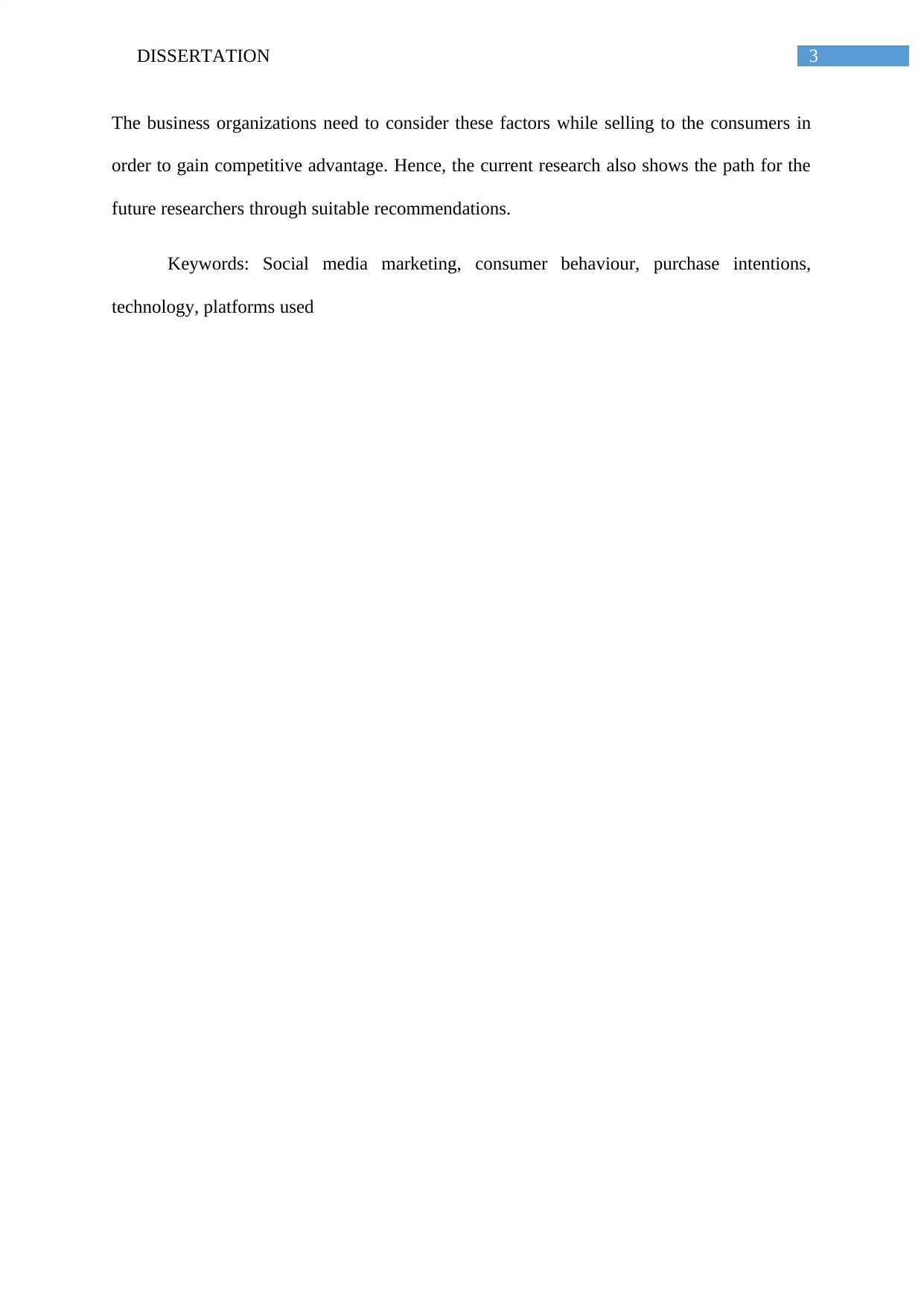
3DISSERTATION
The business organizations need to consider these factors while selling to the consumers in
order to gain competitive advantage. Hence, the current research also shows the path for the
future researchers through suitable recommendations.
Keywords: Social media marketing, consumer behaviour, purchase intentions,
technology, platforms used
The business organizations need to consider these factors while selling to the consumers in
order to gain competitive advantage. Hence, the current research also shows the path for the
future researchers through suitable recommendations.
Keywords: Social media marketing, consumer behaviour, purchase intentions,
technology, platforms used
Secure Best Marks with AI Grader
Need help grading? Try our AI Grader for instant feedback on your assignments.
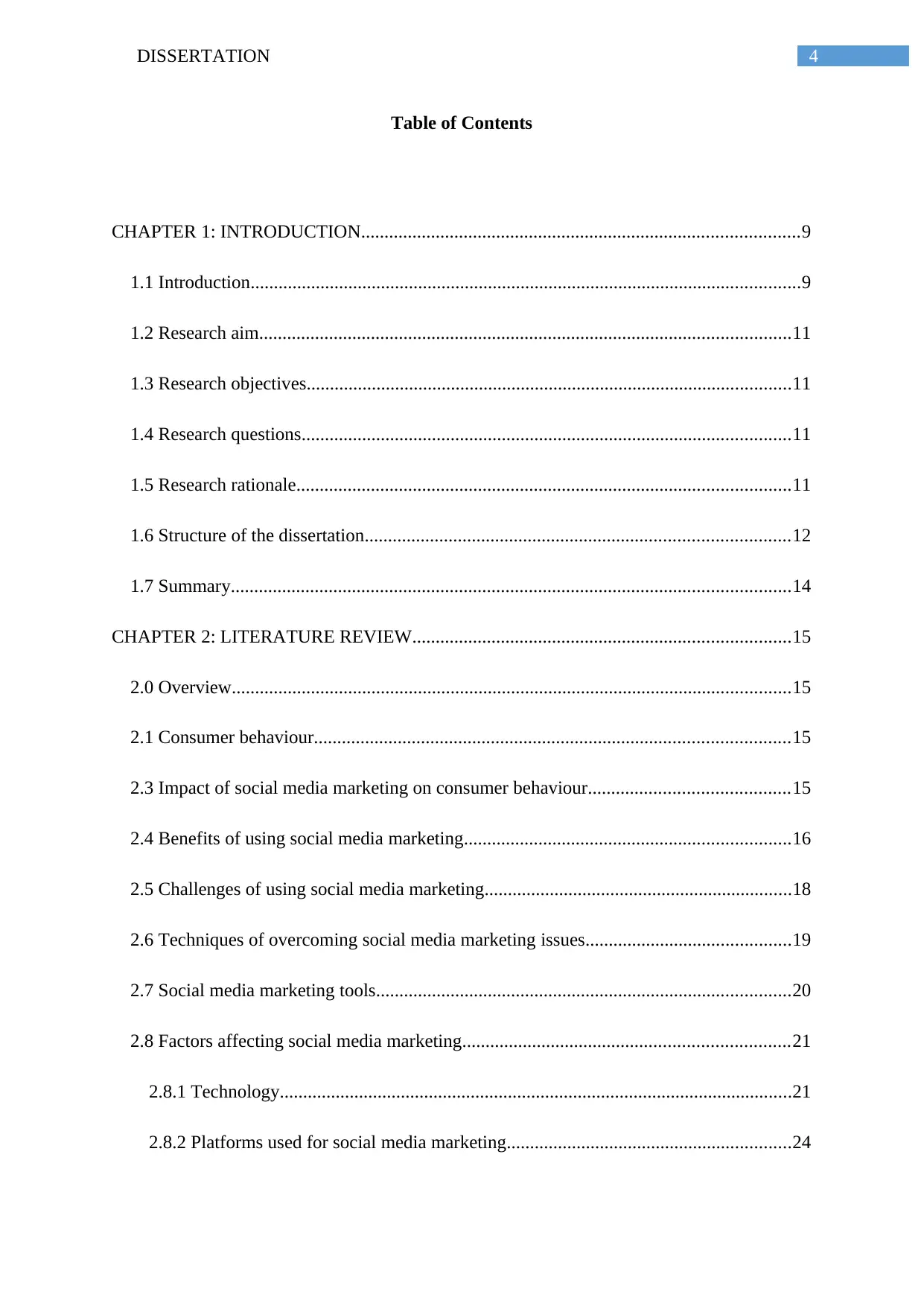
4DISSERTATION
Table of Contents
CHAPTER 1: INTRODUCTION..............................................................................................9
1.1 Introduction......................................................................................................................9
1.2 Research aim..................................................................................................................11
1.3 Research objectives........................................................................................................11
1.4 Research questions.........................................................................................................11
1.5 Research rationale..........................................................................................................11
1.6 Structure of the dissertation...........................................................................................12
1.7 Summary........................................................................................................................14
CHAPTER 2: LITERATURE REVIEW.................................................................................15
2.0 Overview........................................................................................................................15
2.1 Consumer behaviour......................................................................................................15
2.3 Impact of social media marketing on consumer behaviour...........................................15
2.4 Benefits of using social media marketing......................................................................16
2.5 Challenges of using social media marketing..................................................................18
2.6 Techniques of overcoming social media marketing issues............................................19
2.7 Social media marketing tools.........................................................................................20
2.8 Factors affecting social media marketing......................................................................21
2.8.1 Technology..............................................................................................................21
2.8.2 Platforms used for social media marketing.............................................................24
Table of Contents
CHAPTER 1: INTRODUCTION..............................................................................................9
1.1 Introduction......................................................................................................................9
1.2 Research aim..................................................................................................................11
1.3 Research objectives........................................................................................................11
1.4 Research questions.........................................................................................................11
1.5 Research rationale..........................................................................................................11
1.6 Structure of the dissertation...........................................................................................12
1.7 Summary........................................................................................................................14
CHAPTER 2: LITERATURE REVIEW.................................................................................15
2.0 Overview........................................................................................................................15
2.1 Consumer behaviour......................................................................................................15
2.3 Impact of social media marketing on consumer behaviour...........................................15
2.4 Benefits of using social media marketing......................................................................16
2.5 Challenges of using social media marketing..................................................................18
2.6 Techniques of overcoming social media marketing issues............................................19
2.7 Social media marketing tools.........................................................................................20
2.8 Factors affecting social media marketing......................................................................21
2.8.1 Technology..............................................................................................................21
2.8.2 Platforms used for social media marketing.............................................................24
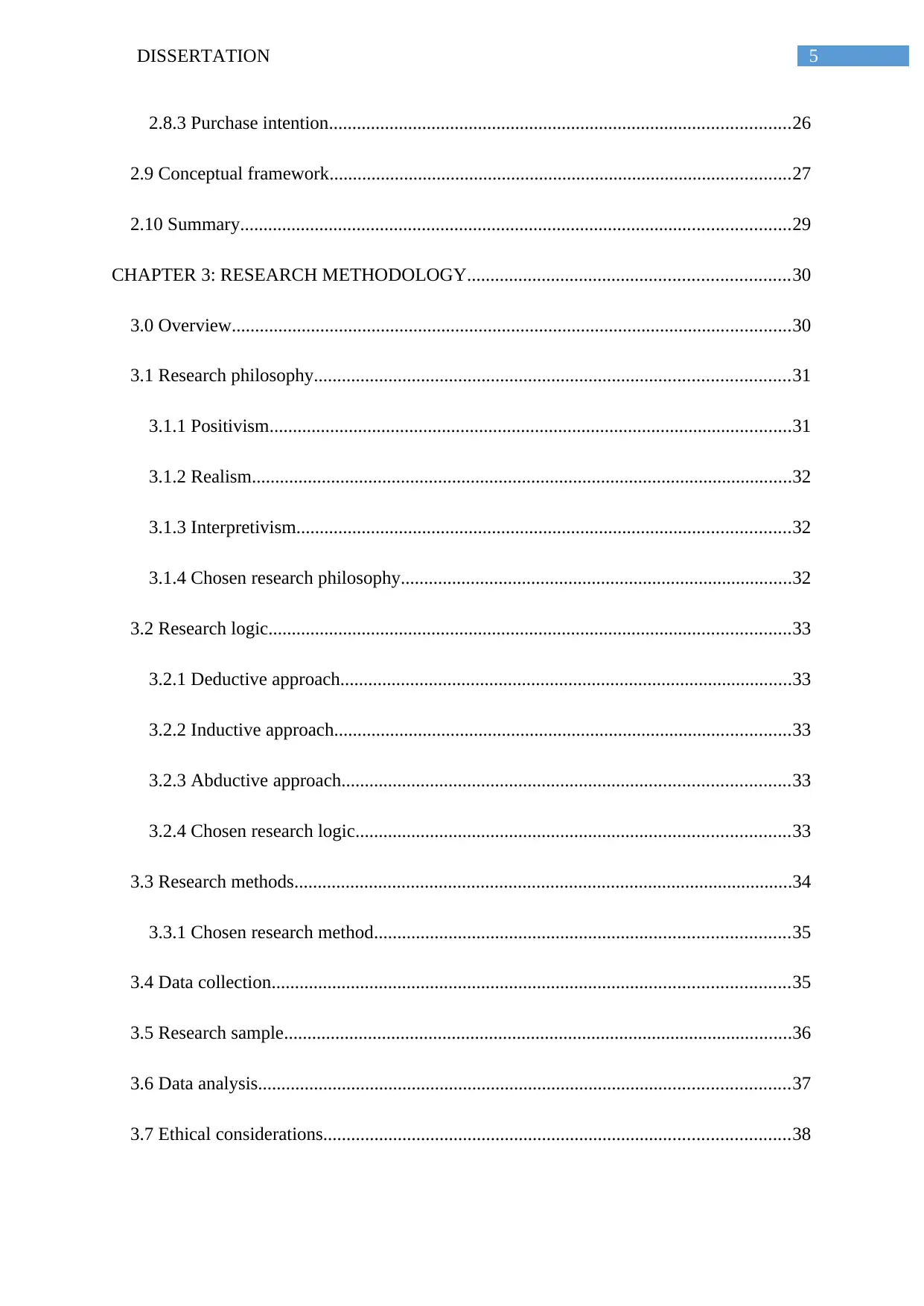
5DISSERTATION
2.8.3 Purchase intention...................................................................................................26
2.9 Conceptual framework...................................................................................................27
2.10 Summary......................................................................................................................29
CHAPTER 3: RESEARCH METHODOLOGY.....................................................................30
3.0 Overview........................................................................................................................30
3.1 Research philosophy......................................................................................................31
3.1.1 Positivism................................................................................................................31
3.1.2 Realism....................................................................................................................32
3.1.3 Interpretivism..........................................................................................................32
3.1.4 Chosen research philosophy....................................................................................32
3.2 Research logic................................................................................................................33
3.2.1 Deductive approach.................................................................................................33
3.2.2 Inductive approach..................................................................................................33
3.2.3 Abductive approach................................................................................................33
3.2.4 Chosen research logic.............................................................................................33
3.3 Research methods...........................................................................................................34
3.3.1 Chosen research method.........................................................................................35
3.4 Data collection...............................................................................................................35
3.5 Research sample.............................................................................................................36
3.6 Data analysis..................................................................................................................37
3.7 Ethical considerations....................................................................................................38
2.8.3 Purchase intention...................................................................................................26
2.9 Conceptual framework...................................................................................................27
2.10 Summary......................................................................................................................29
CHAPTER 3: RESEARCH METHODOLOGY.....................................................................30
3.0 Overview........................................................................................................................30
3.1 Research philosophy......................................................................................................31
3.1.1 Positivism................................................................................................................31
3.1.2 Realism....................................................................................................................32
3.1.3 Interpretivism..........................................................................................................32
3.1.4 Chosen research philosophy....................................................................................32
3.2 Research logic................................................................................................................33
3.2.1 Deductive approach.................................................................................................33
3.2.2 Inductive approach..................................................................................................33
3.2.3 Abductive approach................................................................................................33
3.2.4 Chosen research logic.............................................................................................33
3.3 Research methods...........................................................................................................34
3.3.1 Chosen research method.........................................................................................35
3.4 Data collection...............................................................................................................35
3.5 Research sample.............................................................................................................36
3.6 Data analysis..................................................................................................................37
3.7 Ethical considerations....................................................................................................38
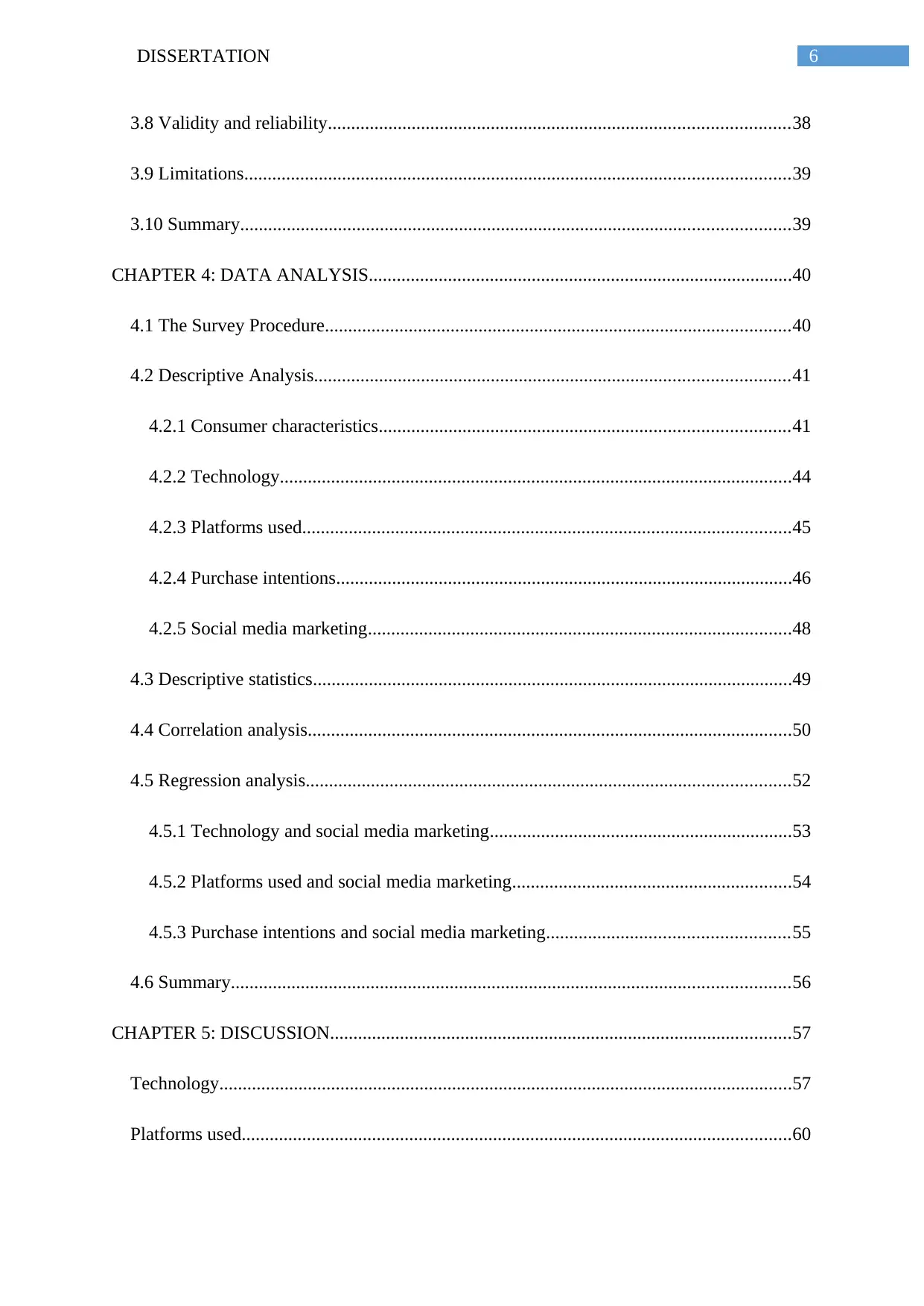
6DISSERTATION
3.8 Validity and reliability...................................................................................................38
3.9 Limitations.....................................................................................................................39
3.10 Summary......................................................................................................................39
CHAPTER 4: DATA ANALYSIS...........................................................................................40
4.1 The Survey Procedure....................................................................................................40
4.2 Descriptive Analysis......................................................................................................41
4.2.1 Consumer characteristics........................................................................................41
4.2.2 Technology..............................................................................................................44
4.2.3 Platforms used.........................................................................................................45
4.2.4 Purchase intentions..................................................................................................46
4.2.5 Social media marketing...........................................................................................48
4.3 Descriptive statistics.......................................................................................................49
4.4 Correlation analysis........................................................................................................50
4.5 Regression analysis........................................................................................................52
4.5.1 Technology and social media marketing.................................................................53
4.5.2 Platforms used and social media marketing............................................................54
4.5.3 Purchase intentions and social media marketing....................................................55
4.6 Summary........................................................................................................................56
CHAPTER 5: DISCUSSION...................................................................................................57
Technology...........................................................................................................................57
Platforms used......................................................................................................................60
3.8 Validity and reliability...................................................................................................38
3.9 Limitations.....................................................................................................................39
3.10 Summary......................................................................................................................39
CHAPTER 4: DATA ANALYSIS...........................................................................................40
4.1 The Survey Procedure....................................................................................................40
4.2 Descriptive Analysis......................................................................................................41
4.2.1 Consumer characteristics........................................................................................41
4.2.2 Technology..............................................................................................................44
4.2.3 Platforms used.........................................................................................................45
4.2.4 Purchase intentions..................................................................................................46
4.2.5 Social media marketing...........................................................................................48
4.3 Descriptive statistics.......................................................................................................49
4.4 Correlation analysis........................................................................................................50
4.5 Regression analysis........................................................................................................52
4.5.1 Technology and social media marketing.................................................................53
4.5.2 Platforms used and social media marketing............................................................54
4.5.3 Purchase intentions and social media marketing....................................................55
4.6 Summary........................................................................................................................56
CHAPTER 5: DISCUSSION...................................................................................................57
Technology...........................................................................................................................57
Platforms used......................................................................................................................60
Paraphrase This Document
Need a fresh take? Get an instant paraphrase of this document with our AI Paraphraser
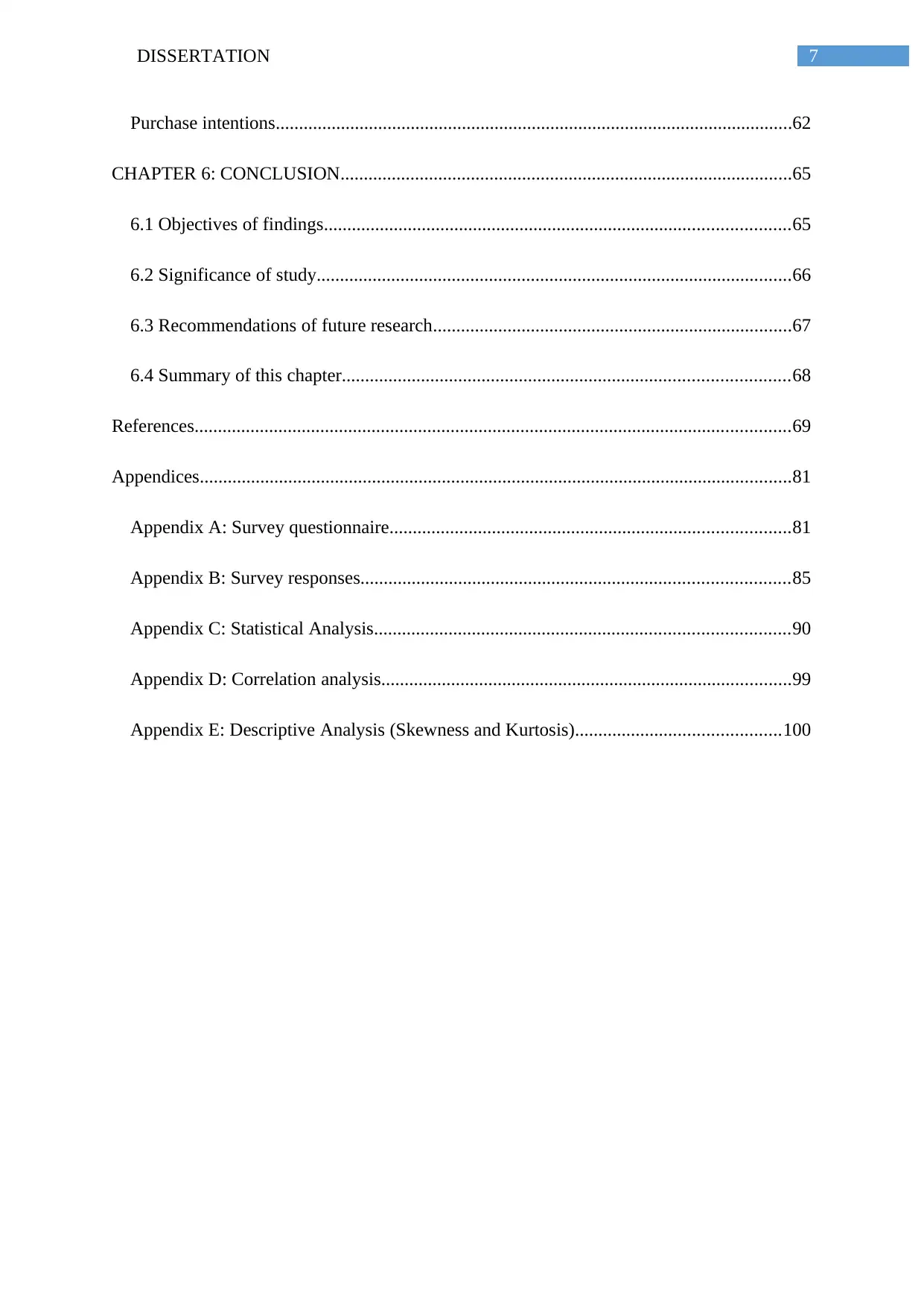
7DISSERTATION
Purchase intentions...............................................................................................................62
CHAPTER 6: CONCLUSION.................................................................................................65
6.1 Objectives of findings....................................................................................................65
6.2 Significance of study......................................................................................................66
6.3 Recommendations of future research.............................................................................67
6.4 Summary of this chapter................................................................................................68
References................................................................................................................................69
Appendices...............................................................................................................................81
Appendix A: Survey questionnaire......................................................................................81
Appendix B: Survey responses............................................................................................85
Appendix C: Statistical Analysis.........................................................................................90
Appendix D: Correlation analysis........................................................................................99
Appendix E: Descriptive Analysis (Skewness and Kurtosis)............................................100
Purchase intentions...............................................................................................................62
CHAPTER 6: CONCLUSION.................................................................................................65
6.1 Objectives of findings....................................................................................................65
6.2 Significance of study......................................................................................................66
6.3 Recommendations of future research.............................................................................67
6.4 Summary of this chapter................................................................................................68
References................................................................................................................................69
Appendices...............................................................................................................................81
Appendix A: Survey questionnaire......................................................................................81
Appendix B: Survey responses............................................................................................85
Appendix C: Statistical Analysis.........................................................................................90
Appendix D: Correlation analysis........................................................................................99
Appendix E: Descriptive Analysis (Skewness and Kurtosis)............................................100
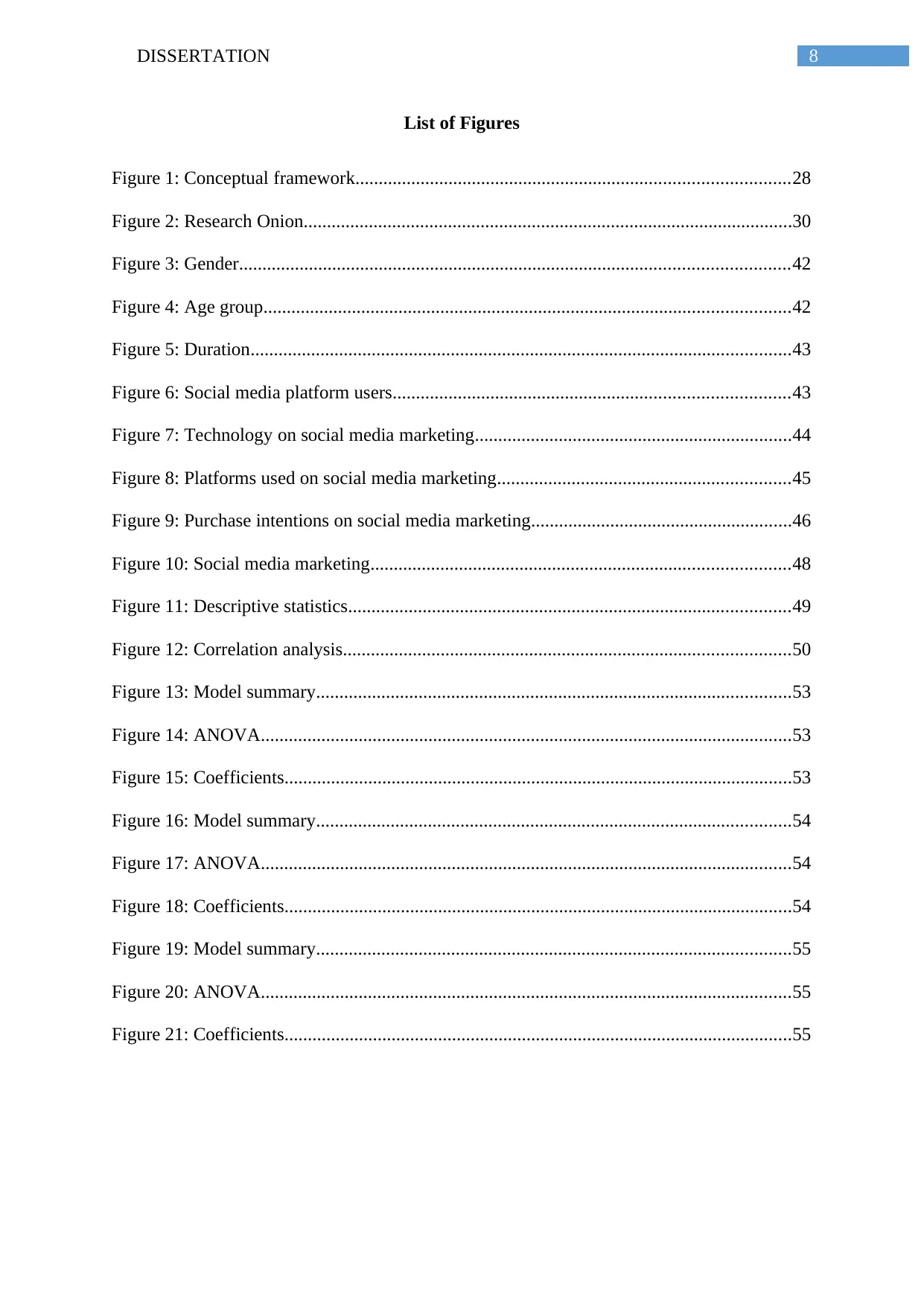
8DISSERTATION
List of Figures
Figure 1: Conceptual framework.............................................................................................28
Figure 2: Research Onion.........................................................................................................30
Figure 3: Gender......................................................................................................................42
Figure 4: Age group.................................................................................................................42
Figure 5: Duration....................................................................................................................43
Figure 6: Social media platform users.....................................................................................43
Figure 7: Technology on social media marketing....................................................................44
Figure 8: Platforms used on social media marketing...............................................................45
Figure 9: Purchase intentions on social media marketing........................................................46
Figure 10: Social media marketing..........................................................................................48
Figure 11: Descriptive statistics...............................................................................................49
Figure 12: Correlation analysis................................................................................................50
Figure 13: Model summary......................................................................................................53
Figure 14: ANOVA..................................................................................................................53
Figure 15: Coefficients.............................................................................................................53
Figure 16: Model summary......................................................................................................54
Figure 17: ANOVA..................................................................................................................54
Figure 18: Coefficients.............................................................................................................54
Figure 19: Model summary......................................................................................................55
Figure 20: ANOVA..................................................................................................................55
Figure 21: Coefficients.............................................................................................................55
List of Figures
Figure 1: Conceptual framework.............................................................................................28
Figure 2: Research Onion.........................................................................................................30
Figure 3: Gender......................................................................................................................42
Figure 4: Age group.................................................................................................................42
Figure 5: Duration....................................................................................................................43
Figure 6: Social media platform users.....................................................................................43
Figure 7: Technology on social media marketing....................................................................44
Figure 8: Platforms used on social media marketing...............................................................45
Figure 9: Purchase intentions on social media marketing........................................................46
Figure 10: Social media marketing..........................................................................................48
Figure 11: Descriptive statistics...............................................................................................49
Figure 12: Correlation analysis................................................................................................50
Figure 13: Model summary......................................................................................................53
Figure 14: ANOVA..................................................................................................................53
Figure 15: Coefficients.............................................................................................................53
Figure 16: Model summary......................................................................................................54
Figure 17: ANOVA..................................................................................................................54
Figure 18: Coefficients.............................................................................................................54
Figure 19: Model summary......................................................................................................55
Figure 20: ANOVA..................................................................................................................55
Figure 21: Coefficients.............................................................................................................55
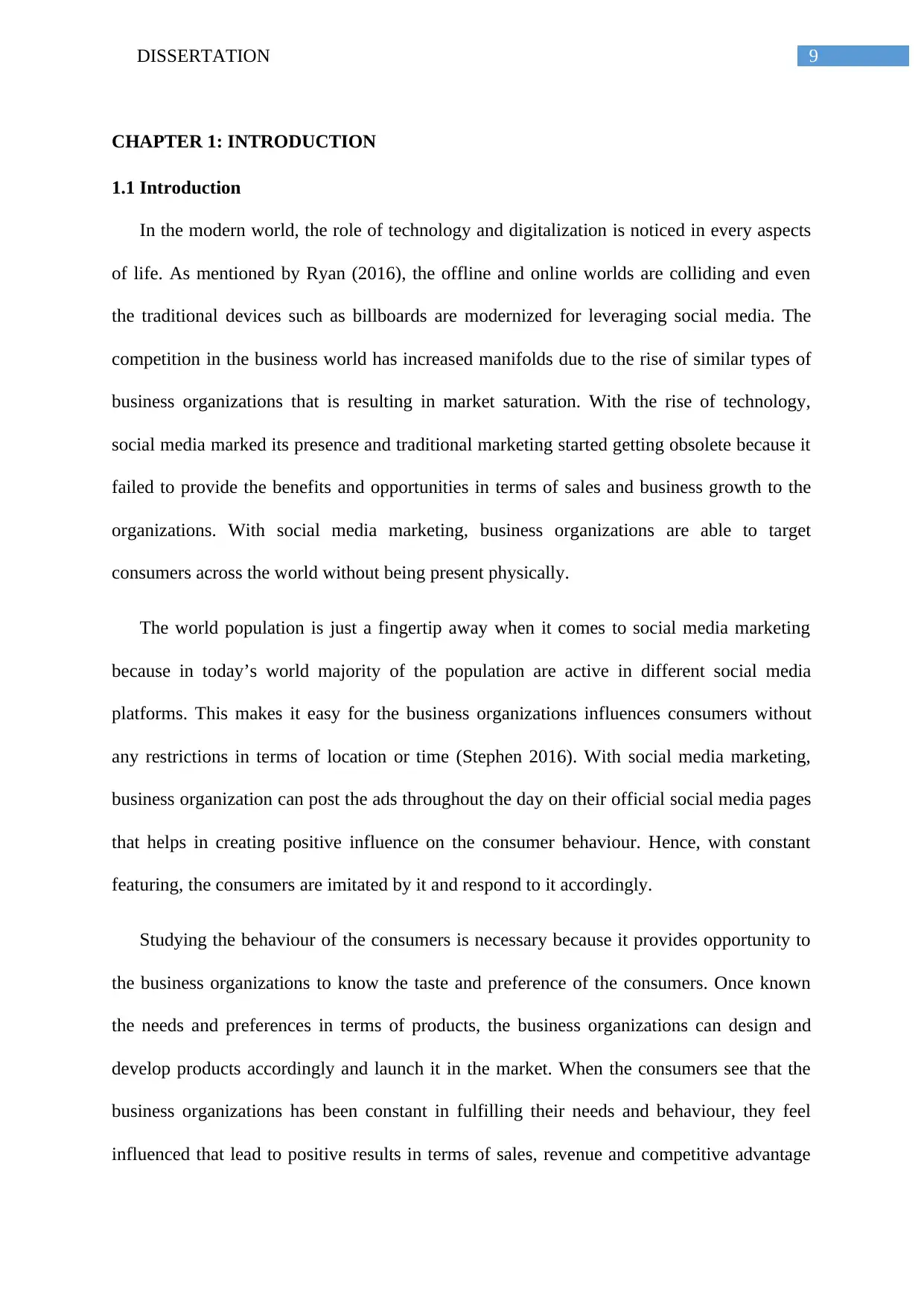
9DISSERTATION
CHAPTER 1: INTRODUCTION
1.1 Introduction
In the modern world, the role of technology and digitalization is noticed in every aspects
of life. As mentioned by Ryan (2016), the offline and online worlds are colliding and even
the traditional devices such as billboards are modernized for leveraging social media. The
competition in the business world has increased manifolds due to the rise of similar types of
business organizations that is resulting in market saturation. With the rise of technology,
social media marked its presence and traditional marketing started getting obsolete because it
failed to provide the benefits and opportunities in terms of sales and business growth to the
organizations. With social media marketing, business organizations are able to target
consumers across the world without being present physically.
The world population is just a fingertip away when it comes to social media marketing
because in today’s world majority of the population are active in different social media
platforms. This makes it easy for the business organizations influences consumers without
any restrictions in terms of location or time (Stephen 2016). With social media marketing,
business organization can post the ads throughout the day on their official social media pages
that helps in creating positive influence on the consumer behaviour. Hence, with constant
featuring, the consumers are imitated by it and respond to it accordingly.
Studying the behaviour of the consumers is necessary because it provides opportunity to
the business organizations to know the taste and preference of the consumers. Once known
the needs and preferences in terms of products, the business organizations can design and
develop products accordingly and launch it in the market. When the consumers see that the
business organizations has been constant in fulfilling their needs and behaviour, they feel
influenced that lead to positive results in terms of sales, revenue and competitive advantage
CHAPTER 1: INTRODUCTION
1.1 Introduction
In the modern world, the role of technology and digitalization is noticed in every aspects
of life. As mentioned by Ryan (2016), the offline and online worlds are colliding and even
the traditional devices such as billboards are modernized for leveraging social media. The
competition in the business world has increased manifolds due to the rise of similar types of
business organizations that is resulting in market saturation. With the rise of technology,
social media marked its presence and traditional marketing started getting obsolete because it
failed to provide the benefits and opportunities in terms of sales and business growth to the
organizations. With social media marketing, business organizations are able to target
consumers across the world without being present physically.
The world population is just a fingertip away when it comes to social media marketing
because in today’s world majority of the population are active in different social media
platforms. This makes it easy for the business organizations influences consumers without
any restrictions in terms of location or time (Stephen 2016). With social media marketing,
business organization can post the ads throughout the day on their official social media pages
that helps in creating positive influence on the consumer behaviour. Hence, with constant
featuring, the consumers are imitated by it and respond to it accordingly.
Studying the behaviour of the consumers is necessary because it provides opportunity to
the business organizations to know the taste and preference of the consumers. Once known
the needs and preferences in terms of products, the business organizations can design and
develop products accordingly and launch it in the market. When the consumers see that the
business organizations has been constant in fulfilling their needs and behaviour, they feel
influenced that lead to positive results in terms of sales, revenue and competitive advantage
Secure Best Marks with AI Grader
Need help grading? Try our AI Grader for instant feedback on your assignments.
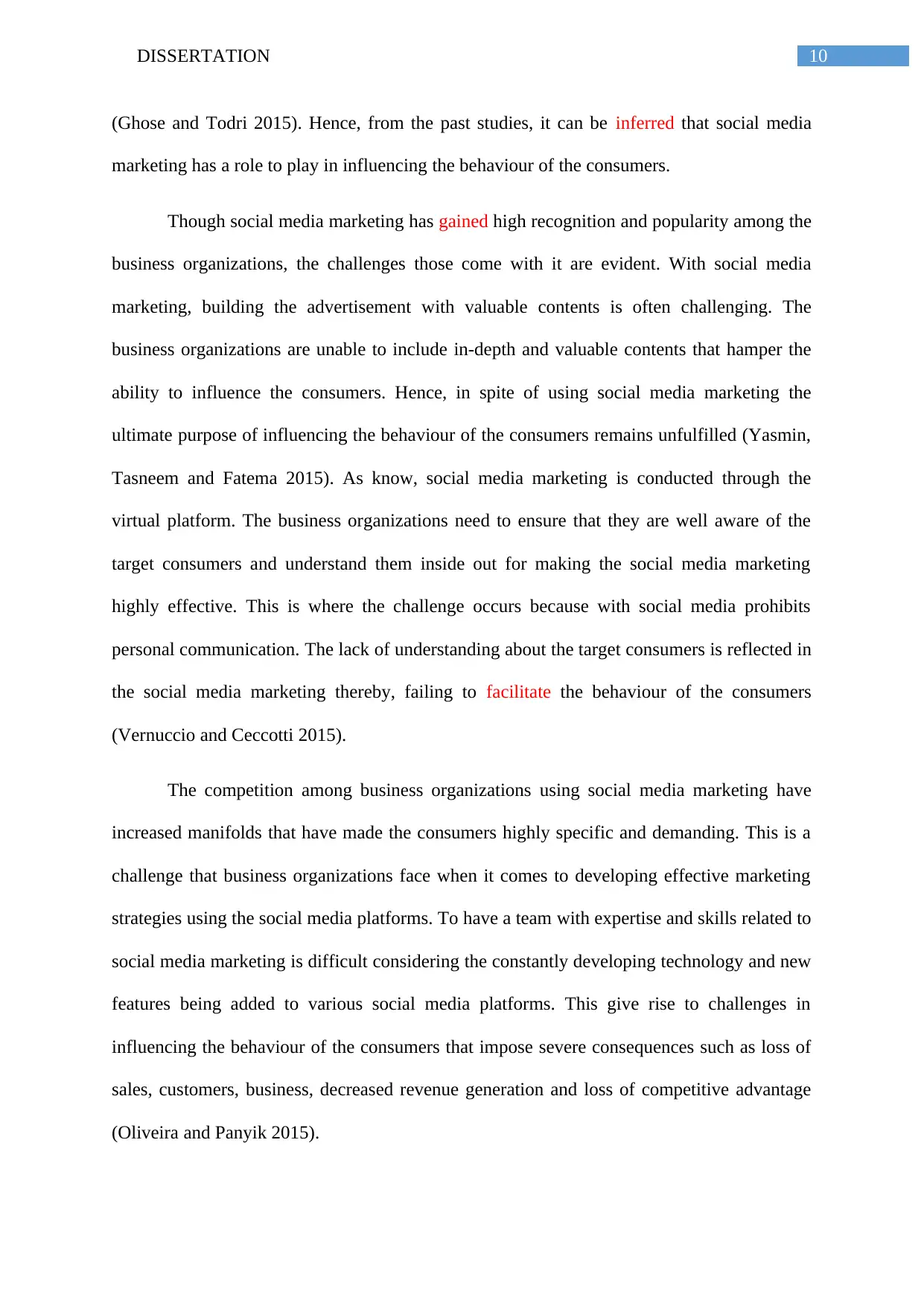
10DISSERTATION
(Ghose and Todri 2015). Hence, from the past studies, it can be inferred that social media
marketing has a role to play in influencing the behaviour of the consumers.
Though social media marketing has gained high recognition and popularity among the
business organizations, the challenges those come with it are evident. With social media
marketing, building the advertisement with valuable contents is often challenging. The
business organizations are unable to include in-depth and valuable contents that hamper the
ability to influence the consumers. Hence, in spite of using social media marketing the
ultimate purpose of influencing the behaviour of the consumers remains unfulfilled (Yasmin,
Tasneem and Fatema 2015). As know, social media marketing is conducted through the
virtual platform. The business organizations need to ensure that they are well aware of the
target consumers and understand them inside out for making the social media marketing
highly effective. This is where the challenge occurs because with social media prohibits
personal communication. The lack of understanding about the target consumers is reflected in
the social media marketing thereby, failing to facilitate the behaviour of the consumers
(Vernuccio and Ceccotti 2015).
The competition among business organizations using social media marketing have
increased manifolds that have made the consumers highly specific and demanding. This is a
challenge that business organizations face when it comes to developing effective marketing
strategies using the social media platforms. To have a team with expertise and skills related to
social media marketing is difficult considering the constantly developing technology and new
features being added to various social media platforms. This give rise to challenges in
influencing the behaviour of the consumers that impose severe consequences such as loss of
sales, customers, business, decreased revenue generation and loss of competitive advantage
(Oliveira and Panyik 2015).
(Ghose and Todri 2015). Hence, from the past studies, it can be inferred that social media
marketing has a role to play in influencing the behaviour of the consumers.
Though social media marketing has gained high recognition and popularity among the
business organizations, the challenges those come with it are evident. With social media
marketing, building the advertisement with valuable contents is often challenging. The
business organizations are unable to include in-depth and valuable contents that hamper the
ability to influence the consumers. Hence, in spite of using social media marketing the
ultimate purpose of influencing the behaviour of the consumers remains unfulfilled (Yasmin,
Tasneem and Fatema 2015). As know, social media marketing is conducted through the
virtual platform. The business organizations need to ensure that they are well aware of the
target consumers and understand them inside out for making the social media marketing
highly effective. This is where the challenge occurs because with social media prohibits
personal communication. The lack of understanding about the target consumers is reflected in
the social media marketing thereby, failing to facilitate the behaviour of the consumers
(Vernuccio and Ceccotti 2015).
The competition among business organizations using social media marketing have
increased manifolds that have made the consumers highly specific and demanding. This is a
challenge that business organizations face when it comes to developing effective marketing
strategies using the social media platforms. To have a team with expertise and skills related to
social media marketing is difficult considering the constantly developing technology and new
features being added to various social media platforms. This give rise to challenges in
influencing the behaviour of the consumers that impose severe consequences such as loss of
sales, customers, business, decreased revenue generation and loss of competitive advantage
(Oliveira and Panyik 2015).
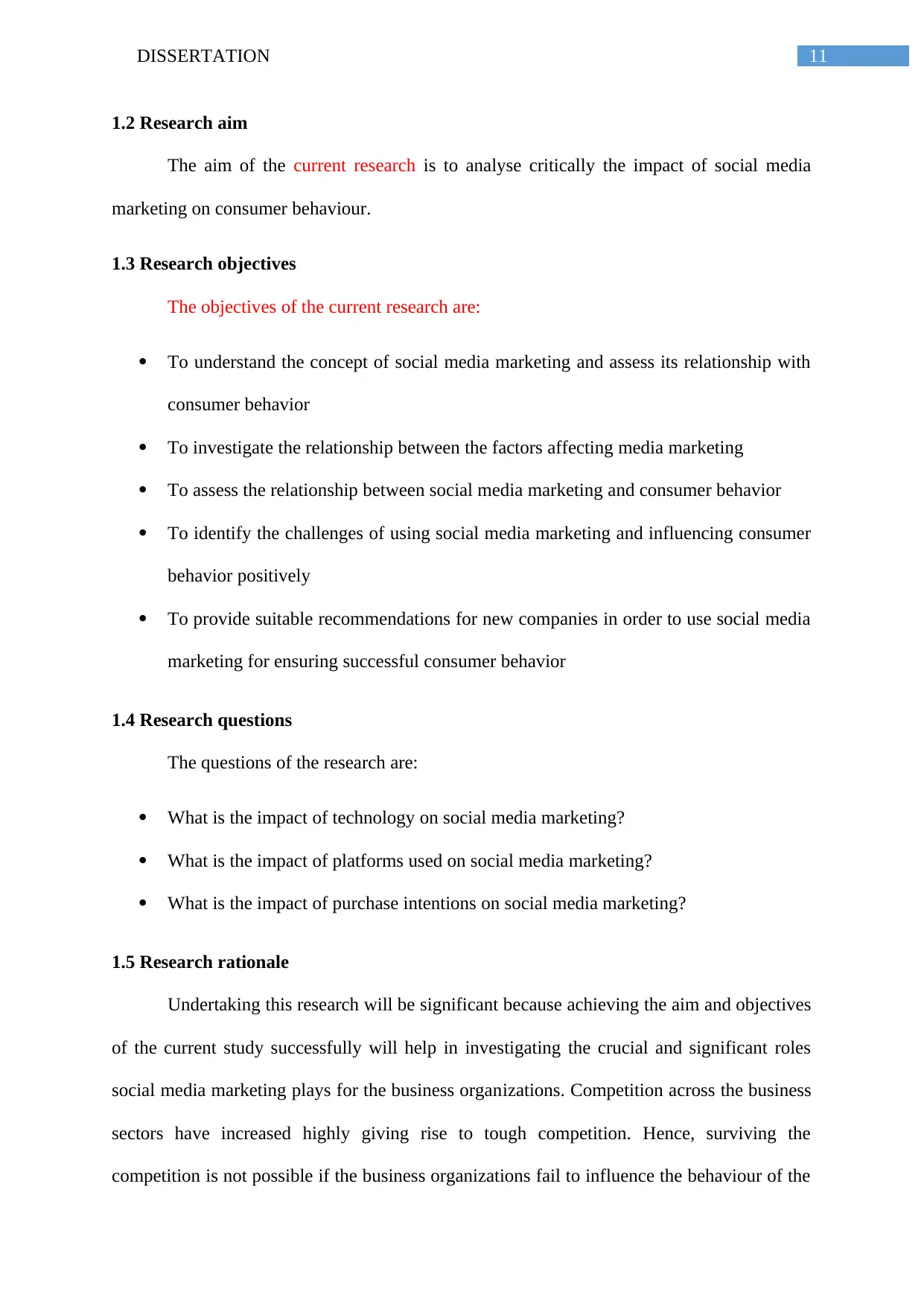
11DISSERTATION
1.2 Research aim
The aim of the current research is to analyse critically the impact of social media
marketing on consumer behaviour.
1.3 Research objectives
The objectives of the current research are:
To understand the concept of social media marketing and assess its relationship with
consumer behavior
To investigate the relationship between the factors affecting media marketing
To assess the relationship between social media marketing and consumer behavior
To identify the challenges of using social media marketing and influencing consumer
behavior positively
To provide suitable recommendations for new companies in order to use social media
marketing for ensuring successful consumer behavior
1.4 Research questions
The questions of the research are:
What is the impact of technology on social media marketing?
What is the impact of platforms used on social media marketing?
What is the impact of purchase intentions on social media marketing?
1.5 Research rationale
Undertaking this research will be significant because achieving the aim and objectives
of the current study successfully will help in investigating the crucial and significant roles
social media marketing plays for the business organizations. Competition across the business
sectors have increased highly giving rise to tough competition. Hence, surviving the
competition is not possible if the business organizations fail to influence the behaviour of the
1.2 Research aim
The aim of the current research is to analyse critically the impact of social media
marketing on consumer behaviour.
1.3 Research objectives
The objectives of the current research are:
To understand the concept of social media marketing and assess its relationship with
consumer behavior
To investigate the relationship between the factors affecting media marketing
To assess the relationship between social media marketing and consumer behavior
To identify the challenges of using social media marketing and influencing consumer
behavior positively
To provide suitable recommendations for new companies in order to use social media
marketing for ensuring successful consumer behavior
1.4 Research questions
The questions of the research are:
What is the impact of technology on social media marketing?
What is the impact of platforms used on social media marketing?
What is the impact of purchase intentions on social media marketing?
1.5 Research rationale
Undertaking this research will be significant because achieving the aim and objectives
of the current study successfully will help in investigating the crucial and significant roles
social media marketing plays for the business organizations. Competition across the business
sectors have increased highly giving rise to tough competition. Hence, surviving the
competition is not possible if the business organizations fail to influence the behaviour of the
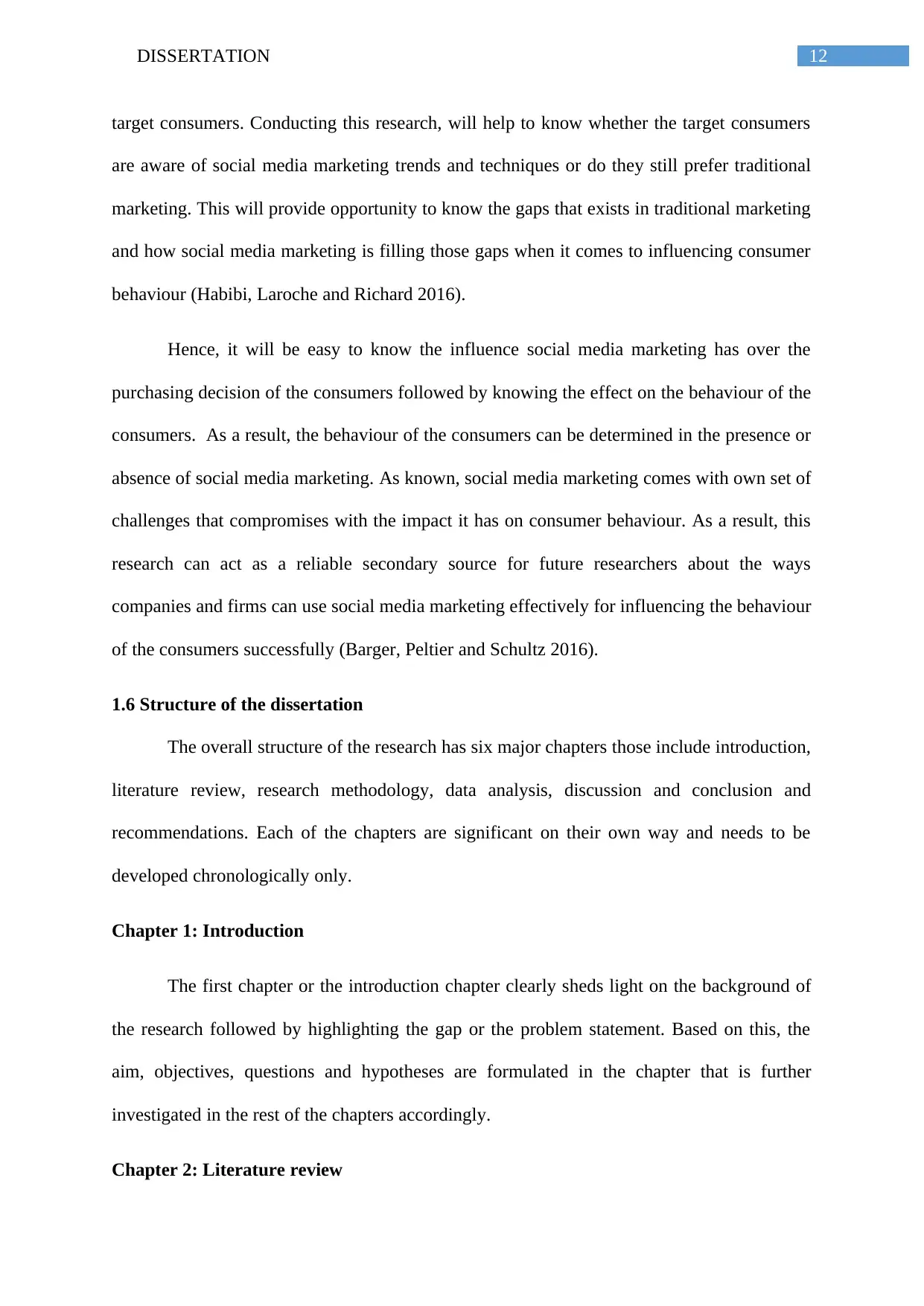
12DISSERTATION
target consumers. Conducting this research, will help to know whether the target consumers
are aware of social media marketing trends and techniques or do they still prefer traditional
marketing. This will provide opportunity to know the gaps that exists in traditional marketing
and how social media marketing is filling those gaps when it comes to influencing consumer
behaviour (Habibi, Laroche and Richard 2016).
Hence, it will be easy to know the influence social media marketing has over the
purchasing decision of the consumers followed by knowing the effect on the behaviour of the
consumers. As a result, the behaviour of the consumers can be determined in the presence or
absence of social media marketing. As known, social media marketing comes with own set of
challenges that compromises with the impact it has on consumer behaviour. As a result, this
research can act as a reliable secondary source for future researchers about the ways
companies and firms can use social media marketing effectively for influencing the behaviour
of the consumers successfully (Barger, Peltier and Schultz 2016).
1.6 Structure of the dissertation
The overall structure of the research has six major chapters those include introduction,
literature review, research methodology, data analysis, discussion and conclusion and
recommendations. Each of the chapters are significant on their own way and needs to be
developed chronologically only.
Chapter 1: Introduction
The first chapter or the introduction chapter clearly sheds light on the background of
the research followed by highlighting the gap or the problem statement. Based on this, the
aim, objectives, questions and hypotheses are formulated in the chapter that is further
investigated in the rest of the chapters accordingly.
Chapter 2: Literature review
target consumers. Conducting this research, will help to know whether the target consumers
are aware of social media marketing trends and techniques or do they still prefer traditional
marketing. This will provide opportunity to know the gaps that exists in traditional marketing
and how social media marketing is filling those gaps when it comes to influencing consumer
behaviour (Habibi, Laroche and Richard 2016).
Hence, it will be easy to know the influence social media marketing has over the
purchasing decision of the consumers followed by knowing the effect on the behaviour of the
consumers. As a result, the behaviour of the consumers can be determined in the presence or
absence of social media marketing. As known, social media marketing comes with own set of
challenges that compromises with the impact it has on consumer behaviour. As a result, this
research can act as a reliable secondary source for future researchers about the ways
companies and firms can use social media marketing effectively for influencing the behaviour
of the consumers successfully (Barger, Peltier and Schultz 2016).
1.6 Structure of the dissertation
The overall structure of the research has six major chapters those include introduction,
literature review, research methodology, data analysis, discussion and conclusion and
recommendations. Each of the chapters are significant on their own way and needs to be
developed chronologically only.
Chapter 1: Introduction
The first chapter or the introduction chapter clearly sheds light on the background of
the research followed by highlighting the gap or the problem statement. Based on this, the
aim, objectives, questions and hypotheses are formulated in the chapter that is further
investigated in the rest of the chapters accordingly.
Chapter 2: Literature review
Paraphrase This Document
Need a fresh take? Get an instant paraphrase of this document with our AI Paraphraser
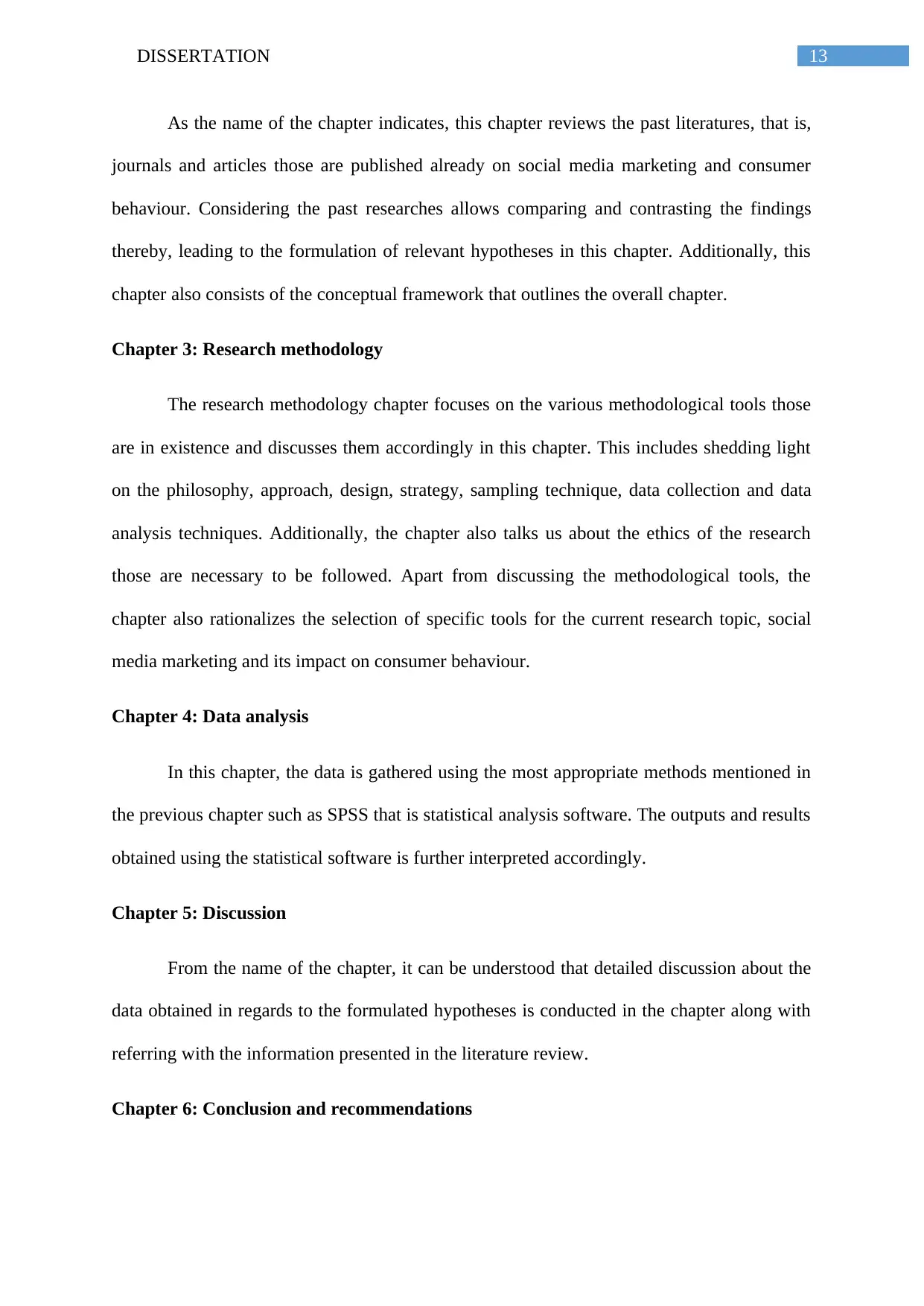
13DISSERTATION
As the name of the chapter indicates, this chapter reviews the past literatures, that is,
journals and articles those are published already on social media marketing and consumer
behaviour. Considering the past researches allows comparing and contrasting the findings
thereby, leading to the formulation of relevant hypotheses in this chapter. Additionally, this
chapter also consists of the conceptual framework that outlines the overall chapter.
Chapter 3: Research methodology
The research methodology chapter focuses on the various methodological tools those
are in existence and discusses them accordingly in this chapter. This includes shedding light
on the philosophy, approach, design, strategy, sampling technique, data collection and data
analysis techniques. Additionally, the chapter also talks us about the ethics of the research
those are necessary to be followed. Apart from discussing the methodological tools, the
chapter also rationalizes the selection of specific tools for the current research topic, social
media marketing and its impact on consumer behaviour.
Chapter 4: Data analysis
In this chapter, the data is gathered using the most appropriate methods mentioned in
the previous chapter such as SPSS that is statistical analysis software. The outputs and results
obtained using the statistical software is further interpreted accordingly.
Chapter 5: Discussion
From the name of the chapter, it can be understood that detailed discussion about the
data obtained in regards to the formulated hypotheses is conducted in the chapter along with
referring with the information presented in the literature review.
Chapter 6: Conclusion and recommendations
As the name of the chapter indicates, this chapter reviews the past literatures, that is,
journals and articles those are published already on social media marketing and consumer
behaviour. Considering the past researches allows comparing and contrasting the findings
thereby, leading to the formulation of relevant hypotheses in this chapter. Additionally, this
chapter also consists of the conceptual framework that outlines the overall chapter.
Chapter 3: Research methodology
The research methodology chapter focuses on the various methodological tools those
are in existence and discusses them accordingly in this chapter. This includes shedding light
on the philosophy, approach, design, strategy, sampling technique, data collection and data
analysis techniques. Additionally, the chapter also talks us about the ethics of the research
those are necessary to be followed. Apart from discussing the methodological tools, the
chapter also rationalizes the selection of specific tools for the current research topic, social
media marketing and its impact on consumer behaviour.
Chapter 4: Data analysis
In this chapter, the data is gathered using the most appropriate methods mentioned in
the previous chapter such as SPSS that is statistical analysis software. The outputs and results
obtained using the statistical software is further interpreted accordingly.
Chapter 5: Discussion
From the name of the chapter, it can be understood that detailed discussion about the
data obtained in regards to the formulated hypotheses is conducted in the chapter along with
referring with the information presented in the literature review.
Chapter 6: Conclusion and recommendations
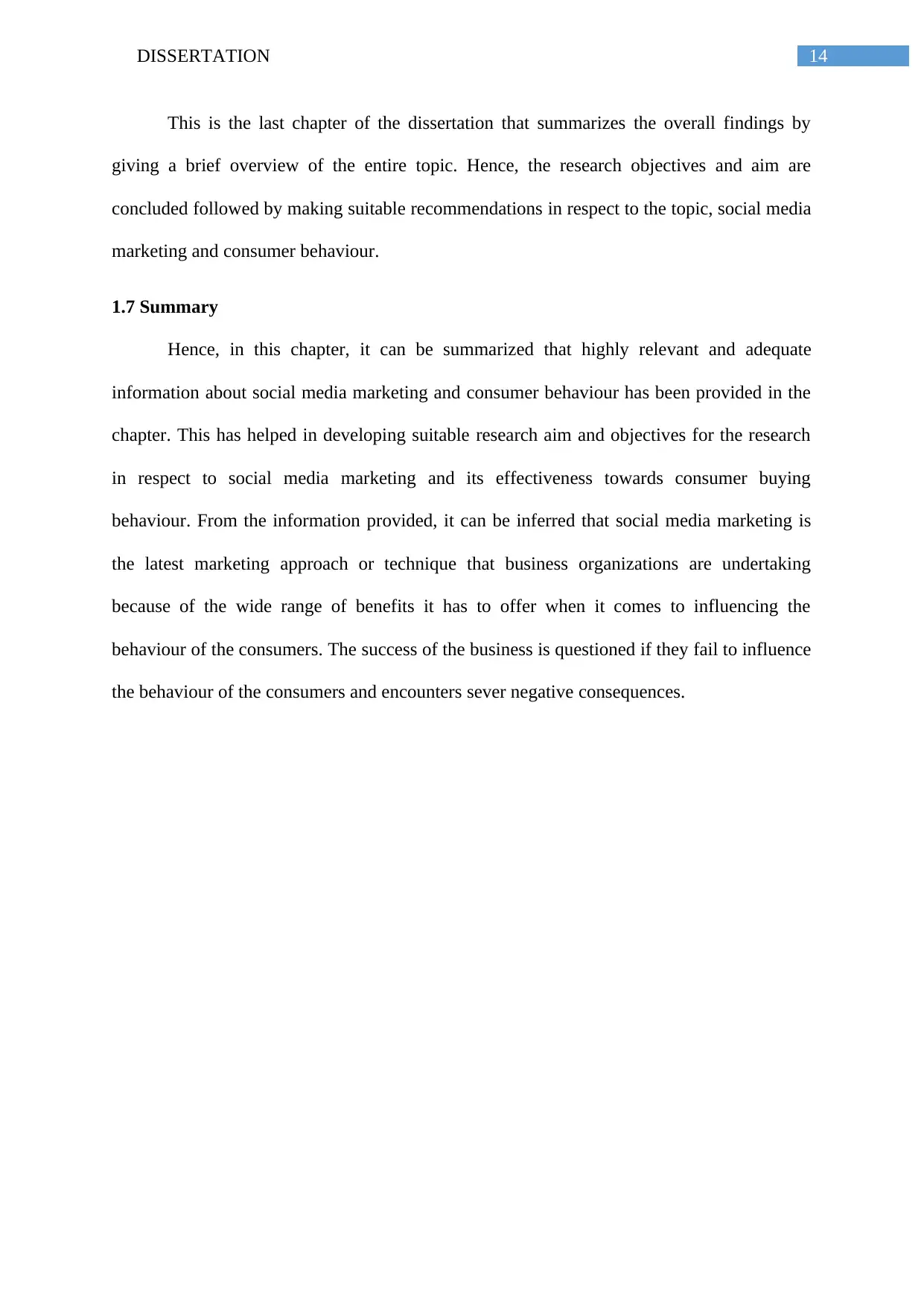
14DISSERTATION
This is the last chapter of the dissertation that summarizes the overall findings by
giving a brief overview of the entire topic. Hence, the research objectives and aim are
concluded followed by making suitable recommendations in respect to the topic, social media
marketing and consumer behaviour.
1.7 Summary
Hence, in this chapter, it can be summarized that highly relevant and adequate
information about social media marketing and consumer behaviour has been provided in the
chapter. This has helped in developing suitable research aim and objectives for the research
in respect to social media marketing and its effectiveness towards consumer buying
behaviour. From the information provided, it can be inferred that social media marketing is
the latest marketing approach or technique that business organizations are undertaking
because of the wide range of benefits it has to offer when it comes to influencing the
behaviour of the consumers. The success of the business is questioned if they fail to influence
the behaviour of the consumers and encounters sever negative consequences.
This is the last chapter of the dissertation that summarizes the overall findings by
giving a brief overview of the entire topic. Hence, the research objectives and aim are
concluded followed by making suitable recommendations in respect to the topic, social media
marketing and consumer behaviour.
1.7 Summary
Hence, in this chapter, it can be summarized that highly relevant and adequate
information about social media marketing and consumer behaviour has been provided in the
chapter. This has helped in developing suitable research aim and objectives for the research
in respect to social media marketing and its effectiveness towards consumer buying
behaviour. From the information provided, it can be inferred that social media marketing is
the latest marketing approach or technique that business organizations are undertaking
because of the wide range of benefits it has to offer when it comes to influencing the
behaviour of the consumers. The success of the business is questioned if they fail to influence
the behaviour of the consumers and encounters sever negative consequences.
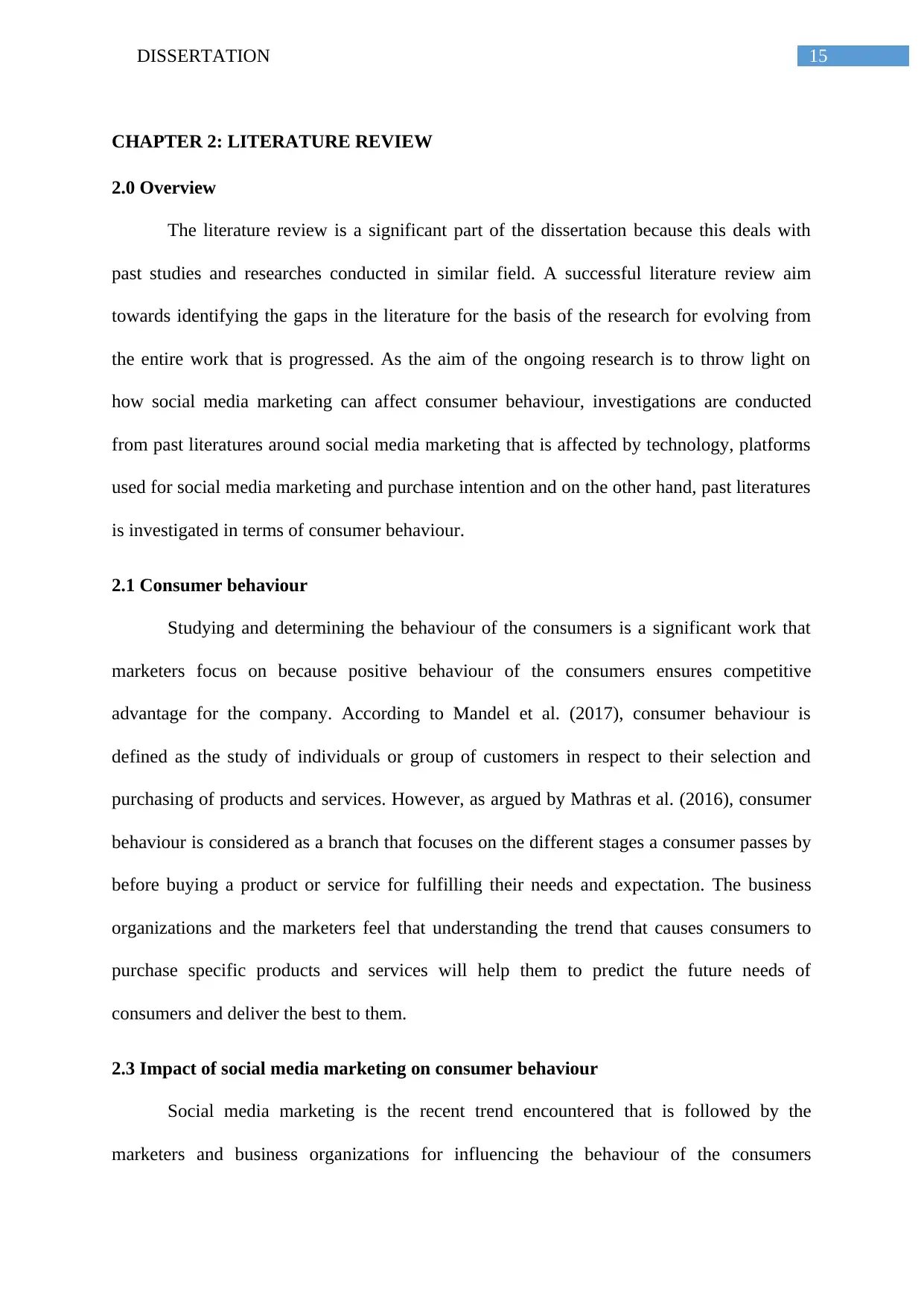
15DISSERTATION
CHAPTER 2: LITERATURE REVIEW
2.0 Overview
The literature review is a significant part of the dissertation because this deals with
past studies and researches conducted in similar field. A successful literature review aim
towards identifying the gaps in the literature for the basis of the research for evolving from
the entire work that is progressed. As the aim of the ongoing research is to throw light on
how social media marketing can affect consumer behaviour, investigations are conducted
from past literatures around social media marketing that is affected by technology, platforms
used for social media marketing and purchase intention and on the other hand, past literatures
is investigated in terms of consumer behaviour.
2.1 Consumer behaviour
Studying and determining the behaviour of the consumers is a significant work that
marketers focus on because positive behaviour of the consumers ensures competitive
advantage for the company. According to Mandel et al. (2017), consumer behaviour is
defined as the study of individuals or group of customers in respect to their selection and
purchasing of products and services. However, as argued by Mathras et al. (2016), consumer
behaviour is considered as a branch that focuses on the different stages a consumer passes by
before buying a product or service for fulfilling their needs and expectation. The business
organizations and the marketers feel that understanding the trend that causes consumers to
purchase specific products and services will help them to predict the future needs of
consumers and deliver the best to them.
2.3 Impact of social media marketing on consumer behaviour
Social media marketing is the recent trend encountered that is followed by the
marketers and business organizations for influencing the behaviour of the consumers
CHAPTER 2: LITERATURE REVIEW
2.0 Overview
The literature review is a significant part of the dissertation because this deals with
past studies and researches conducted in similar field. A successful literature review aim
towards identifying the gaps in the literature for the basis of the research for evolving from
the entire work that is progressed. As the aim of the ongoing research is to throw light on
how social media marketing can affect consumer behaviour, investigations are conducted
from past literatures around social media marketing that is affected by technology, platforms
used for social media marketing and purchase intention and on the other hand, past literatures
is investigated in terms of consumer behaviour.
2.1 Consumer behaviour
Studying and determining the behaviour of the consumers is a significant work that
marketers focus on because positive behaviour of the consumers ensures competitive
advantage for the company. According to Mandel et al. (2017), consumer behaviour is
defined as the study of individuals or group of customers in respect to their selection and
purchasing of products and services. However, as argued by Mathras et al. (2016), consumer
behaviour is considered as a branch that focuses on the different stages a consumer passes by
before buying a product or service for fulfilling their needs and expectation. The business
organizations and the marketers feel that understanding the trend that causes consumers to
purchase specific products and services will help them to predict the future needs of
consumers and deliver the best to them.
2.3 Impact of social media marketing on consumer behaviour
Social media marketing is the recent trend encountered that is followed by the
marketers and business organizations for influencing the behaviour of the consumers
Secure Best Marks with AI Grader
Need help grading? Try our AI Grader for instant feedback on your assignments.
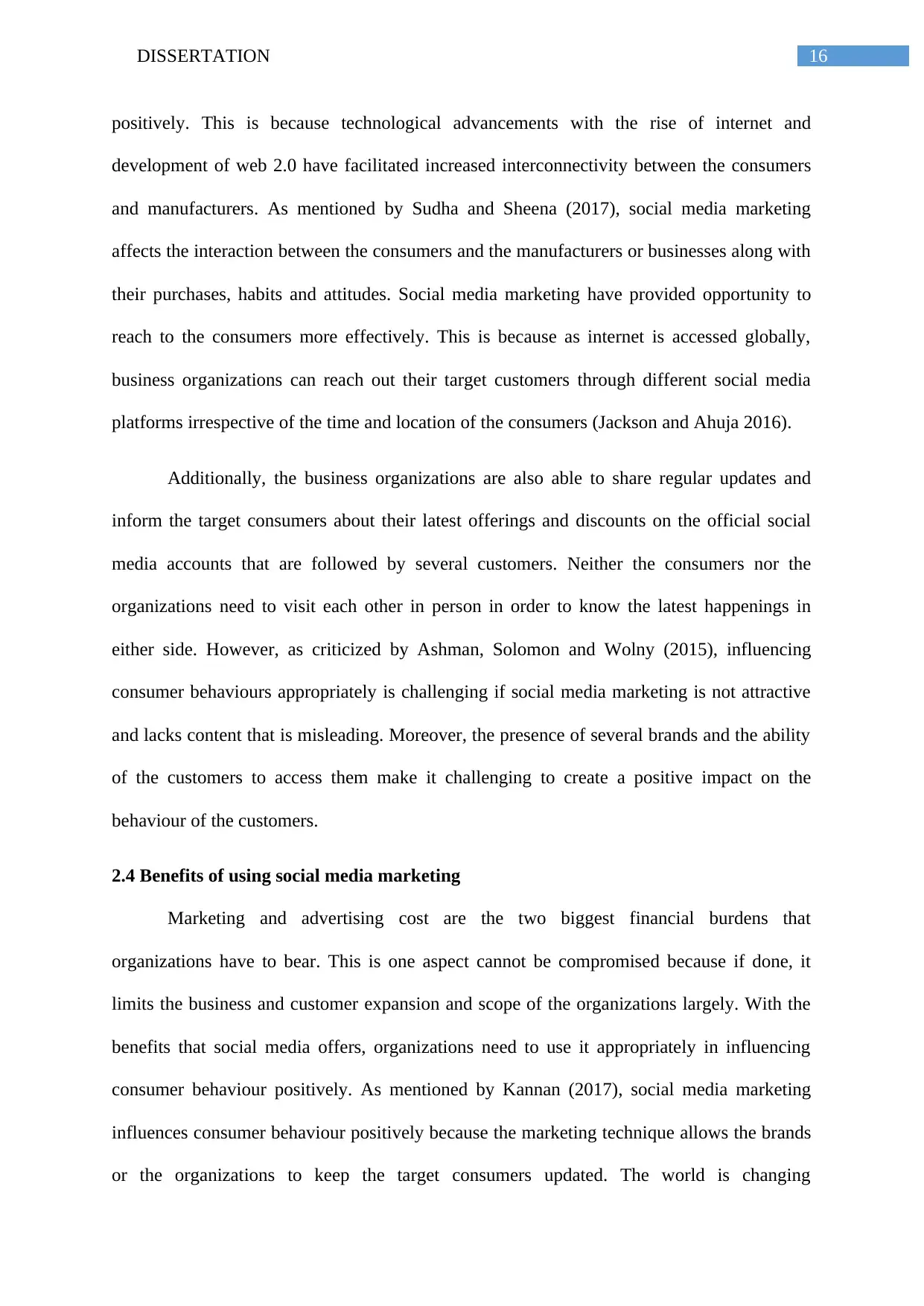
16DISSERTATION
positively. This is because technological advancements with the rise of internet and
development of web 2.0 have facilitated increased interconnectivity between the consumers
and manufacturers. As mentioned by Sudha and Sheena (2017), social media marketing
affects the interaction between the consumers and the manufacturers or businesses along with
their purchases, habits and attitudes. Social media marketing have provided opportunity to
reach to the consumers more effectively. This is because as internet is accessed globally,
business organizations can reach out their target customers through different social media
platforms irrespective of the time and location of the consumers (Jackson and Ahuja 2016).
Additionally, the business organizations are also able to share regular updates and
inform the target consumers about their latest offerings and discounts on the official social
media accounts that are followed by several customers. Neither the consumers nor the
organizations need to visit each other in person in order to know the latest happenings in
either side. However, as criticized by Ashman, Solomon and Wolny (2015), influencing
consumer behaviours appropriately is challenging if social media marketing is not attractive
and lacks content that is misleading. Moreover, the presence of several brands and the ability
of the customers to access them make it challenging to create a positive impact on the
behaviour of the customers.
2.4 Benefits of using social media marketing
Marketing and advertising cost are the two biggest financial burdens that
organizations have to bear. This is one aspect cannot be compromised because if done, it
limits the business and customer expansion and scope of the organizations largely. With the
benefits that social media offers, organizations need to use it appropriately in influencing
consumer behaviour positively. As mentioned by Kannan (2017), social media marketing
influences consumer behaviour positively because the marketing technique allows the brands
or the organizations to keep the target consumers updated. The world is changing
positively. This is because technological advancements with the rise of internet and
development of web 2.0 have facilitated increased interconnectivity between the consumers
and manufacturers. As mentioned by Sudha and Sheena (2017), social media marketing
affects the interaction between the consumers and the manufacturers or businesses along with
their purchases, habits and attitudes. Social media marketing have provided opportunity to
reach to the consumers more effectively. This is because as internet is accessed globally,
business organizations can reach out their target customers through different social media
platforms irrespective of the time and location of the consumers (Jackson and Ahuja 2016).
Additionally, the business organizations are also able to share regular updates and
inform the target consumers about their latest offerings and discounts on the official social
media accounts that are followed by several customers. Neither the consumers nor the
organizations need to visit each other in person in order to know the latest happenings in
either side. However, as criticized by Ashman, Solomon and Wolny (2015), influencing
consumer behaviours appropriately is challenging if social media marketing is not attractive
and lacks content that is misleading. Moreover, the presence of several brands and the ability
of the customers to access them make it challenging to create a positive impact on the
behaviour of the customers.
2.4 Benefits of using social media marketing
Marketing and advertising cost are the two biggest financial burdens that
organizations have to bear. This is one aspect cannot be compromised because if done, it
limits the business and customer expansion and scope of the organizations largely. With the
benefits that social media offers, organizations need to use it appropriately in influencing
consumer behaviour positively. As mentioned by Kannan (2017), social media marketing
influences consumer behaviour positively because the marketing technique allows the brands
or the organizations to keep the target consumers updated. The world is changing
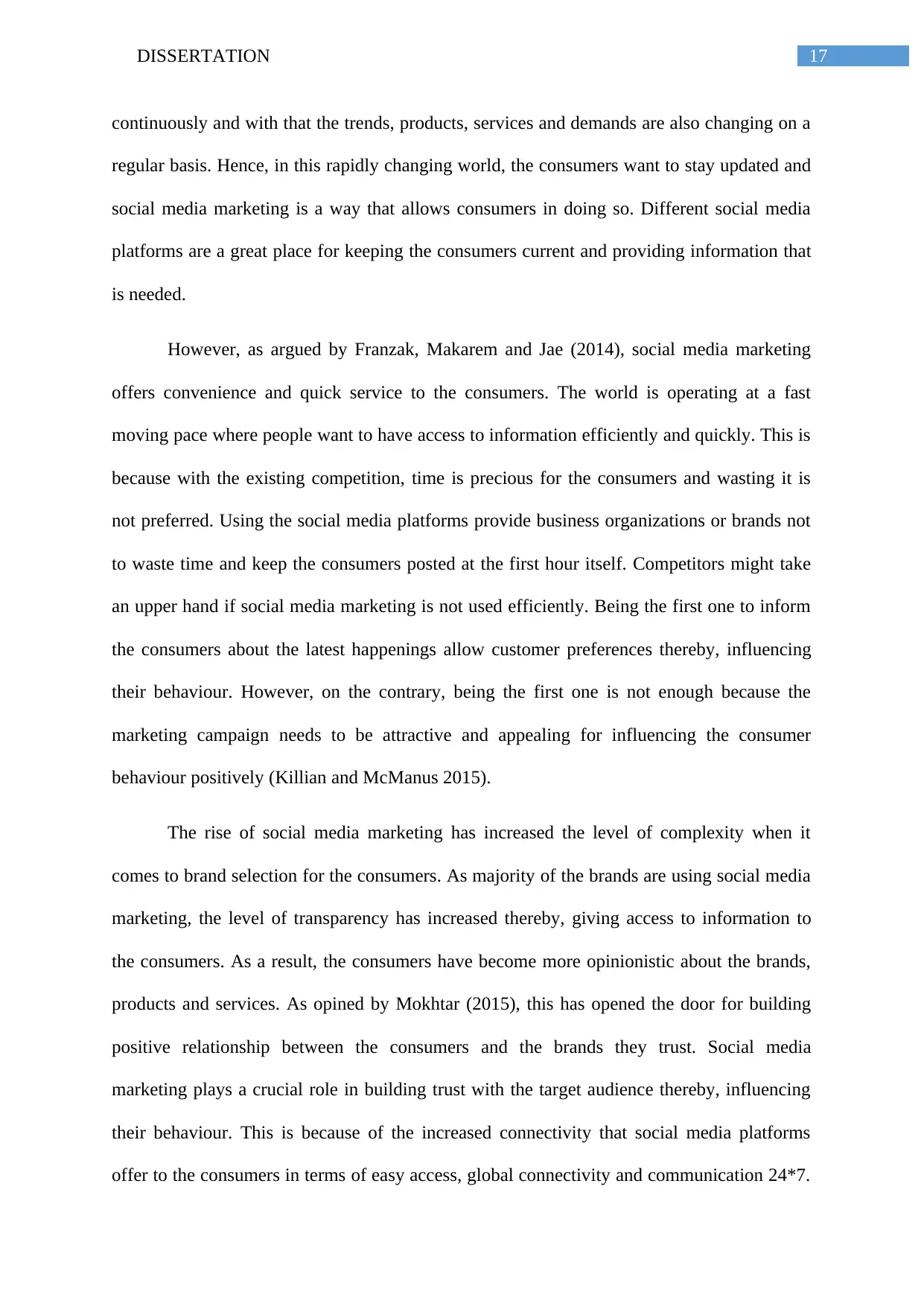
17DISSERTATION
continuously and with that the trends, products, services and demands are also changing on a
regular basis. Hence, in this rapidly changing world, the consumers want to stay updated and
social media marketing is a way that allows consumers in doing so. Different social media
platforms are a great place for keeping the consumers current and providing information that
is needed.
However, as argued by Franzak, Makarem and Jae (2014), social media marketing
offers convenience and quick service to the consumers. The world is operating at a fast
moving pace where people want to have access to information efficiently and quickly. This is
because with the existing competition, time is precious for the consumers and wasting it is
not preferred. Using the social media platforms provide business organizations or brands not
to waste time and keep the consumers posted at the first hour itself. Competitors might take
an upper hand if social media marketing is not used efficiently. Being the first one to inform
the consumers about the latest happenings allow customer preferences thereby, influencing
their behaviour. However, on the contrary, being the first one is not enough because the
marketing campaign needs to be attractive and appealing for influencing the consumer
behaviour positively (Killian and McManus 2015).
The rise of social media marketing has increased the level of complexity when it
comes to brand selection for the consumers. As majority of the brands are using social media
marketing, the level of transparency has increased thereby, giving access to information to
the consumers. As a result, the consumers have become more opinionistic about the brands,
products and services. As opined by Mokhtar (2015), this has opened the door for building
positive relationship between the consumers and the brands they trust. Social media
marketing plays a crucial role in building trust with the target audience thereby, influencing
their behaviour. This is because of the increased connectivity that social media platforms
offer to the consumers in terms of easy access, global connectivity and communication 24*7.
continuously and with that the trends, products, services and demands are also changing on a
regular basis. Hence, in this rapidly changing world, the consumers want to stay updated and
social media marketing is a way that allows consumers in doing so. Different social media
platforms are a great place for keeping the consumers current and providing information that
is needed.
However, as argued by Franzak, Makarem and Jae (2014), social media marketing
offers convenience and quick service to the consumers. The world is operating at a fast
moving pace where people want to have access to information efficiently and quickly. This is
because with the existing competition, time is precious for the consumers and wasting it is
not preferred. Using the social media platforms provide business organizations or brands not
to waste time and keep the consumers posted at the first hour itself. Competitors might take
an upper hand if social media marketing is not used efficiently. Being the first one to inform
the consumers about the latest happenings allow customer preferences thereby, influencing
their behaviour. However, on the contrary, being the first one is not enough because the
marketing campaign needs to be attractive and appealing for influencing the consumer
behaviour positively (Killian and McManus 2015).
The rise of social media marketing has increased the level of complexity when it
comes to brand selection for the consumers. As majority of the brands are using social media
marketing, the level of transparency has increased thereby, giving access to information to
the consumers. As a result, the consumers have become more opinionistic about the brands,
products and services. As opined by Mokhtar (2015), this has opened the door for building
positive relationship between the consumers and the brands they trust. Social media
marketing plays a crucial role in building trust with the target audience thereby, influencing
their behaviour. This is because of the increased connectivity that social media platforms
offer to the consumers in terms of easy access, global connectivity and communication 24*7.
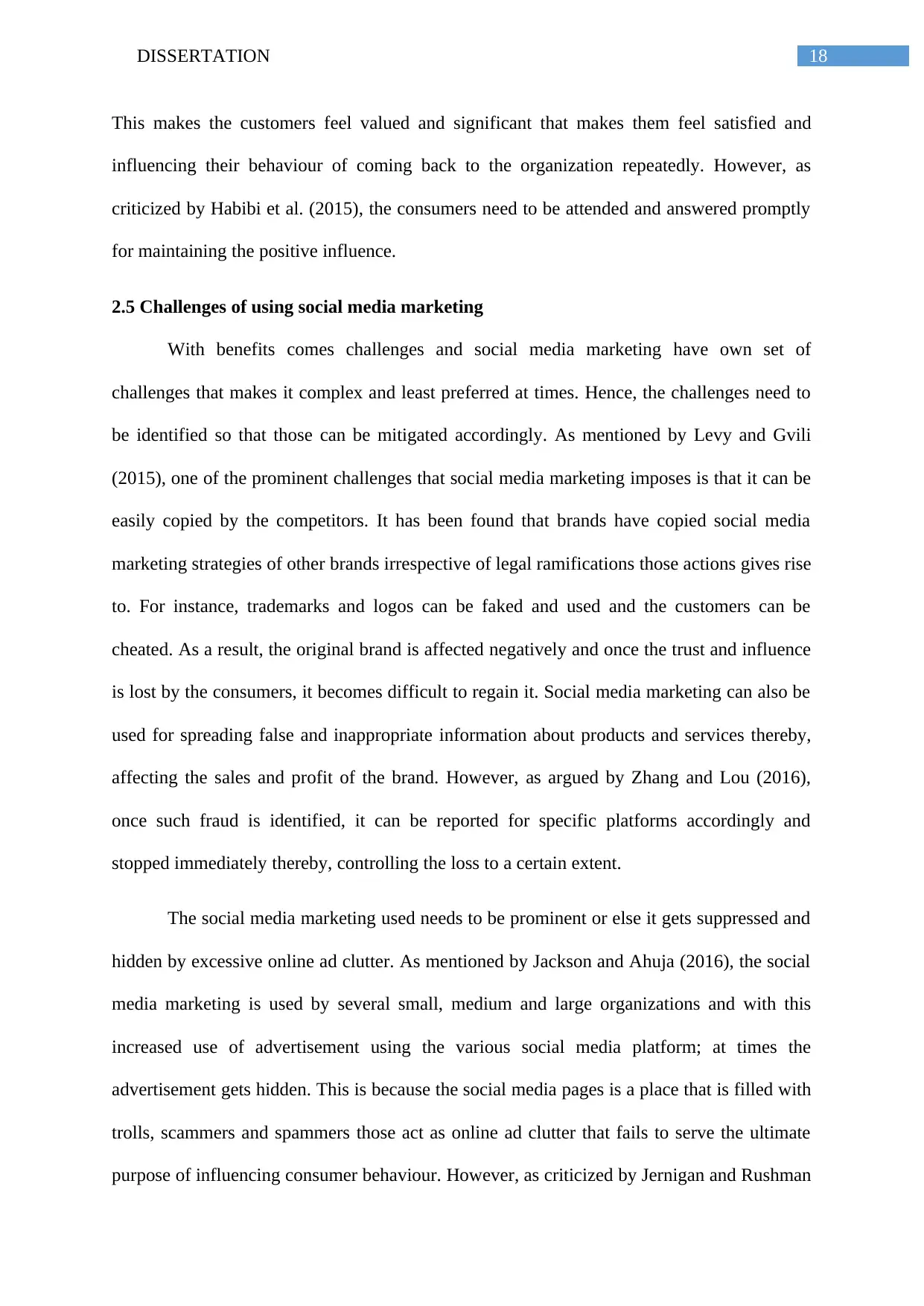
18DISSERTATION
This makes the customers feel valued and significant that makes them feel satisfied and
influencing their behaviour of coming back to the organization repeatedly. However, as
criticized by Habibi et al. (2015), the consumers need to be attended and answered promptly
for maintaining the positive influence.
2.5 Challenges of using social media marketing
With benefits comes challenges and social media marketing have own set of
challenges that makes it complex and least preferred at times. Hence, the challenges need to
be identified so that those can be mitigated accordingly. As mentioned by Levy and Gvili
(2015), one of the prominent challenges that social media marketing imposes is that it can be
easily copied by the competitors. It has been found that brands have copied social media
marketing strategies of other brands irrespective of legal ramifications those actions gives rise
to. For instance, trademarks and logos can be faked and used and the customers can be
cheated. As a result, the original brand is affected negatively and once the trust and influence
is lost by the consumers, it becomes difficult to regain it. Social media marketing can also be
used for spreading false and inappropriate information about products and services thereby,
affecting the sales and profit of the brand. However, as argued by Zhang and Lou (2016),
once such fraud is identified, it can be reported for specific platforms accordingly and
stopped immediately thereby, controlling the loss to a certain extent.
The social media marketing used needs to be prominent or else it gets suppressed and
hidden by excessive online ad clutter. As mentioned by Jackson and Ahuja (2016), the social
media marketing is used by several small, medium and large organizations and with this
increased use of advertisement using the various social media platform; at times the
advertisement gets hidden. This is because the social media pages is a place that is filled with
trolls, scammers and spammers those act as online ad clutter that fails to serve the ultimate
purpose of influencing consumer behaviour. However, as criticized by Jernigan and Rushman
This makes the customers feel valued and significant that makes them feel satisfied and
influencing their behaviour of coming back to the organization repeatedly. However, as
criticized by Habibi et al. (2015), the consumers need to be attended and answered promptly
for maintaining the positive influence.
2.5 Challenges of using social media marketing
With benefits comes challenges and social media marketing have own set of
challenges that makes it complex and least preferred at times. Hence, the challenges need to
be identified so that those can be mitigated accordingly. As mentioned by Levy and Gvili
(2015), one of the prominent challenges that social media marketing imposes is that it can be
easily copied by the competitors. It has been found that brands have copied social media
marketing strategies of other brands irrespective of legal ramifications those actions gives rise
to. For instance, trademarks and logos can be faked and used and the customers can be
cheated. As a result, the original brand is affected negatively and once the trust and influence
is lost by the consumers, it becomes difficult to regain it. Social media marketing can also be
used for spreading false and inappropriate information about products and services thereby,
affecting the sales and profit of the brand. However, as argued by Zhang and Lou (2016),
once such fraud is identified, it can be reported for specific platforms accordingly and
stopped immediately thereby, controlling the loss to a certain extent.
The social media marketing used needs to be prominent or else it gets suppressed and
hidden by excessive online ad clutter. As mentioned by Jackson and Ahuja (2016), the social
media marketing is used by several small, medium and large organizations and with this
increased use of advertisement using the various social media platform; at times the
advertisement gets hidden. This is because the social media pages is a place that is filled with
trolls, scammers and spammers those act as online ad clutter that fails to serve the ultimate
purpose of influencing consumer behaviour. However, as criticized by Jernigan and Rushman
Paraphrase This Document
Need a fresh take? Get an instant paraphrase of this document with our AI Paraphraser
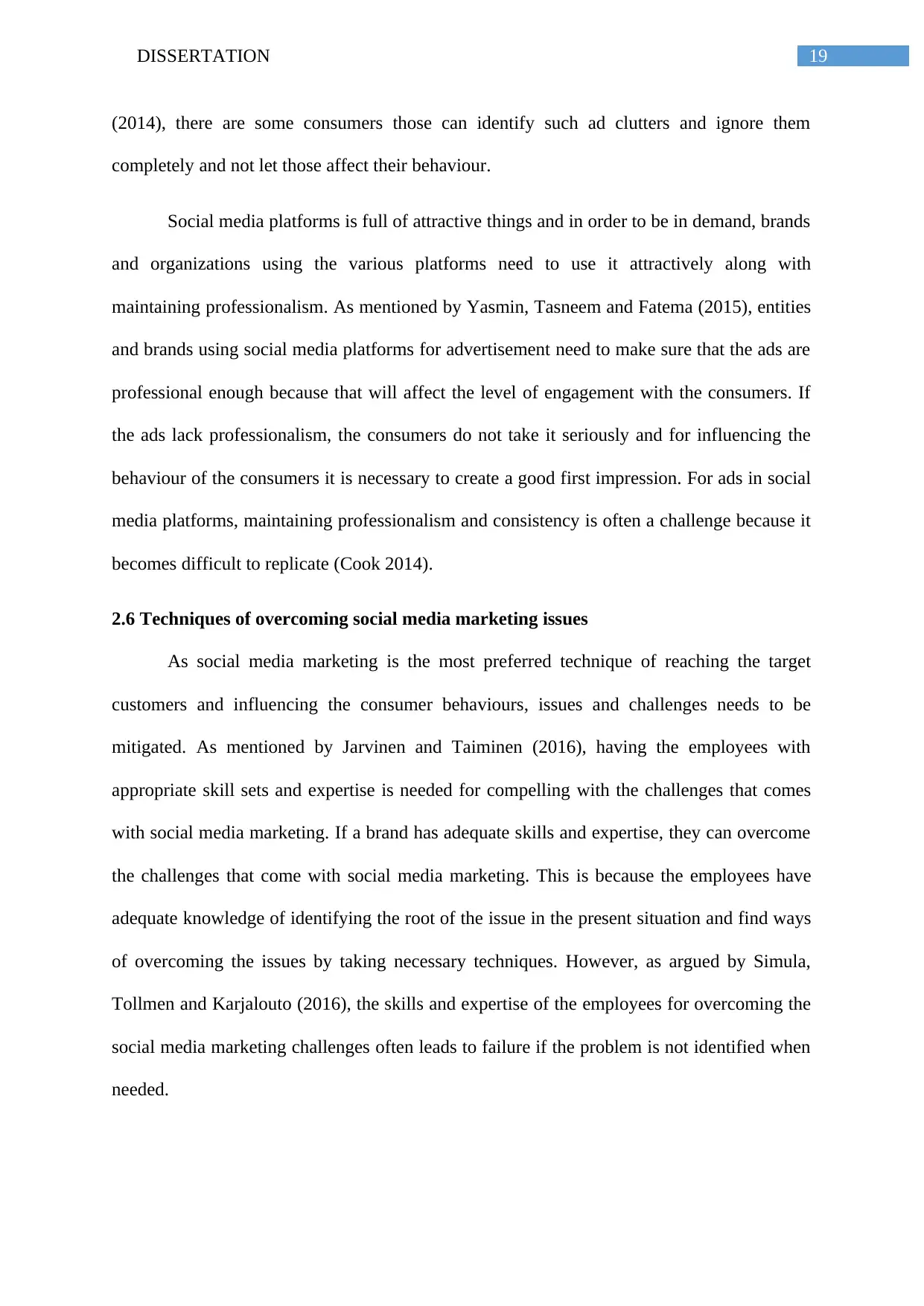
19DISSERTATION
(2014), there are some consumers those can identify such ad clutters and ignore them
completely and not let those affect their behaviour.
Social media platforms is full of attractive things and in order to be in demand, brands
and organizations using the various platforms need to use it attractively along with
maintaining professionalism. As mentioned by Yasmin, Tasneem and Fatema (2015), entities
and brands using social media platforms for advertisement need to make sure that the ads are
professional enough because that will affect the level of engagement with the consumers. If
the ads lack professionalism, the consumers do not take it seriously and for influencing the
behaviour of the consumers it is necessary to create a good first impression. For ads in social
media platforms, maintaining professionalism and consistency is often a challenge because it
becomes difficult to replicate (Cook 2014).
2.6 Techniques of overcoming social media marketing issues
As social media marketing is the most preferred technique of reaching the target
customers and influencing the consumer behaviours, issues and challenges needs to be
mitigated. As mentioned by Jarvinen and Taiminen (2016), having the employees with
appropriate skill sets and expertise is needed for compelling with the challenges that comes
with social media marketing. If a brand has adequate skills and expertise, they can overcome
the challenges that come with social media marketing. This is because the employees have
adequate knowledge of identifying the root of the issue in the present situation and find ways
of overcoming the issues by taking necessary techniques. However, as argued by Simula,
Tollmen and Karjalouto (2016), the skills and expertise of the employees for overcoming the
social media marketing challenges often leads to failure if the problem is not identified when
needed.
(2014), there are some consumers those can identify such ad clutters and ignore them
completely and not let those affect their behaviour.
Social media platforms is full of attractive things and in order to be in demand, brands
and organizations using the various platforms need to use it attractively along with
maintaining professionalism. As mentioned by Yasmin, Tasneem and Fatema (2015), entities
and brands using social media platforms for advertisement need to make sure that the ads are
professional enough because that will affect the level of engagement with the consumers. If
the ads lack professionalism, the consumers do not take it seriously and for influencing the
behaviour of the consumers it is necessary to create a good first impression. For ads in social
media platforms, maintaining professionalism and consistency is often a challenge because it
becomes difficult to replicate (Cook 2014).
2.6 Techniques of overcoming social media marketing issues
As social media marketing is the most preferred technique of reaching the target
customers and influencing the consumer behaviours, issues and challenges needs to be
mitigated. As mentioned by Jarvinen and Taiminen (2016), having the employees with
appropriate skill sets and expertise is needed for compelling with the challenges that comes
with social media marketing. If a brand has adequate skills and expertise, they can overcome
the challenges that come with social media marketing. This is because the employees have
adequate knowledge of identifying the root of the issue in the present situation and find ways
of overcoming the issues by taking necessary techniques. However, as argued by Simula,
Tollmen and Karjalouto (2016), the skills and expertise of the employees for overcoming the
social media marketing challenges often leads to failure if the problem is not identified when
needed.
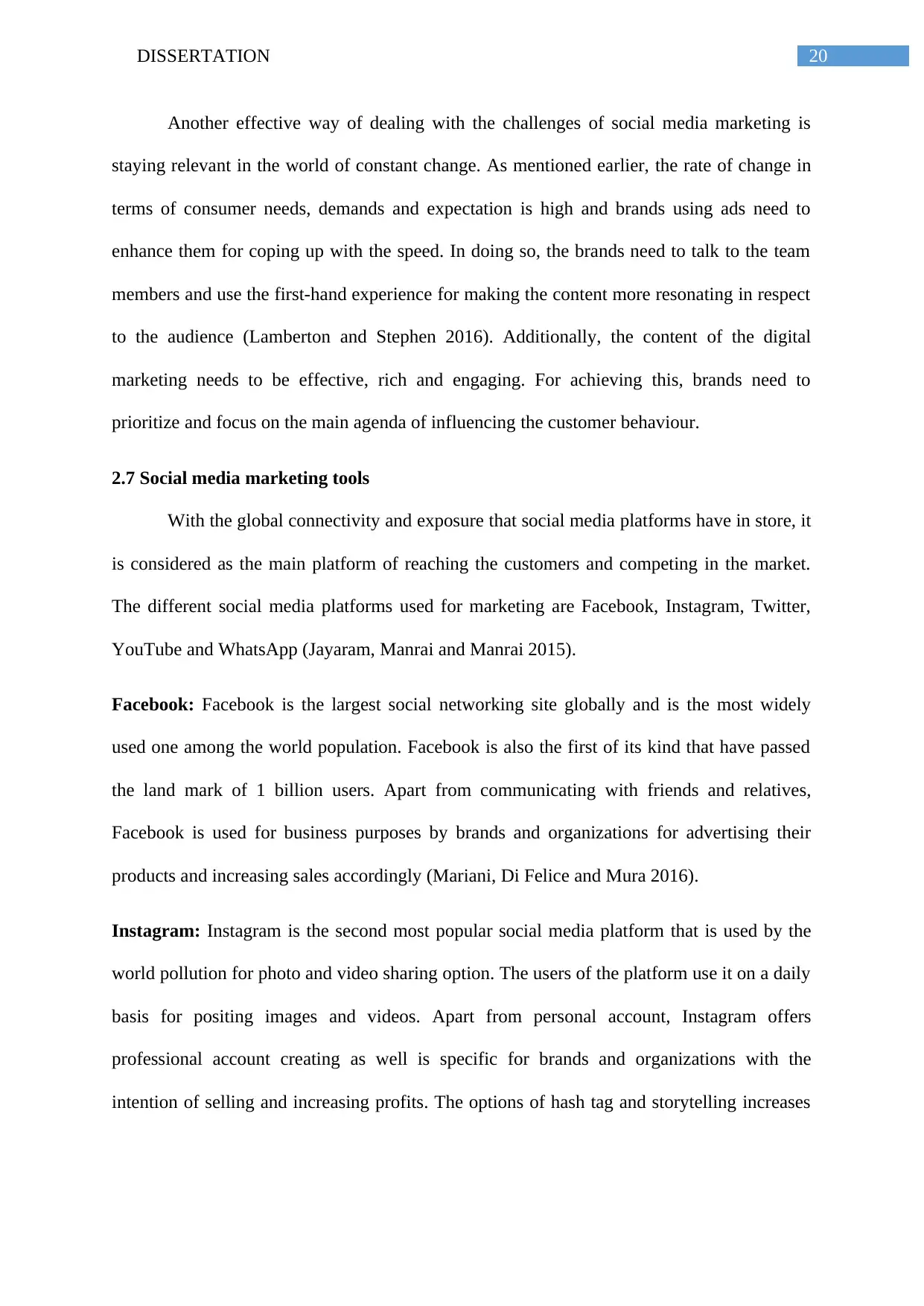
20DISSERTATION
Another effective way of dealing with the challenges of social media marketing is
staying relevant in the world of constant change. As mentioned earlier, the rate of change in
terms of consumer needs, demands and expectation is high and brands using ads need to
enhance them for coping up with the speed. In doing so, the brands need to talk to the team
members and use the first-hand experience for making the content more resonating in respect
to the audience (Lamberton and Stephen 2016). Additionally, the content of the digital
marketing needs to be effective, rich and engaging. For achieving this, brands need to
prioritize and focus on the main agenda of influencing the customer behaviour.
2.7 Social media marketing tools
With the global connectivity and exposure that social media platforms have in store, it
is considered as the main platform of reaching the customers and competing in the market.
The different social media platforms used for marketing are Facebook, Instagram, Twitter,
YouTube and WhatsApp (Jayaram, Manrai and Manrai 2015).
Facebook: Facebook is the largest social networking site globally and is the most widely
used one among the world population. Facebook is also the first of its kind that have passed
the land mark of 1 billion users. Apart from communicating with friends and relatives,
Facebook is used for business purposes by brands and organizations for advertising their
products and increasing sales accordingly (Mariani, Di Felice and Mura 2016).
Instagram: Instagram is the second most popular social media platform that is used by the
world pollution for photo and video sharing option. The users of the platform use it on a daily
basis for positing images and videos. Apart from personal account, Instagram offers
professional account creating as well is specific for brands and organizations with the
intention of selling and increasing profits. The options of hash tag and storytelling increases
Another effective way of dealing with the challenges of social media marketing is
staying relevant in the world of constant change. As mentioned earlier, the rate of change in
terms of consumer needs, demands and expectation is high and brands using ads need to
enhance them for coping up with the speed. In doing so, the brands need to talk to the team
members and use the first-hand experience for making the content more resonating in respect
to the audience (Lamberton and Stephen 2016). Additionally, the content of the digital
marketing needs to be effective, rich and engaging. For achieving this, brands need to
prioritize and focus on the main agenda of influencing the customer behaviour.
2.7 Social media marketing tools
With the global connectivity and exposure that social media platforms have in store, it
is considered as the main platform of reaching the customers and competing in the market.
The different social media platforms used for marketing are Facebook, Instagram, Twitter,
YouTube and WhatsApp (Jayaram, Manrai and Manrai 2015).
Facebook: Facebook is the largest social networking site globally and is the most widely
used one among the world population. Facebook is also the first of its kind that have passed
the land mark of 1 billion users. Apart from communicating with friends and relatives,
Facebook is used for business purposes by brands and organizations for advertising their
products and increasing sales accordingly (Mariani, Di Felice and Mura 2016).
Instagram: Instagram is the second most popular social media platform that is used by the
world pollution for photo and video sharing option. The users of the platform use it on a daily
basis for positing images and videos. Apart from personal account, Instagram offers
professional account creating as well is specific for brands and organizations with the
intention of selling and increasing profits. The options of hash tag and storytelling increases
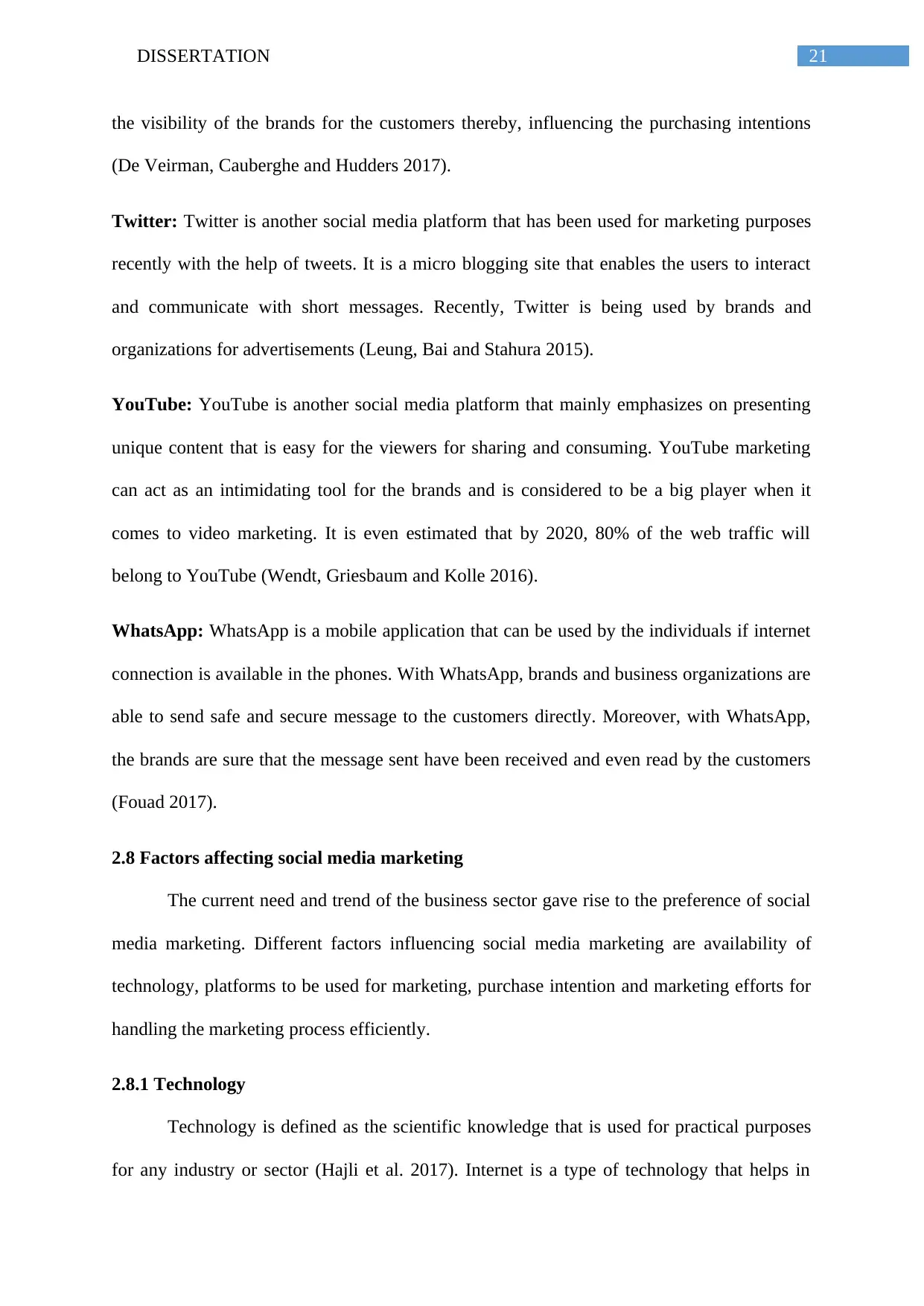
21DISSERTATION
the visibility of the brands for the customers thereby, influencing the purchasing intentions
(De Veirman, Cauberghe and Hudders 2017).
Twitter: Twitter is another social media platform that has been used for marketing purposes
recently with the help of tweets. It is a micro blogging site that enables the users to interact
and communicate with short messages. Recently, Twitter is being used by brands and
organizations for advertisements (Leung, Bai and Stahura 2015).
YouTube: YouTube is another social media platform that mainly emphasizes on presenting
unique content that is easy for the viewers for sharing and consuming. YouTube marketing
can act as an intimidating tool for the brands and is considered to be a big player when it
comes to video marketing. It is even estimated that by 2020, 80% of the web traffic will
belong to YouTube (Wendt, Griesbaum and Kolle 2016).
WhatsApp: WhatsApp is a mobile application that can be used by the individuals if internet
connection is available in the phones. With WhatsApp, brands and business organizations are
able to send safe and secure message to the customers directly. Moreover, with WhatsApp,
the brands are sure that the message sent have been received and even read by the customers
(Fouad 2017).
2.8 Factors affecting social media marketing
The current need and trend of the business sector gave rise to the preference of social
media marketing. Different factors influencing social media marketing are availability of
technology, platforms to be used for marketing, purchase intention and marketing efforts for
handling the marketing process efficiently.
2.8.1 Technology
Technology is defined as the scientific knowledge that is used for practical purposes
for any industry or sector (Hajli et al. 2017). Internet is a type of technology that helps in
the visibility of the brands for the customers thereby, influencing the purchasing intentions
(De Veirman, Cauberghe and Hudders 2017).
Twitter: Twitter is another social media platform that has been used for marketing purposes
recently with the help of tweets. It is a micro blogging site that enables the users to interact
and communicate with short messages. Recently, Twitter is being used by brands and
organizations for advertisements (Leung, Bai and Stahura 2015).
YouTube: YouTube is another social media platform that mainly emphasizes on presenting
unique content that is easy for the viewers for sharing and consuming. YouTube marketing
can act as an intimidating tool for the brands and is considered to be a big player when it
comes to video marketing. It is even estimated that by 2020, 80% of the web traffic will
belong to YouTube (Wendt, Griesbaum and Kolle 2016).
WhatsApp: WhatsApp is a mobile application that can be used by the individuals if internet
connection is available in the phones. With WhatsApp, brands and business organizations are
able to send safe and secure message to the customers directly. Moreover, with WhatsApp,
the brands are sure that the message sent have been received and even read by the customers
(Fouad 2017).
2.8 Factors affecting social media marketing
The current need and trend of the business sector gave rise to the preference of social
media marketing. Different factors influencing social media marketing are availability of
technology, platforms to be used for marketing, purchase intention and marketing efforts for
handling the marketing process efficiently.
2.8.1 Technology
Technology is defined as the scientific knowledge that is used for practical purposes
for any industry or sector (Hajli et al. 2017). Internet is a type of technology that helps in
Secure Best Marks with AI Grader
Need help grading? Try our AI Grader for instant feedback on your assignments.
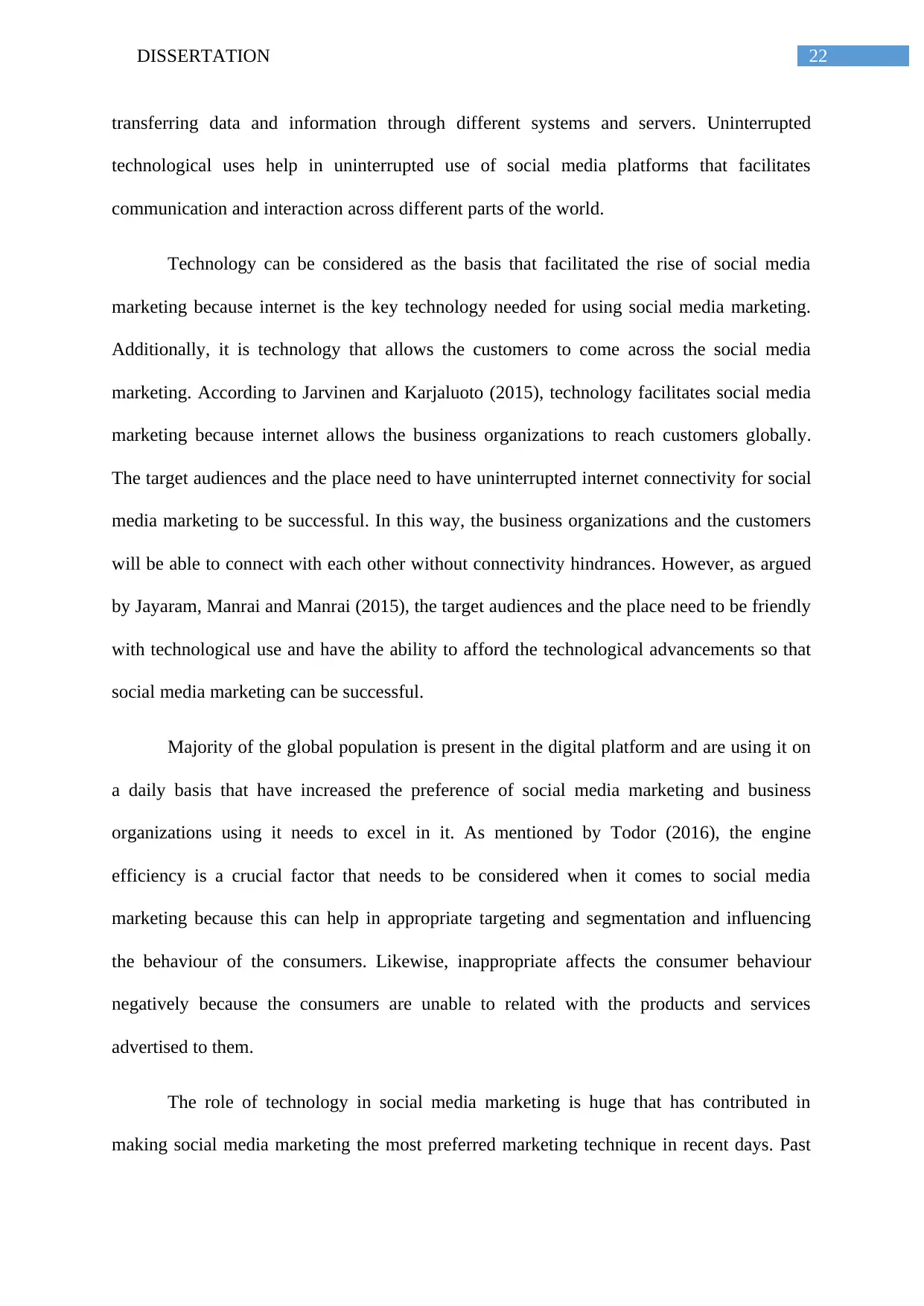
22DISSERTATION
transferring data and information through different systems and servers. Uninterrupted
technological uses help in uninterrupted use of social media platforms that facilitates
communication and interaction across different parts of the world.
Technology can be considered as the basis that facilitated the rise of social media
marketing because internet is the key technology needed for using social media marketing.
Additionally, it is technology that allows the customers to come across the social media
marketing. According to Jarvinen and Karjaluoto (2015), technology facilitates social media
marketing because internet allows the business organizations to reach customers globally.
The target audiences and the place need to have uninterrupted internet connectivity for social
media marketing to be successful. In this way, the business organizations and the customers
will be able to connect with each other without connectivity hindrances. However, as argued
by Jayaram, Manrai and Manrai (2015), the target audiences and the place need to be friendly
with technological use and have the ability to afford the technological advancements so that
social media marketing can be successful.
Majority of the global population is present in the digital platform and are using it on
a daily basis that have increased the preference of social media marketing and business
organizations using it needs to excel in it. As mentioned by Todor (2016), the engine
efficiency is a crucial factor that needs to be considered when it comes to social media
marketing because this can help in appropriate targeting and segmentation and influencing
the behaviour of the consumers. Likewise, inappropriate affects the consumer behaviour
negatively because the consumers are unable to related with the products and services
advertised to them.
The role of technology in social media marketing is huge that has contributed in
making social media marketing the most preferred marketing technique in recent days. Past
transferring data and information through different systems and servers. Uninterrupted
technological uses help in uninterrupted use of social media platforms that facilitates
communication and interaction across different parts of the world.
Technology can be considered as the basis that facilitated the rise of social media
marketing because internet is the key technology needed for using social media marketing.
Additionally, it is technology that allows the customers to come across the social media
marketing. According to Jarvinen and Karjaluoto (2015), technology facilitates social media
marketing because internet allows the business organizations to reach customers globally.
The target audiences and the place need to have uninterrupted internet connectivity for social
media marketing to be successful. In this way, the business organizations and the customers
will be able to connect with each other without connectivity hindrances. However, as argued
by Jayaram, Manrai and Manrai (2015), the target audiences and the place need to be friendly
with technological use and have the ability to afford the technological advancements so that
social media marketing can be successful.
Majority of the global population is present in the digital platform and are using it on
a daily basis that have increased the preference of social media marketing and business
organizations using it needs to excel in it. As mentioned by Todor (2016), the engine
efficiency is a crucial factor that needs to be considered when it comes to social media
marketing because this can help in appropriate targeting and segmentation and influencing
the behaviour of the consumers. Likewise, inappropriate affects the consumer behaviour
negatively because the consumers are unable to related with the products and services
advertised to them.
The role of technology in social media marketing is huge that has contributed in
making social media marketing the most preferred marketing technique in recent days. Past
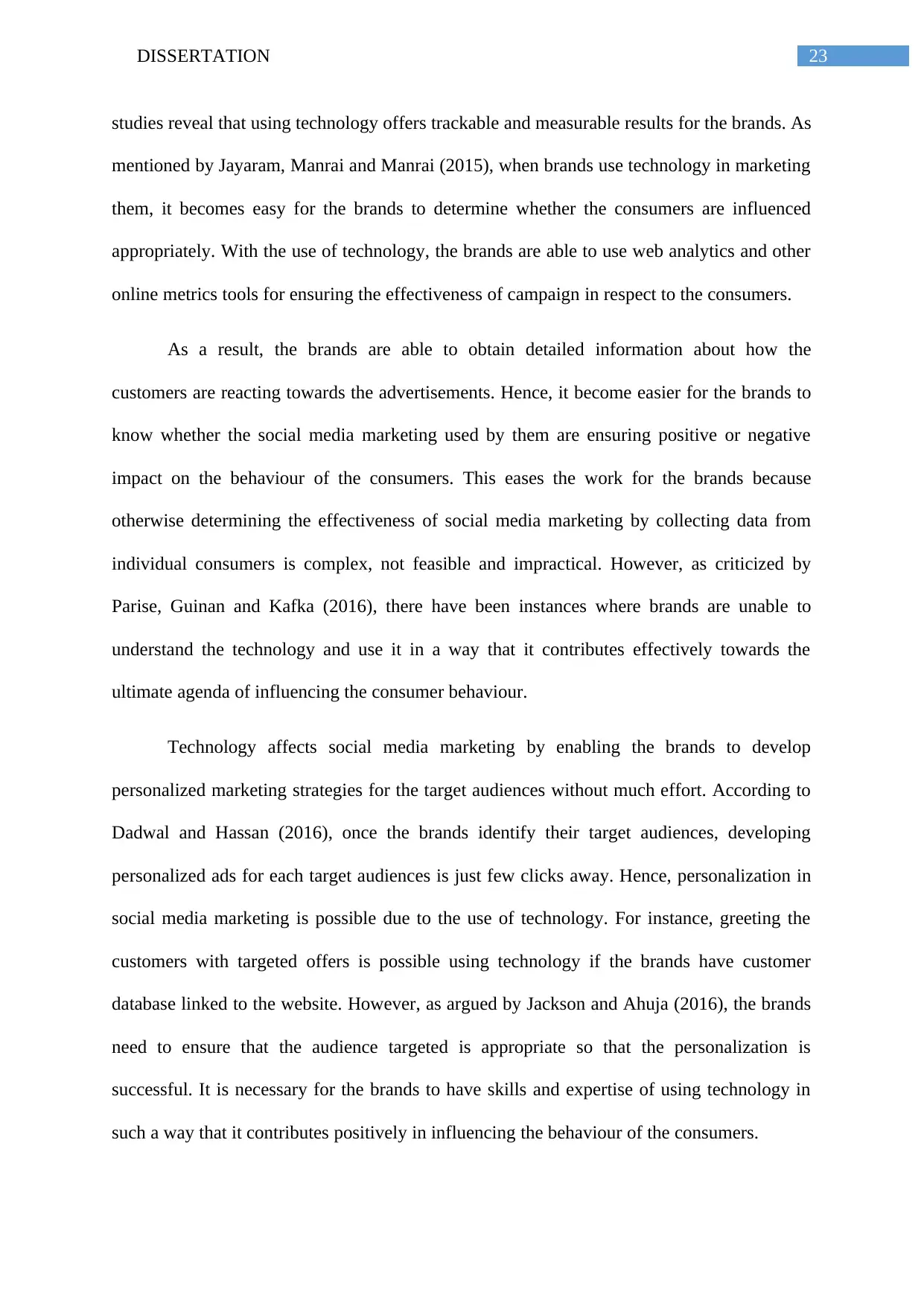
23DISSERTATION
studies reveal that using technology offers trackable and measurable results for the brands. As
mentioned by Jayaram, Manrai and Manrai (2015), when brands use technology in marketing
them, it becomes easy for the brands to determine whether the consumers are influenced
appropriately. With the use of technology, the brands are able to use web analytics and other
online metrics tools for ensuring the effectiveness of campaign in respect to the consumers.
As a result, the brands are able to obtain detailed information about how the
customers are reacting towards the advertisements. Hence, it become easier for the brands to
know whether the social media marketing used by them are ensuring positive or negative
impact on the behaviour of the consumers. This eases the work for the brands because
otherwise determining the effectiveness of social media marketing by collecting data from
individual consumers is complex, not feasible and impractical. However, as criticized by
Parise, Guinan and Kafka (2016), there have been instances where brands are unable to
understand the technology and use it in a way that it contributes effectively towards the
ultimate agenda of influencing the consumer behaviour.
Technology affects social media marketing by enabling the brands to develop
personalized marketing strategies for the target audiences without much effort. According to
Dadwal and Hassan (2016), once the brands identify their target audiences, developing
personalized ads for each target audiences is just few clicks away. Hence, personalization in
social media marketing is possible due to the use of technology. For instance, greeting the
customers with targeted offers is possible using technology if the brands have customer
database linked to the website. However, as argued by Jackson and Ahuja (2016), the brands
need to ensure that the audience targeted is appropriate so that the personalization is
successful. It is necessary for the brands to have skills and expertise of using technology in
such a way that it contributes positively in influencing the behaviour of the consumers.
studies reveal that using technology offers trackable and measurable results for the brands. As
mentioned by Jayaram, Manrai and Manrai (2015), when brands use technology in marketing
them, it becomes easy for the brands to determine whether the consumers are influenced
appropriately. With the use of technology, the brands are able to use web analytics and other
online metrics tools for ensuring the effectiveness of campaign in respect to the consumers.
As a result, the brands are able to obtain detailed information about how the
customers are reacting towards the advertisements. Hence, it become easier for the brands to
know whether the social media marketing used by them are ensuring positive or negative
impact on the behaviour of the consumers. This eases the work for the brands because
otherwise determining the effectiveness of social media marketing by collecting data from
individual consumers is complex, not feasible and impractical. However, as criticized by
Parise, Guinan and Kafka (2016), there have been instances where brands are unable to
understand the technology and use it in a way that it contributes effectively towards the
ultimate agenda of influencing the consumer behaviour.
Technology affects social media marketing by enabling the brands to develop
personalized marketing strategies for the target audiences without much effort. According to
Dadwal and Hassan (2016), once the brands identify their target audiences, developing
personalized ads for each target audiences is just few clicks away. Hence, personalization in
social media marketing is possible due to the use of technology. For instance, greeting the
customers with targeted offers is possible using technology if the brands have customer
database linked to the website. However, as argued by Jackson and Ahuja (2016), the brands
need to ensure that the audience targeted is appropriate so that the personalization is
successful. It is necessary for the brands to have skills and expertise of using technology in
such a way that it contributes positively in influencing the behaviour of the consumers.
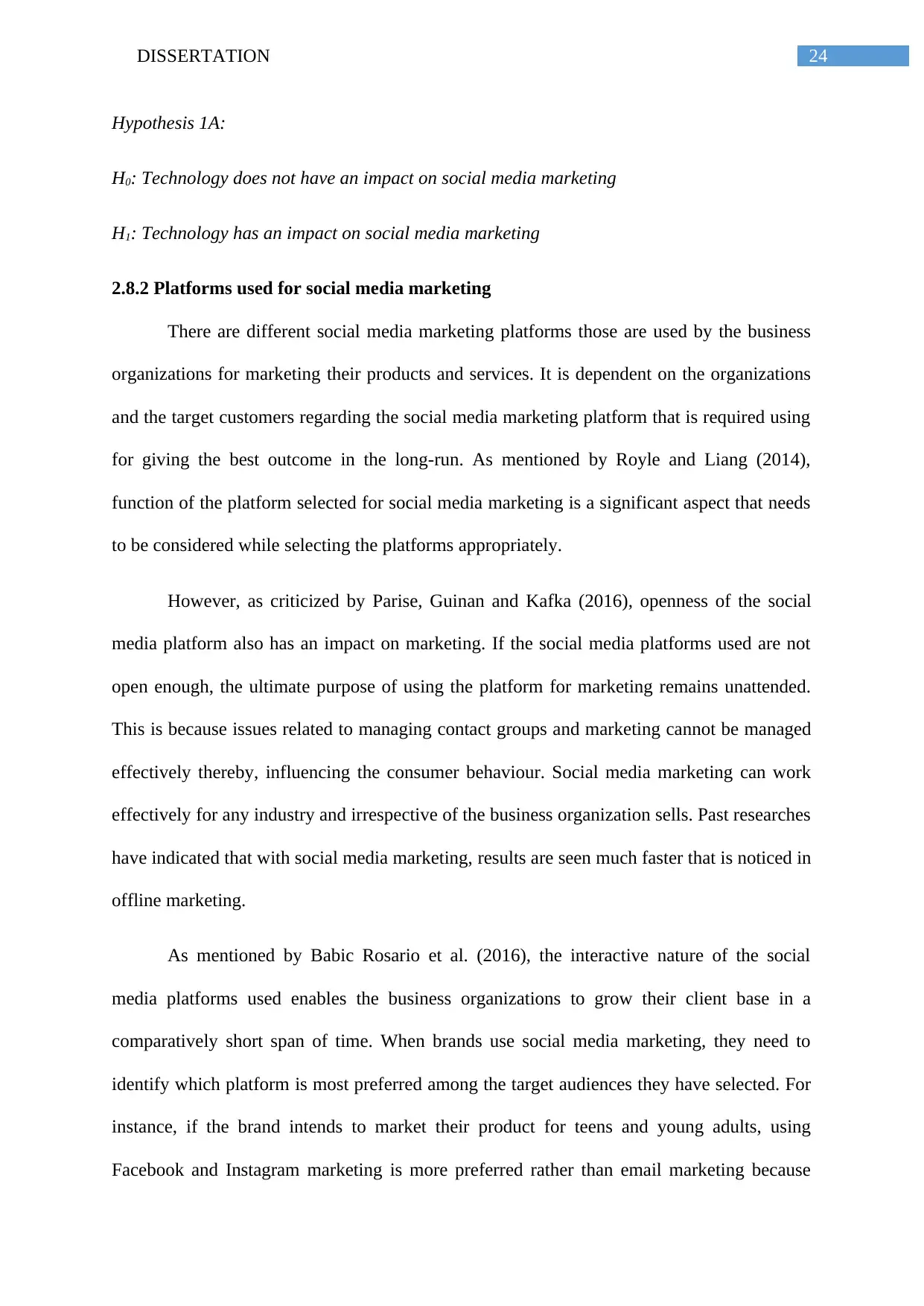
24DISSERTATION
Hypothesis 1A:
H0: Technology does not have an impact on social media marketing
H1: Technology has an impact on social media marketing
2.8.2 Platforms used for social media marketing
There are different social media marketing platforms those are used by the business
organizations for marketing their products and services. It is dependent on the organizations
and the target customers regarding the social media marketing platform that is required using
for giving the best outcome in the long-run. As mentioned by Royle and Liang (2014),
function of the platform selected for social media marketing is a significant aspect that needs
to be considered while selecting the platforms appropriately.
However, as criticized by Parise, Guinan and Kafka (2016), openness of the social
media platform also has an impact on marketing. If the social media platforms used are not
open enough, the ultimate purpose of using the platform for marketing remains unattended.
This is because issues related to managing contact groups and marketing cannot be managed
effectively thereby, influencing the consumer behaviour. Social media marketing can work
effectively for any industry and irrespective of the business organization sells. Past researches
have indicated that with social media marketing, results are seen much faster that is noticed in
offline marketing.
As mentioned by Babic Rosario et al. (2016), the interactive nature of the social
media platforms used enables the business organizations to grow their client base in a
comparatively short span of time. When brands use social media marketing, they need to
identify which platform is most preferred among the target audiences they have selected. For
instance, if the brand intends to market their product for teens and young adults, using
Facebook and Instagram marketing is more preferred rather than email marketing because
Hypothesis 1A:
H0: Technology does not have an impact on social media marketing
H1: Technology has an impact on social media marketing
2.8.2 Platforms used for social media marketing
There are different social media marketing platforms those are used by the business
organizations for marketing their products and services. It is dependent on the organizations
and the target customers regarding the social media marketing platform that is required using
for giving the best outcome in the long-run. As mentioned by Royle and Liang (2014),
function of the platform selected for social media marketing is a significant aspect that needs
to be considered while selecting the platforms appropriately.
However, as criticized by Parise, Guinan and Kafka (2016), openness of the social
media platform also has an impact on marketing. If the social media platforms used are not
open enough, the ultimate purpose of using the platform for marketing remains unattended.
This is because issues related to managing contact groups and marketing cannot be managed
effectively thereby, influencing the consumer behaviour. Social media marketing can work
effectively for any industry and irrespective of the business organization sells. Past researches
have indicated that with social media marketing, results are seen much faster that is noticed in
offline marketing.
As mentioned by Babic Rosario et al. (2016), the interactive nature of the social
media platforms used enables the business organizations to grow their client base in a
comparatively short span of time. When brands use social media marketing, they need to
identify which platform is most preferred among the target audiences they have selected. For
instance, if the brand intends to market their product for teens and young adults, using
Facebook and Instagram marketing is more preferred rather than email marketing because
Paraphrase This Document
Need a fresh take? Get an instant paraphrase of this document with our AI Paraphraser
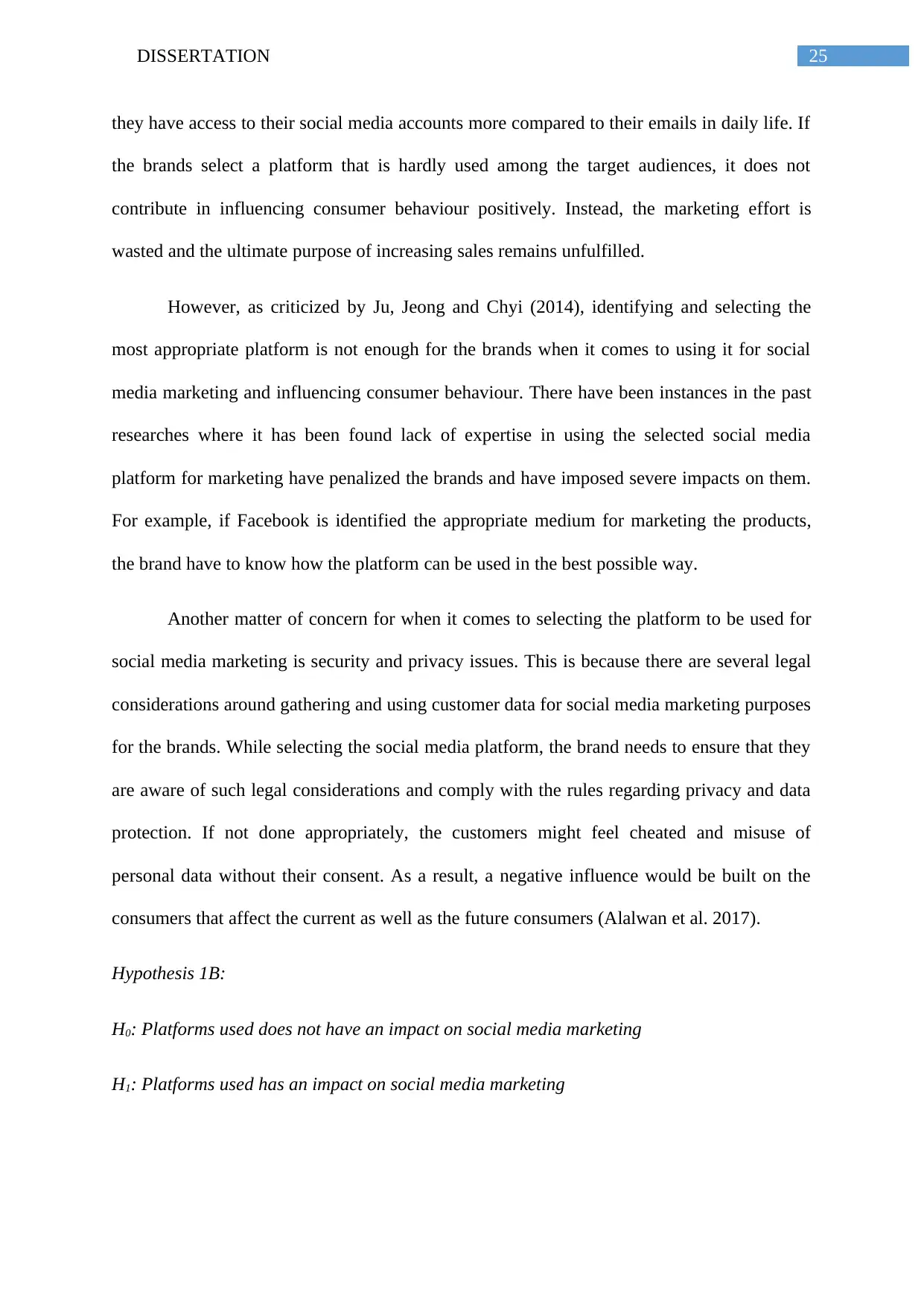
25DISSERTATION
they have access to their social media accounts more compared to their emails in daily life. If
the brands select a platform that is hardly used among the target audiences, it does not
contribute in influencing consumer behaviour positively. Instead, the marketing effort is
wasted and the ultimate purpose of increasing sales remains unfulfilled.
However, as criticized by Ju, Jeong and Chyi (2014), identifying and selecting the
most appropriate platform is not enough for the brands when it comes to using it for social
media marketing and influencing consumer behaviour. There have been instances in the past
researches where it has been found lack of expertise in using the selected social media
platform for marketing have penalized the brands and have imposed severe impacts on them.
For example, if Facebook is identified the appropriate medium for marketing the products,
the brand have to know how the platform can be used in the best possible way.
Another matter of concern for when it comes to selecting the platform to be used for
social media marketing is security and privacy issues. This is because there are several legal
considerations around gathering and using customer data for social media marketing purposes
for the brands. While selecting the social media platform, the brand needs to ensure that they
are aware of such legal considerations and comply with the rules regarding privacy and data
protection. If not done appropriately, the customers might feel cheated and misuse of
personal data without their consent. As a result, a negative influence would be built on the
consumers that affect the current as well as the future consumers (Alalwan et al. 2017).
Hypothesis 1B:
H0: Platforms used does not have an impact on social media marketing
H1: Platforms used has an impact on social media marketing
they have access to their social media accounts more compared to their emails in daily life. If
the brands select a platform that is hardly used among the target audiences, it does not
contribute in influencing consumer behaviour positively. Instead, the marketing effort is
wasted and the ultimate purpose of increasing sales remains unfulfilled.
However, as criticized by Ju, Jeong and Chyi (2014), identifying and selecting the
most appropriate platform is not enough for the brands when it comes to using it for social
media marketing and influencing consumer behaviour. There have been instances in the past
researches where it has been found lack of expertise in using the selected social media
platform for marketing have penalized the brands and have imposed severe impacts on them.
For example, if Facebook is identified the appropriate medium for marketing the products,
the brand have to know how the platform can be used in the best possible way.
Another matter of concern for when it comes to selecting the platform to be used for
social media marketing is security and privacy issues. This is because there are several legal
considerations around gathering and using customer data for social media marketing purposes
for the brands. While selecting the social media platform, the brand needs to ensure that they
are aware of such legal considerations and comply with the rules regarding privacy and data
protection. If not done appropriately, the customers might feel cheated and misuse of
personal data without their consent. As a result, a negative influence would be built on the
consumers that affect the current as well as the future consumers (Alalwan et al. 2017).
Hypothesis 1B:
H0: Platforms used does not have an impact on social media marketing
H1: Platforms used has an impact on social media marketing
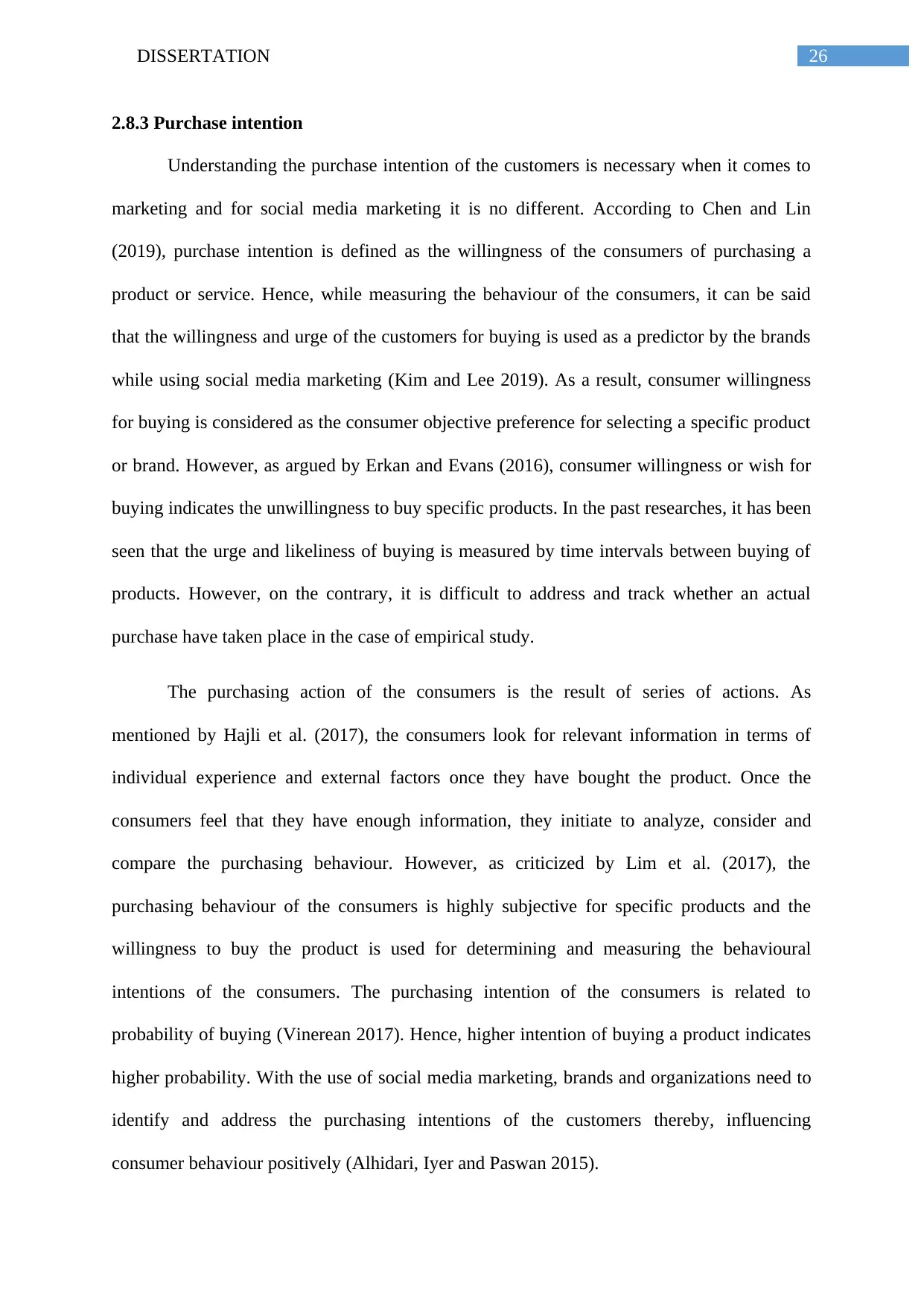
26DISSERTATION
2.8.3 Purchase intention
Understanding the purchase intention of the customers is necessary when it comes to
marketing and for social media marketing it is no different. According to Chen and Lin
(2019), purchase intention is defined as the willingness of the consumers of purchasing a
product or service. Hence, while measuring the behaviour of the consumers, it can be said
that the willingness and urge of the customers for buying is used as a predictor by the brands
while using social media marketing (Kim and Lee 2019). As a result, consumer willingness
for buying is considered as the consumer objective preference for selecting a specific product
or brand. However, as argued by Erkan and Evans (2016), consumer willingness or wish for
buying indicates the unwillingness to buy specific products. In the past researches, it has been
seen that the urge and likeliness of buying is measured by time intervals between buying of
products. However, on the contrary, it is difficult to address and track whether an actual
purchase have taken place in the case of empirical study.
The purchasing action of the consumers is the result of series of actions. As
mentioned by Hajli et al. (2017), the consumers look for relevant information in terms of
individual experience and external factors once they have bought the product. Once the
consumers feel that they have enough information, they initiate to analyze, consider and
compare the purchasing behaviour. However, as criticized by Lim et al. (2017), the
purchasing behaviour of the consumers is highly subjective for specific products and the
willingness to buy the product is used for determining and measuring the behavioural
intentions of the consumers. The purchasing intention of the consumers is related to
probability of buying (Vinerean 2017). Hence, higher intention of buying a product indicates
higher probability. With the use of social media marketing, brands and organizations need to
identify and address the purchasing intentions of the customers thereby, influencing
consumer behaviour positively (Alhidari, Iyer and Paswan 2015).
2.8.3 Purchase intention
Understanding the purchase intention of the customers is necessary when it comes to
marketing and for social media marketing it is no different. According to Chen and Lin
(2019), purchase intention is defined as the willingness of the consumers of purchasing a
product or service. Hence, while measuring the behaviour of the consumers, it can be said
that the willingness and urge of the customers for buying is used as a predictor by the brands
while using social media marketing (Kim and Lee 2019). As a result, consumer willingness
for buying is considered as the consumer objective preference for selecting a specific product
or brand. However, as argued by Erkan and Evans (2016), consumer willingness or wish for
buying indicates the unwillingness to buy specific products. In the past researches, it has been
seen that the urge and likeliness of buying is measured by time intervals between buying of
products. However, on the contrary, it is difficult to address and track whether an actual
purchase have taken place in the case of empirical study.
The purchasing action of the consumers is the result of series of actions. As
mentioned by Hajli et al. (2017), the consumers look for relevant information in terms of
individual experience and external factors once they have bought the product. Once the
consumers feel that they have enough information, they initiate to analyze, consider and
compare the purchasing behaviour. However, as criticized by Lim et al. (2017), the
purchasing behaviour of the consumers is highly subjective for specific products and the
willingness to buy the product is used for determining and measuring the behavioural
intentions of the consumers. The purchasing intention of the consumers is related to
probability of buying (Vinerean 2017). Hence, higher intention of buying a product indicates
higher probability. With the use of social media marketing, brands and organizations need to
identify and address the purchasing intentions of the customers thereby, influencing
consumer behaviour positively (Alhidari, Iyer and Paswan 2015).
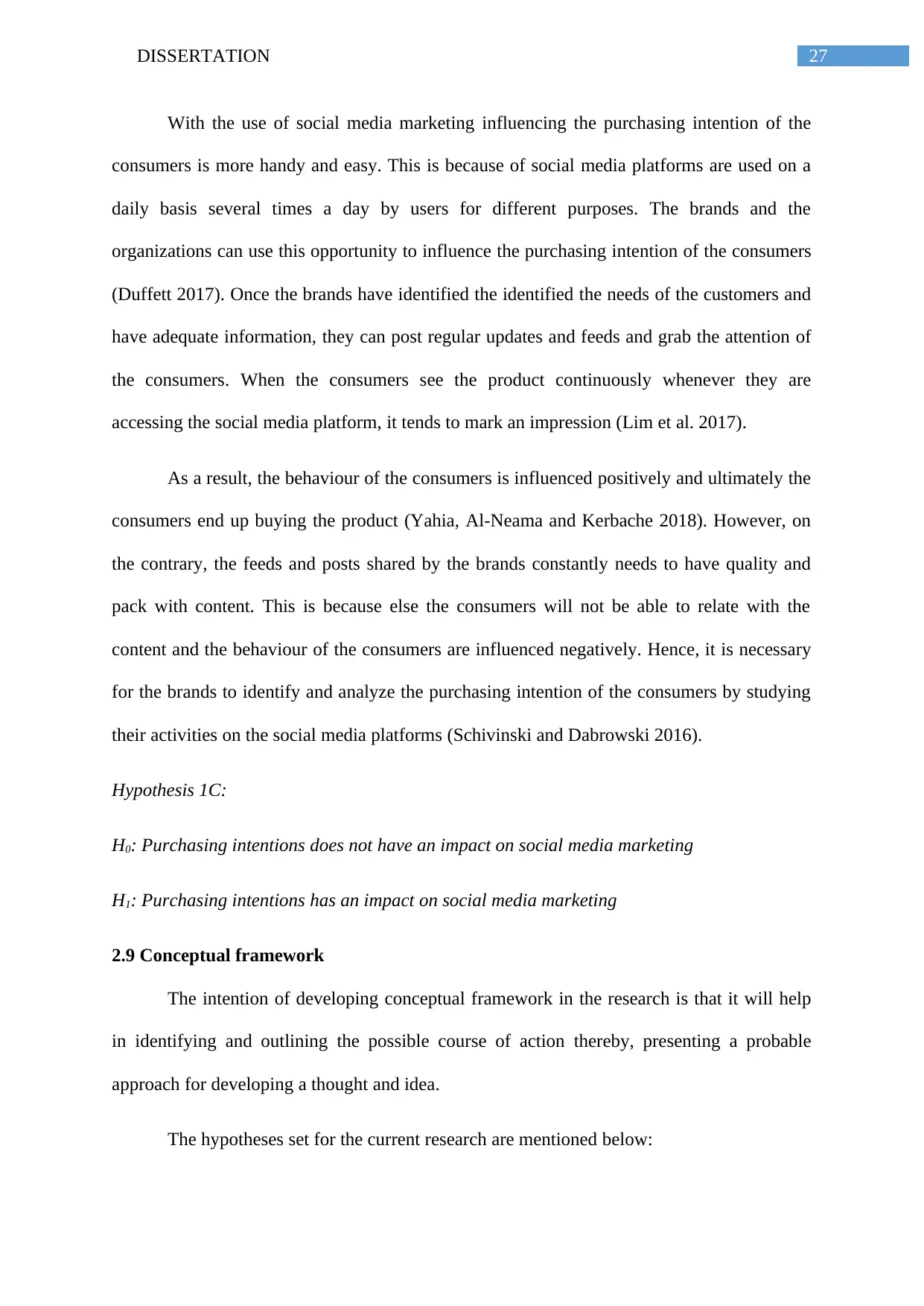
27DISSERTATION
With the use of social media marketing influencing the purchasing intention of the
consumers is more handy and easy. This is because of social media platforms are used on a
daily basis several times a day by users for different purposes. The brands and the
organizations can use this opportunity to influence the purchasing intention of the consumers
(Duffett 2017). Once the brands have identified the identified the needs of the customers and
have adequate information, they can post regular updates and feeds and grab the attention of
the consumers. When the consumers see the product continuously whenever they are
accessing the social media platform, it tends to mark an impression (Lim et al. 2017).
As a result, the behaviour of the consumers is influenced positively and ultimately the
consumers end up buying the product (Yahia, Al-Neama and Kerbache 2018). However, on
the contrary, the feeds and posts shared by the brands constantly needs to have quality and
pack with content. This is because else the consumers will not be able to relate with the
content and the behaviour of the consumers are influenced negatively. Hence, it is necessary
for the brands to identify and analyze the purchasing intention of the consumers by studying
their activities on the social media platforms (Schivinski and Dabrowski 2016).
Hypothesis 1C:
H0: Purchasing intentions does not have an impact on social media marketing
H1: Purchasing intentions has an impact on social media marketing
2.9 Conceptual framework
The intention of developing conceptual framework in the research is that it will help
in identifying and outlining the possible course of action thereby, presenting a probable
approach for developing a thought and idea.
The hypotheses set for the current research are mentioned below:
With the use of social media marketing influencing the purchasing intention of the
consumers is more handy and easy. This is because of social media platforms are used on a
daily basis several times a day by users for different purposes. The brands and the
organizations can use this opportunity to influence the purchasing intention of the consumers
(Duffett 2017). Once the brands have identified the identified the needs of the customers and
have adequate information, they can post regular updates and feeds and grab the attention of
the consumers. When the consumers see the product continuously whenever they are
accessing the social media platform, it tends to mark an impression (Lim et al. 2017).
As a result, the behaviour of the consumers is influenced positively and ultimately the
consumers end up buying the product (Yahia, Al-Neama and Kerbache 2018). However, on
the contrary, the feeds and posts shared by the brands constantly needs to have quality and
pack with content. This is because else the consumers will not be able to relate with the
content and the behaviour of the consumers are influenced negatively. Hence, it is necessary
for the brands to identify and analyze the purchasing intention of the consumers by studying
their activities on the social media platforms (Schivinski and Dabrowski 2016).
Hypothesis 1C:
H0: Purchasing intentions does not have an impact on social media marketing
H1: Purchasing intentions has an impact on social media marketing
2.9 Conceptual framework
The intention of developing conceptual framework in the research is that it will help
in identifying and outlining the possible course of action thereby, presenting a probable
approach for developing a thought and idea.
The hypotheses set for the current research are mentioned below:
Secure Best Marks with AI Grader
Need help grading? Try our AI Grader for instant feedback on your assignments.
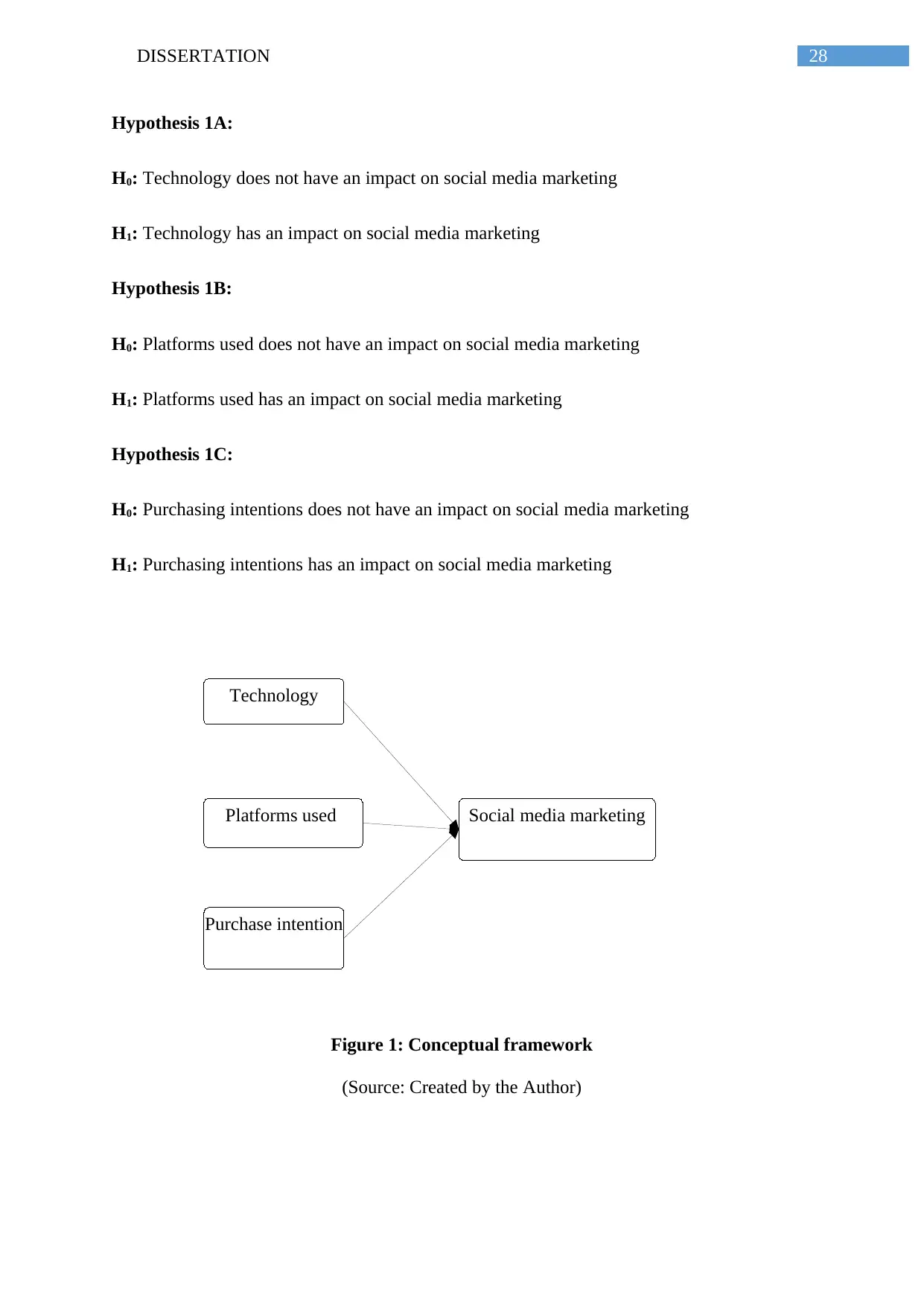
28DISSERTATION
Social media marketing
Technology
Platforms used
Purchase intention
Hypothesis 1A:
H0: Technology does not have an impact on social media marketing
H1: Technology has an impact on social media marketing
Hypothesis 1B:
H0: Platforms used does not have an impact on social media marketing
H1: Platforms used has an impact on social media marketing
Hypothesis 1C:
H0: Purchasing intentions does not have an impact on social media marketing
H1: Purchasing intentions has an impact on social media marketing
Figure 1: Conceptual framework
(Source: Created by the Author)
Social media marketing
Technology
Platforms used
Purchase intention
Hypothesis 1A:
H0: Technology does not have an impact on social media marketing
H1: Technology has an impact on social media marketing
Hypothesis 1B:
H0: Platforms used does not have an impact on social media marketing
H1: Platforms used has an impact on social media marketing
Hypothesis 1C:
H0: Purchasing intentions does not have an impact on social media marketing
H1: Purchasing intentions has an impact on social media marketing
Figure 1: Conceptual framework
(Source: Created by the Author)
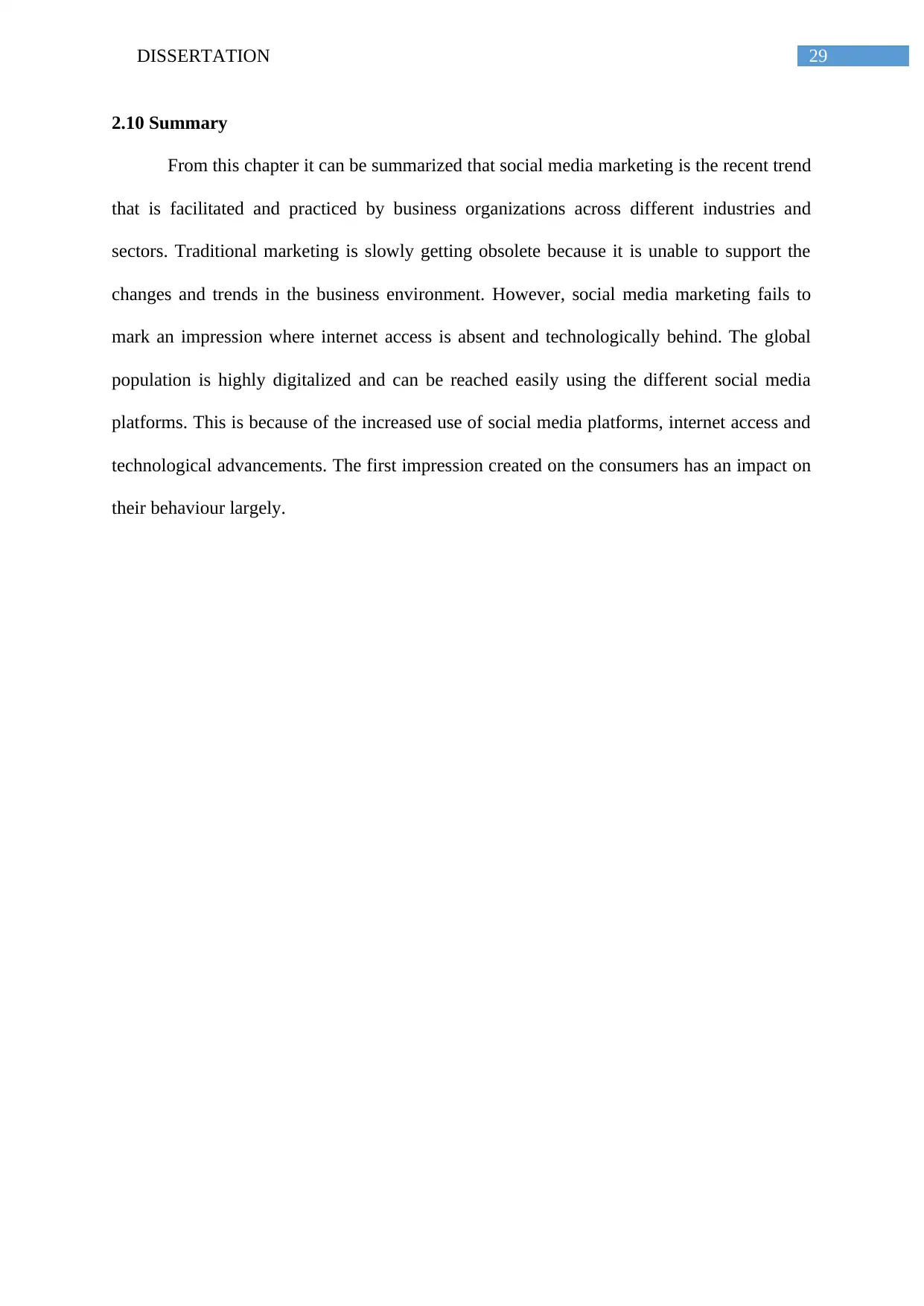
29DISSERTATION
2.10 Summary
From this chapter it can be summarized that social media marketing is the recent trend
that is facilitated and practiced by business organizations across different industries and
sectors. Traditional marketing is slowly getting obsolete because it is unable to support the
changes and trends in the business environment. However, social media marketing fails to
mark an impression where internet access is absent and technologically behind. The global
population is highly digitalized and can be reached easily using the different social media
platforms. This is because of the increased use of social media platforms, internet access and
technological advancements. The first impression created on the consumers has an impact on
their behaviour largely.
2.10 Summary
From this chapter it can be summarized that social media marketing is the recent trend
that is facilitated and practiced by business organizations across different industries and
sectors. Traditional marketing is slowly getting obsolete because it is unable to support the
changes and trends in the business environment. However, social media marketing fails to
mark an impression where internet access is absent and technologically behind. The global
population is highly digitalized and can be reached easily using the different social media
platforms. This is because of the increased use of social media platforms, internet access and
technological advancements. The first impression created on the consumers has an impact on
their behaviour largely.
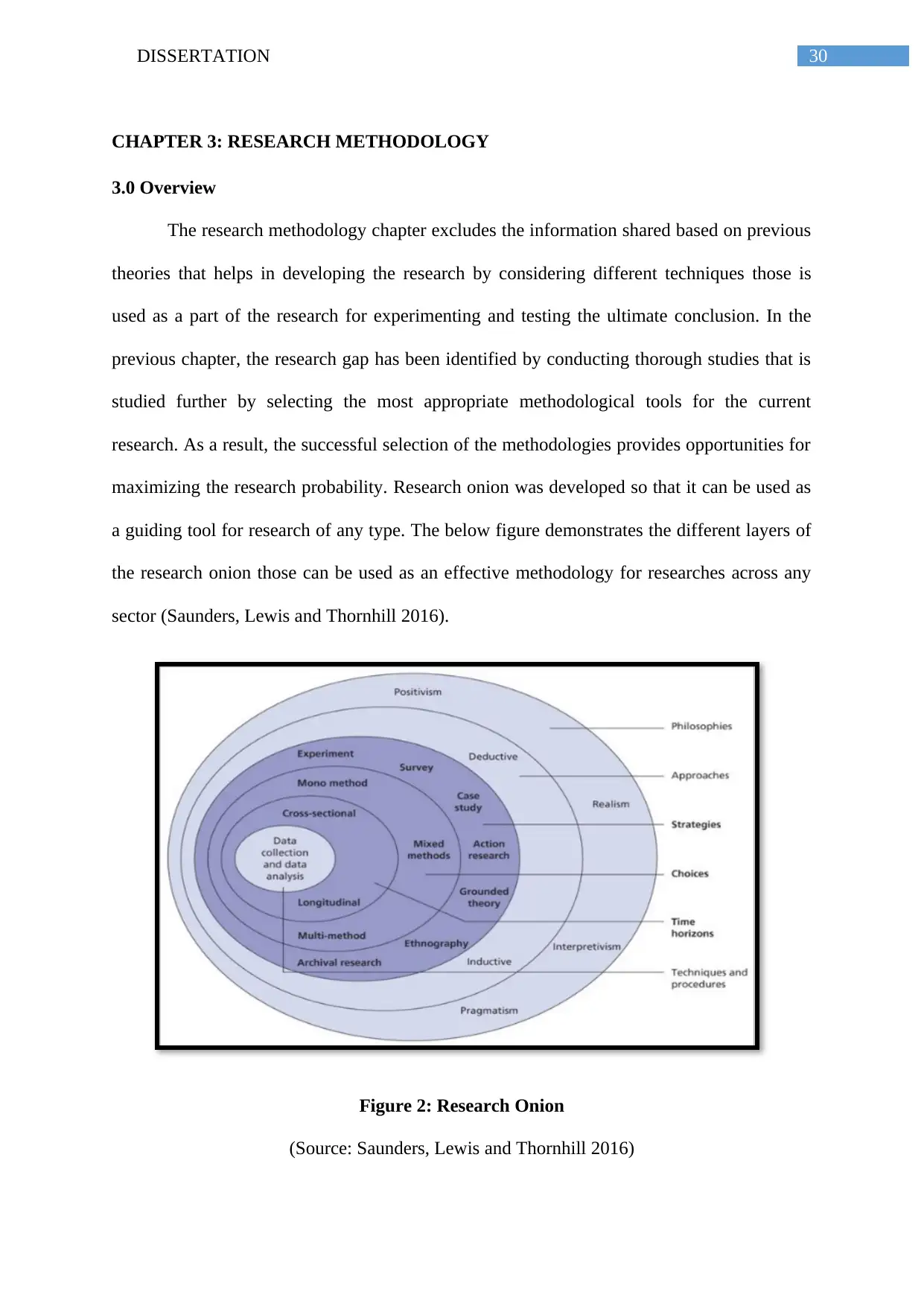
30DISSERTATION
CHAPTER 3: RESEARCH METHODOLOGY
3.0 Overview
The research methodology chapter excludes the information shared based on previous
theories that helps in developing the research by considering different techniques those is
used as a part of the research for experimenting and testing the ultimate conclusion. In the
previous chapter, the research gap has been identified by conducting thorough studies that is
studied further by selecting the most appropriate methodological tools for the current
research. As a result, the successful selection of the methodologies provides opportunities for
maximizing the research probability. Research onion was developed so that it can be used as
a guiding tool for research of any type. The below figure demonstrates the different layers of
the research onion those can be used as an effective methodology for researches across any
sector (Saunders, Lewis and Thornhill 2016).
Figure 2: Research Onion
(Source: Saunders, Lewis and Thornhill 2016)
CHAPTER 3: RESEARCH METHODOLOGY
3.0 Overview
The research methodology chapter excludes the information shared based on previous
theories that helps in developing the research by considering different techniques those is
used as a part of the research for experimenting and testing the ultimate conclusion. In the
previous chapter, the research gap has been identified by conducting thorough studies that is
studied further by selecting the most appropriate methodological tools for the current
research. As a result, the successful selection of the methodologies provides opportunities for
maximizing the research probability. Research onion was developed so that it can be used as
a guiding tool for research of any type. The below figure demonstrates the different layers of
the research onion those can be used as an effective methodology for researches across any
sector (Saunders, Lewis and Thornhill 2016).
Figure 2: Research Onion
(Source: Saunders, Lewis and Thornhill 2016)
Paraphrase This Document
Need a fresh take? Get an instant paraphrase of this document with our AI Paraphraser
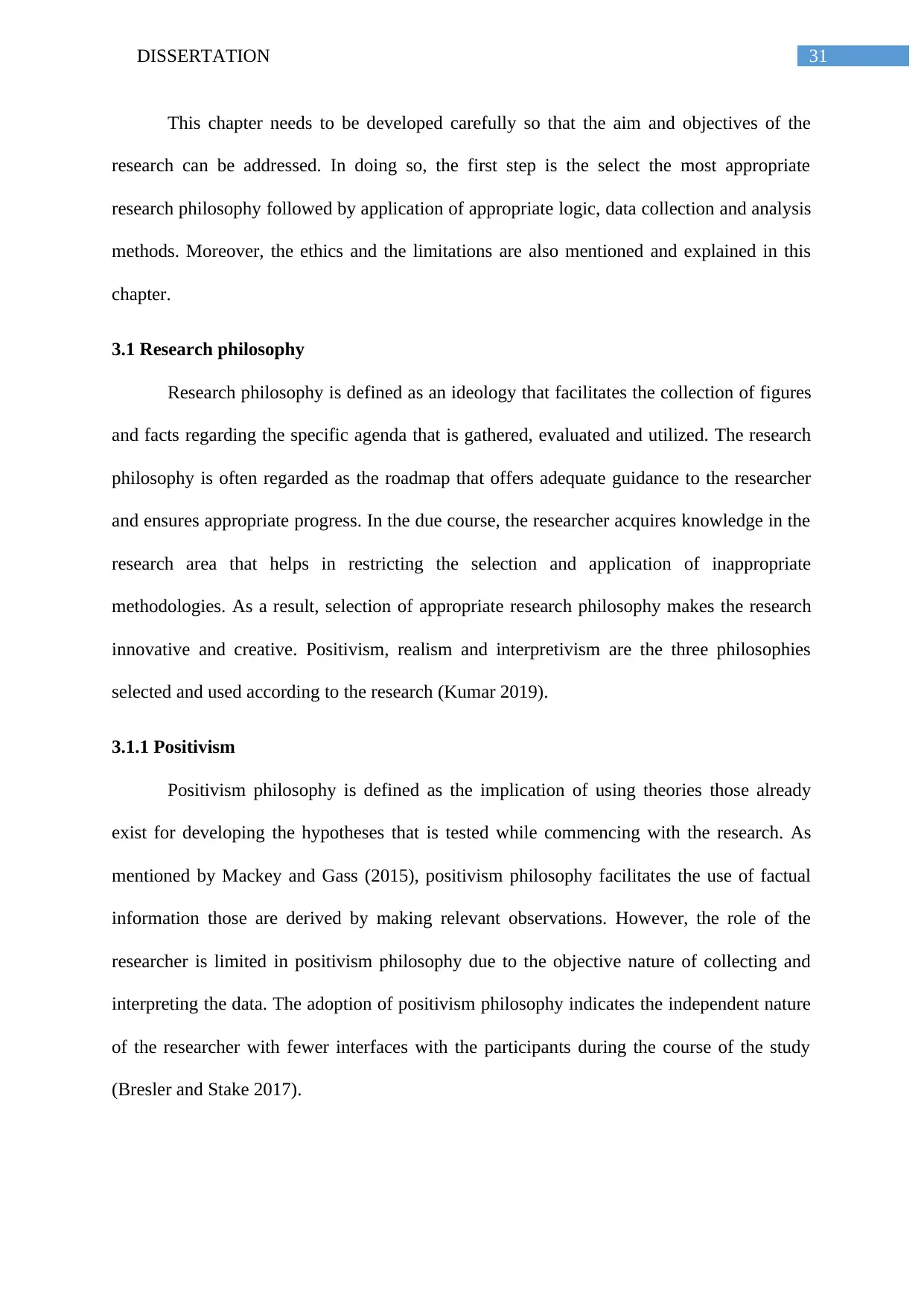
31DISSERTATION
This chapter needs to be developed carefully so that the aim and objectives of the
research can be addressed. In doing so, the first step is the select the most appropriate
research philosophy followed by application of appropriate logic, data collection and analysis
methods. Moreover, the ethics and the limitations are also mentioned and explained in this
chapter.
3.1 Research philosophy
Research philosophy is defined as an ideology that facilitates the collection of figures
and facts regarding the specific agenda that is gathered, evaluated and utilized. The research
philosophy is often regarded as the roadmap that offers adequate guidance to the researcher
and ensures appropriate progress. In the due course, the researcher acquires knowledge in the
research area that helps in restricting the selection and application of inappropriate
methodologies. As a result, selection of appropriate research philosophy makes the research
innovative and creative. Positivism, realism and interpretivism are the three philosophies
selected and used according to the research (Kumar 2019).
3.1.1 Positivism
Positivism philosophy is defined as the implication of using theories those already
exist for developing the hypotheses that is tested while commencing with the research. As
mentioned by Mackey and Gass (2015), positivism philosophy facilitates the use of factual
information those are derived by making relevant observations. However, the role of the
researcher is limited in positivism philosophy due to the objective nature of collecting and
interpreting the data. The adoption of positivism philosophy indicates the independent nature
of the researcher with fewer interfaces with the participants during the course of the study
(Bresler and Stake 2017).
This chapter needs to be developed carefully so that the aim and objectives of the
research can be addressed. In doing so, the first step is the select the most appropriate
research philosophy followed by application of appropriate logic, data collection and analysis
methods. Moreover, the ethics and the limitations are also mentioned and explained in this
chapter.
3.1 Research philosophy
Research philosophy is defined as an ideology that facilitates the collection of figures
and facts regarding the specific agenda that is gathered, evaluated and utilized. The research
philosophy is often regarded as the roadmap that offers adequate guidance to the researcher
and ensures appropriate progress. In the due course, the researcher acquires knowledge in the
research area that helps in restricting the selection and application of inappropriate
methodologies. As a result, selection of appropriate research philosophy makes the research
innovative and creative. Positivism, realism and interpretivism are the three philosophies
selected and used according to the research (Kumar 2019).
3.1.1 Positivism
Positivism philosophy is defined as the implication of using theories those already
exist for developing the hypotheses that is tested while commencing with the research. As
mentioned by Mackey and Gass (2015), positivism philosophy facilitates the use of factual
information those are derived by making relevant observations. However, the role of the
researcher is limited in positivism philosophy due to the objective nature of collecting and
interpreting the data. The adoption of positivism philosophy indicates the independent nature
of the researcher with fewer interfaces with the participants during the course of the study
(Bresler and Stake 2017).
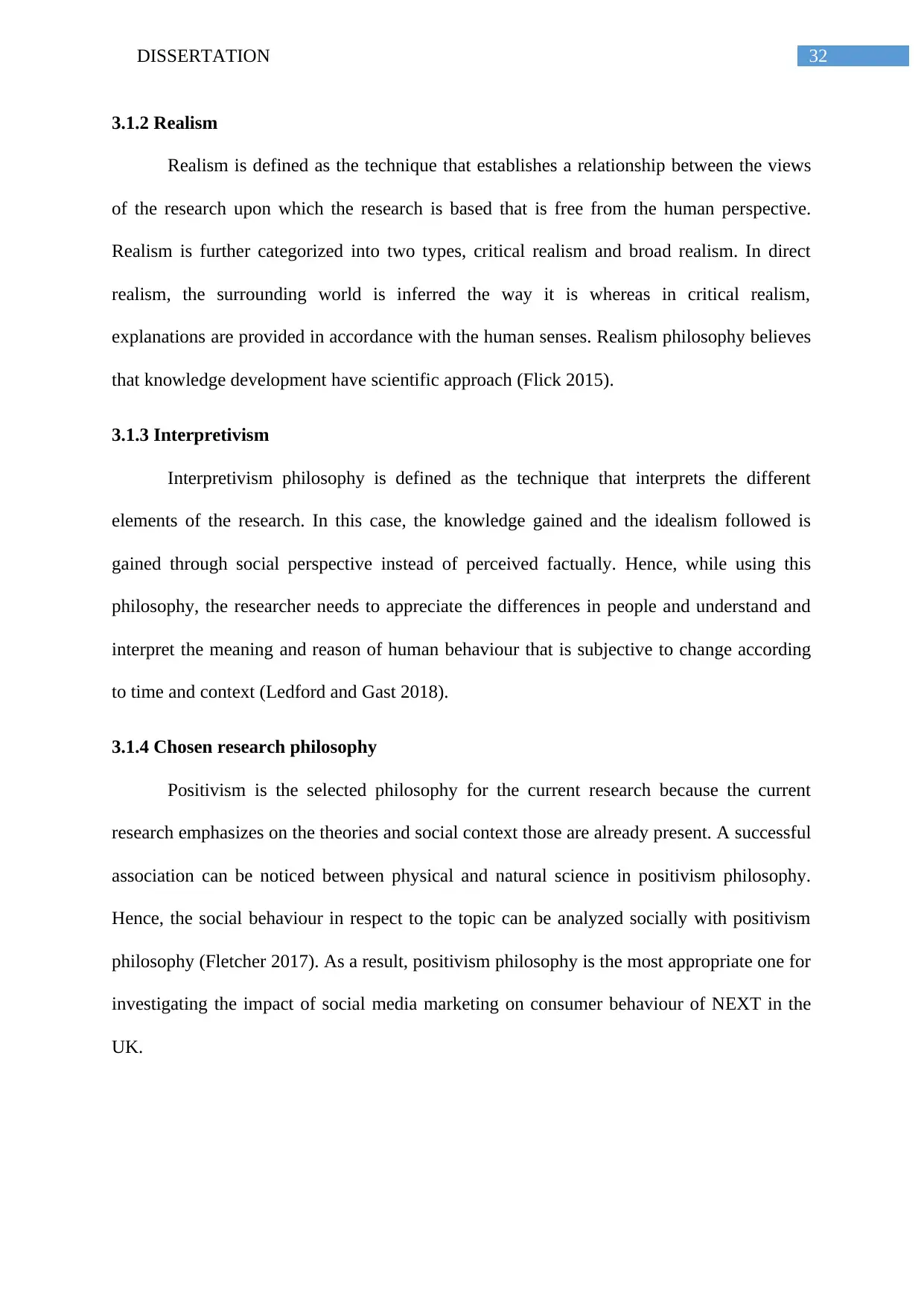
32DISSERTATION
3.1.2 Realism
Realism is defined as the technique that establishes a relationship between the views
of the research upon which the research is based that is free from the human perspective.
Realism is further categorized into two types, critical realism and broad realism. In direct
realism, the surrounding world is inferred the way it is whereas in critical realism,
explanations are provided in accordance with the human senses. Realism philosophy believes
that knowledge development have scientific approach (Flick 2015).
3.1.3 Interpretivism
Interpretivism philosophy is defined as the technique that interprets the different
elements of the research. In this case, the knowledge gained and the idealism followed is
gained through social perspective instead of perceived factually. Hence, while using this
philosophy, the researcher needs to appreciate the differences in people and understand and
interpret the meaning and reason of human behaviour that is subjective to change according
to time and context (Ledford and Gast 2018).
3.1.4 Chosen research philosophy
Positivism is the selected philosophy for the current research because the current
research emphasizes on the theories and social context those are already present. A successful
association can be noticed between physical and natural science in positivism philosophy.
Hence, the social behaviour in respect to the topic can be analyzed socially with positivism
philosophy (Fletcher 2017). As a result, positivism philosophy is the most appropriate one for
investigating the impact of social media marketing on consumer behaviour of NEXT in the
UK.
3.1.2 Realism
Realism is defined as the technique that establishes a relationship between the views
of the research upon which the research is based that is free from the human perspective.
Realism is further categorized into two types, critical realism and broad realism. In direct
realism, the surrounding world is inferred the way it is whereas in critical realism,
explanations are provided in accordance with the human senses. Realism philosophy believes
that knowledge development have scientific approach (Flick 2015).
3.1.3 Interpretivism
Interpretivism philosophy is defined as the technique that interprets the different
elements of the research. In this case, the knowledge gained and the idealism followed is
gained through social perspective instead of perceived factually. Hence, while using this
philosophy, the researcher needs to appreciate the differences in people and understand and
interpret the meaning and reason of human behaviour that is subjective to change according
to time and context (Ledford and Gast 2018).
3.1.4 Chosen research philosophy
Positivism is the selected philosophy for the current research because the current
research emphasizes on the theories and social context those are already present. A successful
association can be noticed between physical and natural science in positivism philosophy.
Hence, the social behaviour in respect to the topic can be analyzed socially with positivism
philosophy (Fletcher 2017). As a result, positivism philosophy is the most appropriate one for
investigating the impact of social media marketing on consumer behaviour of NEXT in the
UK.
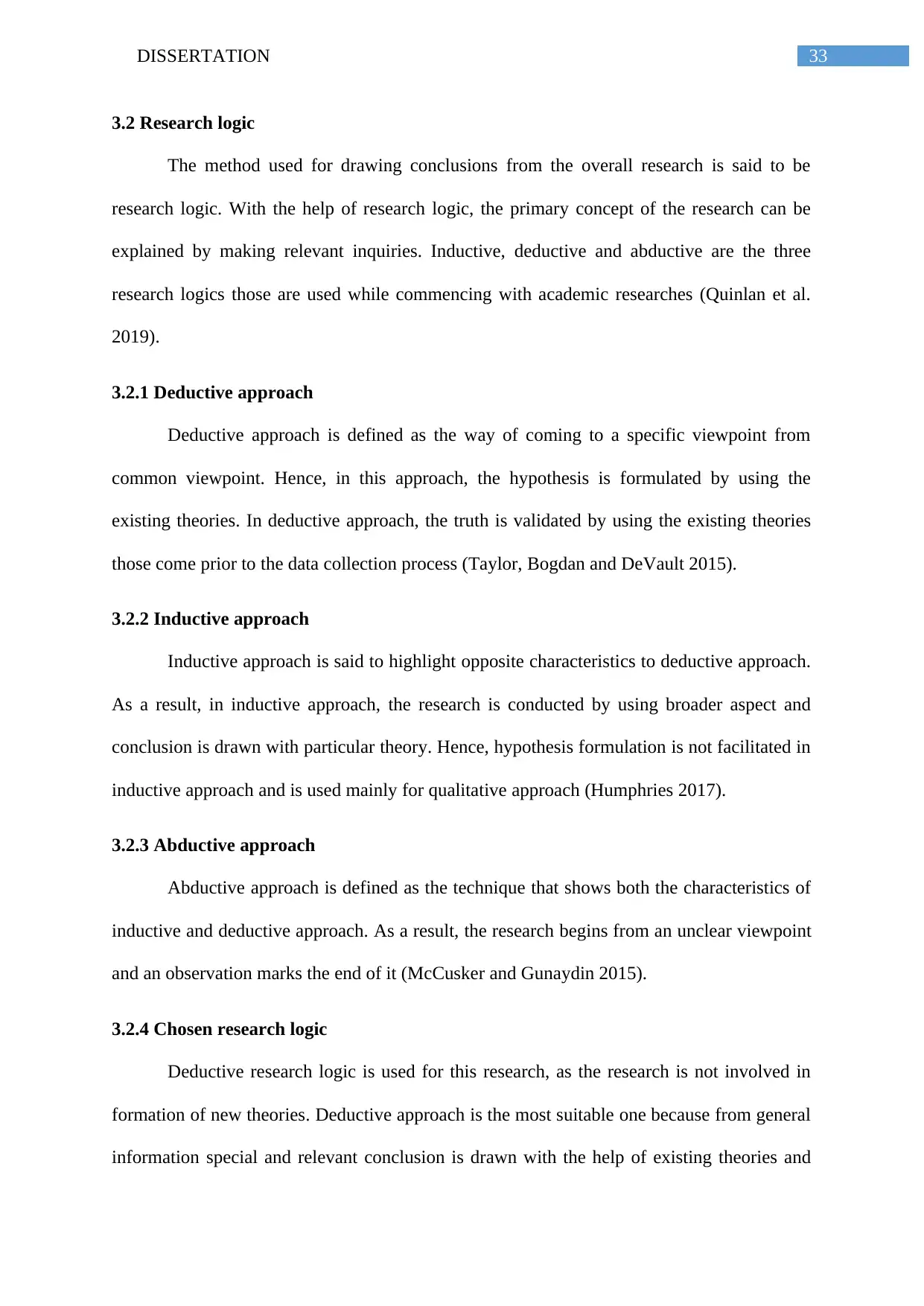
33DISSERTATION
3.2 Research logic
The method used for drawing conclusions from the overall research is said to be
research logic. With the help of research logic, the primary concept of the research can be
explained by making relevant inquiries. Inductive, deductive and abductive are the three
research logics those are used while commencing with academic researches (Quinlan et al.
2019).
3.2.1 Deductive approach
Deductive approach is defined as the way of coming to a specific viewpoint from
common viewpoint. Hence, in this approach, the hypothesis is formulated by using the
existing theories. In deductive approach, the truth is validated by using the existing theories
those come prior to the data collection process (Taylor, Bogdan and DeVault 2015).
3.2.2 Inductive approach
Inductive approach is said to highlight opposite characteristics to deductive approach.
As a result, in inductive approach, the research is conducted by using broader aspect and
conclusion is drawn with particular theory. Hence, hypothesis formulation is not facilitated in
inductive approach and is used mainly for qualitative approach (Humphries 2017).
3.2.3 Abductive approach
Abductive approach is defined as the technique that shows both the characteristics of
inductive and deductive approach. As a result, the research begins from an unclear viewpoint
and an observation marks the end of it (McCusker and Gunaydin 2015).
3.2.4 Chosen research logic
Deductive research logic is used for this research, as the research is not involved in
formation of new theories. Deductive approach is the most suitable one because from general
information special and relevant conclusion is drawn with the help of existing theories and
3.2 Research logic
The method used for drawing conclusions from the overall research is said to be
research logic. With the help of research logic, the primary concept of the research can be
explained by making relevant inquiries. Inductive, deductive and abductive are the three
research logics those are used while commencing with academic researches (Quinlan et al.
2019).
3.2.1 Deductive approach
Deductive approach is defined as the way of coming to a specific viewpoint from
common viewpoint. Hence, in this approach, the hypothesis is formulated by using the
existing theories. In deductive approach, the truth is validated by using the existing theories
those come prior to the data collection process (Taylor, Bogdan and DeVault 2015).
3.2.2 Inductive approach
Inductive approach is said to highlight opposite characteristics to deductive approach.
As a result, in inductive approach, the research is conducted by using broader aspect and
conclusion is drawn with particular theory. Hence, hypothesis formulation is not facilitated in
inductive approach and is used mainly for qualitative approach (Humphries 2017).
3.2.3 Abductive approach
Abductive approach is defined as the technique that shows both the characteristics of
inductive and deductive approach. As a result, the research begins from an unclear viewpoint
and an observation marks the end of it (McCusker and Gunaydin 2015).
3.2.4 Chosen research logic
Deductive research logic is used for this research, as the research is not involved in
formation of new theories. Deductive approach is the most suitable one because from general
information special and relevant conclusion is drawn with the help of existing theories and
Secure Best Marks with AI Grader
Need help grading? Try our AI Grader for instant feedback on your assignments.
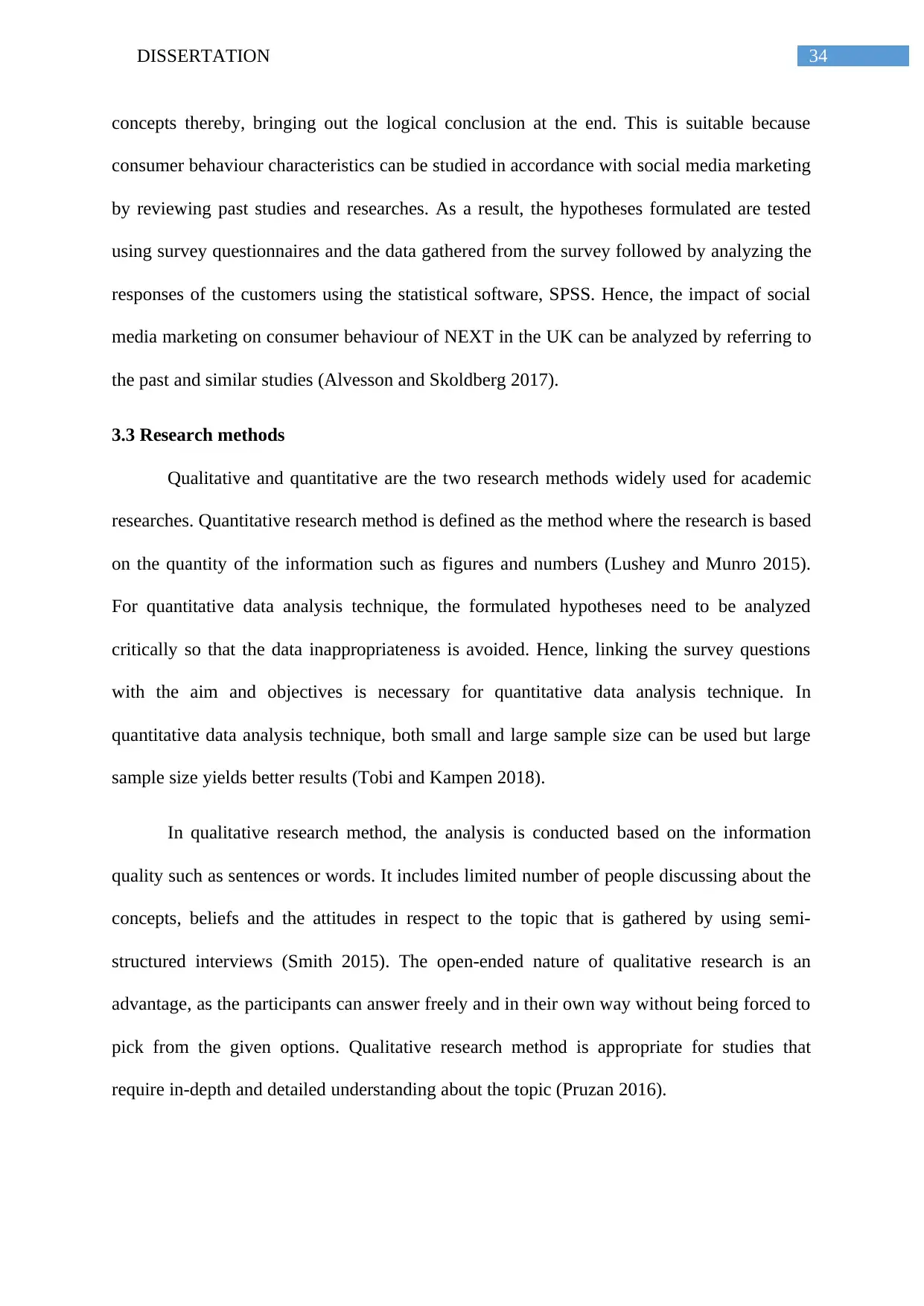
34DISSERTATION
concepts thereby, bringing out the logical conclusion at the end. This is suitable because
consumer behaviour characteristics can be studied in accordance with social media marketing
by reviewing past studies and researches. As a result, the hypotheses formulated are tested
using survey questionnaires and the data gathered from the survey followed by analyzing the
responses of the customers using the statistical software, SPSS. Hence, the impact of social
media marketing on consumer behaviour of NEXT in the UK can be analyzed by referring to
the past and similar studies (Alvesson and Skoldberg 2017).
3.3 Research methods
Qualitative and quantitative are the two research methods widely used for academic
researches. Quantitative research method is defined as the method where the research is based
on the quantity of the information such as figures and numbers (Lushey and Munro 2015).
For quantitative data analysis technique, the formulated hypotheses need to be analyzed
critically so that the data inappropriateness is avoided. Hence, linking the survey questions
with the aim and objectives is necessary for quantitative data analysis technique. In
quantitative data analysis technique, both small and large sample size can be used but large
sample size yields better results (Tobi and Kampen 2018).
In qualitative research method, the analysis is conducted based on the information
quality such as sentences or words. It includes limited number of people discussing about the
concepts, beliefs and the attitudes in respect to the topic that is gathered by using semi-
structured interviews (Smith 2015). The open-ended nature of qualitative research is an
advantage, as the participants can answer freely and in their own way without being forced to
pick from the given options. Qualitative research method is appropriate for studies that
require in-depth and detailed understanding about the topic (Pruzan 2016).
concepts thereby, bringing out the logical conclusion at the end. This is suitable because
consumer behaviour characteristics can be studied in accordance with social media marketing
by reviewing past studies and researches. As a result, the hypotheses formulated are tested
using survey questionnaires and the data gathered from the survey followed by analyzing the
responses of the customers using the statistical software, SPSS. Hence, the impact of social
media marketing on consumer behaviour of NEXT in the UK can be analyzed by referring to
the past and similar studies (Alvesson and Skoldberg 2017).
3.3 Research methods
Qualitative and quantitative are the two research methods widely used for academic
researches. Quantitative research method is defined as the method where the research is based
on the quantity of the information such as figures and numbers (Lushey and Munro 2015).
For quantitative data analysis technique, the formulated hypotheses need to be analyzed
critically so that the data inappropriateness is avoided. Hence, linking the survey questions
with the aim and objectives is necessary for quantitative data analysis technique. In
quantitative data analysis technique, both small and large sample size can be used but large
sample size yields better results (Tobi and Kampen 2018).
In qualitative research method, the analysis is conducted based on the information
quality such as sentences or words. It includes limited number of people discussing about the
concepts, beliefs and the attitudes in respect to the topic that is gathered by using semi-
structured interviews (Smith 2015). The open-ended nature of qualitative research is an
advantage, as the participants can answer freely and in their own way without being forced to
pick from the given options. Qualitative research method is appropriate for studies that
require in-depth and detailed understanding about the topic (Pruzan 2016).
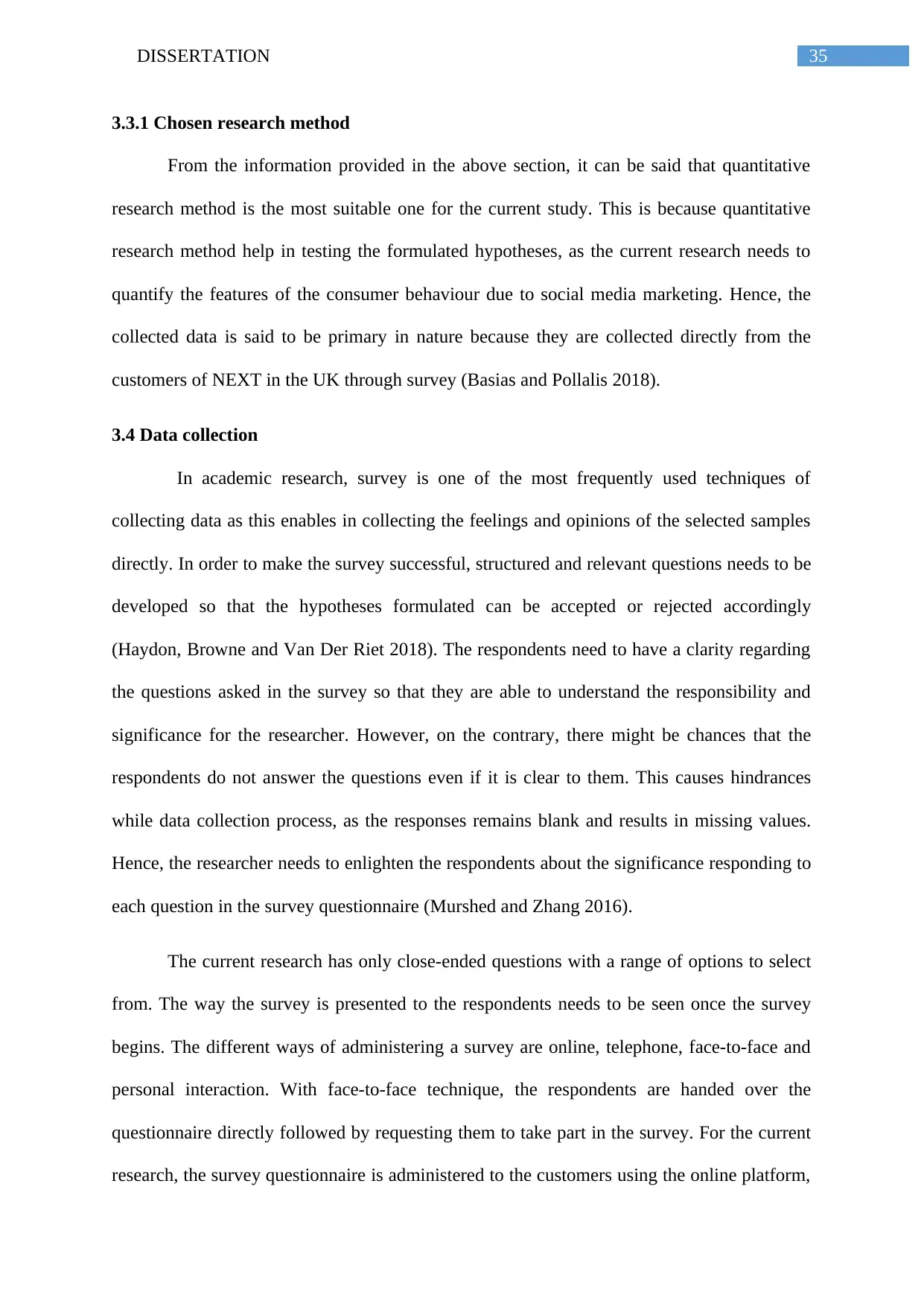
35DISSERTATION
3.3.1 Chosen research method
From the information provided in the above section, it can be said that quantitative
research method is the most suitable one for the current study. This is because quantitative
research method help in testing the formulated hypotheses, as the current research needs to
quantify the features of the consumer behaviour due to social media marketing. Hence, the
collected data is said to be primary in nature because they are collected directly from the
customers of NEXT in the UK through survey (Basias and Pollalis 2018).
3.4 Data collection
In academic research, survey is one of the most frequently used techniques of
collecting data as this enables in collecting the feelings and opinions of the selected samples
directly. In order to make the survey successful, structured and relevant questions needs to be
developed so that the hypotheses formulated can be accepted or rejected accordingly
(Haydon, Browne and Van Der Riet 2018). The respondents need to have a clarity regarding
the questions asked in the survey so that they are able to understand the responsibility and
significance for the researcher. However, on the contrary, there might be chances that the
respondents do not answer the questions even if it is clear to them. This causes hindrances
while data collection process, as the responses remains blank and results in missing values.
Hence, the researcher needs to enlighten the respondents about the significance responding to
each question in the survey questionnaire (Murshed and Zhang 2016).
The current research has only close-ended questions with a range of options to select
from. The way the survey is presented to the respondents needs to be seen once the survey
begins. The different ways of administering a survey are online, telephone, face-to-face and
personal interaction. With face-to-face technique, the respondents are handed over the
questionnaire directly followed by requesting them to take part in the survey. For the current
research, the survey questionnaire is administered to the customers using the online platform,
3.3.1 Chosen research method
From the information provided in the above section, it can be said that quantitative
research method is the most suitable one for the current study. This is because quantitative
research method help in testing the formulated hypotheses, as the current research needs to
quantify the features of the consumer behaviour due to social media marketing. Hence, the
collected data is said to be primary in nature because they are collected directly from the
customers of NEXT in the UK through survey (Basias and Pollalis 2018).
3.4 Data collection
In academic research, survey is one of the most frequently used techniques of
collecting data as this enables in collecting the feelings and opinions of the selected samples
directly. In order to make the survey successful, structured and relevant questions needs to be
developed so that the hypotheses formulated can be accepted or rejected accordingly
(Haydon, Browne and Van Der Riet 2018). The respondents need to have a clarity regarding
the questions asked in the survey so that they are able to understand the responsibility and
significance for the researcher. However, on the contrary, there might be chances that the
respondents do not answer the questions even if it is clear to them. This causes hindrances
while data collection process, as the responses remains blank and results in missing values.
Hence, the researcher needs to enlighten the respondents about the significance responding to
each question in the survey questionnaire (Murshed and Zhang 2016).
The current research has only close-ended questions with a range of options to select
from. The way the survey is presented to the respondents needs to be seen once the survey
begins. The different ways of administering a survey are online, telephone, face-to-face and
personal interaction. With face-to-face technique, the respondents are handed over the
questionnaire directly followed by requesting them to take part in the survey. For the current
research, the survey questionnaire is administered to the customers using the online platform,
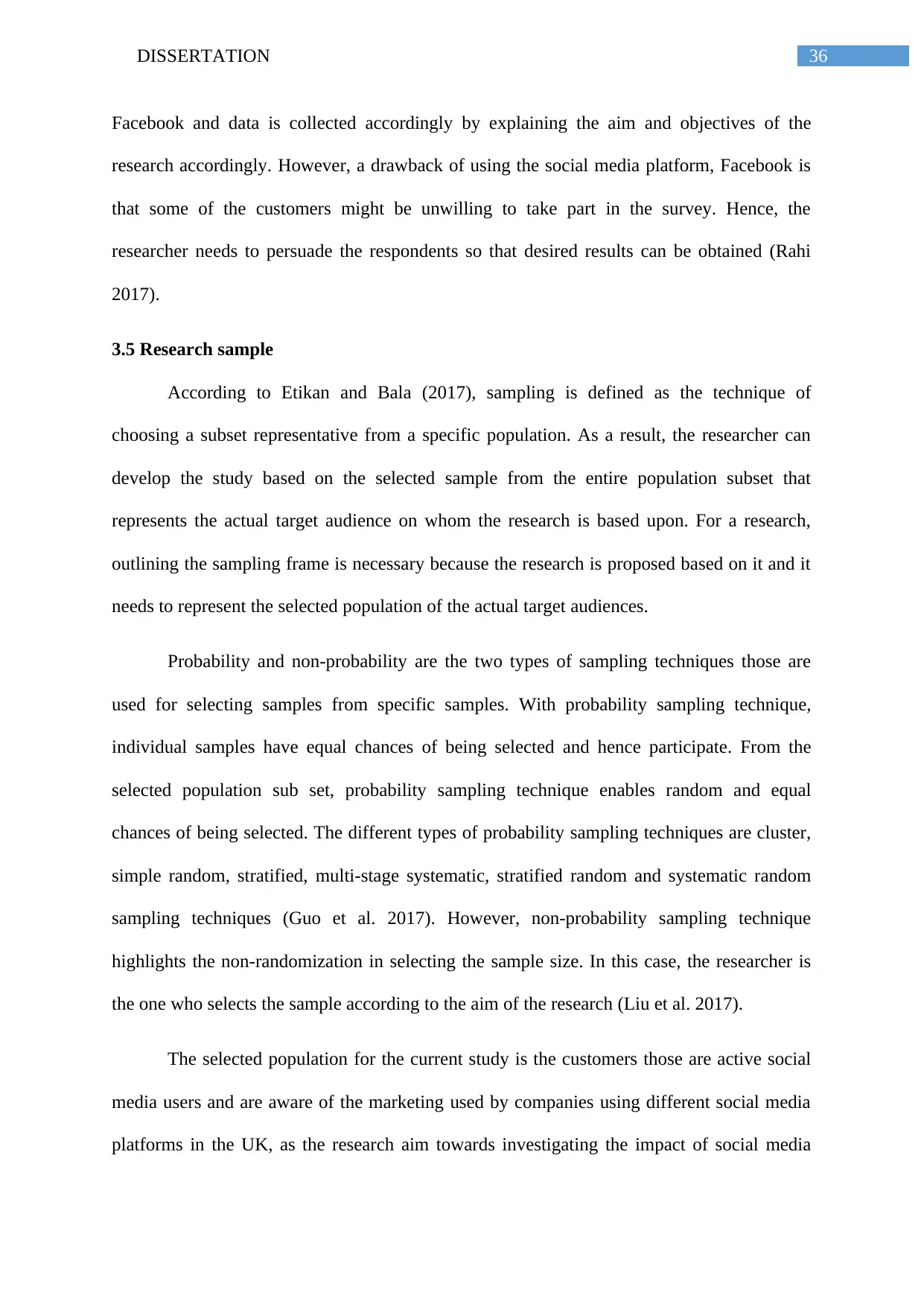
36DISSERTATION
Facebook and data is collected accordingly by explaining the aim and objectives of the
research accordingly. However, a drawback of using the social media platform, Facebook is
that some of the customers might be unwilling to take part in the survey. Hence, the
researcher needs to persuade the respondents so that desired results can be obtained (Rahi
2017).
3.5 Research sample
According to Etikan and Bala (2017), sampling is defined as the technique of
choosing a subset representative from a specific population. As a result, the researcher can
develop the study based on the selected sample from the entire population subset that
represents the actual target audience on whom the research is based upon. For a research,
outlining the sampling frame is necessary because the research is proposed based on it and it
needs to represent the selected population of the actual target audiences.
Probability and non-probability are the two types of sampling techniques those are
used for selecting samples from specific samples. With probability sampling technique,
individual samples have equal chances of being selected and hence participate. From the
selected population sub set, probability sampling technique enables random and equal
chances of being selected. The different types of probability sampling techniques are cluster,
simple random, stratified, multi-stage systematic, stratified random and systematic random
sampling techniques (Guo et al. 2017). However, non-probability sampling technique
highlights the non-randomization in selecting the sample size. In this case, the researcher is
the one who selects the sample according to the aim of the research (Liu et al. 2017).
The selected population for the current study is the customers those are active social
media users and are aware of the marketing used by companies using different social media
platforms in the UK, as the research aim towards investigating the impact of social media
Facebook and data is collected accordingly by explaining the aim and objectives of the
research accordingly. However, a drawback of using the social media platform, Facebook is
that some of the customers might be unwilling to take part in the survey. Hence, the
researcher needs to persuade the respondents so that desired results can be obtained (Rahi
2017).
3.5 Research sample
According to Etikan and Bala (2017), sampling is defined as the technique of
choosing a subset representative from a specific population. As a result, the researcher can
develop the study based on the selected sample from the entire population subset that
represents the actual target audience on whom the research is based upon. For a research,
outlining the sampling frame is necessary because the research is proposed based on it and it
needs to represent the selected population of the actual target audiences.
Probability and non-probability are the two types of sampling techniques those are
used for selecting samples from specific samples. With probability sampling technique,
individual samples have equal chances of being selected and hence participate. From the
selected population sub set, probability sampling technique enables random and equal
chances of being selected. The different types of probability sampling techniques are cluster,
simple random, stratified, multi-stage systematic, stratified random and systematic random
sampling techniques (Guo et al. 2017). However, non-probability sampling technique
highlights the non-randomization in selecting the sample size. In this case, the researcher is
the one who selects the sample according to the aim of the research (Liu et al. 2017).
The selected population for the current study is the customers those are active social
media users and are aware of the marketing used by companies using different social media
platforms in the UK, as the research aim towards investigating the impact of social media
Paraphrase This Document
Need a fresh take? Get an instant paraphrase of this document with our AI Paraphraser
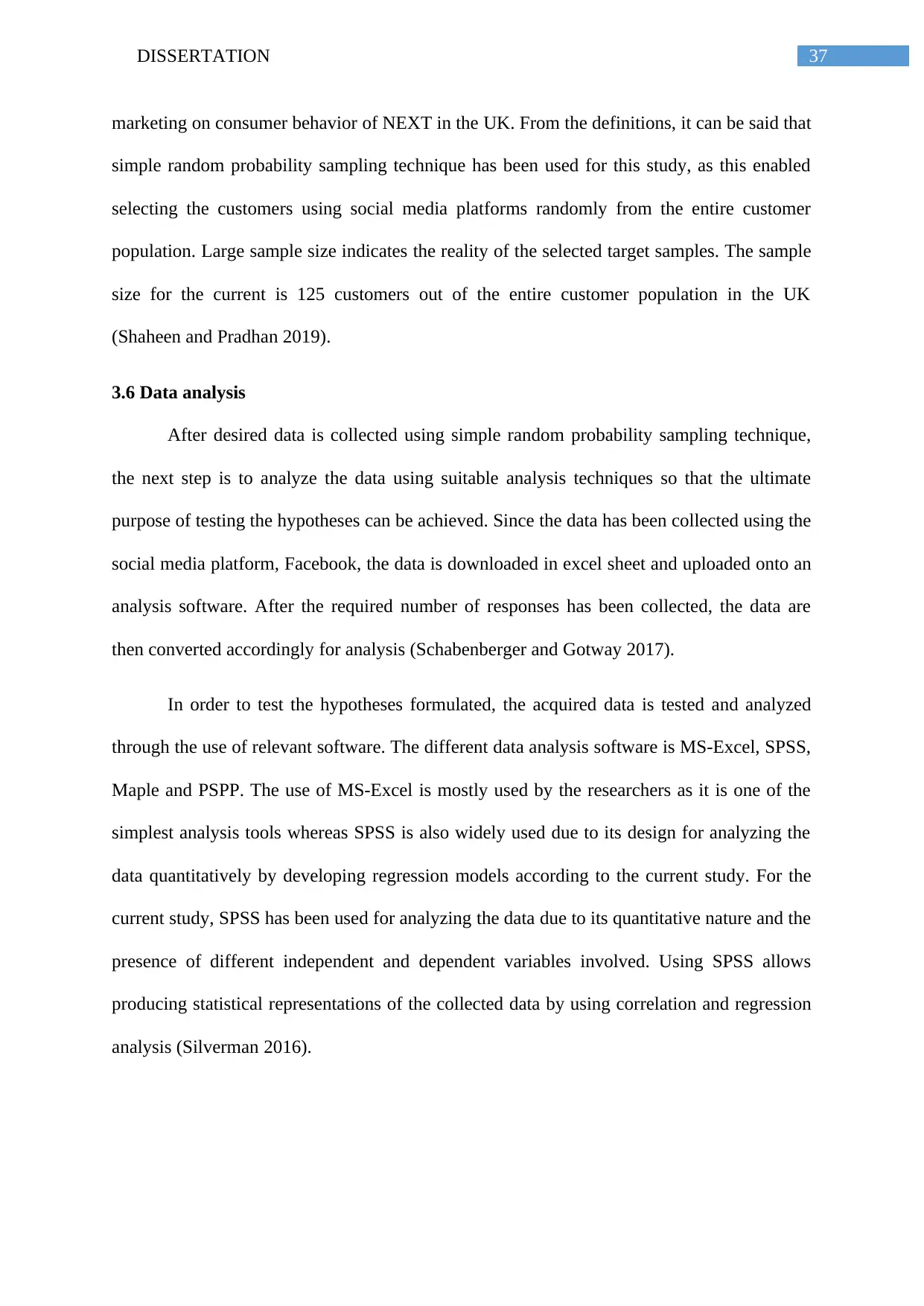
37DISSERTATION
marketing on consumer behavior of NEXT in the UK. From the definitions, it can be said that
simple random probability sampling technique has been used for this study, as this enabled
selecting the customers using social media platforms randomly from the entire customer
population. Large sample size indicates the reality of the selected target samples. The sample
size for the current is 125 customers out of the entire customer population in the UK
(Shaheen and Pradhan 2019).
3.6 Data analysis
After desired data is collected using simple random probability sampling technique,
the next step is to analyze the data using suitable analysis techniques so that the ultimate
purpose of testing the hypotheses can be achieved. Since the data has been collected using the
social media platform, Facebook, the data is downloaded in excel sheet and uploaded onto an
analysis software. After the required number of responses has been collected, the data are
then converted accordingly for analysis (Schabenberger and Gotway 2017).
In order to test the hypotheses formulated, the acquired data is tested and analyzed
through the use of relevant software. The different data analysis software is MS-Excel, SPSS,
Maple and PSPP. The use of MS-Excel is mostly used by the researchers as it is one of the
simplest analysis tools whereas SPSS is also widely used due to its design for analyzing the
data quantitatively by developing regression models according to the current study. For the
current study, SPSS has been used for analyzing the data due to its quantitative nature and the
presence of different independent and dependent variables involved. Using SPSS allows
producing statistical representations of the collected data by using correlation and regression
analysis (Silverman 2016).
marketing on consumer behavior of NEXT in the UK. From the definitions, it can be said that
simple random probability sampling technique has been used for this study, as this enabled
selecting the customers using social media platforms randomly from the entire customer
population. Large sample size indicates the reality of the selected target samples. The sample
size for the current is 125 customers out of the entire customer population in the UK
(Shaheen and Pradhan 2019).
3.6 Data analysis
After desired data is collected using simple random probability sampling technique,
the next step is to analyze the data using suitable analysis techniques so that the ultimate
purpose of testing the hypotheses can be achieved. Since the data has been collected using the
social media platform, Facebook, the data is downloaded in excel sheet and uploaded onto an
analysis software. After the required number of responses has been collected, the data are
then converted accordingly for analysis (Schabenberger and Gotway 2017).
In order to test the hypotheses formulated, the acquired data is tested and analyzed
through the use of relevant software. The different data analysis software is MS-Excel, SPSS,
Maple and PSPP. The use of MS-Excel is mostly used by the researchers as it is one of the
simplest analysis tools whereas SPSS is also widely used due to its design for analyzing the
data quantitatively by developing regression models according to the current study. For the
current study, SPSS has been used for analyzing the data due to its quantitative nature and the
presence of different independent and dependent variables involved. Using SPSS allows
producing statistical representations of the collected data by using correlation and regression
analysis (Silverman 2016).
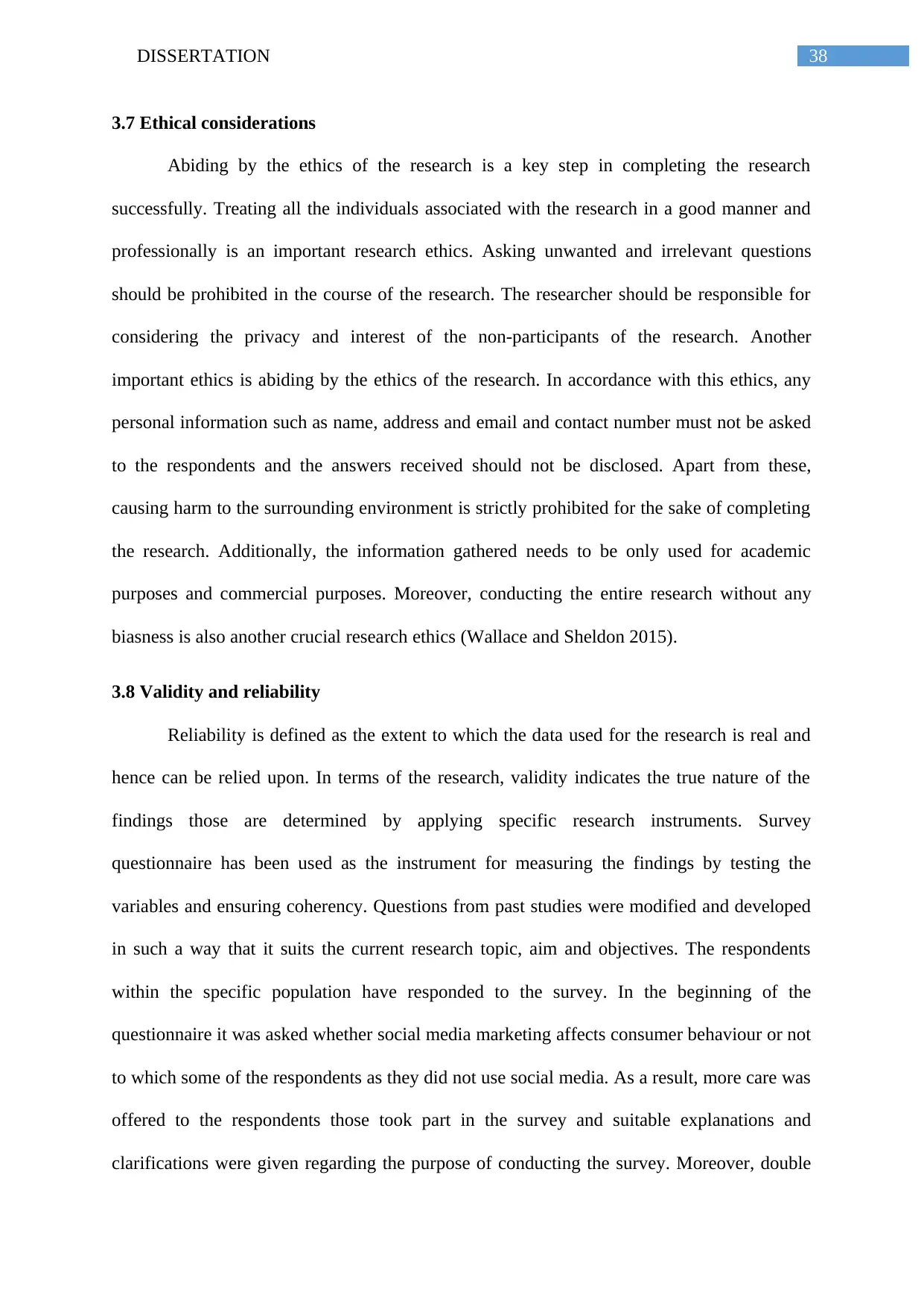
38DISSERTATION
3.7 Ethical considerations
Abiding by the ethics of the research is a key step in completing the research
successfully. Treating all the individuals associated with the research in a good manner and
professionally is an important research ethics. Asking unwanted and irrelevant questions
should be prohibited in the course of the research. The researcher should be responsible for
considering the privacy and interest of the non-participants of the research. Another
important ethics is abiding by the ethics of the research. In accordance with this ethics, any
personal information such as name, address and email and contact number must not be asked
to the respondents and the answers received should not be disclosed. Apart from these,
causing harm to the surrounding environment is strictly prohibited for the sake of completing
the research. Additionally, the information gathered needs to be only used for academic
purposes and commercial purposes. Moreover, conducting the entire research without any
biasness is also another crucial research ethics (Wallace and Sheldon 2015).
3.8 Validity and reliability
Reliability is defined as the extent to which the data used for the research is real and
hence can be relied upon. In terms of the research, validity indicates the true nature of the
findings those are determined by applying specific research instruments. Survey
questionnaire has been used as the instrument for measuring the findings by testing the
variables and ensuring coherency. Questions from past studies were modified and developed
in such a way that it suits the current research topic, aim and objectives. The respondents
within the specific population have responded to the survey. In the beginning of the
questionnaire it was asked whether social media marketing affects consumer behaviour or not
to which some of the respondents as they did not use social media. As a result, more care was
offered to the respondents those took part in the survey and suitable explanations and
clarifications were given regarding the purpose of conducting the survey. Moreover, double
3.7 Ethical considerations
Abiding by the ethics of the research is a key step in completing the research
successfully. Treating all the individuals associated with the research in a good manner and
professionally is an important research ethics. Asking unwanted and irrelevant questions
should be prohibited in the course of the research. The researcher should be responsible for
considering the privacy and interest of the non-participants of the research. Another
important ethics is abiding by the ethics of the research. In accordance with this ethics, any
personal information such as name, address and email and contact number must not be asked
to the respondents and the answers received should not be disclosed. Apart from these,
causing harm to the surrounding environment is strictly prohibited for the sake of completing
the research. Additionally, the information gathered needs to be only used for academic
purposes and commercial purposes. Moreover, conducting the entire research without any
biasness is also another crucial research ethics (Wallace and Sheldon 2015).
3.8 Validity and reliability
Reliability is defined as the extent to which the data used for the research is real and
hence can be relied upon. In terms of the research, validity indicates the true nature of the
findings those are determined by applying specific research instruments. Survey
questionnaire has been used as the instrument for measuring the findings by testing the
variables and ensuring coherency. Questions from past studies were modified and developed
in such a way that it suits the current research topic, aim and objectives. The respondents
within the specific population have responded to the survey. In the beginning of the
questionnaire it was asked whether social media marketing affects consumer behaviour or not
to which some of the respondents as they did not use social media. As a result, more care was
offered to the respondents those took part in the survey and suitable explanations and
clarifications were given regarding the purpose of conducting the survey. Moreover, double
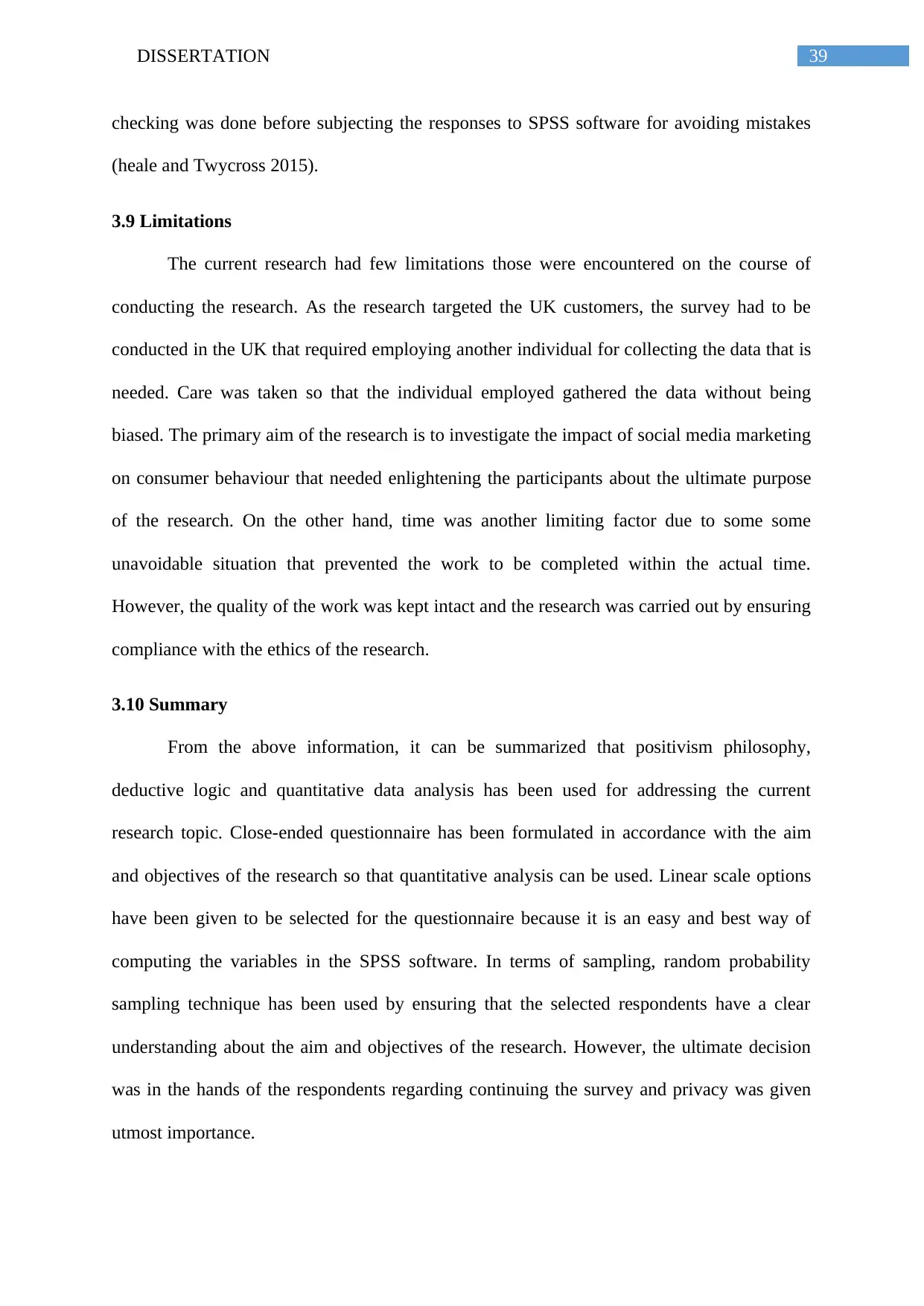
39DISSERTATION
checking was done before subjecting the responses to SPSS software for avoiding mistakes
(heale and Twycross 2015).
3.9 Limitations
The current research had few limitations those were encountered on the course of
conducting the research. As the research targeted the UK customers, the survey had to be
conducted in the UK that required employing another individual for collecting the data that is
needed. Care was taken so that the individual employed gathered the data without being
biased. The primary aim of the research is to investigate the impact of social media marketing
on consumer behaviour that needed enlightening the participants about the ultimate purpose
of the research. On the other hand, time was another limiting factor due to some some
unavoidable situation that prevented the work to be completed within the actual time.
However, the quality of the work was kept intact and the research was carried out by ensuring
compliance with the ethics of the research.
3.10 Summary
From the above information, it can be summarized that positivism philosophy,
deductive logic and quantitative data analysis has been used for addressing the current
research topic. Close-ended questionnaire has been formulated in accordance with the aim
and objectives of the research so that quantitative analysis can be used. Linear scale options
have been given to be selected for the questionnaire because it is an easy and best way of
computing the variables in the SPSS software. In terms of sampling, random probability
sampling technique has been used by ensuring that the selected respondents have a clear
understanding about the aim and objectives of the research. However, the ultimate decision
was in the hands of the respondents regarding continuing the survey and privacy was given
utmost importance.
checking was done before subjecting the responses to SPSS software for avoiding mistakes
(heale and Twycross 2015).
3.9 Limitations
The current research had few limitations those were encountered on the course of
conducting the research. As the research targeted the UK customers, the survey had to be
conducted in the UK that required employing another individual for collecting the data that is
needed. Care was taken so that the individual employed gathered the data without being
biased. The primary aim of the research is to investigate the impact of social media marketing
on consumer behaviour that needed enlightening the participants about the ultimate purpose
of the research. On the other hand, time was another limiting factor due to some some
unavoidable situation that prevented the work to be completed within the actual time.
However, the quality of the work was kept intact and the research was carried out by ensuring
compliance with the ethics of the research.
3.10 Summary
From the above information, it can be summarized that positivism philosophy,
deductive logic and quantitative data analysis has been used for addressing the current
research topic. Close-ended questionnaire has been formulated in accordance with the aim
and objectives of the research so that quantitative analysis can be used. Linear scale options
have been given to be selected for the questionnaire because it is an easy and best way of
computing the variables in the SPSS software. In terms of sampling, random probability
sampling technique has been used by ensuring that the selected respondents have a clear
understanding about the aim and objectives of the research. However, the ultimate decision
was in the hands of the respondents regarding continuing the survey and privacy was given
utmost importance.
Secure Best Marks with AI Grader
Need help grading? Try our AI Grader for instant feedback on your assignments.
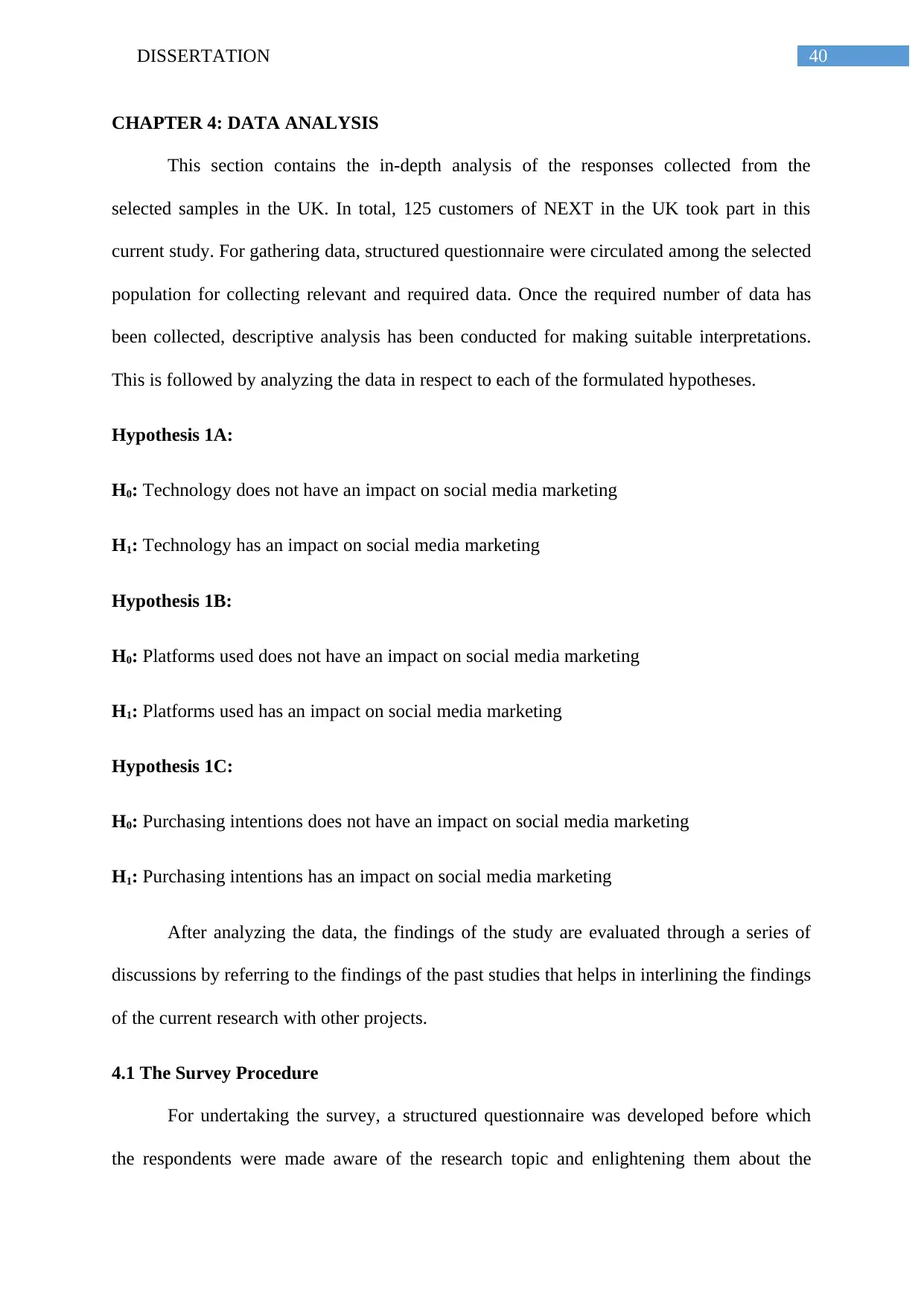
40DISSERTATION
CHAPTER 4: DATA ANALYSIS
This section contains the in-depth analysis of the responses collected from the
selected samples in the UK. In total, 125 customers of NEXT in the UK took part in this
current study. For gathering data, structured questionnaire were circulated among the selected
population for collecting relevant and required data. Once the required number of data has
been collected, descriptive analysis has been conducted for making suitable interpretations.
This is followed by analyzing the data in respect to each of the formulated hypotheses.
Hypothesis 1A:
H0: Technology does not have an impact on social media marketing
H1: Technology has an impact on social media marketing
Hypothesis 1B:
H0: Platforms used does not have an impact on social media marketing
H1: Platforms used has an impact on social media marketing
Hypothesis 1C:
H0: Purchasing intentions does not have an impact on social media marketing
H1: Purchasing intentions has an impact on social media marketing
After analyzing the data, the findings of the study are evaluated through a series of
discussions by referring to the findings of the past studies that helps in interlining the findings
of the current research with other projects.
4.1 The Survey Procedure
For undertaking the survey, a structured questionnaire was developed before which
the respondents were made aware of the research topic and enlightening them about the
CHAPTER 4: DATA ANALYSIS
This section contains the in-depth analysis of the responses collected from the
selected samples in the UK. In total, 125 customers of NEXT in the UK took part in this
current study. For gathering data, structured questionnaire were circulated among the selected
population for collecting relevant and required data. Once the required number of data has
been collected, descriptive analysis has been conducted for making suitable interpretations.
This is followed by analyzing the data in respect to each of the formulated hypotheses.
Hypothesis 1A:
H0: Technology does not have an impact on social media marketing
H1: Technology has an impact on social media marketing
Hypothesis 1B:
H0: Platforms used does not have an impact on social media marketing
H1: Platforms used has an impact on social media marketing
Hypothesis 1C:
H0: Purchasing intentions does not have an impact on social media marketing
H1: Purchasing intentions has an impact on social media marketing
After analyzing the data, the findings of the study are evaluated through a series of
discussions by referring to the findings of the past studies that helps in interlining the findings
of the current research with other projects.
4.1 The Survey Procedure
For undertaking the survey, a structured questionnaire was developed before which
the respondents were made aware of the research topic and enlightening them about the
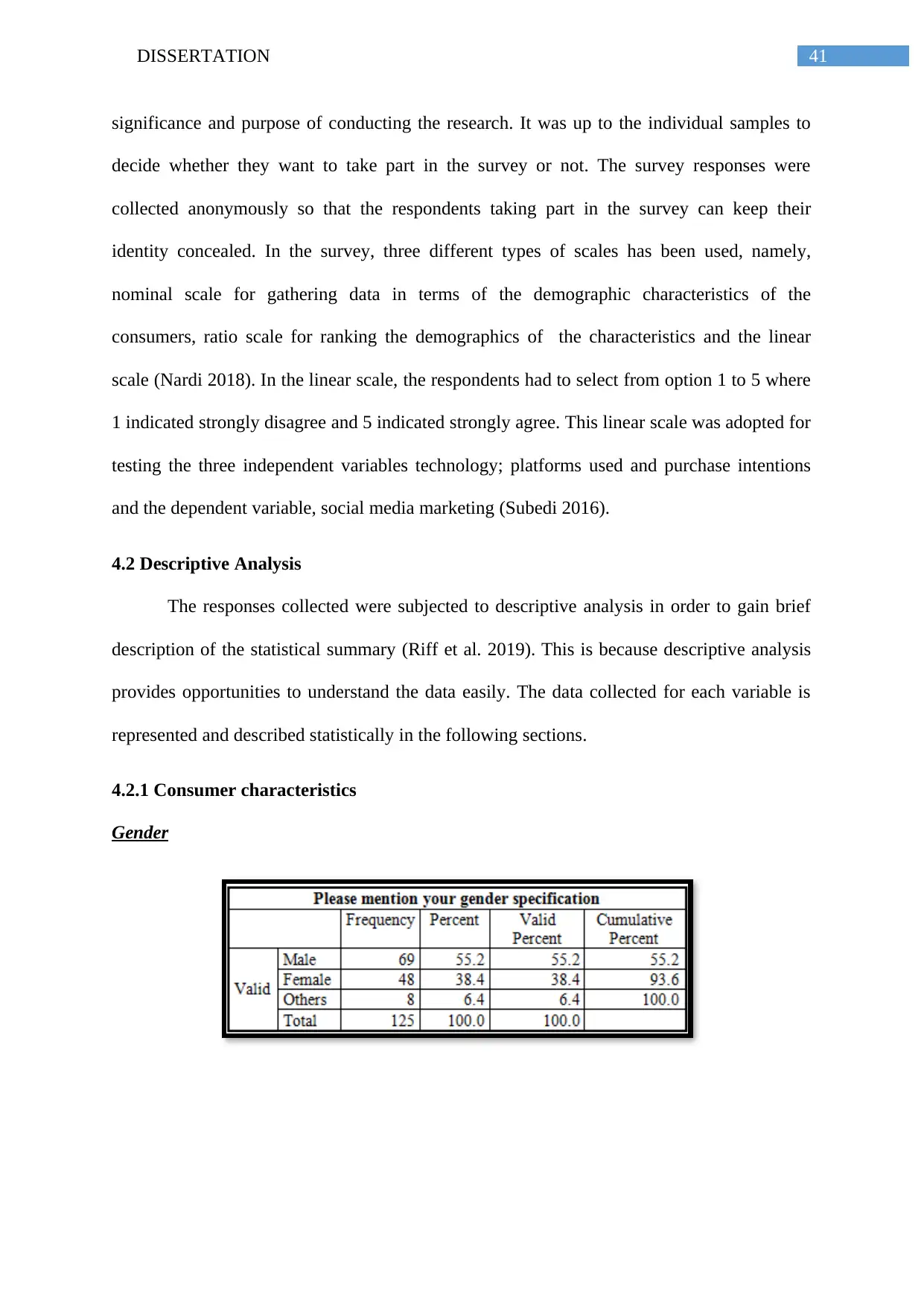
41DISSERTATION
significance and purpose of conducting the research. It was up to the individual samples to
decide whether they want to take part in the survey or not. The survey responses were
collected anonymously so that the respondents taking part in the survey can keep their
identity concealed. In the survey, three different types of scales has been used, namely,
nominal scale for gathering data in terms of the demographic characteristics of the
consumers, ratio scale for ranking the demographics of the characteristics and the linear
scale (Nardi 2018). In the linear scale, the respondents had to select from option 1 to 5 where
1 indicated strongly disagree and 5 indicated strongly agree. This linear scale was adopted for
testing the three independent variables technology; platforms used and purchase intentions
and the dependent variable, social media marketing (Subedi 2016).
4.2 Descriptive Analysis
The responses collected were subjected to descriptive analysis in order to gain brief
description of the statistical summary (Riff et al. 2019). This is because descriptive analysis
provides opportunities to understand the data easily. The data collected for each variable is
represented and described statistically in the following sections.
4.2.1 Consumer characteristics
Gender
significance and purpose of conducting the research. It was up to the individual samples to
decide whether they want to take part in the survey or not. The survey responses were
collected anonymously so that the respondents taking part in the survey can keep their
identity concealed. In the survey, three different types of scales has been used, namely,
nominal scale for gathering data in terms of the demographic characteristics of the
consumers, ratio scale for ranking the demographics of the characteristics and the linear
scale (Nardi 2018). In the linear scale, the respondents had to select from option 1 to 5 where
1 indicated strongly disagree and 5 indicated strongly agree. This linear scale was adopted for
testing the three independent variables technology; platforms used and purchase intentions
and the dependent variable, social media marketing (Subedi 2016).
4.2 Descriptive Analysis
The responses collected were subjected to descriptive analysis in order to gain brief
description of the statistical summary (Riff et al. 2019). This is because descriptive analysis
provides opportunities to understand the data easily. The data collected for each variable is
represented and described statistically in the following sections.
4.2.1 Consumer characteristics
Gender
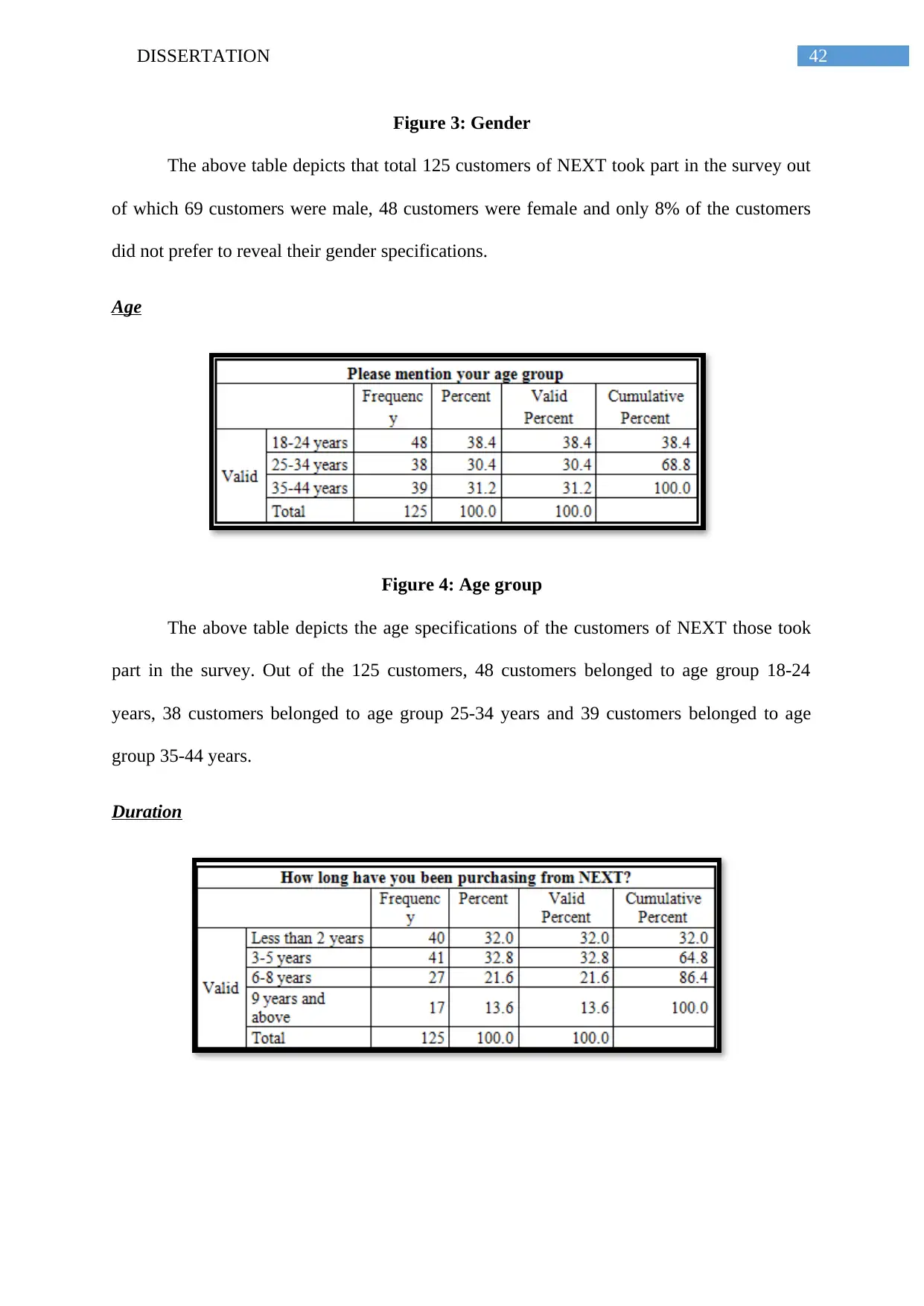
42DISSERTATION
Figure 3: Gender
The above table depicts that total 125 customers of NEXT took part in the survey out
of which 69 customers were male, 48 customers were female and only 8% of the customers
did not prefer to reveal their gender specifications.
Age
Figure 4: Age group
The above table depicts the age specifications of the customers of NEXT those took
part in the survey. Out of the 125 customers, 48 customers belonged to age group 18-24
years, 38 customers belonged to age group 25-34 years and 39 customers belonged to age
group 35-44 years.
Duration
Figure 3: Gender
The above table depicts that total 125 customers of NEXT took part in the survey out
of which 69 customers were male, 48 customers were female and only 8% of the customers
did not prefer to reveal their gender specifications.
Age
Figure 4: Age group
The above table depicts the age specifications of the customers of NEXT those took
part in the survey. Out of the 125 customers, 48 customers belonged to age group 18-24
years, 38 customers belonged to age group 25-34 years and 39 customers belonged to age
group 35-44 years.
Duration
Paraphrase This Document
Need a fresh take? Get an instant paraphrase of this document with our AI Paraphraser
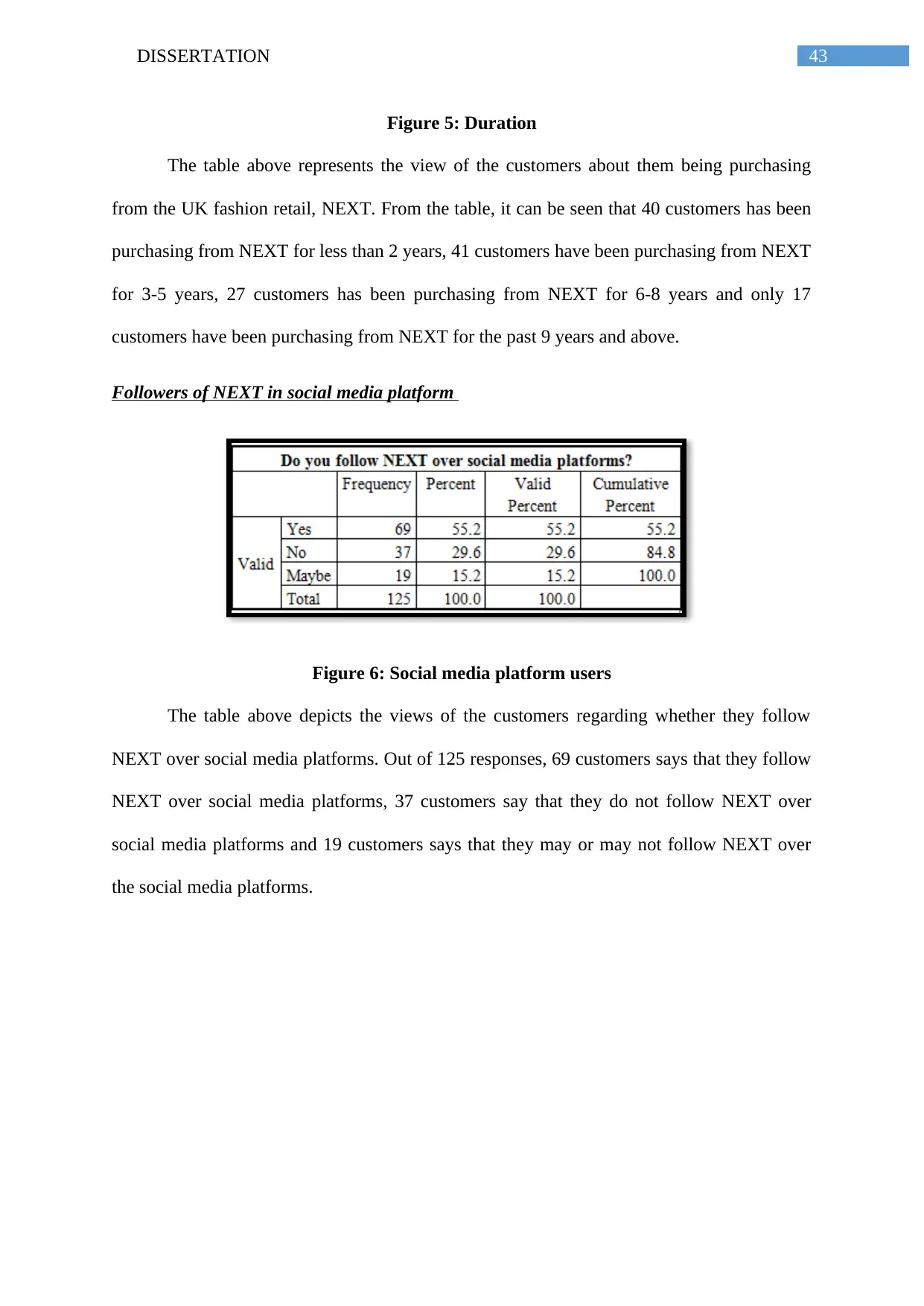
43DISSERTATION
Figure 5: Duration
The table above represents the view of the customers about them being purchasing
from the UK fashion retail, NEXT. From the table, it can be seen that 40 customers has been
purchasing from NEXT for less than 2 years, 41 customers have been purchasing from NEXT
for 3-5 years, 27 customers has been purchasing from NEXT for 6-8 years and only 17
customers have been purchasing from NEXT for the past 9 years and above.
Followers of NEXT in social media platform
Figure 6: Social media platform users
The table above depicts the views of the customers regarding whether they follow
NEXT over social media platforms. Out of 125 responses, 69 customers says that they follow
NEXT over social media platforms, 37 customers say that they do not follow NEXT over
social media platforms and 19 customers says that they may or may not follow NEXT over
the social media platforms.
Figure 5: Duration
The table above represents the view of the customers about them being purchasing
from the UK fashion retail, NEXT. From the table, it can be seen that 40 customers has been
purchasing from NEXT for less than 2 years, 41 customers have been purchasing from NEXT
for 3-5 years, 27 customers has been purchasing from NEXT for 6-8 years and only 17
customers have been purchasing from NEXT for the past 9 years and above.
Followers of NEXT in social media platform
Figure 6: Social media platform users
The table above depicts the views of the customers regarding whether they follow
NEXT over social media platforms. Out of 125 responses, 69 customers says that they follow
NEXT over social media platforms, 37 customers say that they do not follow NEXT over
social media platforms and 19 customers says that they may or may not follow NEXT over
the social media platforms.
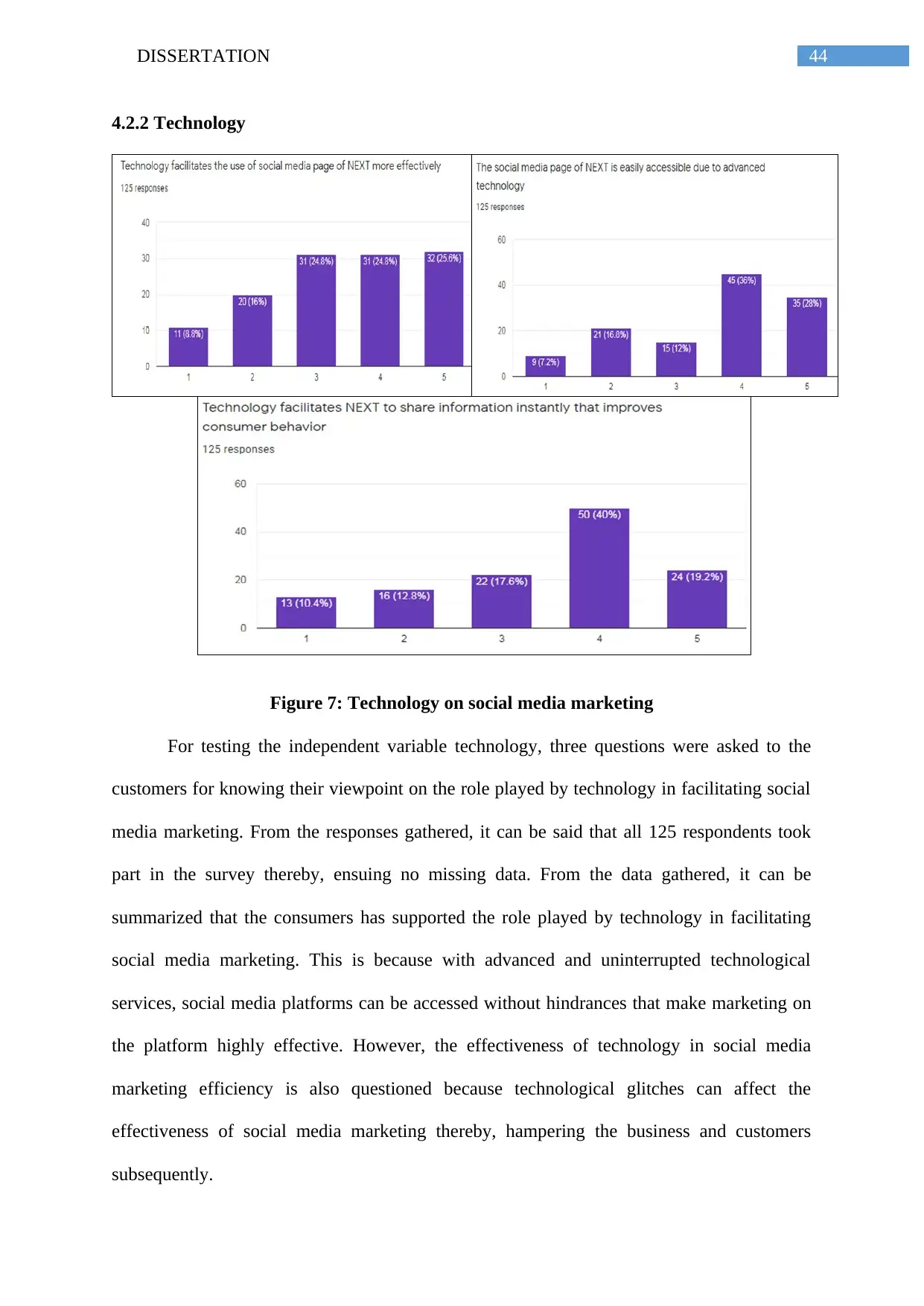
44DISSERTATION
4.2.2 Technology
Figure 7: Technology on social media marketing
For testing the independent variable technology, three questions were asked to the
customers for knowing their viewpoint on the role played by technology in facilitating social
media marketing. From the responses gathered, it can be said that all 125 respondents took
part in the survey thereby, ensuing no missing data. From the data gathered, it can be
summarized that the consumers has supported the role played by technology in facilitating
social media marketing. This is because with advanced and uninterrupted technological
services, social media platforms can be accessed without hindrances that make marketing on
the platform highly effective. However, the effectiveness of technology in social media
marketing efficiency is also questioned because technological glitches can affect the
effectiveness of social media marketing thereby, hampering the business and customers
subsequently.
4.2.2 Technology
Figure 7: Technology on social media marketing
For testing the independent variable technology, three questions were asked to the
customers for knowing their viewpoint on the role played by technology in facilitating social
media marketing. From the responses gathered, it can be said that all 125 respondents took
part in the survey thereby, ensuing no missing data. From the data gathered, it can be
summarized that the consumers has supported the role played by technology in facilitating
social media marketing. This is because with advanced and uninterrupted technological
services, social media platforms can be accessed without hindrances that make marketing on
the platform highly effective. However, the effectiveness of technology in social media
marketing efficiency is also questioned because technological glitches can affect the
effectiveness of social media marketing thereby, hampering the business and customers
subsequently.
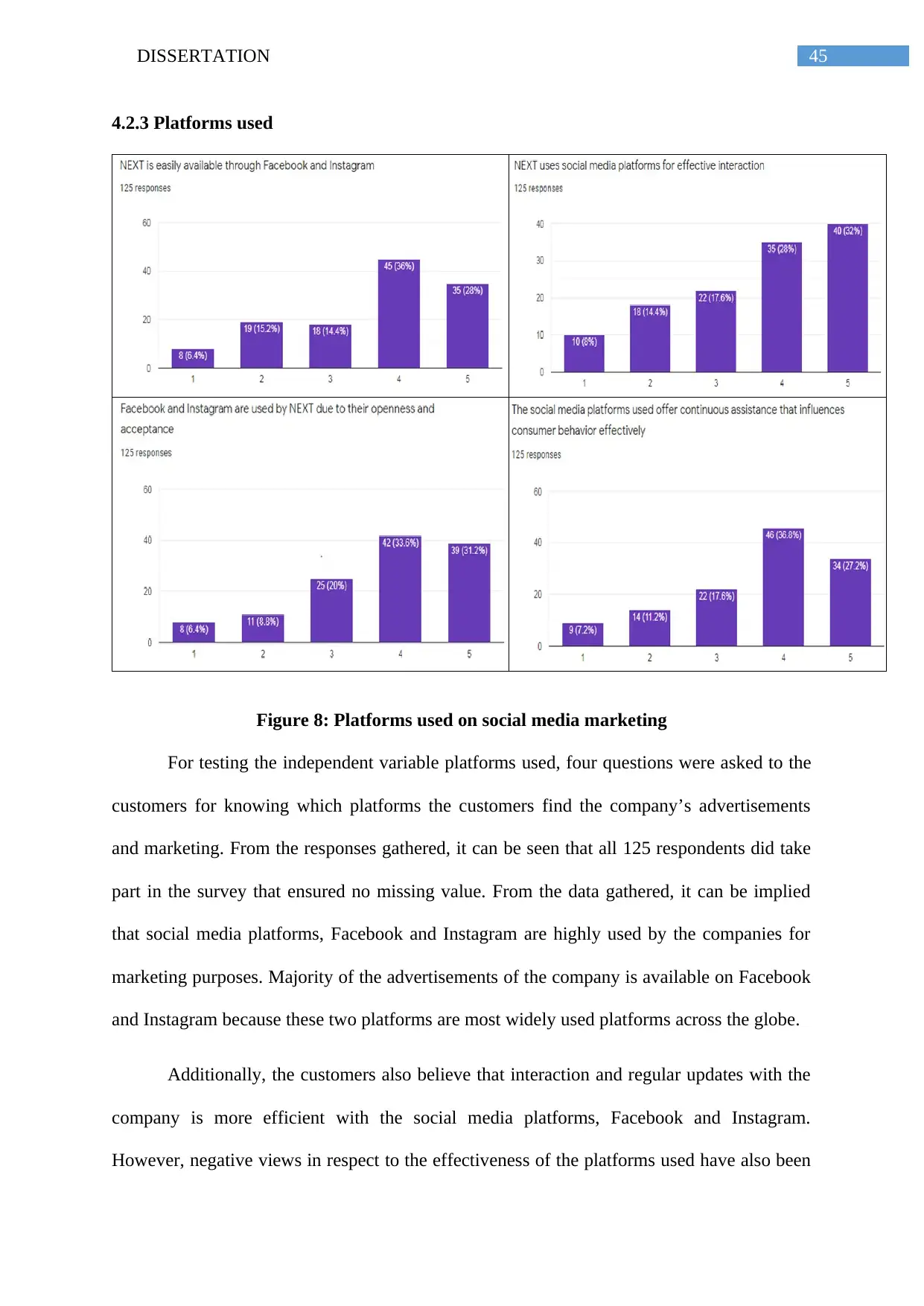
45DISSERTATION
4.2.3 Platforms used
Figure 8: Platforms used on social media marketing
For testing the independent variable platforms used, four questions were asked to the
customers for knowing which platforms the customers find the company’s advertisements
and marketing. From the responses gathered, it can be seen that all 125 respondents did take
part in the survey that ensured no missing value. From the data gathered, it can be implied
that social media platforms, Facebook and Instagram are highly used by the companies for
marketing purposes. Majority of the advertisements of the company is available on Facebook
and Instagram because these two platforms are most widely used platforms across the globe.
Additionally, the customers also believe that interaction and regular updates with the
company is more efficient with the social media platforms, Facebook and Instagram.
However, negative views in respect to the effectiveness of the platforms used have also been
4.2.3 Platforms used
Figure 8: Platforms used on social media marketing
For testing the independent variable platforms used, four questions were asked to the
customers for knowing which platforms the customers find the company’s advertisements
and marketing. From the responses gathered, it can be seen that all 125 respondents did take
part in the survey that ensured no missing value. From the data gathered, it can be implied
that social media platforms, Facebook and Instagram are highly used by the companies for
marketing purposes. Majority of the advertisements of the company is available on Facebook
and Instagram because these two platforms are most widely used platforms across the globe.
Additionally, the customers also believe that interaction and regular updates with the
company is more efficient with the social media platforms, Facebook and Instagram.
However, negative views in respect to the effectiveness of the platforms used have also been
Secure Best Marks with AI Grader
Need help grading? Try our AI Grader for instant feedback on your assignments.
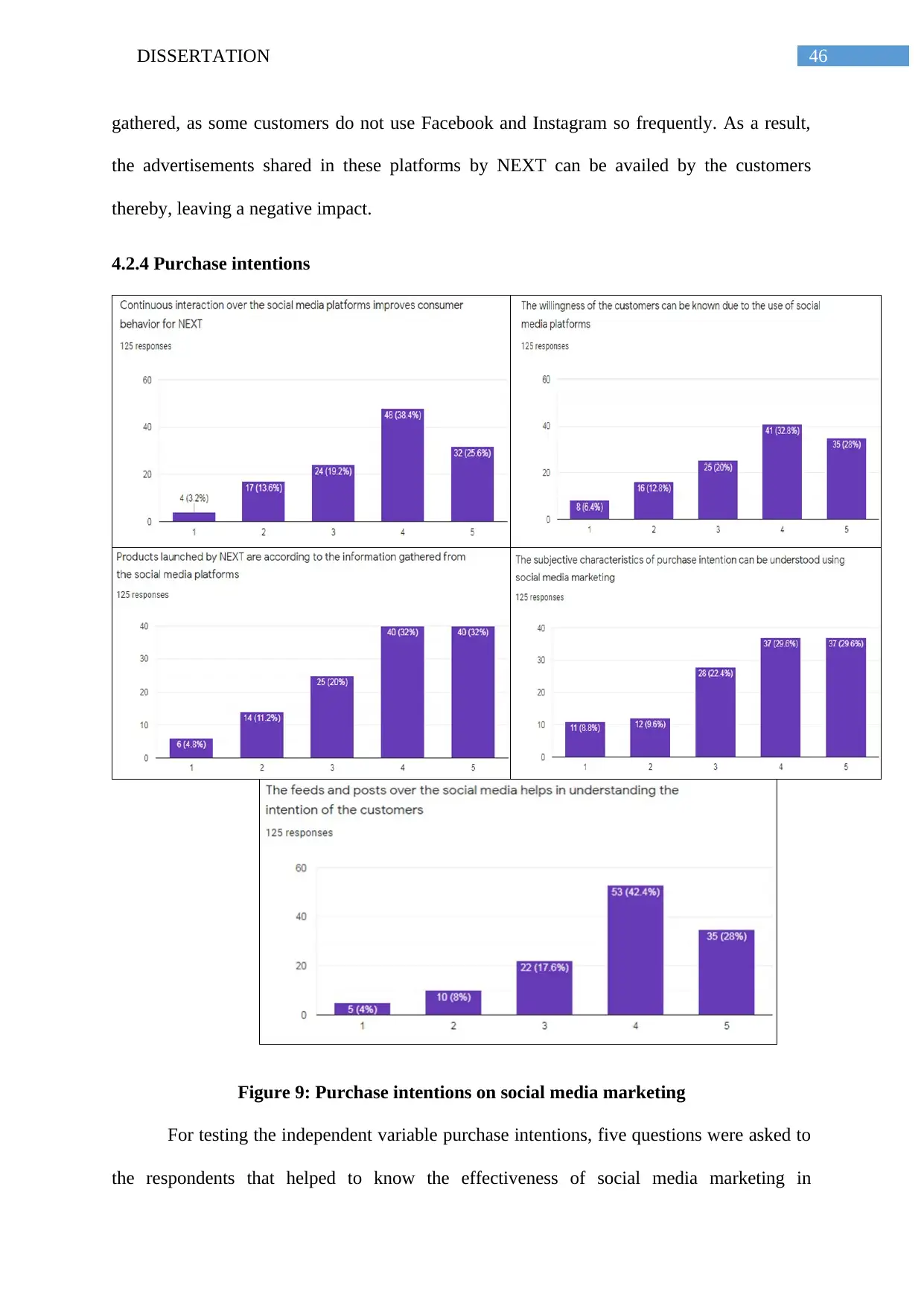
46DISSERTATION
gathered, as some customers do not use Facebook and Instagram so frequently. As a result,
the advertisements shared in these platforms by NEXT can be availed by the customers
thereby, leaving a negative impact.
4.2.4 Purchase intentions
Figure 9: Purchase intentions on social media marketing
For testing the independent variable purchase intentions, five questions were asked to
the respondents that helped to know the effectiveness of social media marketing in
gathered, as some customers do not use Facebook and Instagram so frequently. As a result,
the advertisements shared in these platforms by NEXT can be availed by the customers
thereby, leaving a negative impact.
4.2.4 Purchase intentions
Figure 9: Purchase intentions on social media marketing
For testing the independent variable purchase intentions, five questions were asked to
the respondents that helped to know the effectiveness of social media marketing in
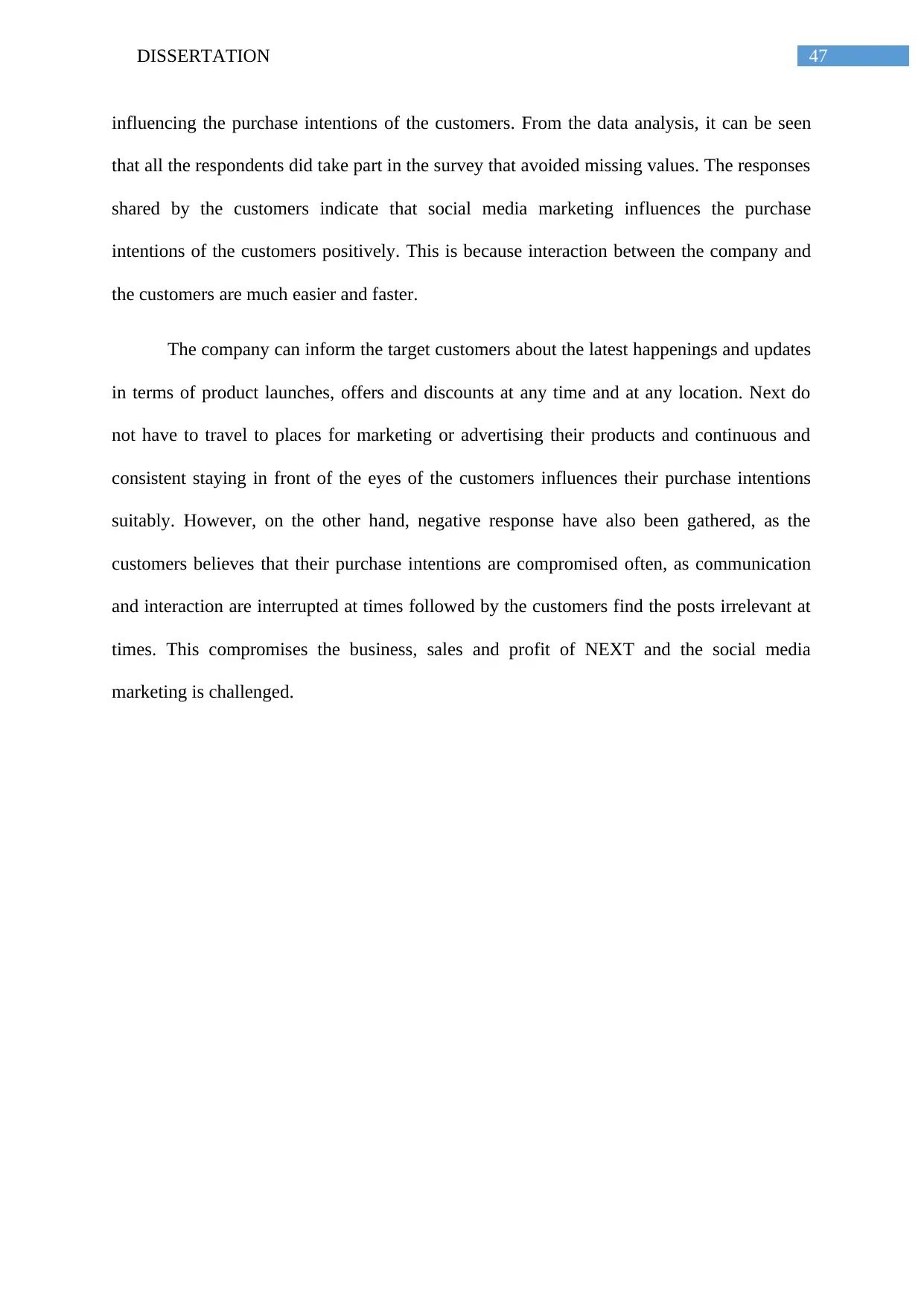
47DISSERTATION
influencing the purchase intentions of the customers. From the data analysis, it can be seen
that all the respondents did take part in the survey that avoided missing values. The responses
shared by the customers indicate that social media marketing influences the purchase
intentions of the customers positively. This is because interaction between the company and
the customers are much easier and faster.
The company can inform the target customers about the latest happenings and updates
in terms of product launches, offers and discounts at any time and at any location. Next do
not have to travel to places for marketing or advertising their products and continuous and
consistent staying in front of the eyes of the customers influences their purchase intentions
suitably. However, on the other hand, negative response have also been gathered, as the
customers believes that their purchase intentions are compromised often, as communication
and interaction are interrupted at times followed by the customers find the posts irrelevant at
times. This compromises the business, sales and profit of NEXT and the social media
marketing is challenged.
influencing the purchase intentions of the customers. From the data analysis, it can be seen
that all the respondents did take part in the survey that avoided missing values. The responses
shared by the customers indicate that social media marketing influences the purchase
intentions of the customers positively. This is because interaction between the company and
the customers are much easier and faster.
The company can inform the target customers about the latest happenings and updates
in terms of product launches, offers and discounts at any time and at any location. Next do
not have to travel to places for marketing or advertising their products and continuous and
consistent staying in front of the eyes of the customers influences their purchase intentions
suitably. However, on the other hand, negative response have also been gathered, as the
customers believes that their purchase intentions are compromised often, as communication
and interaction are interrupted at times followed by the customers find the posts irrelevant at
times. This compromises the business, sales and profit of NEXT and the social media
marketing is challenged.
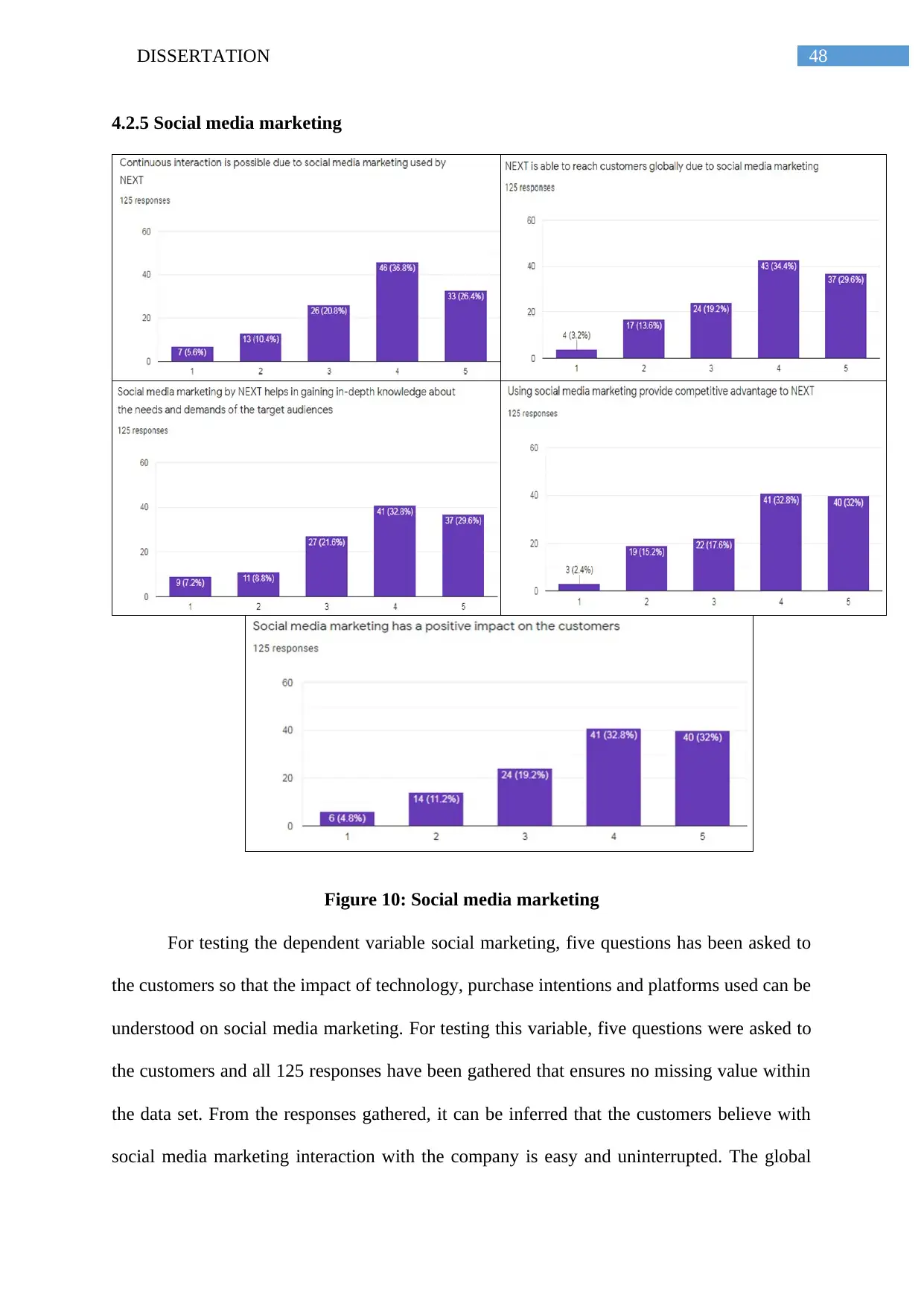
48DISSERTATION
4.2.5 Social media marketing
Figure 10: Social media marketing
For testing the dependent variable social marketing, five questions has been asked to
the customers so that the impact of technology, purchase intentions and platforms used can be
understood on social media marketing. For testing this variable, five questions were asked to
the customers and all 125 responses have been gathered that ensures no missing value within
the data set. From the responses gathered, it can be inferred that the customers believe with
social media marketing interaction with the company is easy and uninterrupted. The global
4.2.5 Social media marketing
Figure 10: Social media marketing
For testing the dependent variable social marketing, five questions has been asked to
the customers so that the impact of technology, purchase intentions and platforms used can be
understood on social media marketing. For testing this variable, five questions were asked to
the customers and all 125 responses have been gathered that ensures no missing value within
the data set. From the responses gathered, it can be inferred that the customers believe with
social media marketing interaction with the company is easy and uninterrupted. The global
Paraphrase This Document
Need a fresh take? Get an instant paraphrase of this document with our AI Paraphraser
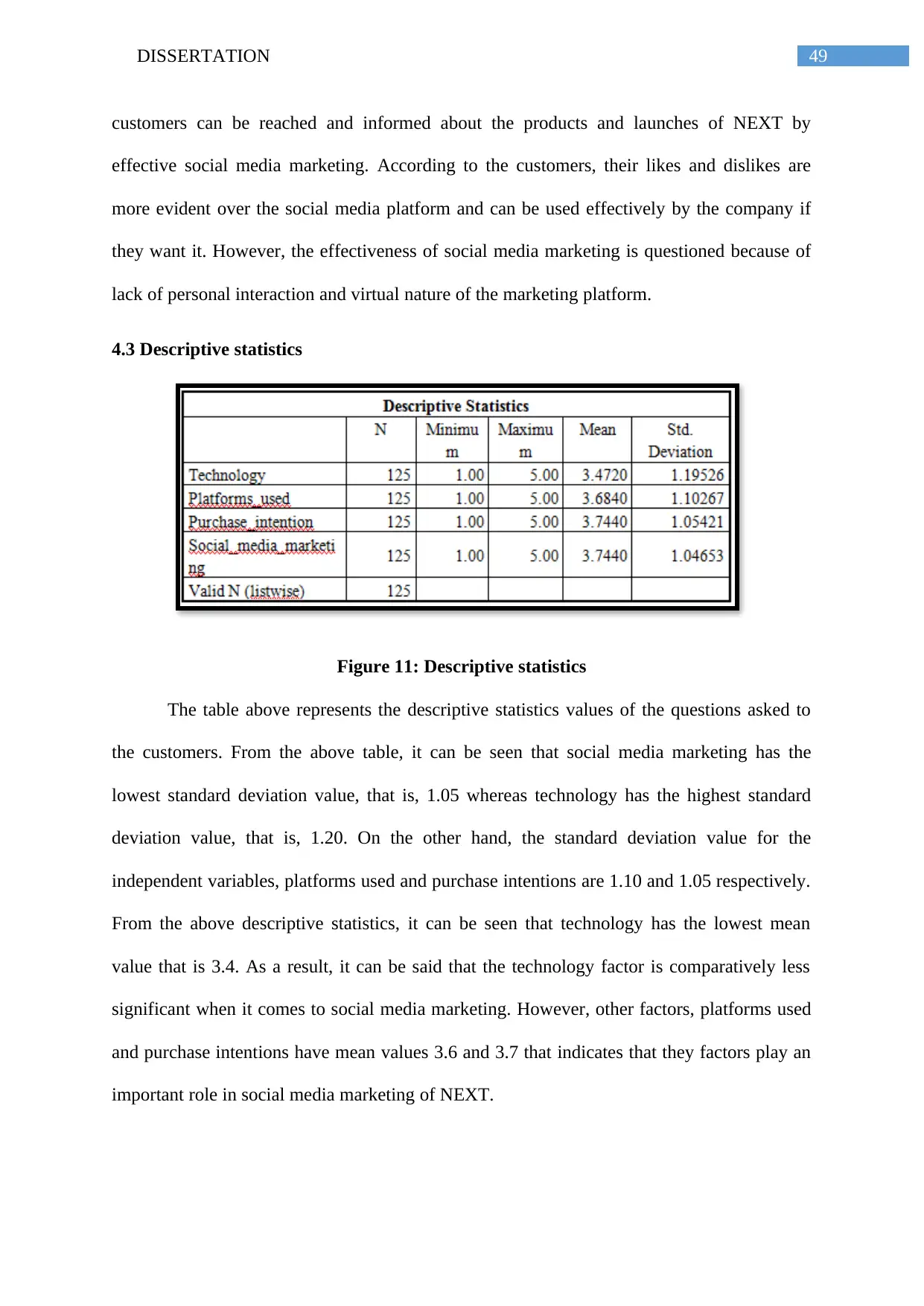
49DISSERTATION
customers can be reached and informed about the products and launches of NEXT by
effective social media marketing. According to the customers, their likes and dislikes are
more evident over the social media platform and can be used effectively by the company if
they want it. However, the effectiveness of social media marketing is questioned because of
lack of personal interaction and virtual nature of the marketing platform.
4.3 Descriptive statistics
Figure 11: Descriptive statistics
The table above represents the descriptive statistics values of the questions asked to
the customers. From the above table, it can be seen that social media marketing has the
lowest standard deviation value, that is, 1.05 whereas technology has the highest standard
deviation value, that is, 1.20. On the other hand, the standard deviation value for the
independent variables, platforms used and purchase intentions are 1.10 and 1.05 respectively.
From the above descriptive statistics, it can be seen that technology has the lowest mean
value that is 3.4. As a result, it can be said that the technology factor is comparatively less
significant when it comes to social media marketing. However, other factors, platforms used
and purchase intentions have mean values 3.6 and 3.7 that indicates that they factors play an
important role in social media marketing of NEXT.
customers can be reached and informed about the products and launches of NEXT by
effective social media marketing. According to the customers, their likes and dislikes are
more evident over the social media platform and can be used effectively by the company if
they want it. However, the effectiveness of social media marketing is questioned because of
lack of personal interaction and virtual nature of the marketing platform.
4.3 Descriptive statistics
Figure 11: Descriptive statistics
The table above represents the descriptive statistics values of the questions asked to
the customers. From the above table, it can be seen that social media marketing has the
lowest standard deviation value, that is, 1.05 whereas technology has the highest standard
deviation value, that is, 1.20. On the other hand, the standard deviation value for the
independent variables, platforms used and purchase intentions are 1.10 and 1.05 respectively.
From the above descriptive statistics, it can be seen that technology has the lowest mean
value that is 3.4. As a result, it can be said that the technology factor is comparatively less
significant when it comes to social media marketing. However, other factors, platforms used
and purchase intentions have mean values 3.6 and 3.7 that indicates that they factors play an
important role in social media marketing of NEXT.
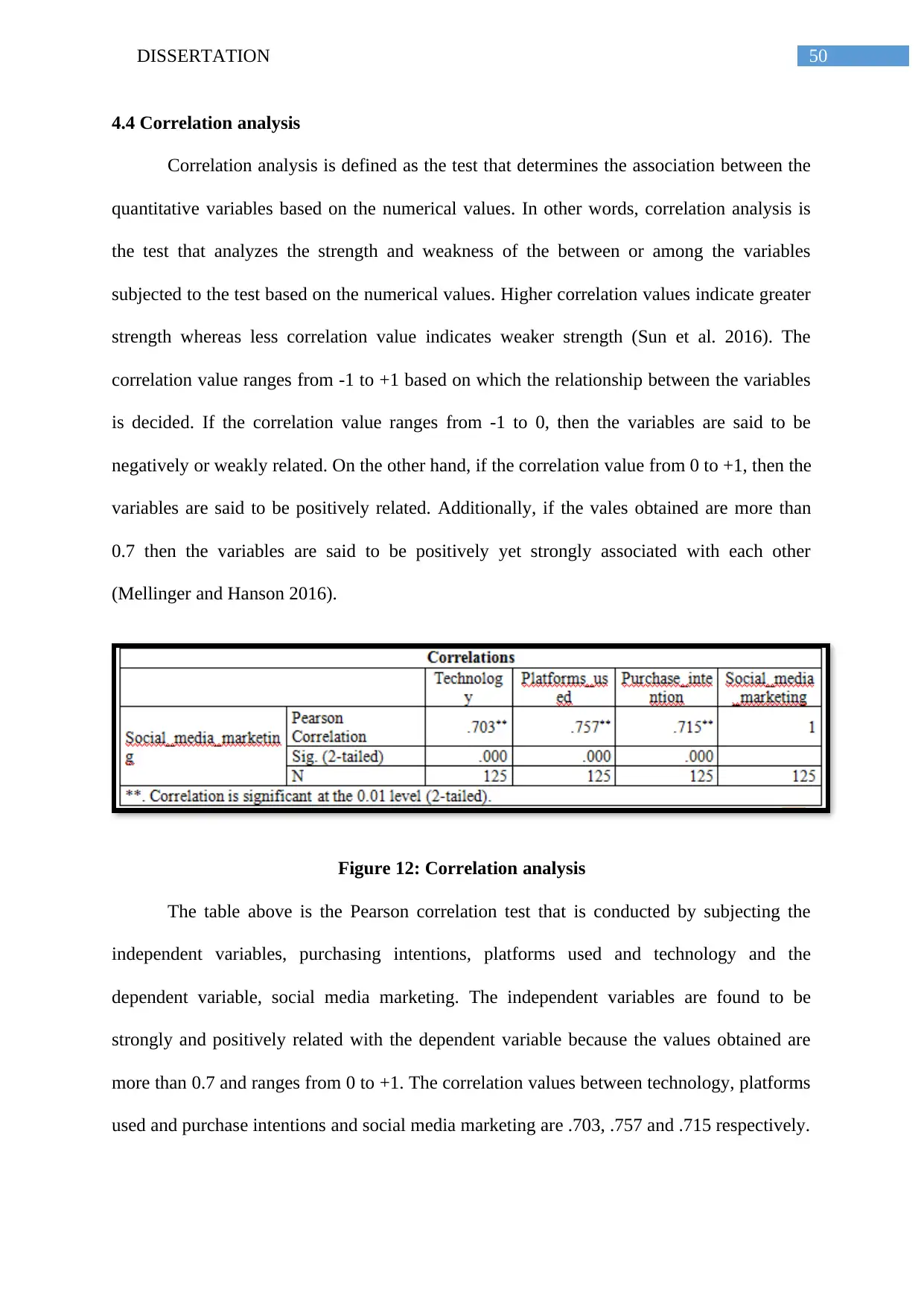
50DISSERTATION
4.4 Correlation analysis
Correlation analysis is defined as the test that determines the association between the
quantitative variables based on the numerical values. In other words, correlation analysis is
the test that analyzes the strength and weakness of the between or among the variables
subjected to the test based on the numerical values. Higher correlation values indicate greater
strength whereas less correlation value indicates weaker strength (Sun et al. 2016). The
correlation value ranges from -1 to +1 based on which the relationship between the variables
is decided. If the correlation value ranges from -1 to 0, then the variables are said to be
negatively or weakly related. On the other hand, if the correlation value from 0 to +1, then the
variables are said to be positively related. Additionally, if the vales obtained are more than
0.7 then the variables are said to be positively yet strongly associated with each other
(Mellinger and Hanson 2016).
Figure 12: Correlation analysis
The table above is the Pearson correlation test that is conducted by subjecting the
independent variables, purchasing intentions, platforms used and technology and the
dependent variable, social media marketing. The independent variables are found to be
strongly and positively related with the dependent variable because the values obtained are
more than 0.7 and ranges from 0 to +1. The correlation values between technology, platforms
used and purchase intentions and social media marketing are .703, .757 and .715 respectively.
4.4 Correlation analysis
Correlation analysis is defined as the test that determines the association between the
quantitative variables based on the numerical values. In other words, correlation analysis is
the test that analyzes the strength and weakness of the between or among the variables
subjected to the test based on the numerical values. Higher correlation values indicate greater
strength whereas less correlation value indicates weaker strength (Sun et al. 2016). The
correlation value ranges from -1 to +1 based on which the relationship between the variables
is decided. If the correlation value ranges from -1 to 0, then the variables are said to be
negatively or weakly related. On the other hand, if the correlation value from 0 to +1, then the
variables are said to be positively related. Additionally, if the vales obtained are more than
0.7 then the variables are said to be positively yet strongly associated with each other
(Mellinger and Hanson 2016).
Figure 12: Correlation analysis
The table above is the Pearson correlation test that is conducted by subjecting the
independent variables, purchasing intentions, platforms used and technology and the
dependent variable, social media marketing. The independent variables are found to be
strongly and positively related with the dependent variable because the values obtained are
more than 0.7 and ranges from 0 to +1. The correlation values between technology, platforms
used and purchase intentions and social media marketing are .703, .757 and .715 respectively.
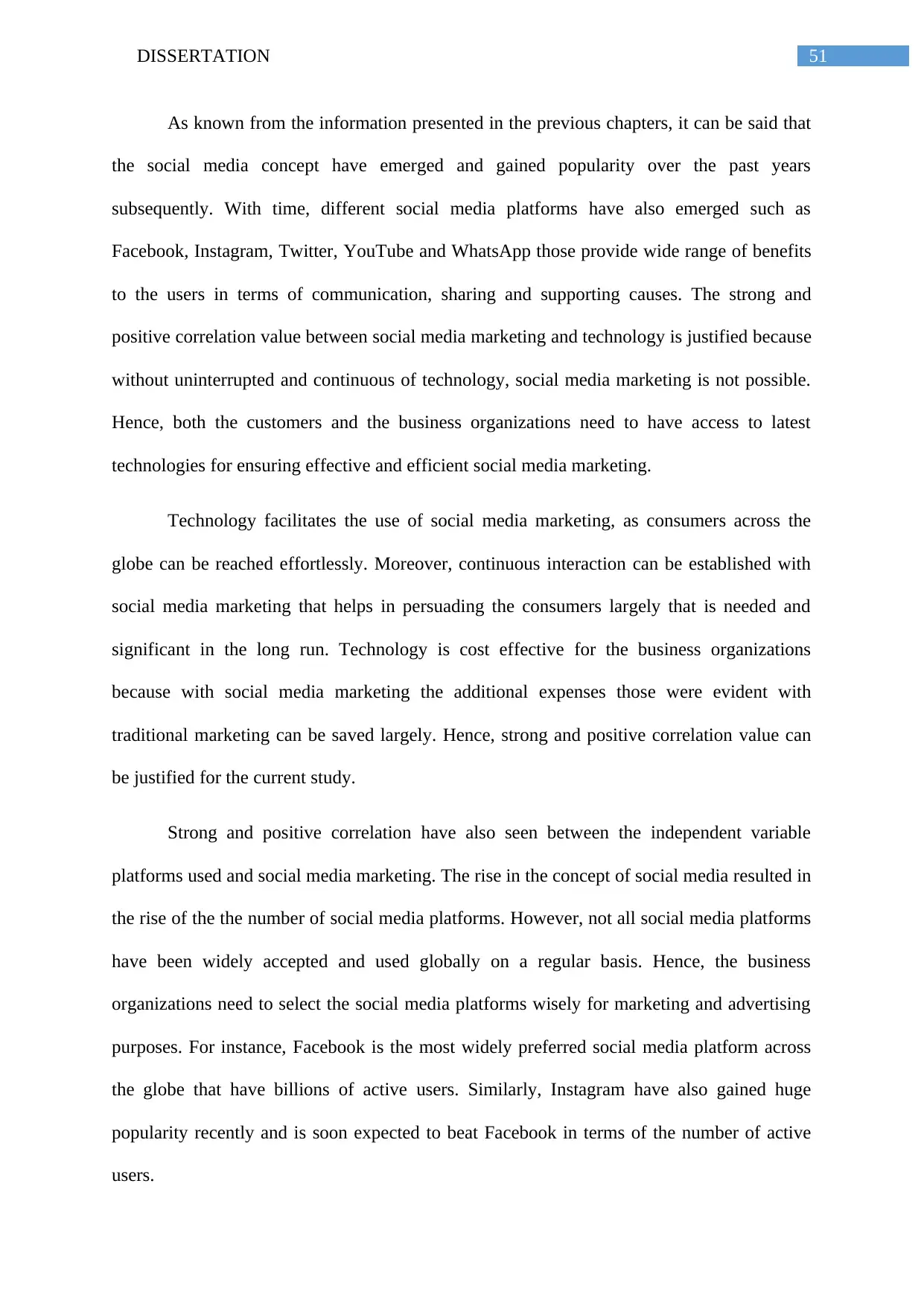
51DISSERTATION
As known from the information presented in the previous chapters, it can be said that
the social media concept have emerged and gained popularity over the past years
subsequently. With time, different social media platforms have also emerged such as
Facebook, Instagram, Twitter, YouTube and WhatsApp those provide wide range of benefits
to the users in terms of communication, sharing and supporting causes. The strong and
positive correlation value between social media marketing and technology is justified because
without uninterrupted and continuous of technology, social media marketing is not possible.
Hence, both the customers and the business organizations need to have access to latest
technologies for ensuring effective and efficient social media marketing.
Technology facilitates the use of social media marketing, as consumers across the
globe can be reached effortlessly. Moreover, continuous interaction can be established with
social media marketing that helps in persuading the consumers largely that is needed and
significant in the long run. Technology is cost effective for the business organizations
because with social media marketing the additional expenses those were evident with
traditional marketing can be saved largely. Hence, strong and positive correlation value can
be justified for the current study.
Strong and positive correlation have also seen between the independent variable
platforms used and social media marketing. The rise in the concept of social media resulted in
the rise of the the number of social media platforms. However, not all social media platforms
have been widely accepted and used globally on a regular basis. Hence, the business
organizations need to select the social media platforms wisely for marketing and advertising
purposes. For instance, Facebook is the most widely preferred social media platform across
the globe that have billions of active users. Similarly, Instagram have also gained huge
popularity recently and is soon expected to beat Facebook in terms of the number of active
users.
As known from the information presented in the previous chapters, it can be said that
the social media concept have emerged and gained popularity over the past years
subsequently. With time, different social media platforms have also emerged such as
Facebook, Instagram, Twitter, YouTube and WhatsApp those provide wide range of benefits
to the users in terms of communication, sharing and supporting causes. The strong and
positive correlation value between social media marketing and technology is justified because
without uninterrupted and continuous of technology, social media marketing is not possible.
Hence, both the customers and the business organizations need to have access to latest
technologies for ensuring effective and efficient social media marketing.
Technology facilitates the use of social media marketing, as consumers across the
globe can be reached effortlessly. Moreover, continuous interaction can be established with
social media marketing that helps in persuading the consumers largely that is needed and
significant in the long run. Technology is cost effective for the business organizations
because with social media marketing the additional expenses those were evident with
traditional marketing can be saved largely. Hence, strong and positive correlation value can
be justified for the current study.
Strong and positive correlation have also seen between the independent variable
platforms used and social media marketing. The rise in the concept of social media resulted in
the rise of the the number of social media platforms. However, not all social media platforms
have been widely accepted and used globally on a regular basis. Hence, the business
organizations need to select the social media platforms wisely for marketing and advertising
purposes. For instance, Facebook is the most widely preferred social media platform across
the globe that have billions of active users. Similarly, Instagram have also gained huge
popularity recently and is soon expected to beat Facebook in terms of the number of active
users.
Secure Best Marks with AI Grader
Need help grading? Try our AI Grader for instant feedback on your assignments.
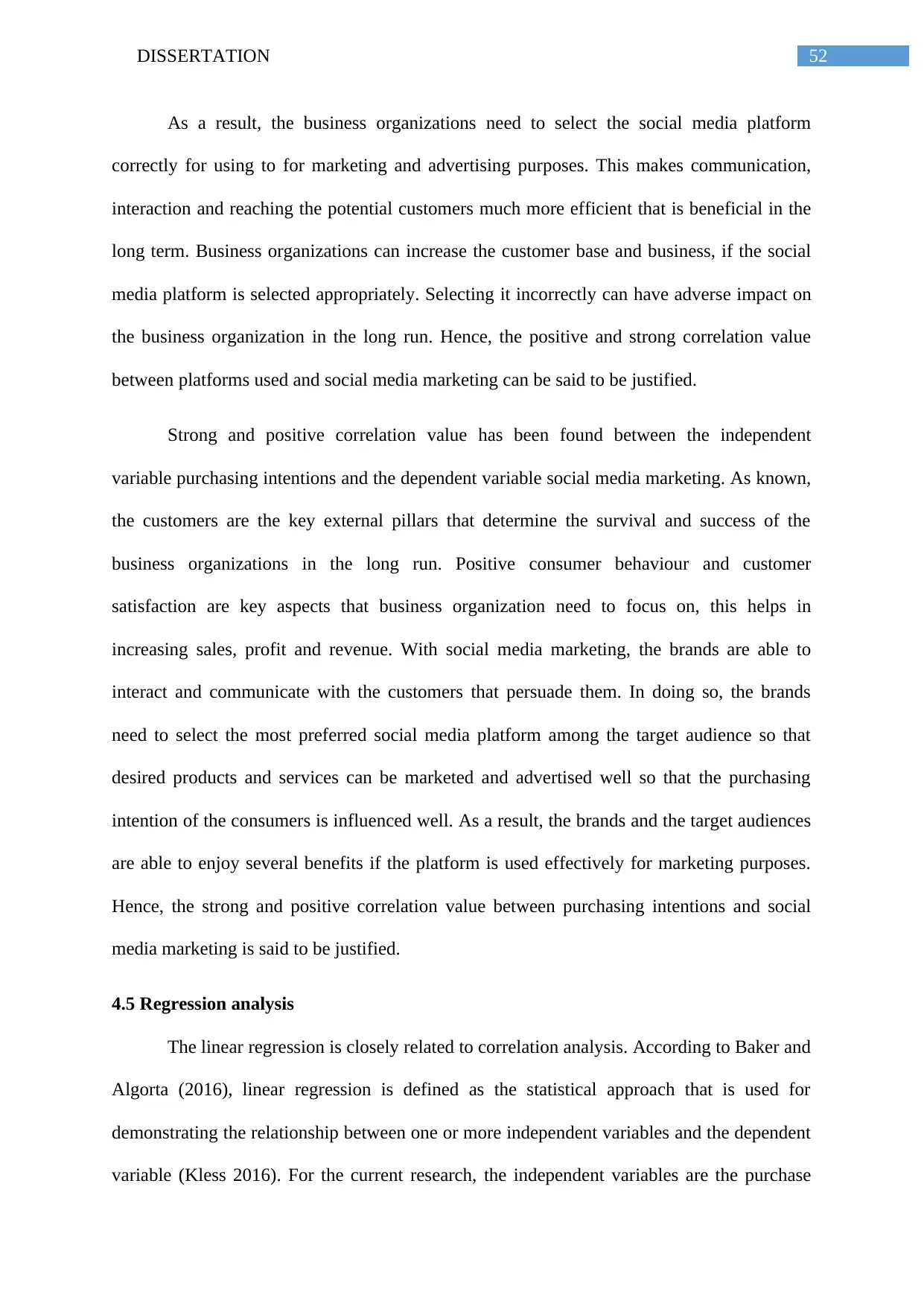
52DISSERTATION
As a result, the business organizations need to select the social media platform
correctly for using to for marketing and advertising purposes. This makes communication,
interaction and reaching the potential customers much more efficient that is beneficial in the
long term. Business organizations can increase the customer base and business, if the social
media platform is selected appropriately. Selecting it incorrectly can have adverse impact on
the business organization in the long run. Hence, the positive and strong correlation value
between platforms used and social media marketing can be said to be justified.
Strong and positive correlation value has been found between the independent
variable purchasing intentions and the dependent variable social media marketing. As known,
the customers are the key external pillars that determine the survival and success of the
business organizations in the long run. Positive consumer behaviour and customer
satisfaction are key aspects that business organization need to focus on, this helps in
increasing sales, profit and revenue. With social media marketing, the brands are able to
interact and communicate with the customers that persuade them. In doing so, the brands
need to select the most preferred social media platform among the target audience so that
desired products and services can be marketed and advertised well so that the purchasing
intention of the consumers is influenced well. As a result, the brands and the target audiences
are able to enjoy several benefits if the platform is used effectively for marketing purposes.
Hence, the strong and positive correlation value between purchasing intentions and social
media marketing is said to be justified.
4.5 Regression analysis
The linear regression is closely related to correlation analysis. According to Baker and
Algorta (2016), linear regression is defined as the statistical approach that is used for
demonstrating the relationship between one or more independent variables and the dependent
variable (Kless 2016). For the current research, the independent variables are the purchase
As a result, the business organizations need to select the social media platform
correctly for using to for marketing and advertising purposes. This makes communication,
interaction and reaching the potential customers much more efficient that is beneficial in the
long term. Business organizations can increase the customer base and business, if the social
media platform is selected appropriately. Selecting it incorrectly can have adverse impact on
the business organization in the long run. Hence, the positive and strong correlation value
between platforms used and social media marketing can be said to be justified.
Strong and positive correlation value has been found between the independent
variable purchasing intentions and the dependent variable social media marketing. As known,
the customers are the key external pillars that determine the survival and success of the
business organizations in the long run. Positive consumer behaviour and customer
satisfaction are key aspects that business organization need to focus on, this helps in
increasing sales, profit and revenue. With social media marketing, the brands are able to
interact and communicate with the customers that persuade them. In doing so, the brands
need to select the most preferred social media platform among the target audience so that
desired products and services can be marketed and advertised well so that the purchasing
intention of the consumers is influenced well. As a result, the brands and the target audiences
are able to enjoy several benefits if the platform is used effectively for marketing purposes.
Hence, the strong and positive correlation value between purchasing intentions and social
media marketing is said to be justified.
4.5 Regression analysis
The linear regression is closely related to correlation analysis. According to Baker and
Algorta (2016), linear regression is defined as the statistical approach that is used for
demonstrating the relationship between one or more independent variables and the dependent
variable (Kless 2016). For the current research, the independent variables are the purchase
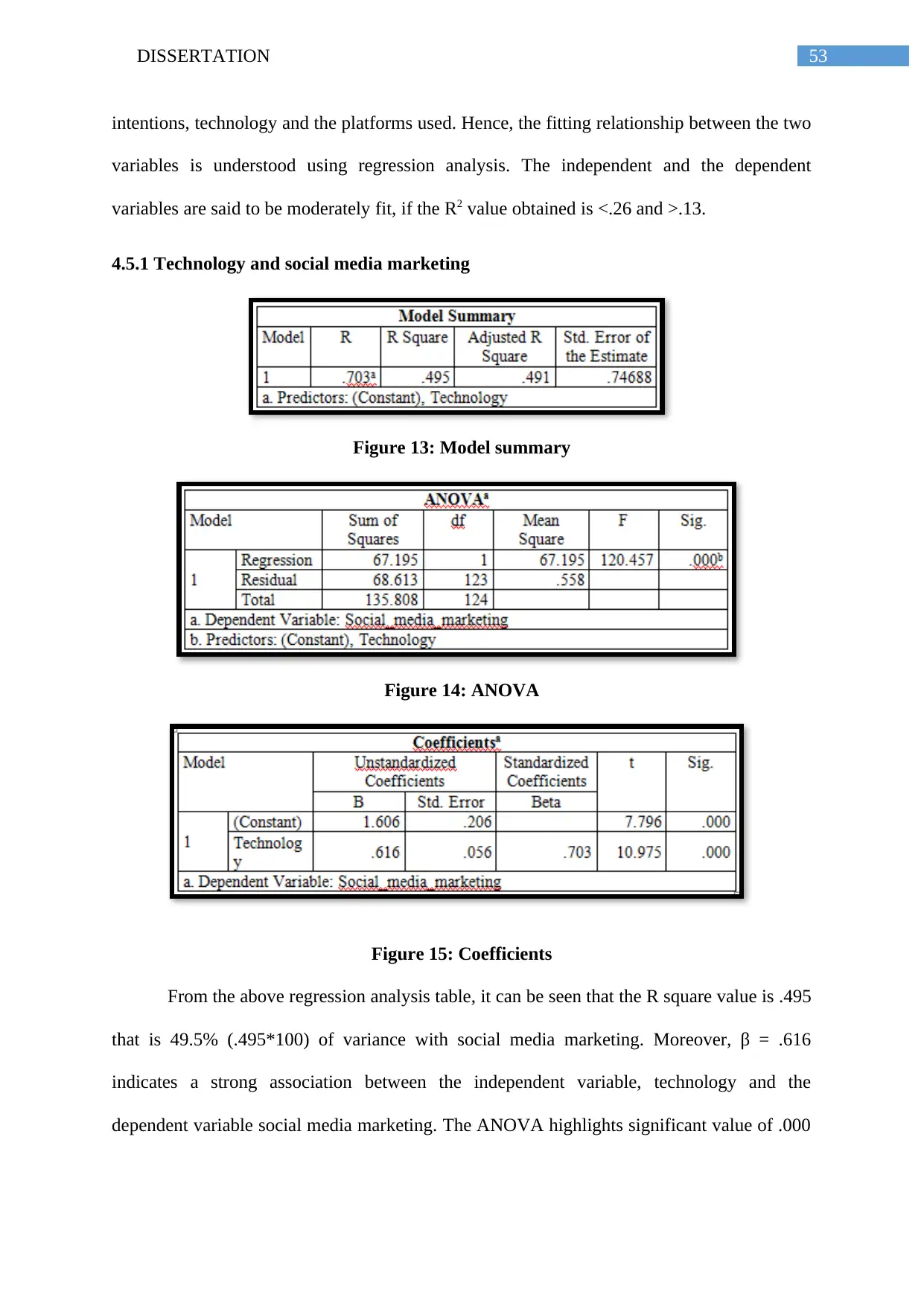
53DISSERTATION
intentions, technology and the platforms used. Hence, the fitting relationship between the two
variables is understood using regression analysis. The independent and the dependent
variables are said to be moderately fit, if the R2 value obtained is <.26 and >.13.
4.5.1 Technology and social media marketing
Figure 13: Model summary
Figure 14: ANOVA
Figure 15: Coefficients
From the above regression analysis table, it can be seen that the R square value is .495
that is 49.5% (.495*100) of variance with social media marketing. Moreover, β = .616
indicates a strong association between the independent variable, technology and the
dependent variable social media marketing. The ANOVA highlights significant value of .000
intentions, technology and the platforms used. Hence, the fitting relationship between the two
variables is understood using regression analysis. The independent and the dependent
variables are said to be moderately fit, if the R2 value obtained is <.26 and >.13.
4.5.1 Technology and social media marketing
Figure 13: Model summary
Figure 14: ANOVA
Figure 15: Coefficients
From the above regression analysis table, it can be seen that the R square value is .495
that is 49.5% (.495*100) of variance with social media marketing. Moreover, β = .616
indicates a strong association between the independent variable, technology and the
dependent variable social media marketing. The ANOVA highlights significant value of .000
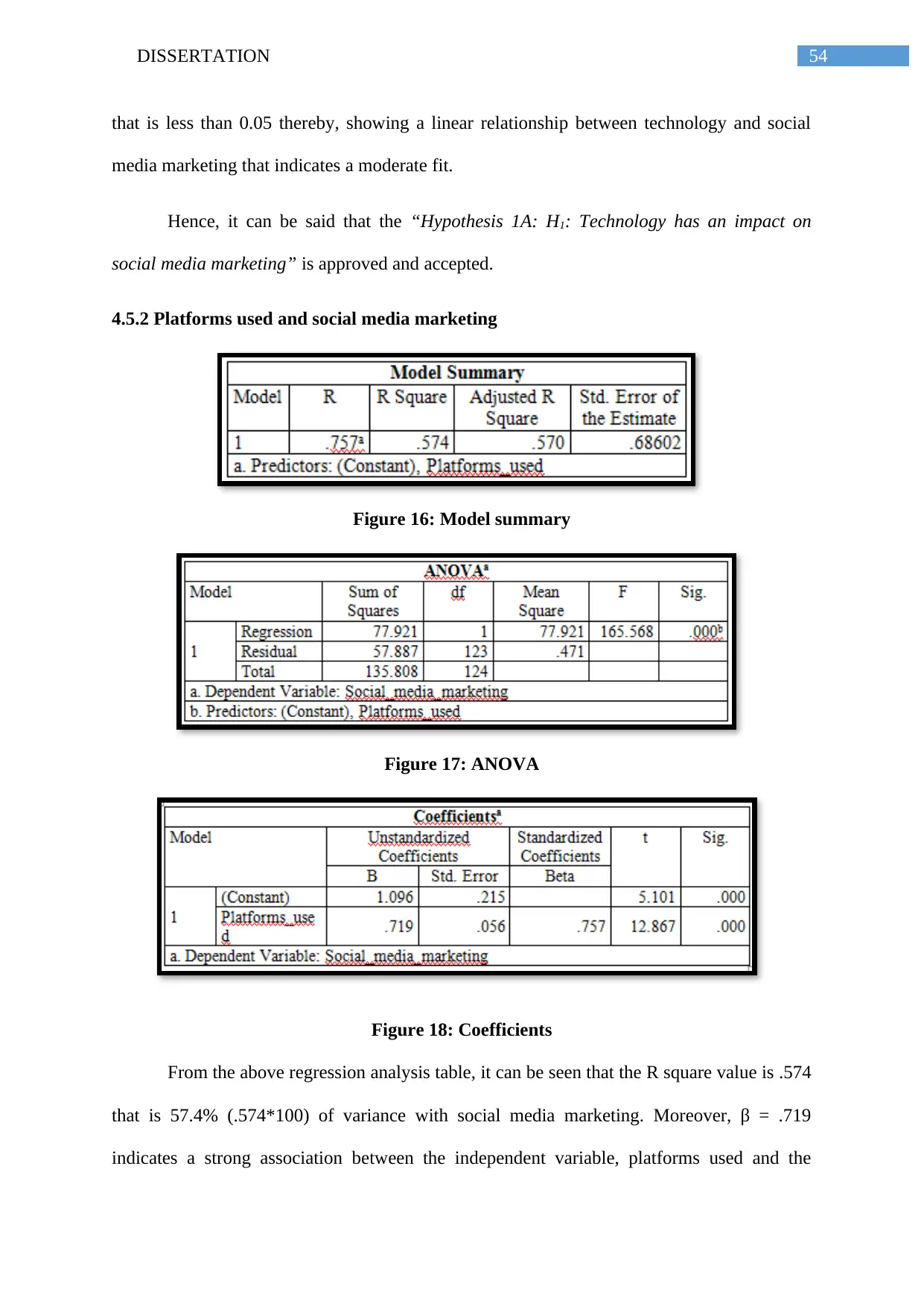
54DISSERTATION
that is less than 0.05 thereby, showing a linear relationship between technology and social
media marketing that indicates a moderate fit.
Hence, it can be said that the “Hypothesis 1A: H1: Technology has an impact on
social media marketing” is approved and accepted.
4.5.2 Platforms used and social media marketing
Figure 16: Model summary
Figure 17: ANOVA
Figure 18: Coefficients
From the above regression analysis table, it can be seen that the R square value is .574
that is 57.4% (.574*100) of variance with social media marketing. Moreover, β = .719
indicates a strong association between the independent variable, platforms used and the
that is less than 0.05 thereby, showing a linear relationship between technology and social
media marketing that indicates a moderate fit.
Hence, it can be said that the “Hypothesis 1A: H1: Technology has an impact on
social media marketing” is approved and accepted.
4.5.2 Platforms used and social media marketing
Figure 16: Model summary
Figure 17: ANOVA
Figure 18: Coefficients
From the above regression analysis table, it can be seen that the R square value is .574
that is 57.4% (.574*100) of variance with social media marketing. Moreover, β = .719
indicates a strong association between the independent variable, platforms used and the
Paraphrase This Document
Need a fresh take? Get an instant paraphrase of this document with our AI Paraphraser
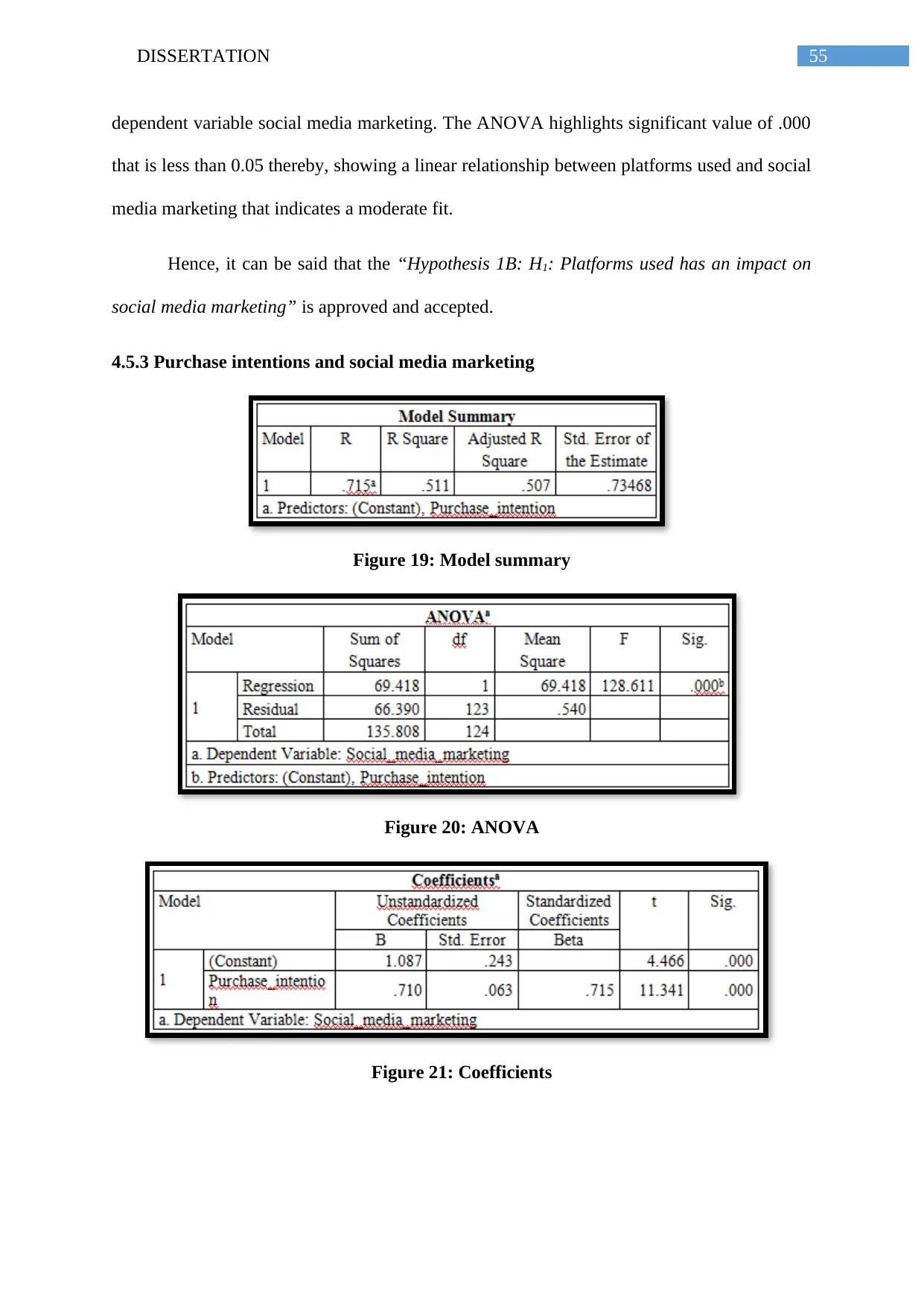
55DISSERTATION
dependent variable social media marketing. The ANOVA highlights significant value of .000
that is less than 0.05 thereby, showing a linear relationship between platforms used and social
media marketing that indicates a moderate fit.
Hence, it can be said that the “Hypothesis 1B: H1: Platforms used has an impact on
social media marketing” is approved and accepted.
4.5.3 Purchase intentions and social media marketing
Figure 19: Model summary
Figure 20: ANOVA
Figure 21: Coefficients
dependent variable social media marketing. The ANOVA highlights significant value of .000
that is less than 0.05 thereby, showing a linear relationship between platforms used and social
media marketing that indicates a moderate fit.
Hence, it can be said that the “Hypothesis 1B: H1: Platforms used has an impact on
social media marketing” is approved and accepted.
4.5.3 Purchase intentions and social media marketing
Figure 19: Model summary
Figure 20: ANOVA
Figure 21: Coefficients
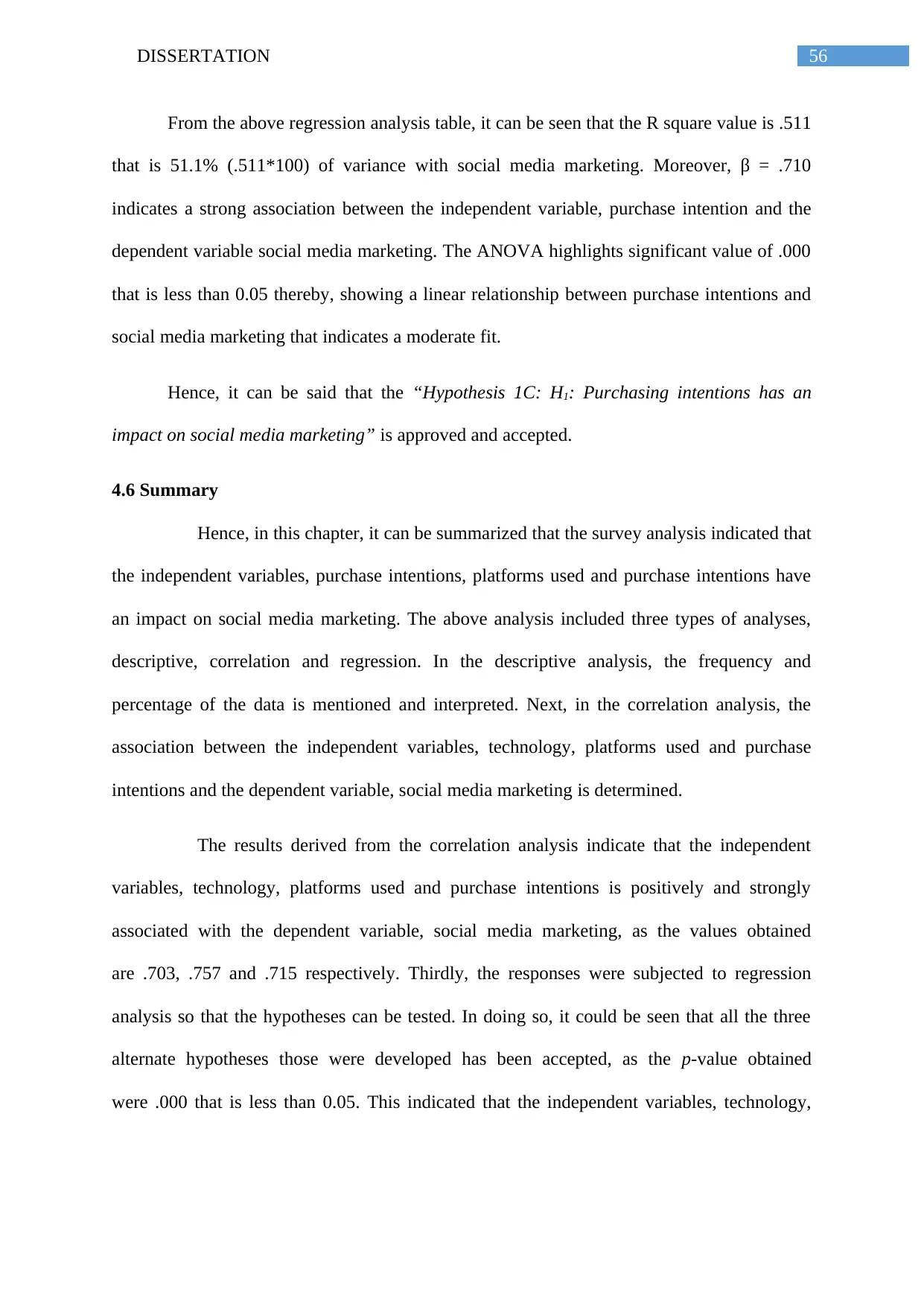
56DISSERTATION
From the above regression analysis table, it can be seen that the R square value is .511
that is 51.1% (.511*100) of variance with social media marketing. Moreover, β = .710
indicates a strong association between the independent variable, purchase intention and the
dependent variable social media marketing. The ANOVA highlights significant value of .000
that is less than 0.05 thereby, showing a linear relationship between purchase intentions and
social media marketing that indicates a moderate fit.
Hence, it can be said that the “Hypothesis 1C: H1: Purchasing intentions has an
impact on social media marketing” is approved and accepted.
4.6 Summary
Hence, in this chapter, it can be summarized that the survey analysis indicated that
the independent variables, purchase intentions, platforms used and purchase intentions have
an impact on social media marketing. The above analysis included three types of analyses,
descriptive, correlation and regression. In the descriptive analysis, the frequency and
percentage of the data is mentioned and interpreted. Next, in the correlation analysis, the
association between the independent variables, technology, platforms used and purchase
intentions and the dependent variable, social media marketing is determined.
The results derived from the correlation analysis indicate that the independent
variables, technology, platforms used and purchase intentions is positively and strongly
associated with the dependent variable, social media marketing, as the values obtained
are .703, .757 and .715 respectively. Thirdly, the responses were subjected to regression
analysis so that the hypotheses can be tested. In doing so, it could be seen that all the three
alternate hypotheses those were developed has been accepted, as the p-value obtained
were .000 that is less than 0.05. This indicated that the independent variables, technology,
From the above regression analysis table, it can be seen that the R square value is .511
that is 51.1% (.511*100) of variance with social media marketing. Moreover, β = .710
indicates a strong association between the independent variable, purchase intention and the
dependent variable social media marketing. The ANOVA highlights significant value of .000
that is less than 0.05 thereby, showing a linear relationship between purchase intentions and
social media marketing that indicates a moderate fit.
Hence, it can be said that the “Hypothesis 1C: H1: Purchasing intentions has an
impact on social media marketing” is approved and accepted.
4.6 Summary
Hence, in this chapter, it can be summarized that the survey analysis indicated that
the independent variables, purchase intentions, platforms used and purchase intentions have
an impact on social media marketing. The above analysis included three types of analyses,
descriptive, correlation and regression. In the descriptive analysis, the frequency and
percentage of the data is mentioned and interpreted. Next, in the correlation analysis, the
association between the independent variables, technology, platforms used and purchase
intentions and the dependent variable, social media marketing is determined.
The results derived from the correlation analysis indicate that the independent
variables, technology, platforms used and purchase intentions is positively and strongly
associated with the dependent variable, social media marketing, as the values obtained
are .703, .757 and .715 respectively. Thirdly, the responses were subjected to regression
analysis so that the hypotheses can be tested. In doing so, it could be seen that all the three
alternate hypotheses those were developed has been accepted, as the p-value obtained
were .000 that is less than 0.05. This indicated that the independent variables, technology,
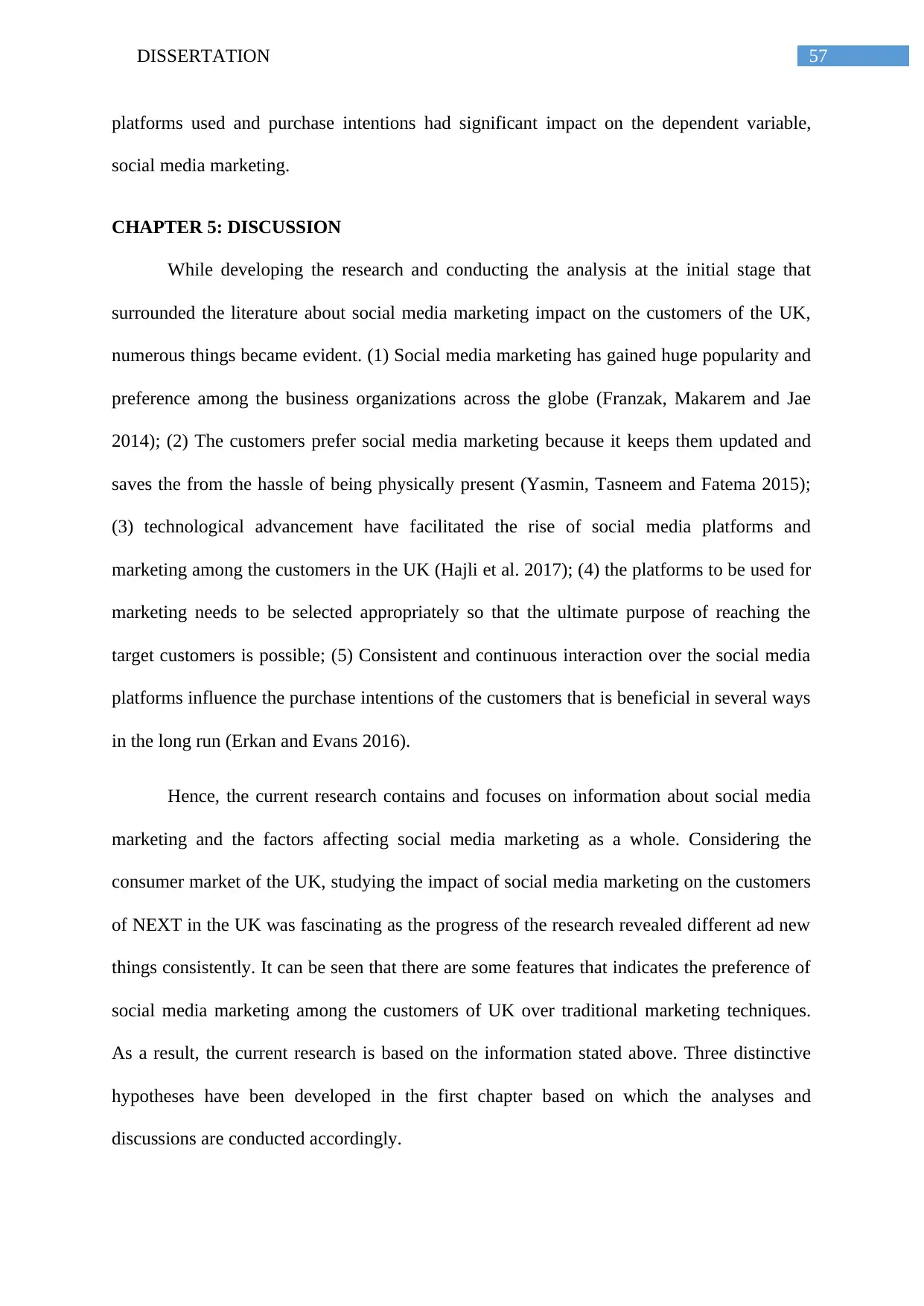
57DISSERTATION
platforms used and purchase intentions had significant impact on the dependent variable,
social media marketing.
CHAPTER 5: DISCUSSION
While developing the research and conducting the analysis at the initial stage that
surrounded the literature about social media marketing impact on the customers of the UK,
numerous things became evident. (1) Social media marketing has gained huge popularity and
preference among the business organizations across the globe (Franzak, Makarem and Jae
2014); (2) The customers prefer social media marketing because it keeps them updated and
saves the from the hassle of being physically present (Yasmin, Tasneem and Fatema 2015);
(3) technological advancement have facilitated the rise of social media platforms and
marketing among the customers in the UK (Hajli et al. 2017); (4) the platforms to be used for
marketing needs to be selected appropriately so that the ultimate purpose of reaching the
target customers is possible; (5) Consistent and continuous interaction over the social media
platforms influence the purchase intentions of the customers that is beneficial in several ways
in the long run (Erkan and Evans 2016).
Hence, the current research contains and focuses on information about social media
marketing and the factors affecting social media marketing as a whole. Considering the
consumer market of the UK, studying the impact of social media marketing on the customers
of NEXT in the UK was fascinating as the progress of the research revealed different ad new
things consistently. It can be seen that there are some features that indicates the preference of
social media marketing among the customers of UK over traditional marketing techniques.
As a result, the current research is based on the information stated above. Three distinctive
hypotheses have been developed in the first chapter based on which the analyses and
discussions are conducted accordingly.
platforms used and purchase intentions had significant impact on the dependent variable,
social media marketing.
CHAPTER 5: DISCUSSION
While developing the research and conducting the analysis at the initial stage that
surrounded the literature about social media marketing impact on the customers of the UK,
numerous things became evident. (1) Social media marketing has gained huge popularity and
preference among the business organizations across the globe (Franzak, Makarem and Jae
2014); (2) The customers prefer social media marketing because it keeps them updated and
saves the from the hassle of being physically present (Yasmin, Tasneem and Fatema 2015);
(3) technological advancement have facilitated the rise of social media platforms and
marketing among the customers in the UK (Hajli et al. 2017); (4) the platforms to be used for
marketing needs to be selected appropriately so that the ultimate purpose of reaching the
target customers is possible; (5) Consistent and continuous interaction over the social media
platforms influence the purchase intentions of the customers that is beneficial in several ways
in the long run (Erkan and Evans 2016).
Hence, the current research contains and focuses on information about social media
marketing and the factors affecting social media marketing as a whole. Considering the
consumer market of the UK, studying the impact of social media marketing on the customers
of NEXT in the UK was fascinating as the progress of the research revealed different ad new
things consistently. It can be seen that there are some features that indicates the preference of
social media marketing among the customers of UK over traditional marketing techniques.
As a result, the current research is based on the information stated above. Three distinctive
hypotheses have been developed in the first chapter based on which the analyses and
discussions are conducted accordingly.
Secure Best Marks with AI Grader
Need help grading? Try our AI Grader for instant feedback on your assignments.
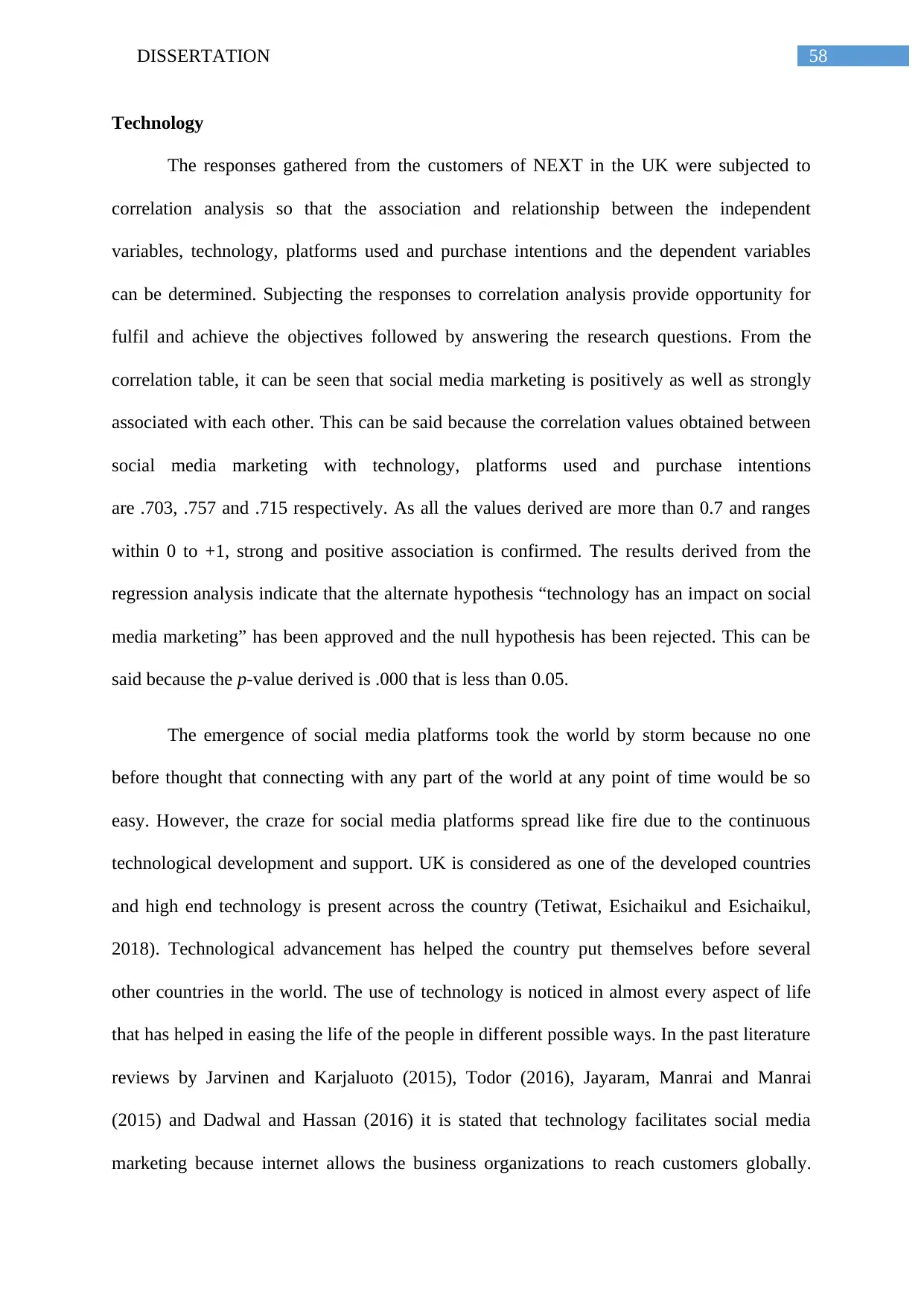
58DISSERTATION
Technology
The responses gathered from the customers of NEXT in the UK were subjected to
correlation analysis so that the association and relationship between the independent
variables, technology, platforms used and purchase intentions and the dependent variables
can be determined. Subjecting the responses to correlation analysis provide opportunity for
fulfil and achieve the objectives followed by answering the research questions. From the
correlation table, it can be seen that social media marketing is positively as well as strongly
associated with each other. This can be said because the correlation values obtained between
social media marketing with technology, platforms used and purchase intentions
are .703, .757 and .715 respectively. As all the values derived are more than 0.7 and ranges
within 0 to +1, strong and positive association is confirmed. The results derived from the
regression analysis indicate that the alternate hypothesis “technology has an impact on social
media marketing” has been approved and the null hypothesis has been rejected. This can be
said because the p-value derived is .000 that is less than 0.05.
The emergence of social media platforms took the world by storm because no one
before thought that connecting with any part of the world at any point of time would be so
easy. However, the craze for social media platforms spread like fire due to the continuous
technological development and support. UK is considered as one of the developed countries
and high end technology is present across the country (Tetiwat, Esichaikul and Esichaikul,
2018). Technological advancement has helped the country put themselves before several
other countries in the world. The use of technology is noticed in almost every aspect of life
that has helped in easing the life of the people in different possible ways. In the past literature
reviews by Jarvinen and Karjaluoto (2015), Todor (2016), Jayaram, Manrai and Manrai
(2015) and Dadwal and Hassan (2016) it is stated that technology facilitates social media
marketing because internet allows the business organizations to reach customers globally.
Technology
The responses gathered from the customers of NEXT in the UK were subjected to
correlation analysis so that the association and relationship between the independent
variables, technology, platforms used and purchase intentions and the dependent variables
can be determined. Subjecting the responses to correlation analysis provide opportunity for
fulfil and achieve the objectives followed by answering the research questions. From the
correlation table, it can be seen that social media marketing is positively as well as strongly
associated with each other. This can be said because the correlation values obtained between
social media marketing with technology, platforms used and purchase intentions
are .703, .757 and .715 respectively. As all the values derived are more than 0.7 and ranges
within 0 to +1, strong and positive association is confirmed. The results derived from the
regression analysis indicate that the alternate hypothesis “technology has an impact on social
media marketing” has been approved and the null hypothesis has been rejected. This can be
said because the p-value derived is .000 that is less than 0.05.
The emergence of social media platforms took the world by storm because no one
before thought that connecting with any part of the world at any point of time would be so
easy. However, the craze for social media platforms spread like fire due to the continuous
technological development and support. UK is considered as one of the developed countries
and high end technology is present across the country (Tetiwat, Esichaikul and Esichaikul,
2018). Technological advancement has helped the country put themselves before several
other countries in the world. The use of technology is noticed in almost every aspect of life
that has helped in easing the life of the people in different possible ways. In the past literature
reviews by Jarvinen and Karjaluoto (2015), Todor (2016), Jayaram, Manrai and Manrai
(2015) and Dadwal and Hassan (2016) it is stated that technology facilitates social media
marketing because internet allows the business organizations to reach customers globally.
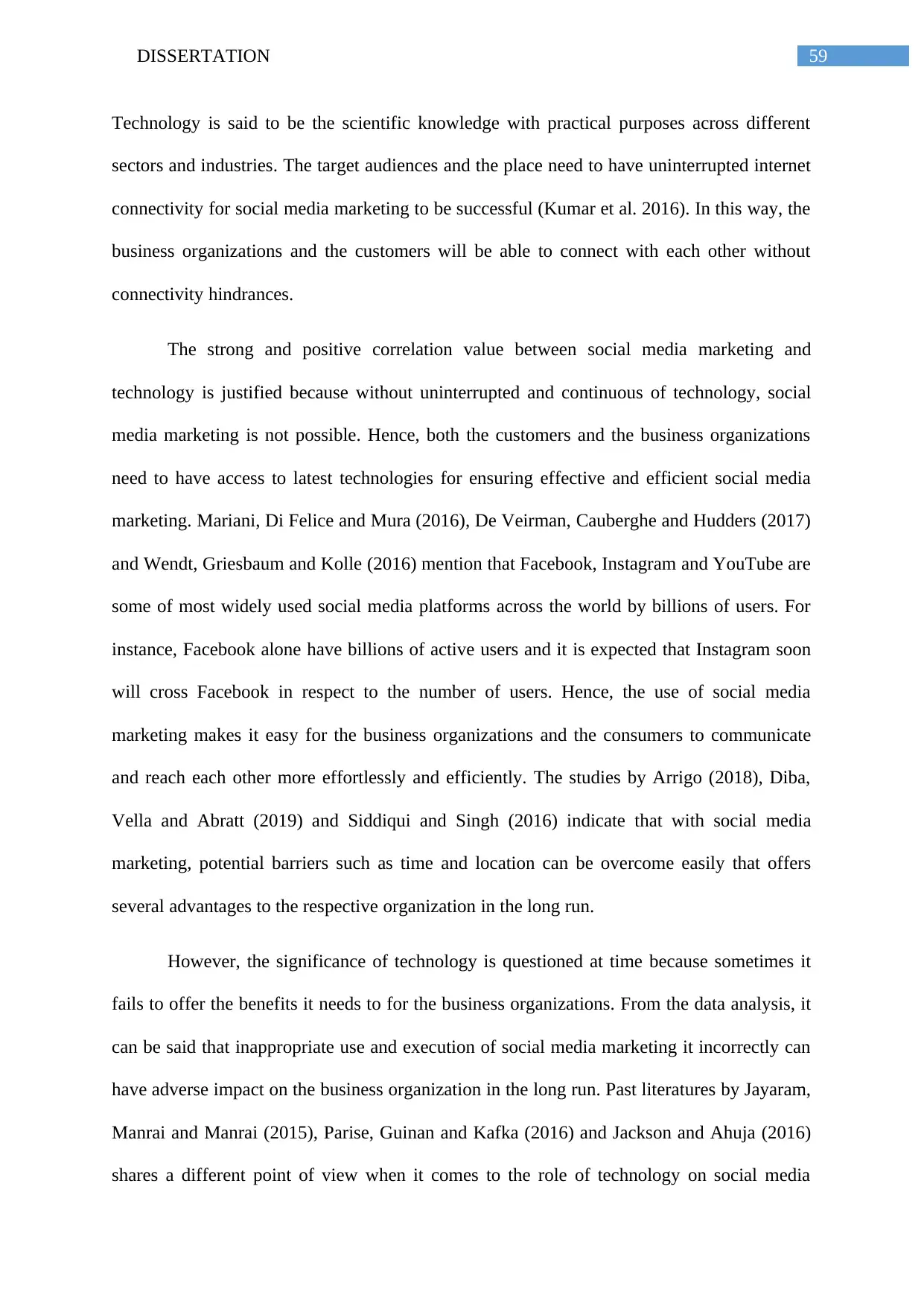
59DISSERTATION
Technology is said to be the scientific knowledge with practical purposes across different
sectors and industries. The target audiences and the place need to have uninterrupted internet
connectivity for social media marketing to be successful (Kumar et al. 2016). In this way, the
business organizations and the customers will be able to connect with each other without
connectivity hindrances.
The strong and positive correlation value between social media marketing and
technology is justified because without uninterrupted and continuous of technology, social
media marketing is not possible. Hence, both the customers and the business organizations
need to have access to latest technologies for ensuring effective and efficient social media
marketing. Mariani, Di Felice and Mura (2016), De Veirman, Cauberghe and Hudders (2017)
and Wendt, Griesbaum and Kolle (2016) mention that Facebook, Instagram and YouTube are
some of most widely used social media platforms across the world by billions of users. For
instance, Facebook alone have billions of active users and it is expected that Instagram soon
will cross Facebook in respect to the number of users. Hence, the use of social media
marketing makes it easy for the business organizations and the consumers to communicate
and reach each other more effortlessly and efficiently. The studies by Arrigo (2018), Diba,
Vella and Abratt (2019) and Siddiqui and Singh (2016) indicate that with social media
marketing, potential barriers such as time and location can be overcome easily that offers
several advantages to the respective organization in the long run.
However, the significance of technology is questioned at time because sometimes it
fails to offer the benefits it needs to for the business organizations. From the data analysis, it
can be said that inappropriate use and execution of social media marketing it incorrectly can
have adverse impact on the business organization in the long run. Past literatures by Jayaram,
Manrai and Manrai (2015), Parise, Guinan and Kafka (2016) and Jackson and Ahuja (2016)
shares a different point of view when it comes to the role of technology on social media
Technology is said to be the scientific knowledge with practical purposes across different
sectors and industries. The target audiences and the place need to have uninterrupted internet
connectivity for social media marketing to be successful (Kumar et al. 2016). In this way, the
business organizations and the customers will be able to connect with each other without
connectivity hindrances.
The strong and positive correlation value between social media marketing and
technology is justified because without uninterrupted and continuous of technology, social
media marketing is not possible. Hence, both the customers and the business organizations
need to have access to latest technologies for ensuring effective and efficient social media
marketing. Mariani, Di Felice and Mura (2016), De Veirman, Cauberghe and Hudders (2017)
and Wendt, Griesbaum and Kolle (2016) mention that Facebook, Instagram and YouTube are
some of most widely used social media platforms across the world by billions of users. For
instance, Facebook alone have billions of active users and it is expected that Instagram soon
will cross Facebook in respect to the number of users. Hence, the use of social media
marketing makes it easy for the business organizations and the consumers to communicate
and reach each other more effortlessly and efficiently. The studies by Arrigo (2018), Diba,
Vella and Abratt (2019) and Siddiqui and Singh (2016) indicate that with social media
marketing, potential barriers such as time and location can be overcome easily that offers
several advantages to the respective organization in the long run.
However, the significance of technology is questioned at time because sometimes it
fails to offer the benefits it needs to for the business organizations. From the data analysis, it
can be said that inappropriate use and execution of social media marketing it incorrectly can
have adverse impact on the business organization in the long run. Past literatures by Jayaram,
Manrai and Manrai (2015), Parise, Guinan and Kafka (2016) and Jackson and Ahuja (2016)
shares a different point of view when it comes to the role of technology on social media
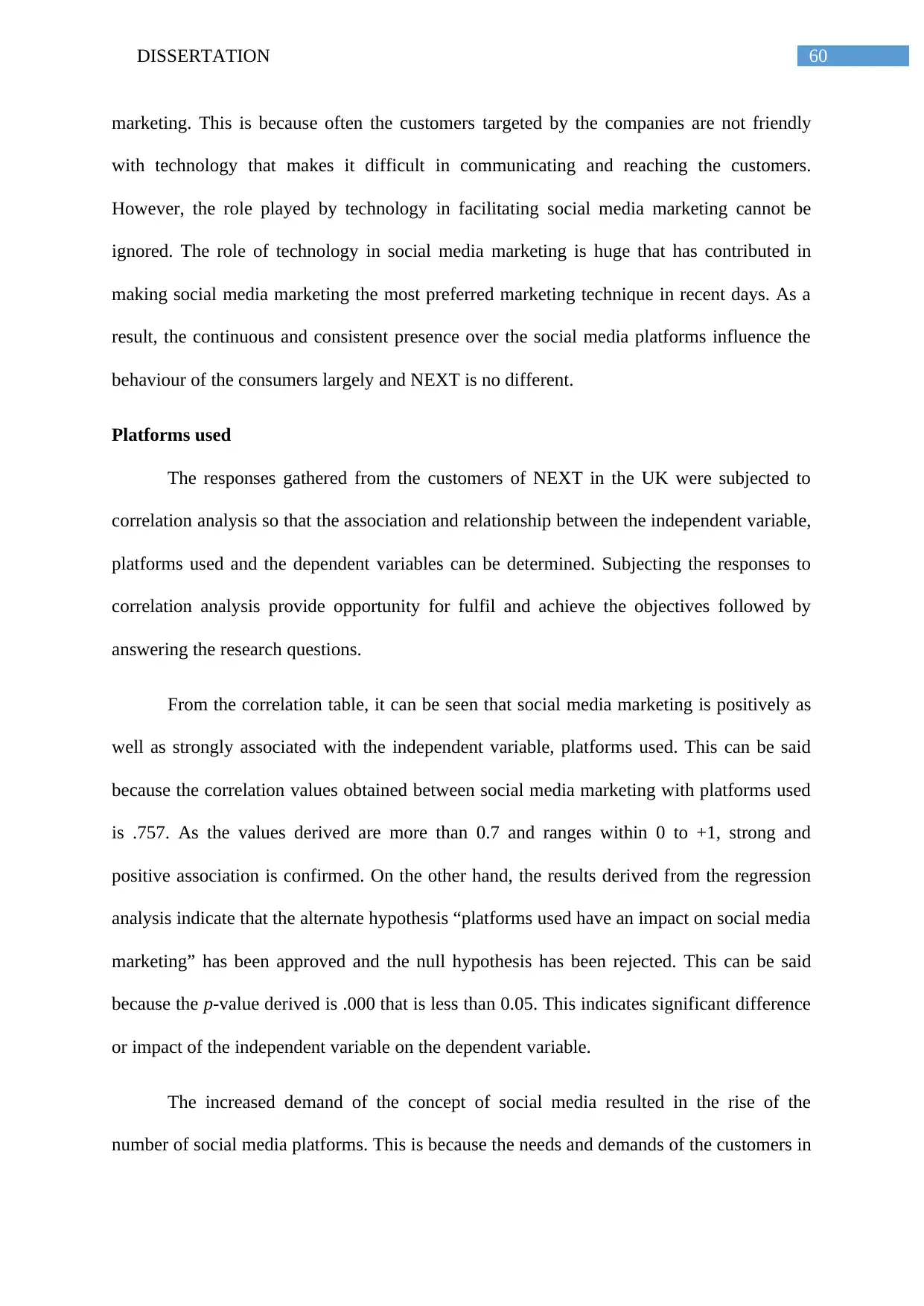
60DISSERTATION
marketing. This is because often the customers targeted by the companies are not friendly
with technology that makes it difficult in communicating and reaching the customers.
However, the role played by technology in facilitating social media marketing cannot be
ignored. The role of technology in social media marketing is huge that has contributed in
making social media marketing the most preferred marketing technique in recent days. As a
result, the continuous and consistent presence over the social media platforms influence the
behaviour of the consumers largely and NEXT is no different.
Platforms used
The responses gathered from the customers of NEXT in the UK were subjected to
correlation analysis so that the association and relationship between the independent variable,
platforms used and the dependent variables can be determined. Subjecting the responses to
correlation analysis provide opportunity for fulfil and achieve the objectives followed by
answering the research questions.
From the correlation table, it can be seen that social media marketing is positively as
well as strongly associated with the independent variable, platforms used. This can be said
because the correlation values obtained between social media marketing with platforms used
is .757. As the values derived are more than 0.7 and ranges within 0 to +1, strong and
positive association is confirmed. On the other hand, the results derived from the regression
analysis indicate that the alternate hypothesis “platforms used have an impact on social media
marketing” has been approved and the null hypothesis has been rejected. This can be said
because the p-value derived is .000 that is less than 0.05. This indicates significant difference
or impact of the independent variable on the dependent variable.
The increased demand of the concept of social media resulted in the rise of the
number of social media platforms. This is because the needs and demands of the customers in
marketing. This is because often the customers targeted by the companies are not friendly
with technology that makes it difficult in communicating and reaching the customers.
However, the role played by technology in facilitating social media marketing cannot be
ignored. The role of technology in social media marketing is huge that has contributed in
making social media marketing the most preferred marketing technique in recent days. As a
result, the continuous and consistent presence over the social media platforms influence the
behaviour of the consumers largely and NEXT is no different.
Platforms used
The responses gathered from the customers of NEXT in the UK were subjected to
correlation analysis so that the association and relationship between the independent variable,
platforms used and the dependent variables can be determined. Subjecting the responses to
correlation analysis provide opportunity for fulfil and achieve the objectives followed by
answering the research questions.
From the correlation table, it can be seen that social media marketing is positively as
well as strongly associated with the independent variable, platforms used. This can be said
because the correlation values obtained between social media marketing with platforms used
is .757. As the values derived are more than 0.7 and ranges within 0 to +1, strong and
positive association is confirmed. On the other hand, the results derived from the regression
analysis indicate that the alternate hypothesis “platforms used have an impact on social media
marketing” has been approved and the null hypothesis has been rejected. This can be said
because the p-value derived is .000 that is less than 0.05. This indicates significant difference
or impact of the independent variable on the dependent variable.
The increased demand of the concept of social media resulted in the rise of the
number of social media platforms. This is because the needs and demands of the customers in
Paraphrase This Document
Need a fresh take? Get an instant paraphrase of this document with our AI Paraphraser
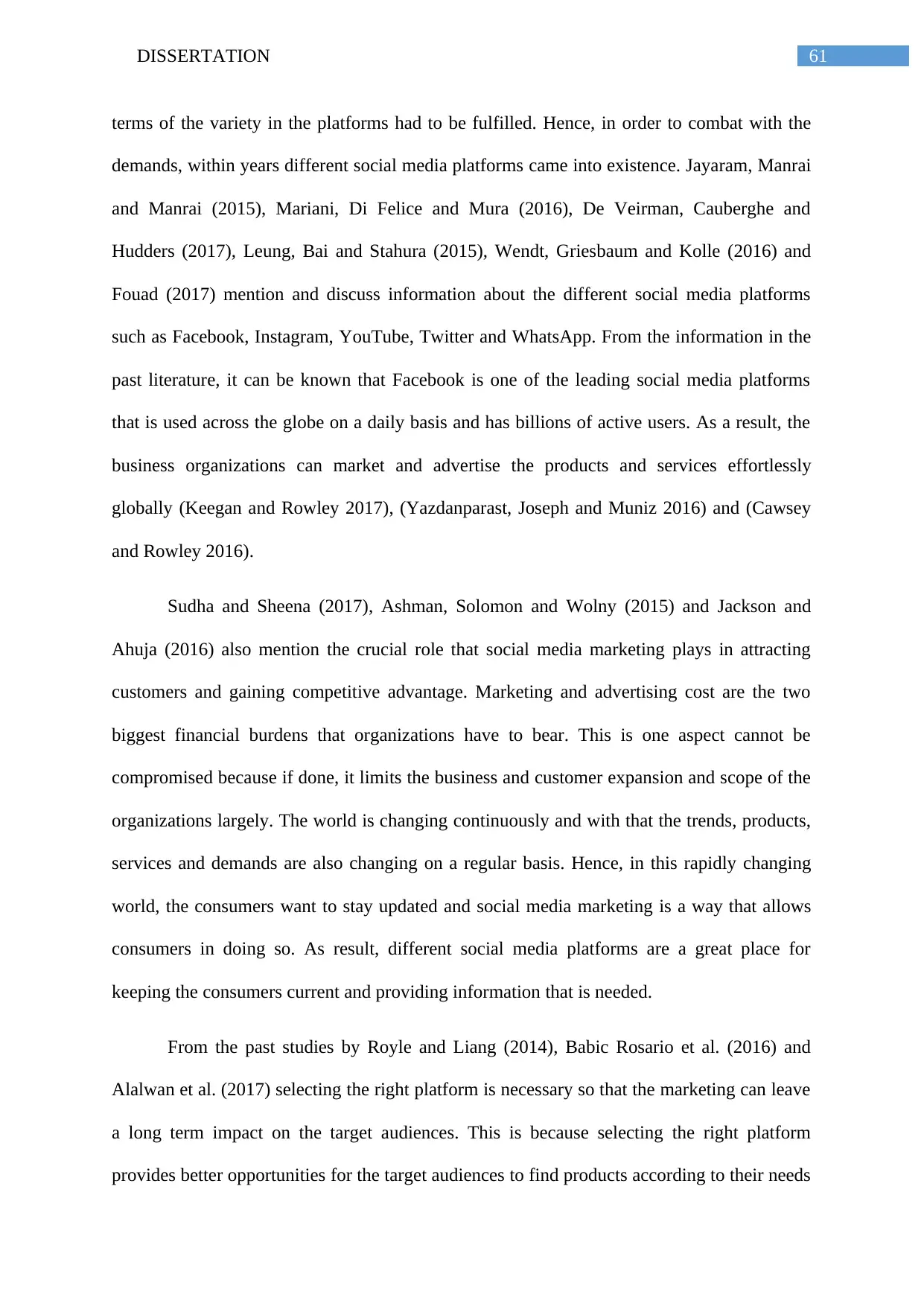
61DISSERTATION
terms of the variety in the platforms had to be fulfilled. Hence, in order to combat with the
demands, within years different social media platforms came into existence. Jayaram, Manrai
and Manrai (2015), Mariani, Di Felice and Mura (2016), De Veirman, Cauberghe and
Hudders (2017), Leung, Bai and Stahura (2015), Wendt, Griesbaum and Kolle (2016) and
Fouad (2017) mention and discuss information about the different social media platforms
such as Facebook, Instagram, YouTube, Twitter and WhatsApp. From the information in the
past literature, it can be known that Facebook is one of the leading social media platforms
that is used across the globe on a daily basis and has billions of active users. As a result, the
business organizations can market and advertise the products and services effortlessly
globally (Keegan and Rowley 2017), (Yazdanparast, Joseph and Muniz 2016) and (Cawsey
and Rowley 2016).
Sudha and Sheena (2017), Ashman, Solomon and Wolny (2015) and Jackson and
Ahuja (2016) also mention the crucial role that social media marketing plays in attracting
customers and gaining competitive advantage. Marketing and advertising cost are the two
biggest financial burdens that organizations have to bear. This is one aspect cannot be
compromised because if done, it limits the business and customer expansion and scope of the
organizations largely. The world is changing continuously and with that the trends, products,
services and demands are also changing on a regular basis. Hence, in this rapidly changing
world, the consumers want to stay updated and social media marketing is a way that allows
consumers in doing so. As result, different social media platforms are a great place for
keeping the consumers current and providing information that is needed.
From the past studies by Royle and Liang (2014), Babic Rosario et al. (2016) and
Alalwan et al. (2017) selecting the right platform is necessary so that the marketing can leave
a long term impact on the target audiences. This is because selecting the right platform
provides better opportunities for the target audiences to find products according to their needs
terms of the variety in the platforms had to be fulfilled. Hence, in order to combat with the
demands, within years different social media platforms came into existence. Jayaram, Manrai
and Manrai (2015), Mariani, Di Felice and Mura (2016), De Veirman, Cauberghe and
Hudders (2017), Leung, Bai and Stahura (2015), Wendt, Griesbaum and Kolle (2016) and
Fouad (2017) mention and discuss information about the different social media platforms
such as Facebook, Instagram, YouTube, Twitter and WhatsApp. From the information in the
past literature, it can be known that Facebook is one of the leading social media platforms
that is used across the globe on a daily basis and has billions of active users. As a result, the
business organizations can market and advertise the products and services effortlessly
globally (Keegan and Rowley 2017), (Yazdanparast, Joseph and Muniz 2016) and (Cawsey
and Rowley 2016).
Sudha and Sheena (2017), Ashman, Solomon and Wolny (2015) and Jackson and
Ahuja (2016) also mention the crucial role that social media marketing plays in attracting
customers and gaining competitive advantage. Marketing and advertising cost are the two
biggest financial burdens that organizations have to bear. This is one aspect cannot be
compromised because if done, it limits the business and customer expansion and scope of the
organizations largely. The world is changing continuously and with that the trends, products,
services and demands are also changing on a regular basis. Hence, in this rapidly changing
world, the consumers want to stay updated and social media marketing is a way that allows
consumers in doing so. As result, different social media platforms are a great place for
keeping the consumers current and providing information that is needed.
From the past studies by Royle and Liang (2014), Babic Rosario et al. (2016) and
Alalwan et al. (2017) selecting the right platform is necessary so that the marketing can leave
a long term impact on the target audiences. This is because selecting the right platform
provides better opportunities for the target audiences to find products according to their needs
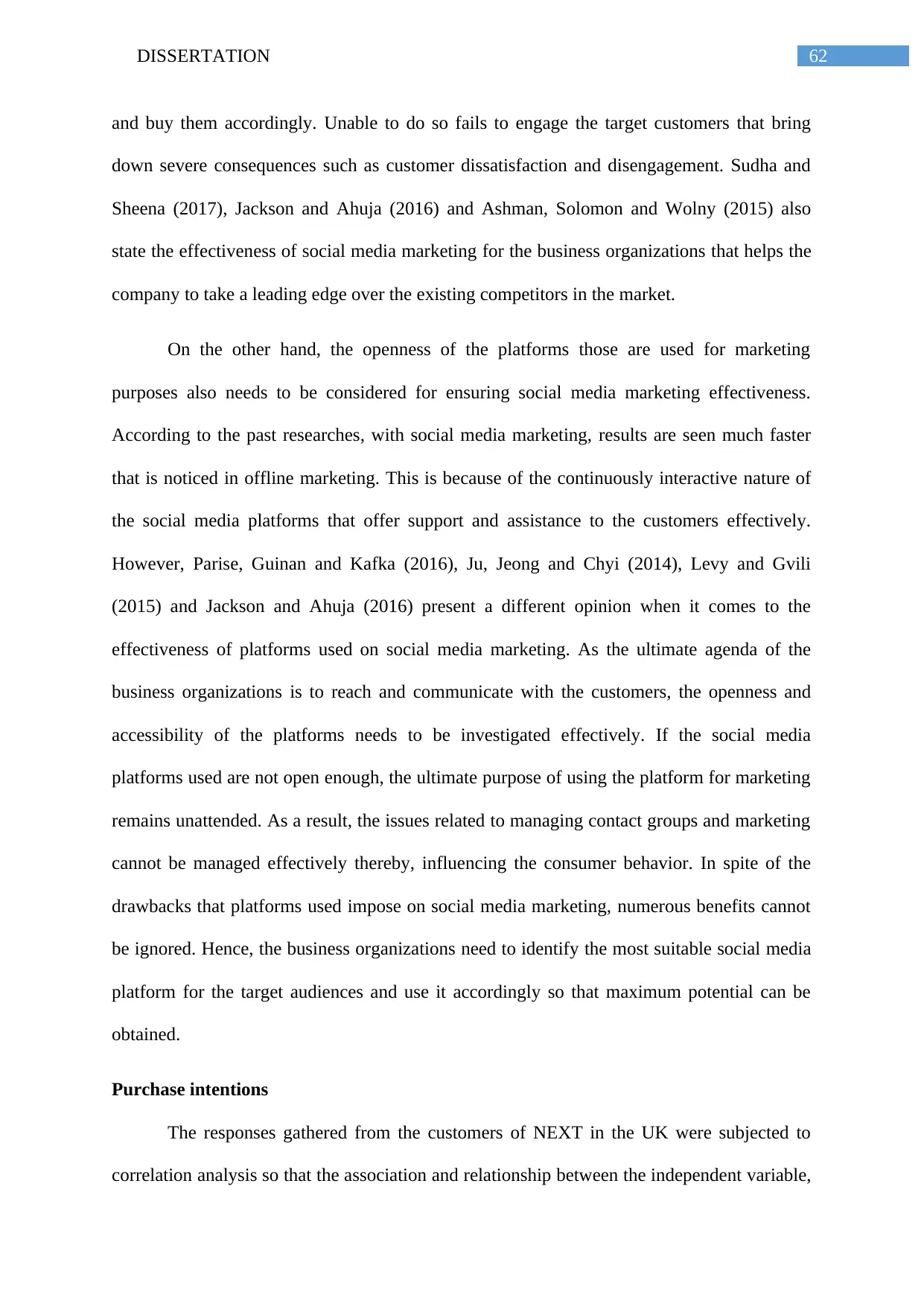
62DISSERTATION
and buy them accordingly. Unable to do so fails to engage the target customers that bring
down severe consequences such as customer dissatisfaction and disengagement. Sudha and
Sheena (2017), Jackson and Ahuja (2016) and Ashman, Solomon and Wolny (2015) also
state the effectiveness of social media marketing for the business organizations that helps the
company to take a leading edge over the existing competitors in the market.
On the other hand, the openness of the platforms those are used for marketing
purposes also needs to be considered for ensuring social media marketing effectiveness.
According to the past researches, with social media marketing, results are seen much faster
that is noticed in offline marketing. This is because of the continuously interactive nature of
the social media platforms that offer support and assistance to the customers effectively.
However, Parise, Guinan and Kafka (2016), Ju, Jeong and Chyi (2014), Levy and Gvili
(2015) and Jackson and Ahuja (2016) present a different opinion when it comes to the
effectiveness of platforms used on social media marketing. As the ultimate agenda of the
business organizations is to reach and communicate with the customers, the openness and
accessibility of the platforms needs to be investigated effectively. If the social media
platforms used are not open enough, the ultimate purpose of using the platform for marketing
remains unattended. As a result, the issues related to managing contact groups and marketing
cannot be managed effectively thereby, influencing the consumer behavior. In spite of the
drawbacks that platforms used impose on social media marketing, numerous benefits cannot
be ignored. Hence, the business organizations need to identify the most suitable social media
platform for the target audiences and use it accordingly so that maximum potential can be
obtained.
Purchase intentions
The responses gathered from the customers of NEXT in the UK were subjected to
correlation analysis so that the association and relationship between the independent variable,
and buy them accordingly. Unable to do so fails to engage the target customers that bring
down severe consequences such as customer dissatisfaction and disengagement. Sudha and
Sheena (2017), Jackson and Ahuja (2016) and Ashman, Solomon and Wolny (2015) also
state the effectiveness of social media marketing for the business organizations that helps the
company to take a leading edge over the existing competitors in the market.
On the other hand, the openness of the platforms those are used for marketing
purposes also needs to be considered for ensuring social media marketing effectiveness.
According to the past researches, with social media marketing, results are seen much faster
that is noticed in offline marketing. This is because of the continuously interactive nature of
the social media platforms that offer support and assistance to the customers effectively.
However, Parise, Guinan and Kafka (2016), Ju, Jeong and Chyi (2014), Levy and Gvili
(2015) and Jackson and Ahuja (2016) present a different opinion when it comes to the
effectiveness of platforms used on social media marketing. As the ultimate agenda of the
business organizations is to reach and communicate with the customers, the openness and
accessibility of the platforms needs to be investigated effectively. If the social media
platforms used are not open enough, the ultimate purpose of using the platform for marketing
remains unattended. As a result, the issues related to managing contact groups and marketing
cannot be managed effectively thereby, influencing the consumer behavior. In spite of the
drawbacks that platforms used impose on social media marketing, numerous benefits cannot
be ignored. Hence, the business organizations need to identify the most suitable social media
platform for the target audiences and use it accordingly so that maximum potential can be
obtained.
Purchase intentions
The responses gathered from the customers of NEXT in the UK were subjected to
correlation analysis so that the association and relationship between the independent variable,
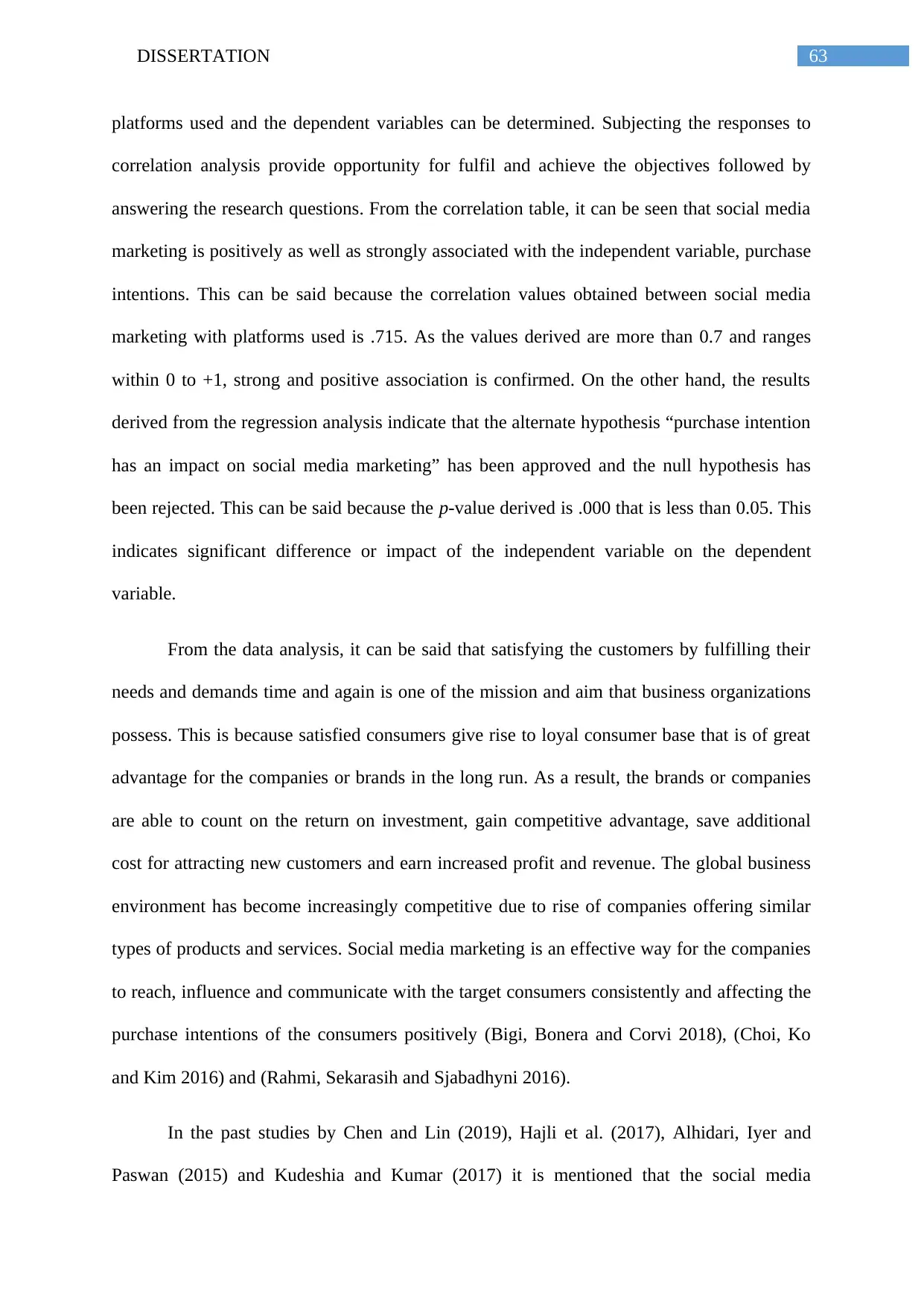
63DISSERTATION
platforms used and the dependent variables can be determined. Subjecting the responses to
correlation analysis provide opportunity for fulfil and achieve the objectives followed by
answering the research questions. From the correlation table, it can be seen that social media
marketing is positively as well as strongly associated with the independent variable, purchase
intentions. This can be said because the correlation values obtained between social media
marketing with platforms used is .715. As the values derived are more than 0.7 and ranges
within 0 to +1, strong and positive association is confirmed. On the other hand, the results
derived from the regression analysis indicate that the alternate hypothesis “purchase intention
has an impact on social media marketing” has been approved and the null hypothesis has
been rejected. This can be said because the p-value derived is .000 that is less than 0.05. This
indicates significant difference or impact of the independent variable on the dependent
variable.
From the data analysis, it can be said that satisfying the customers by fulfilling their
needs and demands time and again is one of the mission and aim that business organizations
possess. This is because satisfied consumers give rise to loyal consumer base that is of great
advantage for the companies or brands in the long run. As a result, the brands or companies
are able to count on the return on investment, gain competitive advantage, save additional
cost for attracting new customers and earn increased profit and revenue. The global business
environment has become increasingly competitive due to rise of companies offering similar
types of products and services. Social media marketing is an effective way for the companies
to reach, influence and communicate with the target consumers consistently and affecting the
purchase intentions of the consumers positively (Bigi, Bonera and Corvi 2018), (Choi, Ko
and Kim 2016) and (Rahmi, Sekarasih and Sjabadhyni 2016).
In the past studies by Chen and Lin (2019), Hajli et al. (2017), Alhidari, Iyer and
Paswan (2015) and Kudeshia and Kumar (2017) it is mentioned that the social media
platforms used and the dependent variables can be determined. Subjecting the responses to
correlation analysis provide opportunity for fulfil and achieve the objectives followed by
answering the research questions. From the correlation table, it can be seen that social media
marketing is positively as well as strongly associated with the independent variable, purchase
intentions. This can be said because the correlation values obtained between social media
marketing with platforms used is .715. As the values derived are more than 0.7 and ranges
within 0 to +1, strong and positive association is confirmed. On the other hand, the results
derived from the regression analysis indicate that the alternate hypothesis “purchase intention
has an impact on social media marketing” has been approved and the null hypothesis has
been rejected. This can be said because the p-value derived is .000 that is less than 0.05. This
indicates significant difference or impact of the independent variable on the dependent
variable.
From the data analysis, it can be said that satisfying the customers by fulfilling their
needs and demands time and again is one of the mission and aim that business organizations
possess. This is because satisfied consumers give rise to loyal consumer base that is of great
advantage for the companies or brands in the long run. As a result, the brands or companies
are able to count on the return on investment, gain competitive advantage, save additional
cost for attracting new customers and earn increased profit and revenue. The global business
environment has become increasingly competitive due to rise of companies offering similar
types of products and services. Social media marketing is an effective way for the companies
to reach, influence and communicate with the target consumers consistently and affecting the
purchase intentions of the consumers positively (Bigi, Bonera and Corvi 2018), (Choi, Ko
and Kim 2016) and (Rahmi, Sekarasih and Sjabadhyni 2016).
In the past studies by Chen and Lin (2019), Hajli et al. (2017), Alhidari, Iyer and
Paswan (2015) and Kudeshia and Kumar (2017) it is mentioned that the social media
Secure Best Marks with AI Grader
Need help grading? Try our AI Grader for instant feedback on your assignments.
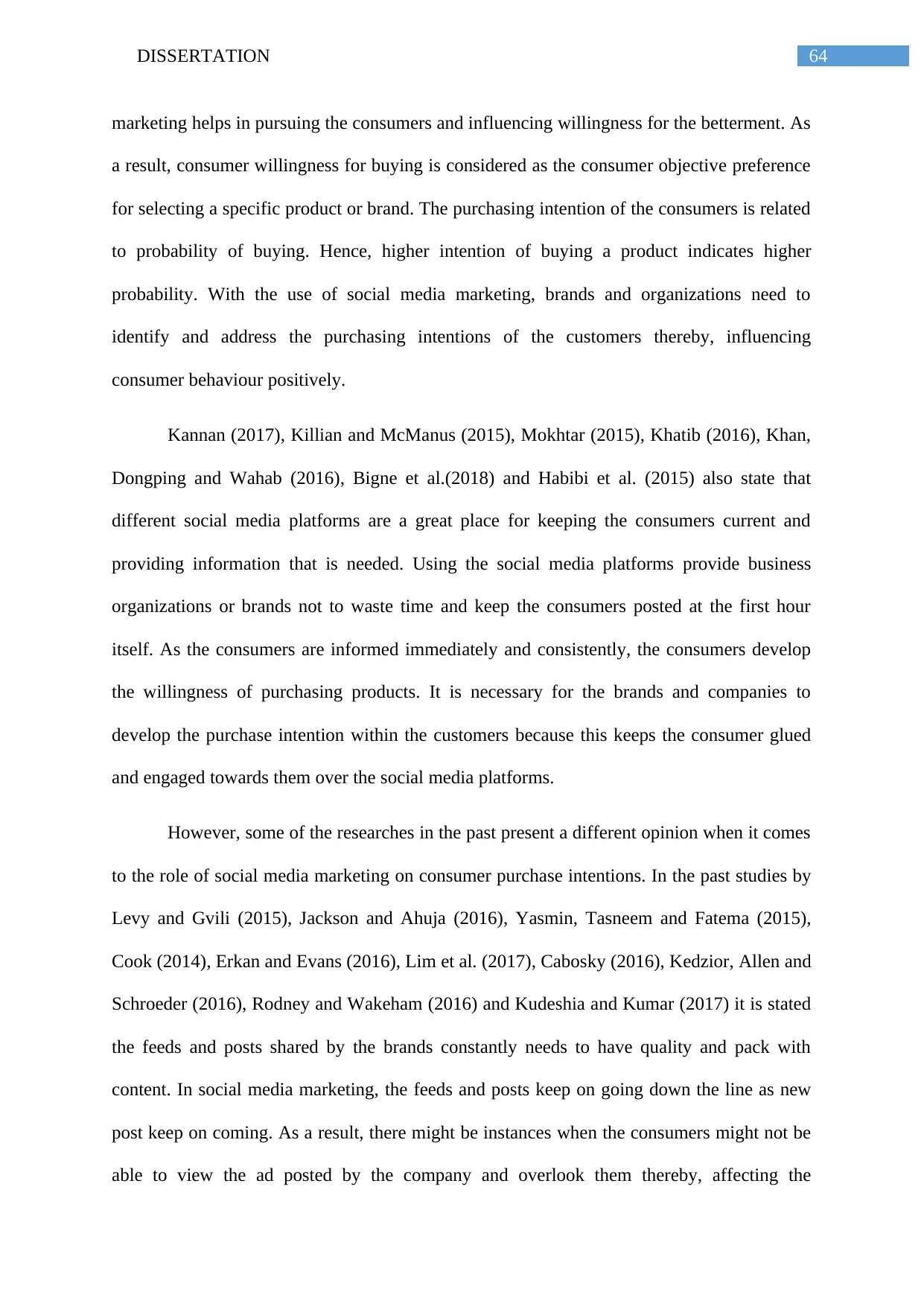
64DISSERTATION
marketing helps in pursuing the consumers and influencing willingness for the betterment. As
a result, consumer willingness for buying is considered as the consumer objective preference
for selecting a specific product or brand. The purchasing intention of the consumers is related
to probability of buying. Hence, higher intention of buying a product indicates higher
probability. With the use of social media marketing, brands and organizations need to
identify and address the purchasing intentions of the customers thereby, influencing
consumer behaviour positively.
Kannan (2017), Killian and McManus (2015), Mokhtar (2015), Khatib (2016), Khan,
Dongping and Wahab (2016), Bigne et al.(2018) and Habibi et al. (2015) also state that
different social media platforms are a great place for keeping the consumers current and
providing information that is needed. Using the social media platforms provide business
organizations or brands not to waste time and keep the consumers posted at the first hour
itself. As the consumers are informed immediately and consistently, the consumers develop
the willingness of purchasing products. It is necessary for the brands and companies to
develop the purchase intention within the customers because this keeps the consumer glued
and engaged towards them over the social media platforms.
However, some of the researches in the past present a different opinion when it comes
to the role of social media marketing on consumer purchase intentions. In the past studies by
Levy and Gvili (2015), Jackson and Ahuja (2016), Yasmin, Tasneem and Fatema (2015),
Cook (2014), Erkan and Evans (2016), Lim et al. (2017), Cabosky (2016), Kedzior, Allen and
Schroeder (2016), Rodney and Wakeham (2016) and Kudeshia and Kumar (2017) it is stated
the feeds and posts shared by the brands constantly needs to have quality and pack with
content. In social media marketing, the feeds and posts keep on going down the line as new
post keep on coming. As a result, there might be instances when the consumers might not be
able to view the ad posted by the company and overlook them thereby, affecting the
marketing helps in pursuing the consumers and influencing willingness for the betterment. As
a result, consumer willingness for buying is considered as the consumer objective preference
for selecting a specific product or brand. The purchasing intention of the consumers is related
to probability of buying. Hence, higher intention of buying a product indicates higher
probability. With the use of social media marketing, brands and organizations need to
identify and address the purchasing intentions of the customers thereby, influencing
consumer behaviour positively.
Kannan (2017), Killian and McManus (2015), Mokhtar (2015), Khatib (2016), Khan,
Dongping and Wahab (2016), Bigne et al.(2018) and Habibi et al. (2015) also state that
different social media platforms are a great place for keeping the consumers current and
providing information that is needed. Using the social media platforms provide business
organizations or brands not to waste time and keep the consumers posted at the first hour
itself. As the consumers are informed immediately and consistently, the consumers develop
the willingness of purchasing products. It is necessary for the brands and companies to
develop the purchase intention within the customers because this keeps the consumer glued
and engaged towards them over the social media platforms.
However, some of the researches in the past present a different opinion when it comes
to the role of social media marketing on consumer purchase intentions. In the past studies by
Levy and Gvili (2015), Jackson and Ahuja (2016), Yasmin, Tasneem and Fatema (2015),
Cook (2014), Erkan and Evans (2016), Lim et al. (2017), Cabosky (2016), Kedzior, Allen and
Schroeder (2016), Rodney and Wakeham (2016) and Kudeshia and Kumar (2017) it is stated
the feeds and posts shared by the brands constantly needs to have quality and pack with
content. In social media marketing, the feeds and posts keep on going down the line as new
post keep on coming. As a result, there might be instances when the consumers might not be
able to view the ad posted by the company and overlook them thereby, affecting the
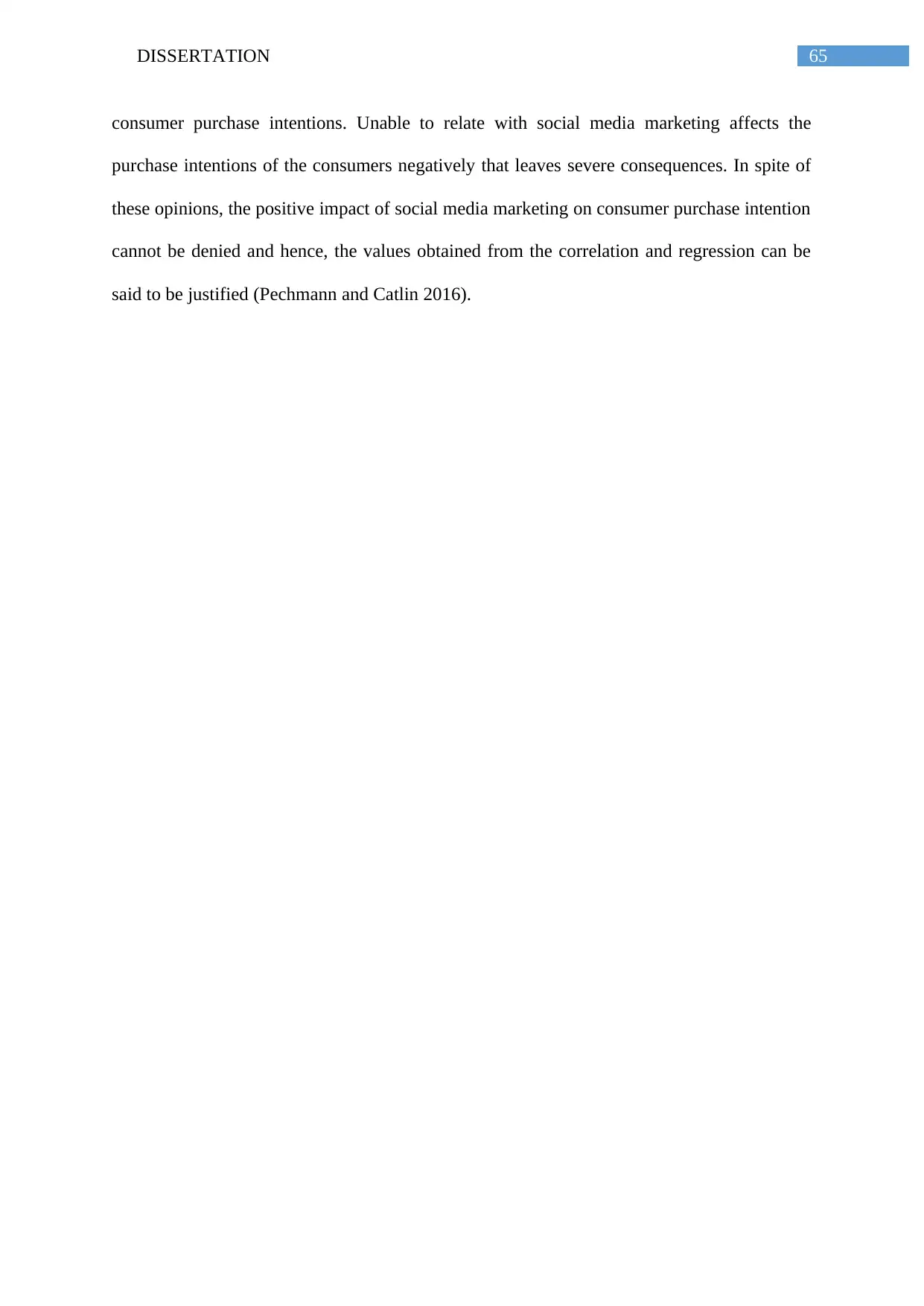
65DISSERTATION
consumer purchase intentions. Unable to relate with social media marketing affects the
purchase intentions of the consumers negatively that leaves severe consequences. In spite of
these opinions, the positive impact of social media marketing on consumer purchase intention
cannot be denied and hence, the values obtained from the correlation and regression can be
said to be justified (Pechmann and Catlin 2016).
consumer purchase intentions. Unable to relate with social media marketing affects the
purchase intentions of the consumers negatively that leaves severe consequences. In spite of
these opinions, the positive impact of social media marketing on consumer purchase intention
cannot be denied and hence, the values obtained from the correlation and regression can be
said to be justified (Pechmann and Catlin 2016).
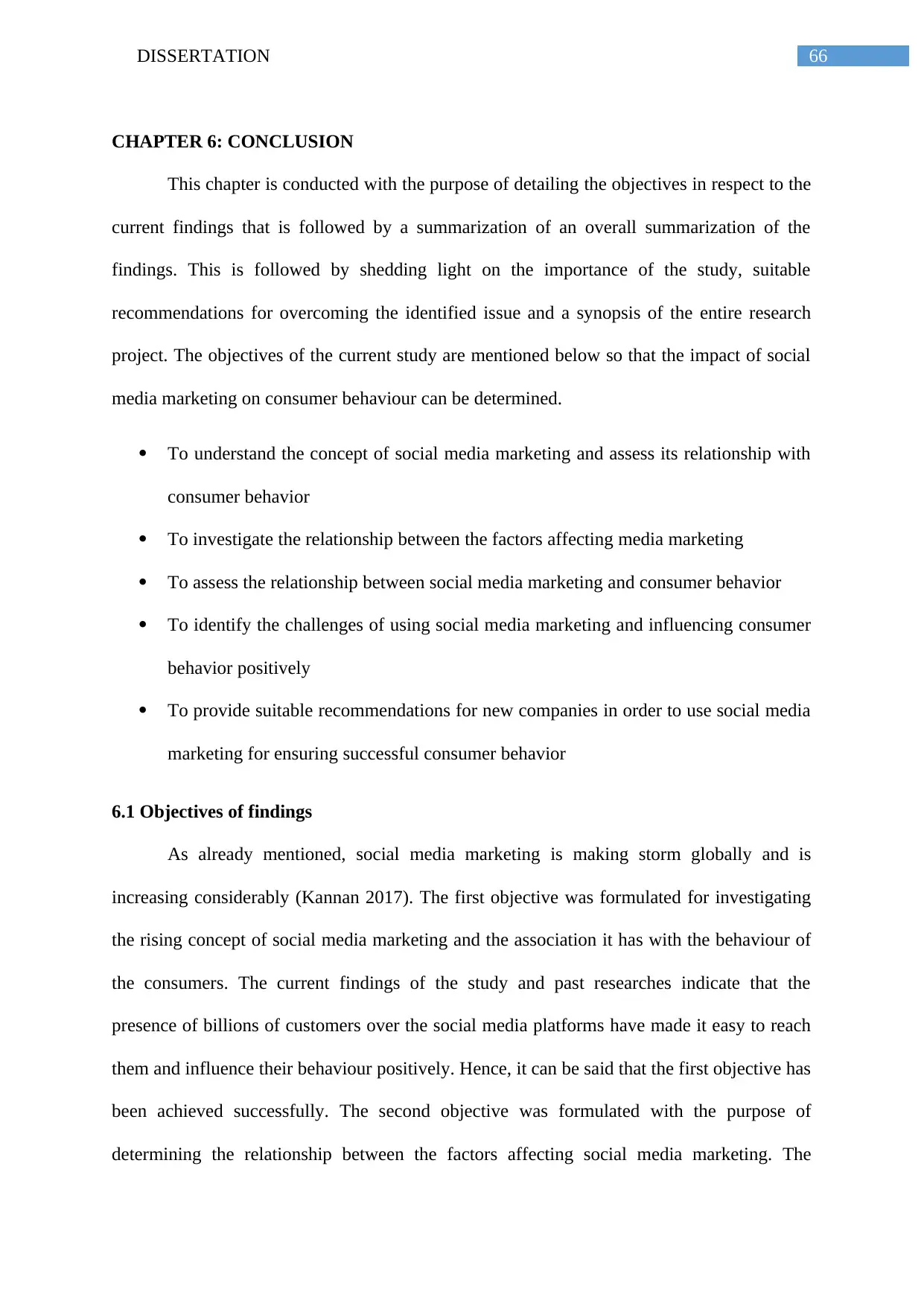
66DISSERTATION
CHAPTER 6: CONCLUSION
This chapter is conducted with the purpose of detailing the objectives in respect to the
current findings that is followed by a summarization of an overall summarization of the
findings. This is followed by shedding light on the importance of the study, suitable
recommendations for overcoming the identified issue and a synopsis of the entire research
project. The objectives of the current study are mentioned below so that the impact of social
media marketing on consumer behaviour can be determined.
To understand the concept of social media marketing and assess its relationship with
consumer behavior
To investigate the relationship between the factors affecting media marketing
To assess the relationship between social media marketing and consumer behavior
To identify the challenges of using social media marketing and influencing consumer
behavior positively
To provide suitable recommendations for new companies in order to use social media
marketing for ensuring successful consumer behavior
6.1 Objectives of findings
As already mentioned, social media marketing is making storm globally and is
increasing considerably (Kannan 2017). The first objective was formulated for investigating
the rising concept of social media marketing and the association it has with the behaviour of
the consumers. The current findings of the study and past researches indicate that the
presence of billions of customers over the social media platforms have made it easy to reach
them and influence their behaviour positively. Hence, it can be said that the first objective has
been achieved successfully. The second objective was formulated with the purpose of
determining the relationship between the factors affecting social media marketing. The
CHAPTER 6: CONCLUSION
This chapter is conducted with the purpose of detailing the objectives in respect to the
current findings that is followed by a summarization of an overall summarization of the
findings. This is followed by shedding light on the importance of the study, suitable
recommendations for overcoming the identified issue and a synopsis of the entire research
project. The objectives of the current study are mentioned below so that the impact of social
media marketing on consumer behaviour can be determined.
To understand the concept of social media marketing and assess its relationship with
consumer behavior
To investigate the relationship between the factors affecting media marketing
To assess the relationship between social media marketing and consumer behavior
To identify the challenges of using social media marketing and influencing consumer
behavior positively
To provide suitable recommendations for new companies in order to use social media
marketing for ensuring successful consumer behavior
6.1 Objectives of findings
As already mentioned, social media marketing is making storm globally and is
increasing considerably (Kannan 2017). The first objective was formulated for investigating
the rising concept of social media marketing and the association it has with the behaviour of
the consumers. The current findings of the study and past researches indicate that the
presence of billions of customers over the social media platforms have made it easy to reach
them and influence their behaviour positively. Hence, it can be said that the first objective has
been achieved successfully. The second objective was formulated with the purpose of
determining the relationship between the factors affecting social media marketing. The
Paraphrase This Document
Need a fresh take? Get an instant paraphrase of this document with our AI Paraphraser
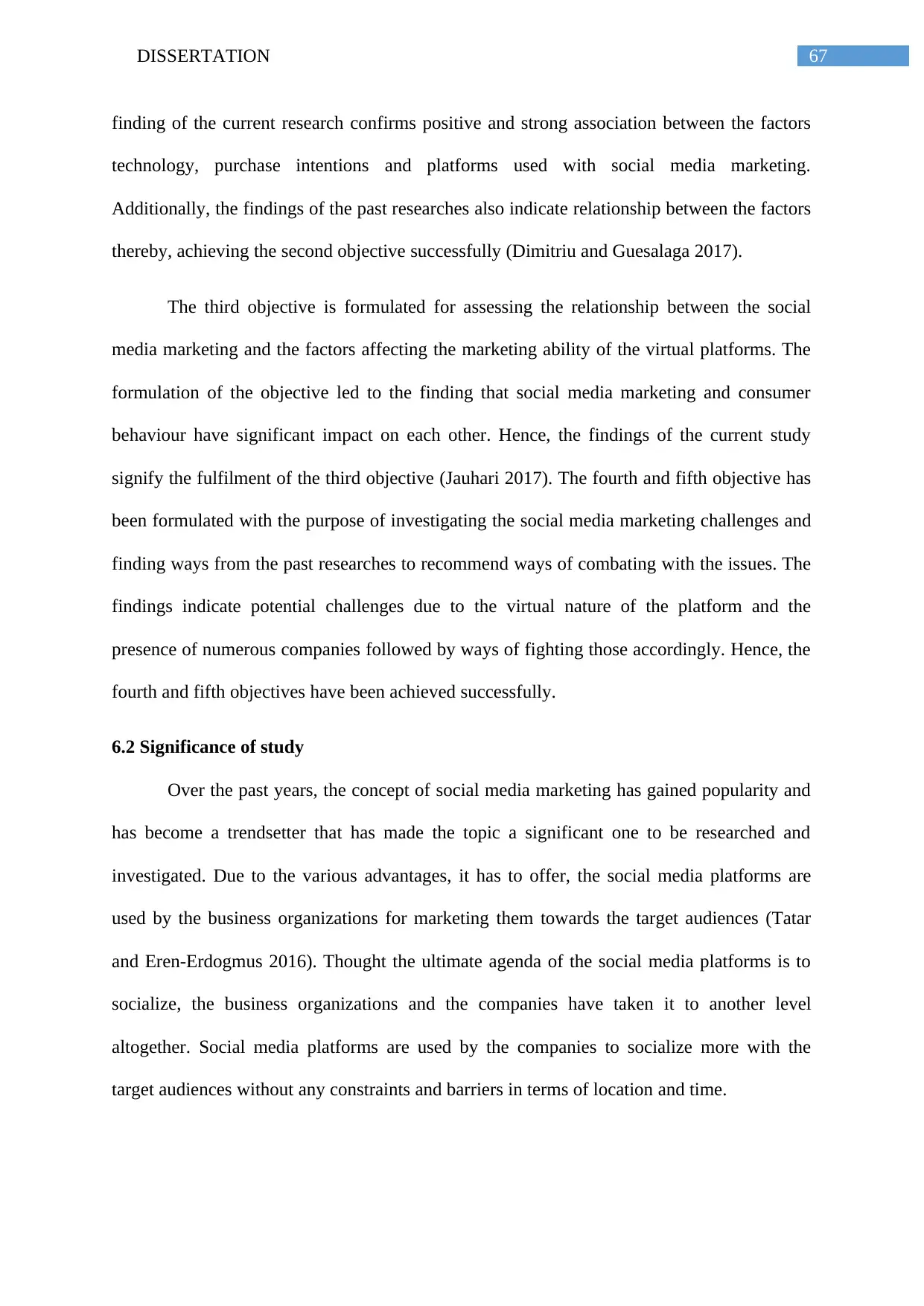
67DISSERTATION
finding of the current research confirms positive and strong association between the factors
technology, purchase intentions and platforms used with social media marketing.
Additionally, the findings of the past researches also indicate relationship between the factors
thereby, achieving the second objective successfully (Dimitriu and Guesalaga 2017).
The third objective is formulated for assessing the relationship between the social
media marketing and the factors affecting the marketing ability of the virtual platforms. The
formulation of the objective led to the finding that social media marketing and consumer
behaviour have significant impact on each other. Hence, the findings of the current study
signify the fulfilment of the third objective (Jauhari 2017). The fourth and fifth objective has
been formulated with the purpose of investigating the social media marketing challenges and
finding ways from the past researches to recommend ways of combating with the issues. The
findings indicate potential challenges due to the virtual nature of the platform and the
presence of numerous companies followed by ways of fighting those accordingly. Hence, the
fourth and fifth objectives have been achieved successfully.
6.2 Significance of study
Over the past years, the concept of social media marketing has gained popularity and
has become a trendsetter that has made the topic a significant one to be researched and
investigated. Due to the various advantages, it has to offer, the social media platforms are
used by the business organizations for marketing them towards the target audiences (Tatar
and Eren-Erdogmus 2016). Thought the ultimate agenda of the social media platforms is to
socialize, the business organizations and the companies have taken it to another level
altogether. Social media platforms are used by the companies to socialize more with the
target audiences without any constraints and barriers in terms of location and time.
finding of the current research confirms positive and strong association between the factors
technology, purchase intentions and platforms used with social media marketing.
Additionally, the findings of the past researches also indicate relationship between the factors
thereby, achieving the second objective successfully (Dimitriu and Guesalaga 2017).
The third objective is formulated for assessing the relationship between the social
media marketing and the factors affecting the marketing ability of the virtual platforms. The
formulation of the objective led to the finding that social media marketing and consumer
behaviour have significant impact on each other. Hence, the findings of the current study
signify the fulfilment of the third objective (Jauhari 2017). The fourth and fifth objective has
been formulated with the purpose of investigating the social media marketing challenges and
finding ways from the past researches to recommend ways of combating with the issues. The
findings indicate potential challenges due to the virtual nature of the platform and the
presence of numerous companies followed by ways of fighting those accordingly. Hence, the
fourth and fifth objectives have been achieved successfully.
6.2 Significance of study
Over the past years, the concept of social media marketing has gained popularity and
has become a trendsetter that has made the topic a significant one to be researched and
investigated. Due to the various advantages, it has to offer, the social media platforms are
used by the business organizations for marketing them towards the target audiences (Tatar
and Eren-Erdogmus 2016). Thought the ultimate agenda of the social media platforms is to
socialize, the business organizations and the companies have taken it to another level
altogether. Social media platforms are used by the companies to socialize more with the
target audiences without any constraints and barriers in terms of location and time.
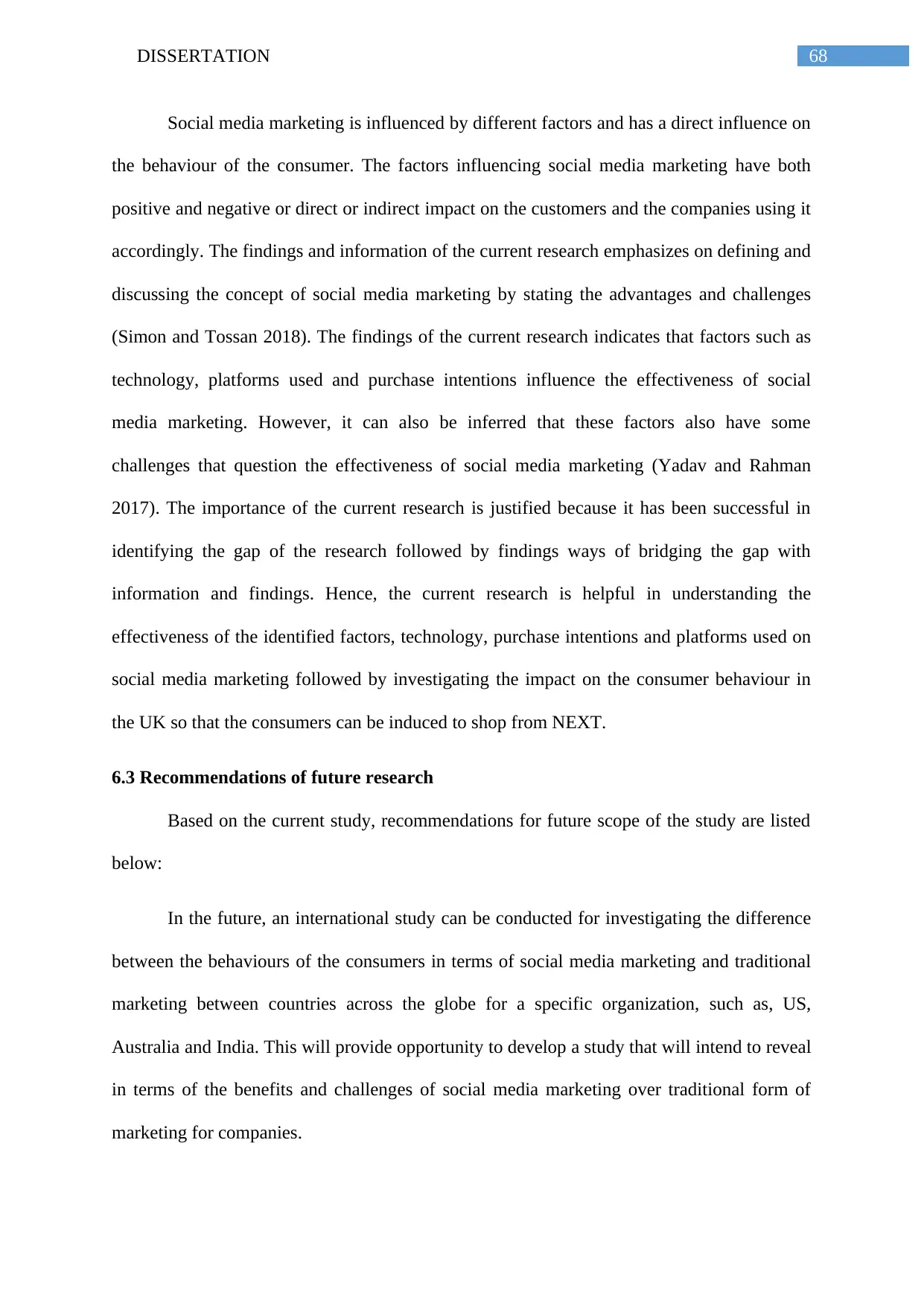
68DISSERTATION
Social media marketing is influenced by different factors and has a direct influence on
the behaviour of the consumer. The factors influencing social media marketing have both
positive and negative or direct or indirect impact on the customers and the companies using it
accordingly. The findings and information of the current research emphasizes on defining and
discussing the concept of social media marketing by stating the advantages and challenges
(Simon and Tossan 2018). The findings of the current research indicates that factors such as
technology, platforms used and purchase intentions influence the effectiveness of social
media marketing. However, it can also be inferred that these factors also have some
challenges that question the effectiveness of social media marketing (Yadav and Rahman
2017). The importance of the current research is justified because it has been successful in
identifying the gap of the research followed by findings ways of bridging the gap with
information and findings. Hence, the current research is helpful in understanding the
effectiveness of the identified factors, technology, purchase intentions and platforms used on
social media marketing followed by investigating the impact on the consumer behaviour in
the UK so that the consumers can be induced to shop from NEXT.
6.3 Recommendations of future research
Based on the current study, recommendations for future scope of the study are listed
below:
In the future, an international study can be conducted for investigating the difference
between the behaviours of the consumers in terms of social media marketing and traditional
marketing between countries across the globe for a specific organization, such as, US,
Australia and India. This will provide opportunity to develop a study that will intend to reveal
in terms of the benefits and challenges of social media marketing over traditional form of
marketing for companies.
Social media marketing is influenced by different factors and has a direct influence on
the behaviour of the consumer. The factors influencing social media marketing have both
positive and negative or direct or indirect impact on the customers and the companies using it
accordingly. The findings and information of the current research emphasizes on defining and
discussing the concept of social media marketing by stating the advantages and challenges
(Simon and Tossan 2018). The findings of the current research indicates that factors such as
technology, platforms used and purchase intentions influence the effectiveness of social
media marketing. However, it can also be inferred that these factors also have some
challenges that question the effectiveness of social media marketing (Yadav and Rahman
2017). The importance of the current research is justified because it has been successful in
identifying the gap of the research followed by findings ways of bridging the gap with
information and findings. Hence, the current research is helpful in understanding the
effectiveness of the identified factors, technology, purchase intentions and platforms used on
social media marketing followed by investigating the impact on the consumer behaviour in
the UK so that the consumers can be induced to shop from NEXT.
6.3 Recommendations of future research
Based on the current study, recommendations for future scope of the study are listed
below:
In the future, an international study can be conducted for investigating the difference
between the behaviours of the consumers in terms of social media marketing and traditional
marketing between countries across the globe for a specific organization, such as, US,
Australia and India. This will provide opportunity to develop a study that will intend to reveal
in terms of the benefits and challenges of social media marketing over traditional form of
marketing for companies.
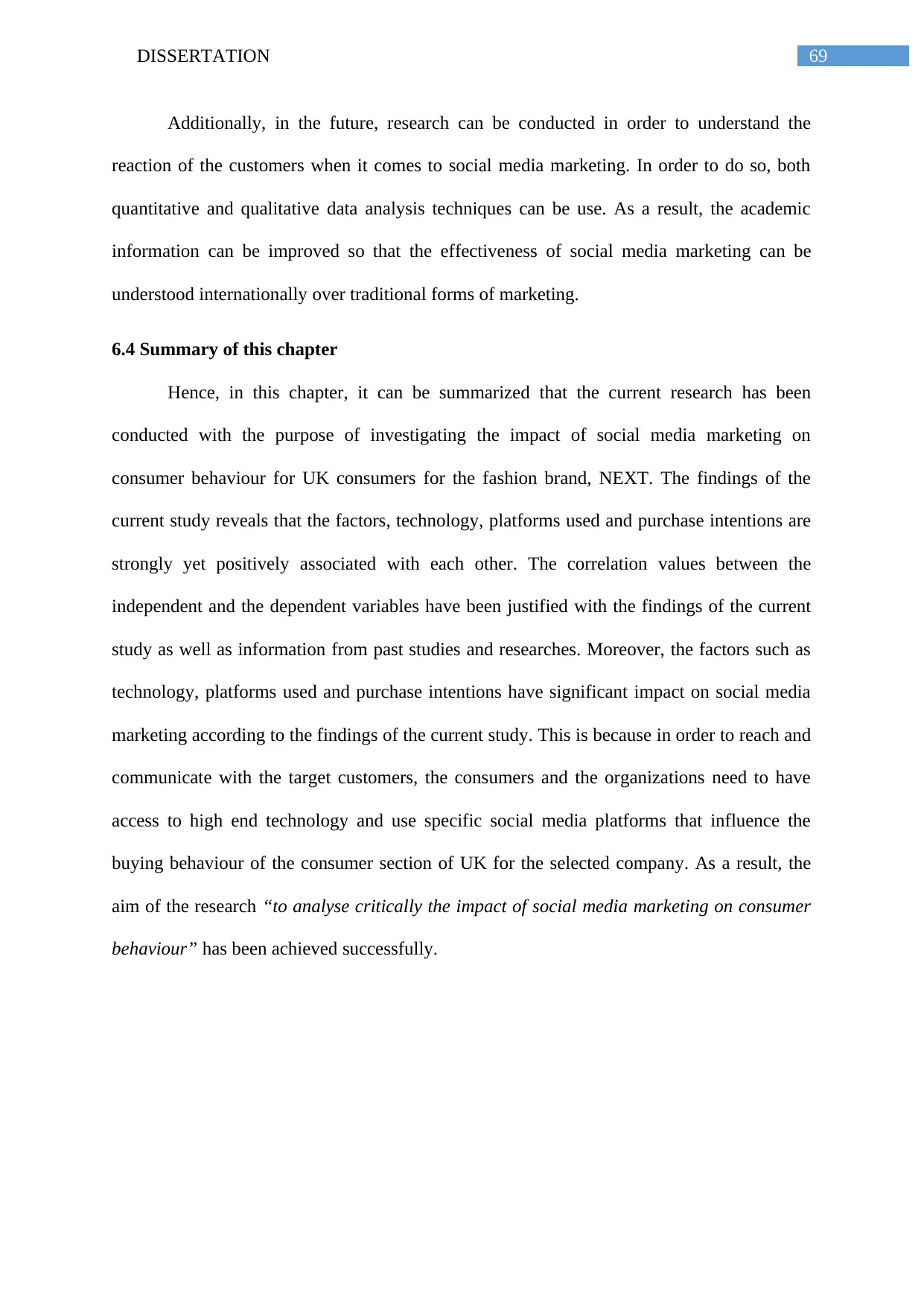
69DISSERTATION
Additionally, in the future, research can be conducted in order to understand the
reaction of the customers when it comes to social media marketing. In order to do so, both
quantitative and qualitative data analysis techniques can be use. As a result, the academic
information can be improved so that the effectiveness of social media marketing can be
understood internationally over traditional forms of marketing.
6.4 Summary of this chapter
Hence, in this chapter, it can be summarized that the current research has been
conducted with the purpose of investigating the impact of social media marketing on
consumer behaviour for UK consumers for the fashion brand, NEXT. The findings of the
current study reveals that the factors, technology, platforms used and purchase intentions are
strongly yet positively associated with each other. The correlation values between the
independent and the dependent variables have been justified with the findings of the current
study as well as information from past studies and researches. Moreover, the factors such as
technology, platforms used and purchase intentions have significant impact on social media
marketing according to the findings of the current study. This is because in order to reach and
communicate with the target customers, the consumers and the organizations need to have
access to high end technology and use specific social media platforms that influence the
buying behaviour of the consumer section of UK for the selected company. As a result, the
aim of the research “to analyse critically the impact of social media marketing on consumer
behaviour” has been achieved successfully.
Additionally, in the future, research can be conducted in order to understand the
reaction of the customers when it comes to social media marketing. In order to do so, both
quantitative and qualitative data analysis techniques can be use. As a result, the academic
information can be improved so that the effectiveness of social media marketing can be
understood internationally over traditional forms of marketing.
6.4 Summary of this chapter
Hence, in this chapter, it can be summarized that the current research has been
conducted with the purpose of investigating the impact of social media marketing on
consumer behaviour for UK consumers for the fashion brand, NEXT. The findings of the
current study reveals that the factors, technology, platforms used and purchase intentions are
strongly yet positively associated with each other. The correlation values between the
independent and the dependent variables have been justified with the findings of the current
study as well as information from past studies and researches. Moreover, the factors such as
technology, platforms used and purchase intentions have significant impact on social media
marketing according to the findings of the current study. This is because in order to reach and
communicate with the target customers, the consumers and the organizations need to have
access to high end technology and use specific social media platforms that influence the
buying behaviour of the consumer section of UK for the selected company. As a result, the
aim of the research “to analyse critically the impact of social media marketing on consumer
behaviour” has been achieved successfully.
Secure Best Marks with AI Grader
Need help grading? Try our AI Grader for instant feedback on your assignments.
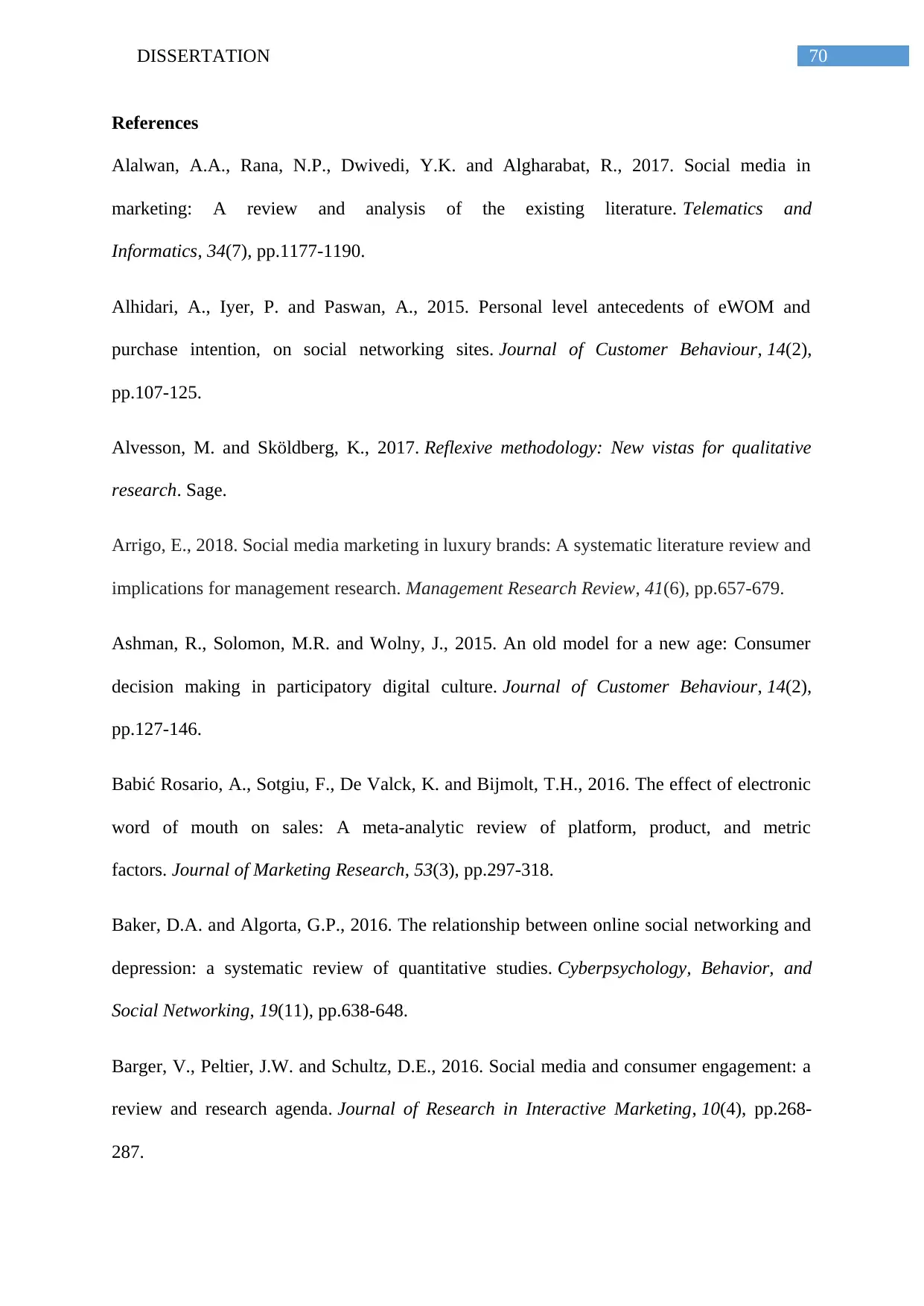
70DISSERTATION
References
Alalwan, A.A., Rana, N.P., Dwivedi, Y.K. and Algharabat, R., 2017. Social media in
marketing: A review and analysis of the existing literature. Telematics and
Informatics, 34(7), pp.1177-1190.
Alhidari, A., Iyer, P. and Paswan, A., 2015. Personal level antecedents of eWOM and
purchase intention, on social networking sites. Journal of Customer Behaviour, 14(2),
pp.107-125.
Alvesson, M. and Sköldberg, K., 2017. Reflexive methodology: New vistas for qualitative
research. Sage.
Arrigo, E., 2018. Social media marketing in luxury brands: A systematic literature review and
implications for management research. Management Research Review, 41(6), pp.657-679.
Ashman, R., Solomon, M.R. and Wolny, J., 2015. An old model for a new age: Consumer
decision making in participatory digital culture. Journal of Customer Behaviour, 14(2),
pp.127-146.
Babić Rosario, A., Sotgiu, F., De Valck, K. and Bijmolt, T.H., 2016. The effect of electronic
word of mouth on sales: A meta-analytic review of platform, product, and metric
factors. Journal of Marketing Research, 53(3), pp.297-318.
Baker, D.A. and Algorta, G.P., 2016. The relationship between online social networking and
depression: a systematic review of quantitative studies. Cyberpsychology, Behavior, and
Social Networking, 19(11), pp.638-648.
Barger, V., Peltier, J.W. and Schultz, D.E., 2016. Social media and consumer engagement: a
review and research agenda. Journal of Research in Interactive Marketing, 10(4), pp.268-
287.
References
Alalwan, A.A., Rana, N.P., Dwivedi, Y.K. and Algharabat, R., 2017. Social media in
marketing: A review and analysis of the existing literature. Telematics and
Informatics, 34(7), pp.1177-1190.
Alhidari, A., Iyer, P. and Paswan, A., 2015. Personal level antecedents of eWOM and
purchase intention, on social networking sites. Journal of Customer Behaviour, 14(2),
pp.107-125.
Alvesson, M. and Sköldberg, K., 2017. Reflexive methodology: New vistas for qualitative
research. Sage.
Arrigo, E., 2018. Social media marketing in luxury brands: A systematic literature review and
implications for management research. Management Research Review, 41(6), pp.657-679.
Ashman, R., Solomon, M.R. and Wolny, J., 2015. An old model for a new age: Consumer
decision making in participatory digital culture. Journal of Customer Behaviour, 14(2),
pp.127-146.
Babić Rosario, A., Sotgiu, F., De Valck, K. and Bijmolt, T.H., 2016. The effect of electronic
word of mouth on sales: A meta-analytic review of platform, product, and metric
factors. Journal of Marketing Research, 53(3), pp.297-318.
Baker, D.A. and Algorta, G.P., 2016. The relationship between online social networking and
depression: a systematic review of quantitative studies. Cyberpsychology, Behavior, and
Social Networking, 19(11), pp.638-648.
Barger, V., Peltier, J.W. and Schultz, D.E., 2016. Social media and consumer engagement: a
review and research agenda. Journal of Research in Interactive Marketing, 10(4), pp.268-
287.
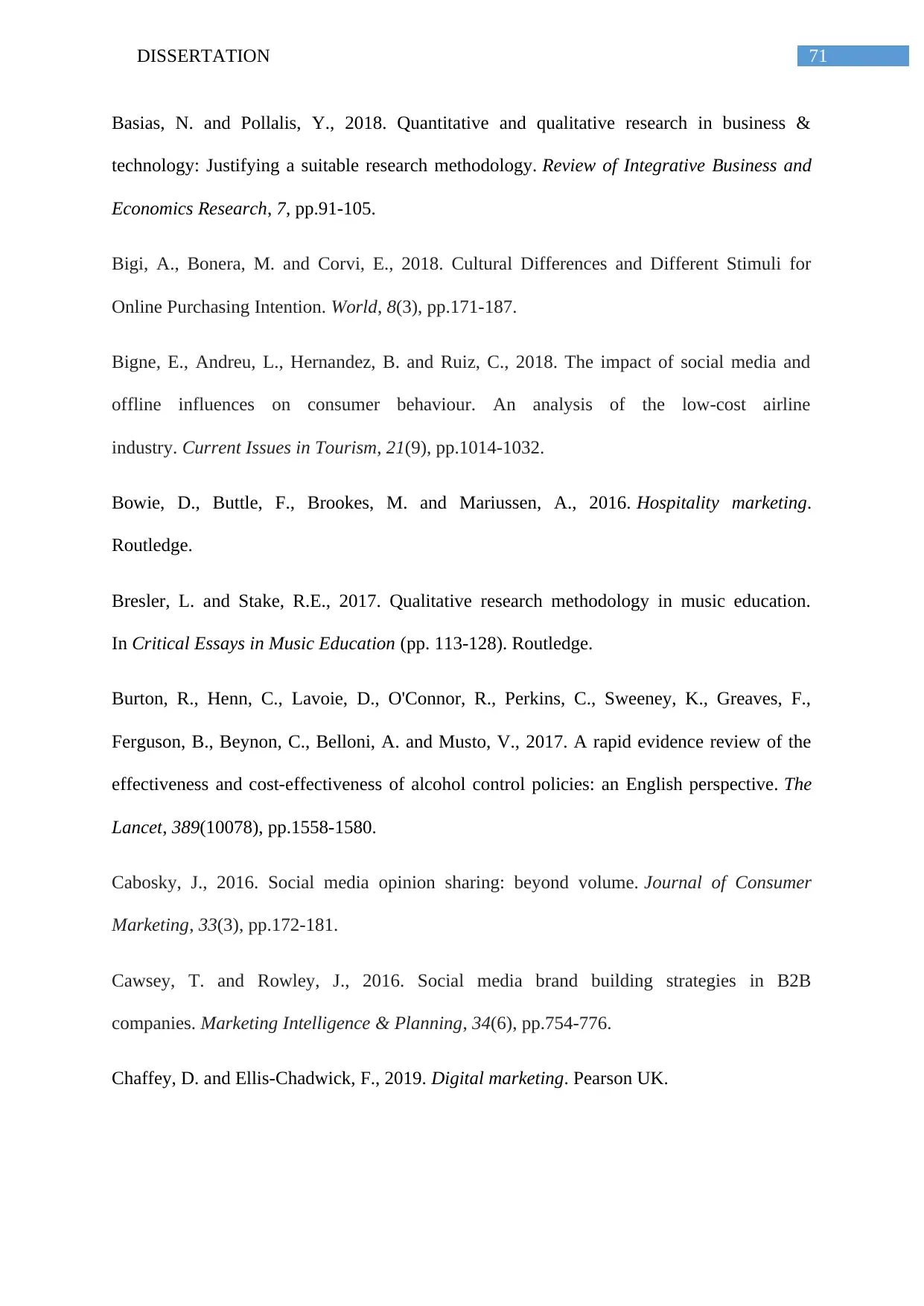
71DISSERTATION
Basias, N. and Pollalis, Y., 2018. Quantitative and qualitative research in business &
technology: Justifying a suitable research methodology. Review of Integrative Business and
Economics Research, 7, pp.91-105.
Bigi, A., Bonera, M. and Corvi, E., 2018. Cultural Differences and Different Stimuli for
Online Purchasing Intention. World, 8(3), pp.171-187.
Bigne, E., Andreu, L., Hernandez, B. and Ruiz, C., 2018. The impact of social media and
offline influences on consumer behaviour. An analysis of the low-cost airline
industry. Current Issues in Tourism, 21(9), pp.1014-1032.
Bowie, D., Buttle, F., Brookes, M. and Mariussen, A., 2016. Hospitality marketing.
Routledge.
Bresler, L. and Stake, R.E., 2017. Qualitative research methodology in music education.
In Critical Essays in Music Education (pp. 113-128). Routledge.
Burton, R., Henn, C., Lavoie, D., O'Connor, R., Perkins, C., Sweeney, K., Greaves, F.,
Ferguson, B., Beynon, C., Belloni, A. and Musto, V., 2017. A rapid evidence review of the
effectiveness and cost-effectiveness of alcohol control policies: an English perspective. The
Lancet, 389(10078), pp.1558-1580.
Cabosky, J., 2016. Social media opinion sharing: beyond volume. Journal of Consumer
Marketing, 33(3), pp.172-181.
Cawsey, T. and Rowley, J., 2016. Social media brand building strategies in B2B
companies. Marketing Intelligence & Planning, 34(6), pp.754-776.
Chaffey, D. and Ellis-Chadwick, F., 2019. Digital marketing. Pearson UK.
Basias, N. and Pollalis, Y., 2018. Quantitative and qualitative research in business &
technology: Justifying a suitable research methodology. Review of Integrative Business and
Economics Research, 7, pp.91-105.
Bigi, A., Bonera, M. and Corvi, E., 2018. Cultural Differences and Different Stimuli for
Online Purchasing Intention. World, 8(3), pp.171-187.
Bigne, E., Andreu, L., Hernandez, B. and Ruiz, C., 2018. The impact of social media and
offline influences on consumer behaviour. An analysis of the low-cost airline
industry. Current Issues in Tourism, 21(9), pp.1014-1032.
Bowie, D., Buttle, F., Brookes, M. and Mariussen, A., 2016. Hospitality marketing.
Routledge.
Bresler, L. and Stake, R.E., 2017. Qualitative research methodology in music education.
In Critical Essays in Music Education (pp. 113-128). Routledge.
Burton, R., Henn, C., Lavoie, D., O'Connor, R., Perkins, C., Sweeney, K., Greaves, F.,
Ferguson, B., Beynon, C., Belloni, A. and Musto, V., 2017. A rapid evidence review of the
effectiveness and cost-effectiveness of alcohol control policies: an English perspective. The
Lancet, 389(10078), pp.1558-1580.
Cabosky, J., 2016. Social media opinion sharing: beyond volume. Journal of Consumer
Marketing, 33(3), pp.172-181.
Cawsey, T. and Rowley, J., 2016. Social media brand building strategies in B2B
companies. Marketing Intelligence & Planning, 34(6), pp.754-776.
Chaffey, D. and Ellis-Chadwick, F., 2019. Digital marketing. Pearson UK.
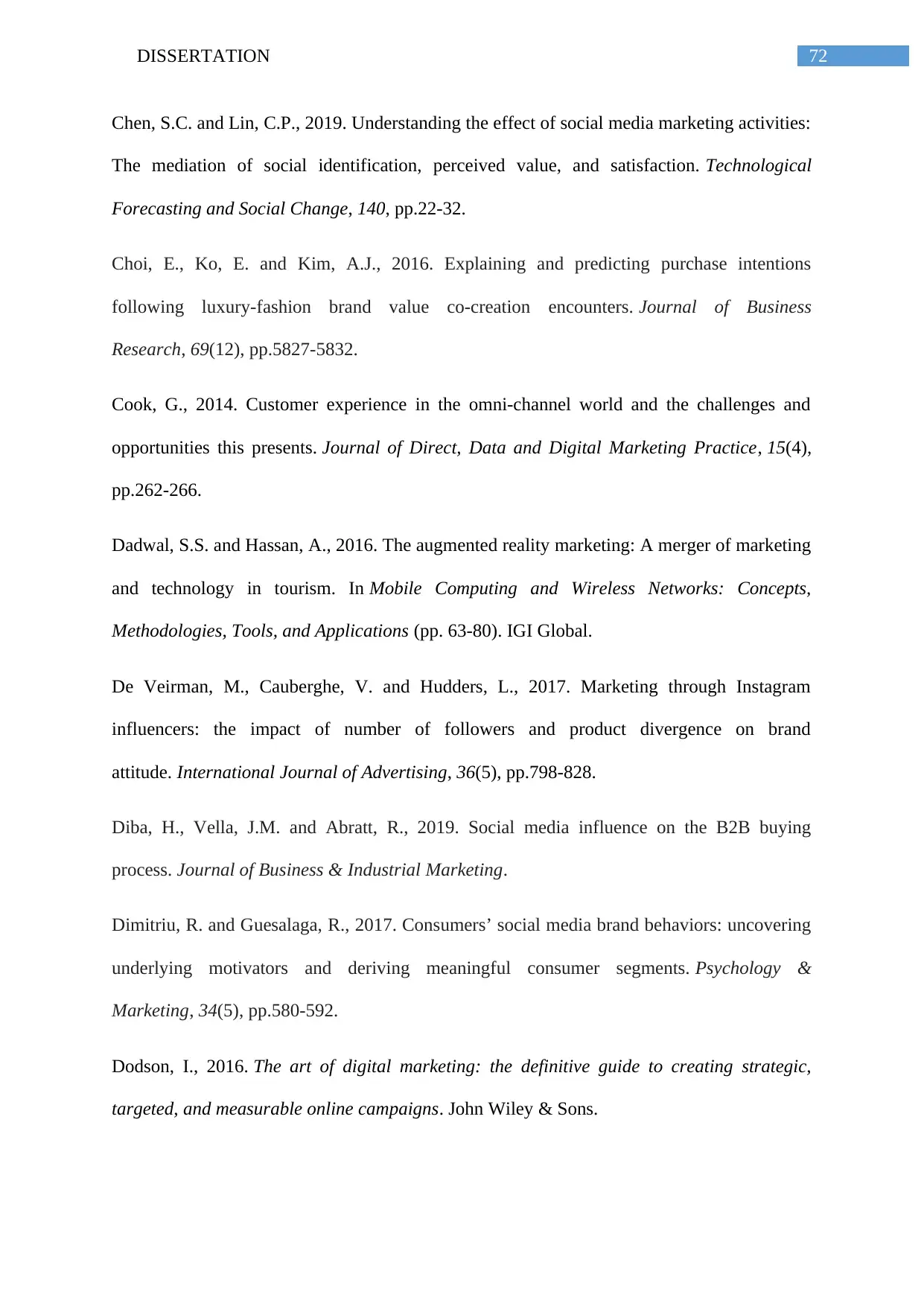
72DISSERTATION
Chen, S.C. and Lin, C.P., 2019. Understanding the effect of social media marketing activities:
The mediation of social identification, perceived value, and satisfaction. Technological
Forecasting and Social Change, 140, pp.22-32.
Choi, E., Ko, E. and Kim, A.J., 2016. Explaining and predicting purchase intentions
following luxury-fashion brand value co-creation encounters. Journal of Business
Research, 69(12), pp.5827-5832.
Cook, G., 2014. Customer experience in the omni-channel world and the challenges and
opportunities this presents. Journal of Direct, Data and Digital Marketing Practice, 15(4),
pp.262-266.
Dadwal, S.S. and Hassan, A., 2016. The augmented reality marketing: A merger of marketing
and technology in tourism. In Mobile Computing and Wireless Networks: Concepts,
Methodologies, Tools, and Applications (pp. 63-80). IGI Global.
De Veirman, M., Cauberghe, V. and Hudders, L., 2017. Marketing through Instagram
influencers: the impact of number of followers and product divergence on brand
attitude. International Journal of Advertising, 36(5), pp.798-828.
Diba, H., Vella, J.M. and Abratt, R., 2019. Social media influence on the B2B buying
process. Journal of Business & Industrial Marketing.
Dimitriu, R. and Guesalaga, R., 2017. Consumers’ social media brand behaviors: uncovering
underlying motivators and deriving meaningful consumer segments. Psychology &
Marketing, 34(5), pp.580-592.
Dodson, I., 2016. The art of digital marketing: the definitive guide to creating strategic,
targeted, and measurable online campaigns. John Wiley & Sons.
Chen, S.C. and Lin, C.P., 2019. Understanding the effect of social media marketing activities:
The mediation of social identification, perceived value, and satisfaction. Technological
Forecasting and Social Change, 140, pp.22-32.
Choi, E., Ko, E. and Kim, A.J., 2016. Explaining and predicting purchase intentions
following luxury-fashion brand value co-creation encounters. Journal of Business
Research, 69(12), pp.5827-5832.
Cook, G., 2014. Customer experience in the omni-channel world and the challenges and
opportunities this presents. Journal of Direct, Data and Digital Marketing Practice, 15(4),
pp.262-266.
Dadwal, S.S. and Hassan, A., 2016. The augmented reality marketing: A merger of marketing
and technology in tourism. In Mobile Computing and Wireless Networks: Concepts,
Methodologies, Tools, and Applications (pp. 63-80). IGI Global.
De Veirman, M., Cauberghe, V. and Hudders, L., 2017. Marketing through Instagram
influencers: the impact of number of followers and product divergence on brand
attitude. International Journal of Advertising, 36(5), pp.798-828.
Diba, H., Vella, J.M. and Abratt, R., 2019. Social media influence on the B2B buying
process. Journal of Business & Industrial Marketing.
Dimitriu, R. and Guesalaga, R., 2017. Consumers’ social media brand behaviors: uncovering
underlying motivators and deriving meaningful consumer segments. Psychology &
Marketing, 34(5), pp.580-592.
Dodson, I., 2016. The art of digital marketing: the definitive guide to creating strategic,
targeted, and measurable online campaigns. John Wiley & Sons.
Paraphrase This Document
Need a fresh take? Get an instant paraphrase of this document with our AI Paraphraser
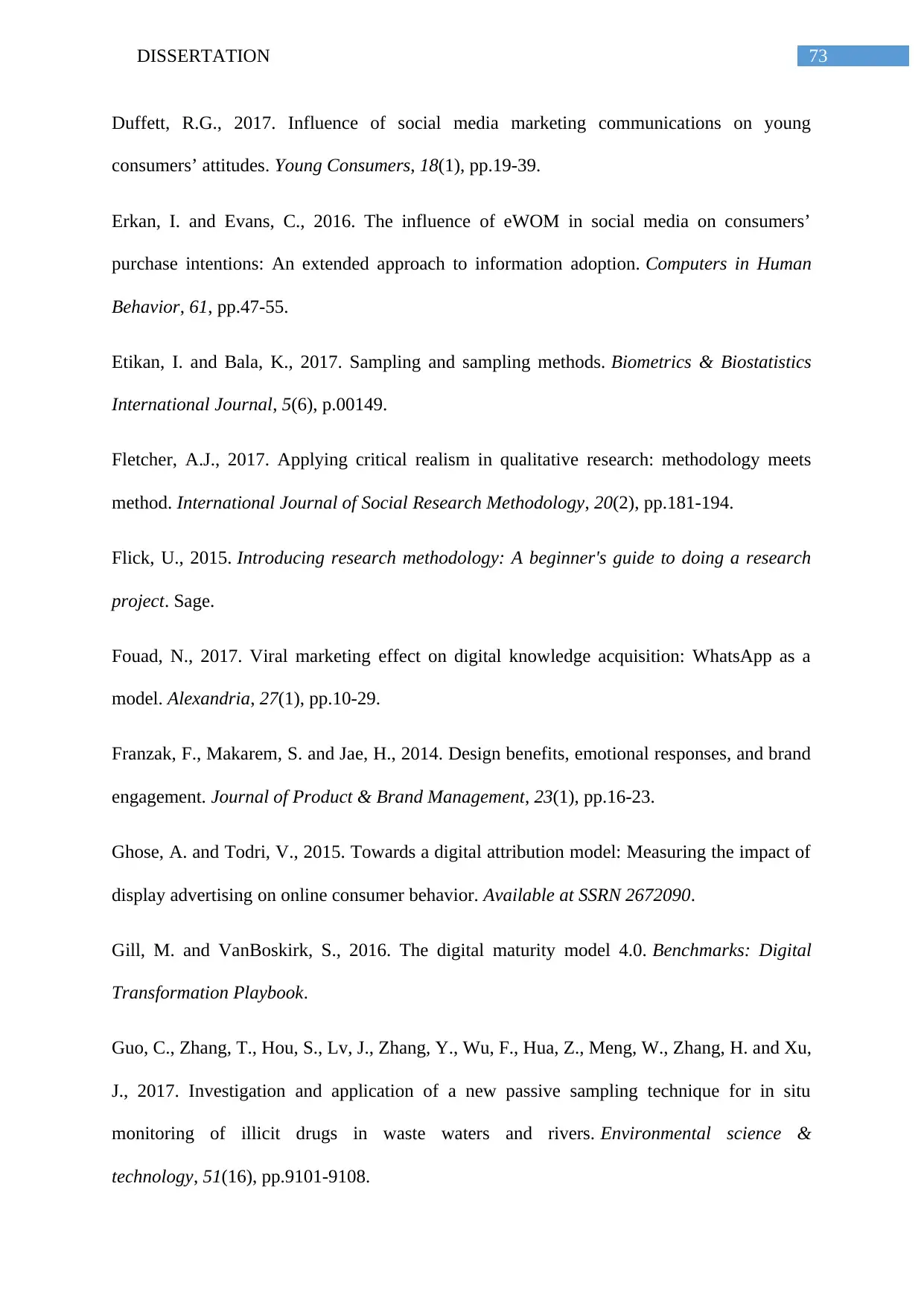
73DISSERTATION
Duffett, R.G., 2017. Influence of social media marketing communications on young
consumers’ attitudes. Young Consumers, 18(1), pp.19-39.
Erkan, I. and Evans, C., 2016. The influence of eWOM in social media on consumers’
purchase intentions: An extended approach to information adoption. Computers in Human
Behavior, 61, pp.47-55.
Etikan, I. and Bala, K., 2017. Sampling and sampling methods. Biometrics & Biostatistics
International Journal, 5(6), p.00149.
Fletcher, A.J., 2017. Applying critical realism in qualitative research: methodology meets
method. International Journal of Social Research Methodology, 20(2), pp.181-194.
Flick, U., 2015. Introducing research methodology: A beginner's guide to doing a research
project. Sage.
Fouad, N., 2017. Viral marketing effect on digital knowledge acquisition: WhatsApp as a
model. Alexandria, 27(1), pp.10-29.
Franzak, F., Makarem, S. and Jae, H., 2014. Design benefits, emotional responses, and brand
engagement. Journal of Product & Brand Management, 23(1), pp.16-23.
Ghose, A. and Todri, V., 2015. Towards a digital attribution model: Measuring the impact of
display advertising on online consumer behavior. Available at SSRN 2672090.
Gill, M. and VanBoskirk, S., 2016. The digital maturity model 4.0. Benchmarks: Digital
Transformation Playbook.
Guo, C., Zhang, T., Hou, S., Lv, J., Zhang, Y., Wu, F., Hua, Z., Meng, W., Zhang, H. and Xu,
J., 2017. Investigation and application of a new passive sampling technique for in situ
monitoring of illicit drugs in waste waters and rivers. Environmental science &
technology, 51(16), pp.9101-9108.
Duffett, R.G., 2017. Influence of social media marketing communications on young
consumers’ attitudes. Young Consumers, 18(1), pp.19-39.
Erkan, I. and Evans, C., 2016. The influence of eWOM in social media on consumers’
purchase intentions: An extended approach to information adoption. Computers in Human
Behavior, 61, pp.47-55.
Etikan, I. and Bala, K., 2017. Sampling and sampling methods. Biometrics & Biostatistics
International Journal, 5(6), p.00149.
Fletcher, A.J., 2017. Applying critical realism in qualitative research: methodology meets
method. International Journal of Social Research Methodology, 20(2), pp.181-194.
Flick, U., 2015. Introducing research methodology: A beginner's guide to doing a research
project. Sage.
Fouad, N., 2017. Viral marketing effect on digital knowledge acquisition: WhatsApp as a
model. Alexandria, 27(1), pp.10-29.
Franzak, F., Makarem, S. and Jae, H., 2014. Design benefits, emotional responses, and brand
engagement. Journal of Product & Brand Management, 23(1), pp.16-23.
Ghose, A. and Todri, V., 2015. Towards a digital attribution model: Measuring the impact of
display advertising on online consumer behavior. Available at SSRN 2672090.
Gill, M. and VanBoskirk, S., 2016. The digital maturity model 4.0. Benchmarks: Digital
Transformation Playbook.
Guo, C., Zhang, T., Hou, S., Lv, J., Zhang, Y., Wu, F., Hua, Z., Meng, W., Zhang, H. and Xu,
J., 2017. Investigation and application of a new passive sampling technique for in situ
monitoring of illicit drugs in waste waters and rivers. Environmental science &
technology, 51(16), pp.9101-9108.
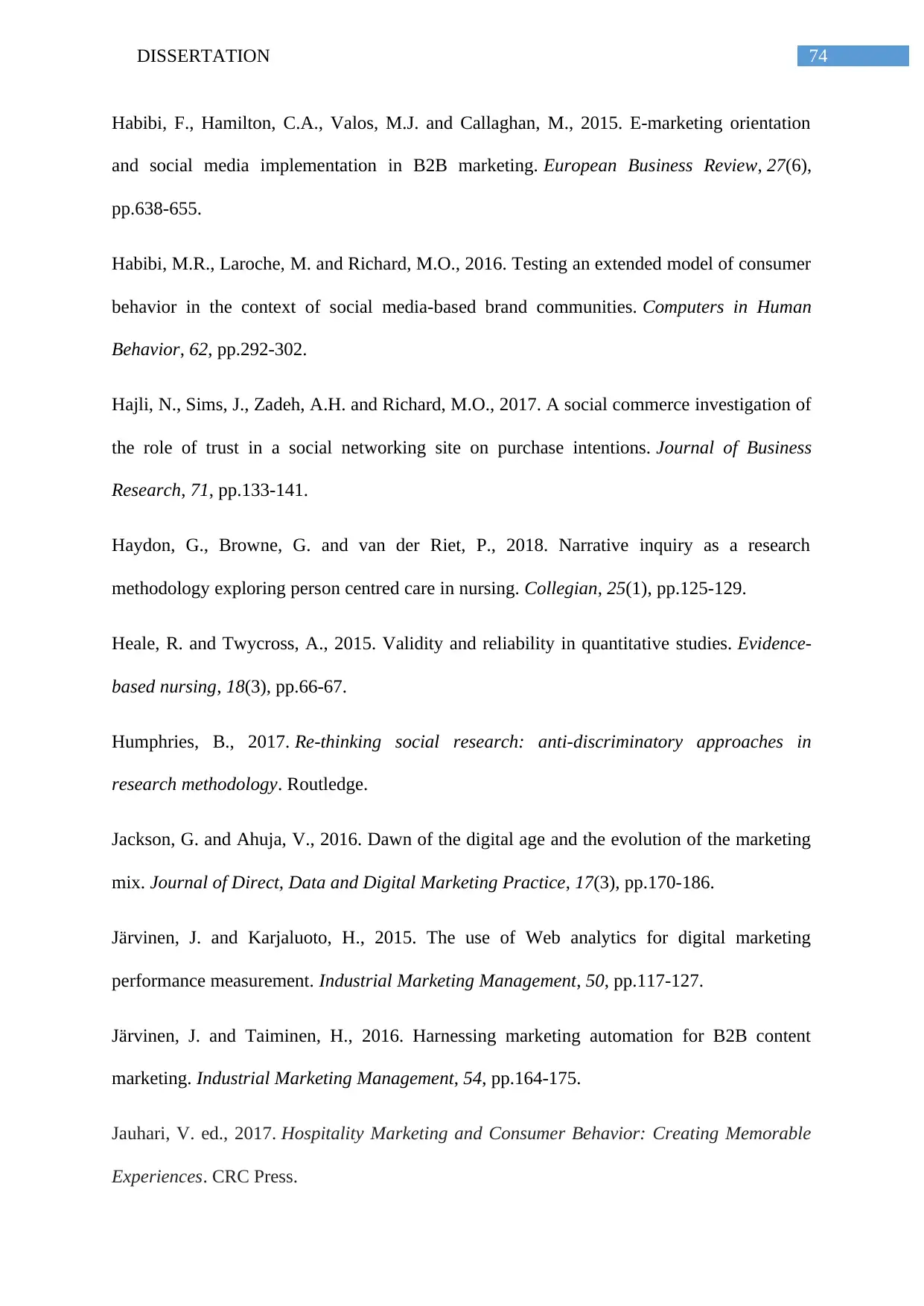
74DISSERTATION
Habibi, F., Hamilton, C.A., Valos, M.J. and Callaghan, M., 2015. E-marketing orientation
and social media implementation in B2B marketing. European Business Review, 27(6),
pp.638-655.
Habibi, M.R., Laroche, M. and Richard, M.O., 2016. Testing an extended model of consumer
behavior in the context of social media-based brand communities. Computers in Human
Behavior, 62, pp.292-302.
Hajli, N., Sims, J., Zadeh, A.H. and Richard, M.O., 2017. A social commerce investigation of
the role of trust in a social networking site on purchase intentions. Journal of Business
Research, 71, pp.133-141.
Haydon, G., Browne, G. and van der Riet, P., 2018. Narrative inquiry as a research
methodology exploring person centred care in nursing. Collegian, 25(1), pp.125-129.
Heale, R. and Twycross, A., 2015. Validity and reliability in quantitative studies. Evidence-
based nursing, 18(3), pp.66-67.
Humphries, B., 2017. Re-thinking social research: anti-discriminatory approaches in
research methodology. Routledge.
Jackson, G. and Ahuja, V., 2016. Dawn of the digital age and the evolution of the marketing
mix. Journal of Direct, Data and Digital Marketing Practice, 17(3), pp.170-186.
Järvinen, J. and Karjaluoto, H., 2015. The use of Web analytics for digital marketing
performance measurement. Industrial Marketing Management, 50, pp.117-127.
Järvinen, J. and Taiminen, H., 2016. Harnessing marketing automation for B2B content
marketing. Industrial Marketing Management, 54, pp.164-175.
Jauhari, V. ed., 2017. Hospitality Marketing and Consumer Behavior: Creating Memorable
Experiences. CRC Press.
Habibi, F., Hamilton, C.A., Valos, M.J. and Callaghan, M., 2015. E-marketing orientation
and social media implementation in B2B marketing. European Business Review, 27(6),
pp.638-655.
Habibi, M.R., Laroche, M. and Richard, M.O., 2016. Testing an extended model of consumer
behavior in the context of social media-based brand communities. Computers in Human
Behavior, 62, pp.292-302.
Hajli, N., Sims, J., Zadeh, A.H. and Richard, M.O., 2017. A social commerce investigation of
the role of trust in a social networking site on purchase intentions. Journal of Business
Research, 71, pp.133-141.
Haydon, G., Browne, G. and van der Riet, P., 2018. Narrative inquiry as a research
methodology exploring person centred care in nursing. Collegian, 25(1), pp.125-129.
Heale, R. and Twycross, A., 2015. Validity and reliability in quantitative studies. Evidence-
based nursing, 18(3), pp.66-67.
Humphries, B., 2017. Re-thinking social research: anti-discriminatory approaches in
research methodology. Routledge.
Jackson, G. and Ahuja, V., 2016. Dawn of the digital age and the evolution of the marketing
mix. Journal of Direct, Data and Digital Marketing Practice, 17(3), pp.170-186.
Järvinen, J. and Karjaluoto, H., 2015. The use of Web analytics for digital marketing
performance measurement. Industrial Marketing Management, 50, pp.117-127.
Järvinen, J. and Taiminen, H., 2016. Harnessing marketing automation for B2B content
marketing. Industrial Marketing Management, 54, pp.164-175.
Jauhari, V. ed., 2017. Hospitality Marketing and Consumer Behavior: Creating Memorable
Experiences. CRC Press.
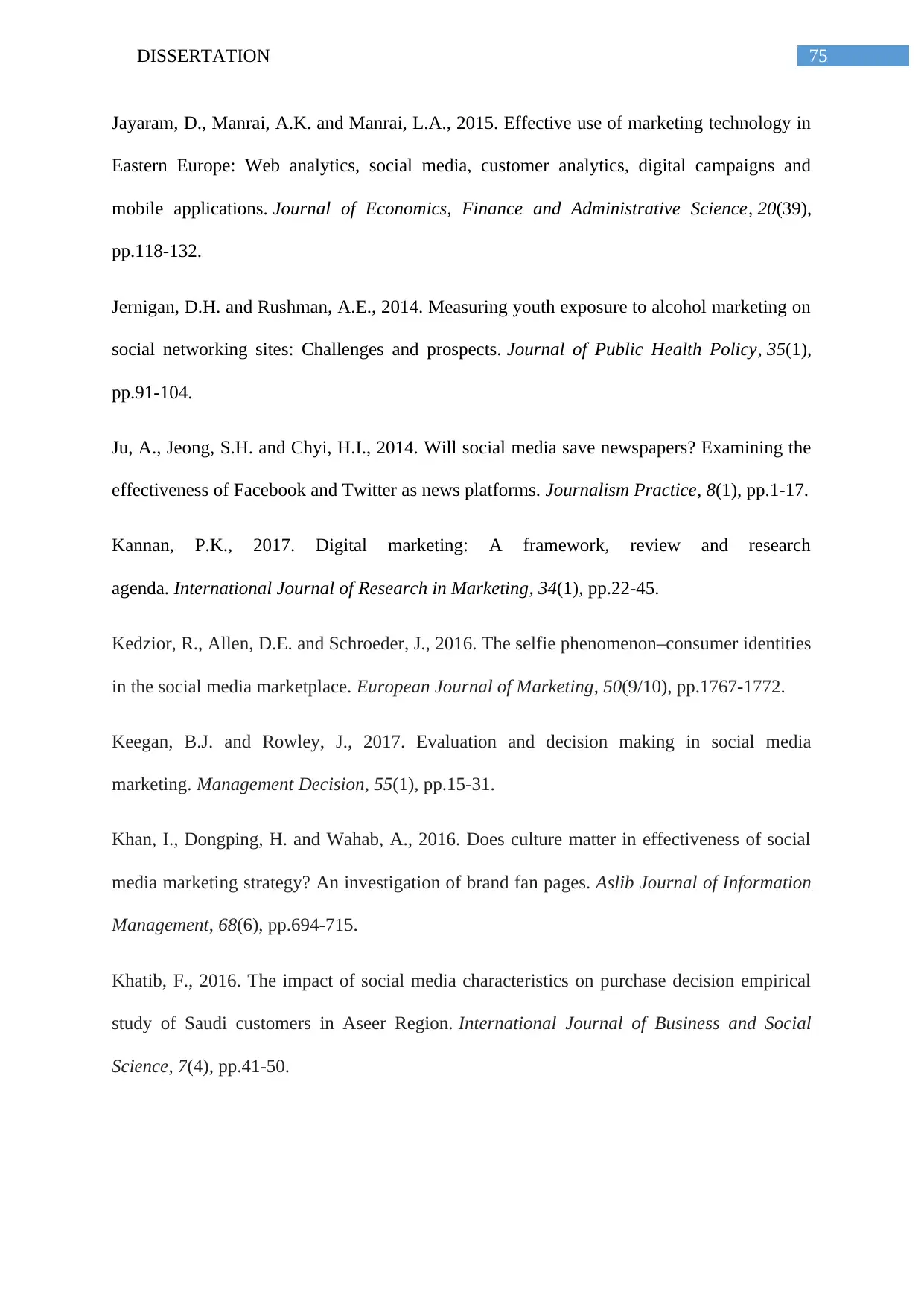
75DISSERTATION
Jayaram, D., Manrai, A.K. and Manrai, L.A., 2015. Effective use of marketing technology in
Eastern Europe: Web analytics, social media, customer analytics, digital campaigns and
mobile applications. Journal of Economics, Finance and Administrative Science, 20(39),
pp.118-132.
Jernigan, D.H. and Rushman, A.E., 2014. Measuring youth exposure to alcohol marketing on
social networking sites: Challenges and prospects. Journal of Public Health Policy, 35(1),
pp.91-104.
Ju, A., Jeong, S.H. and Chyi, H.I., 2014. Will social media save newspapers? Examining the
effectiveness of Facebook and Twitter as news platforms. Journalism Practice, 8(1), pp.1-17.
Kannan, P.K., 2017. Digital marketing: A framework, review and research
agenda. International Journal of Research in Marketing, 34(1), pp.22-45.
Kedzior, R., Allen, D.E. and Schroeder, J., 2016. The selfie phenomenon–consumer identities
in the social media marketplace. European Journal of Marketing, 50(9/10), pp.1767-1772.
Keegan, B.J. and Rowley, J., 2017. Evaluation and decision making in social media
marketing. Management Decision, 55(1), pp.15-31.
Khan, I., Dongping, H. and Wahab, A., 2016. Does culture matter in effectiveness of social
media marketing strategy? An investigation of brand fan pages. Aslib Journal of Information
Management, 68(6), pp.694-715.
Khatib, F., 2016. The impact of social media characteristics on purchase decision empirical
study of Saudi customers in Aseer Region. International Journal of Business and Social
Science, 7(4), pp.41-50.
Jayaram, D., Manrai, A.K. and Manrai, L.A., 2015. Effective use of marketing technology in
Eastern Europe: Web analytics, social media, customer analytics, digital campaigns and
mobile applications. Journal of Economics, Finance and Administrative Science, 20(39),
pp.118-132.
Jernigan, D.H. and Rushman, A.E., 2014. Measuring youth exposure to alcohol marketing on
social networking sites: Challenges and prospects. Journal of Public Health Policy, 35(1),
pp.91-104.
Ju, A., Jeong, S.H. and Chyi, H.I., 2014. Will social media save newspapers? Examining the
effectiveness of Facebook and Twitter as news platforms. Journalism Practice, 8(1), pp.1-17.
Kannan, P.K., 2017. Digital marketing: A framework, review and research
agenda. International Journal of Research in Marketing, 34(1), pp.22-45.
Kedzior, R., Allen, D.E. and Schroeder, J., 2016. The selfie phenomenon–consumer identities
in the social media marketplace. European Journal of Marketing, 50(9/10), pp.1767-1772.
Keegan, B.J. and Rowley, J., 2017. Evaluation and decision making in social media
marketing. Management Decision, 55(1), pp.15-31.
Khan, I., Dongping, H. and Wahab, A., 2016. Does culture matter in effectiveness of social
media marketing strategy? An investigation of brand fan pages. Aslib Journal of Information
Management, 68(6), pp.694-715.
Khatib, F., 2016. The impact of social media characteristics on purchase decision empirical
study of Saudi customers in Aseer Region. International Journal of Business and Social
Science, 7(4), pp.41-50.
Secure Best Marks with AI Grader
Need help grading? Try our AI Grader for instant feedback on your assignments.
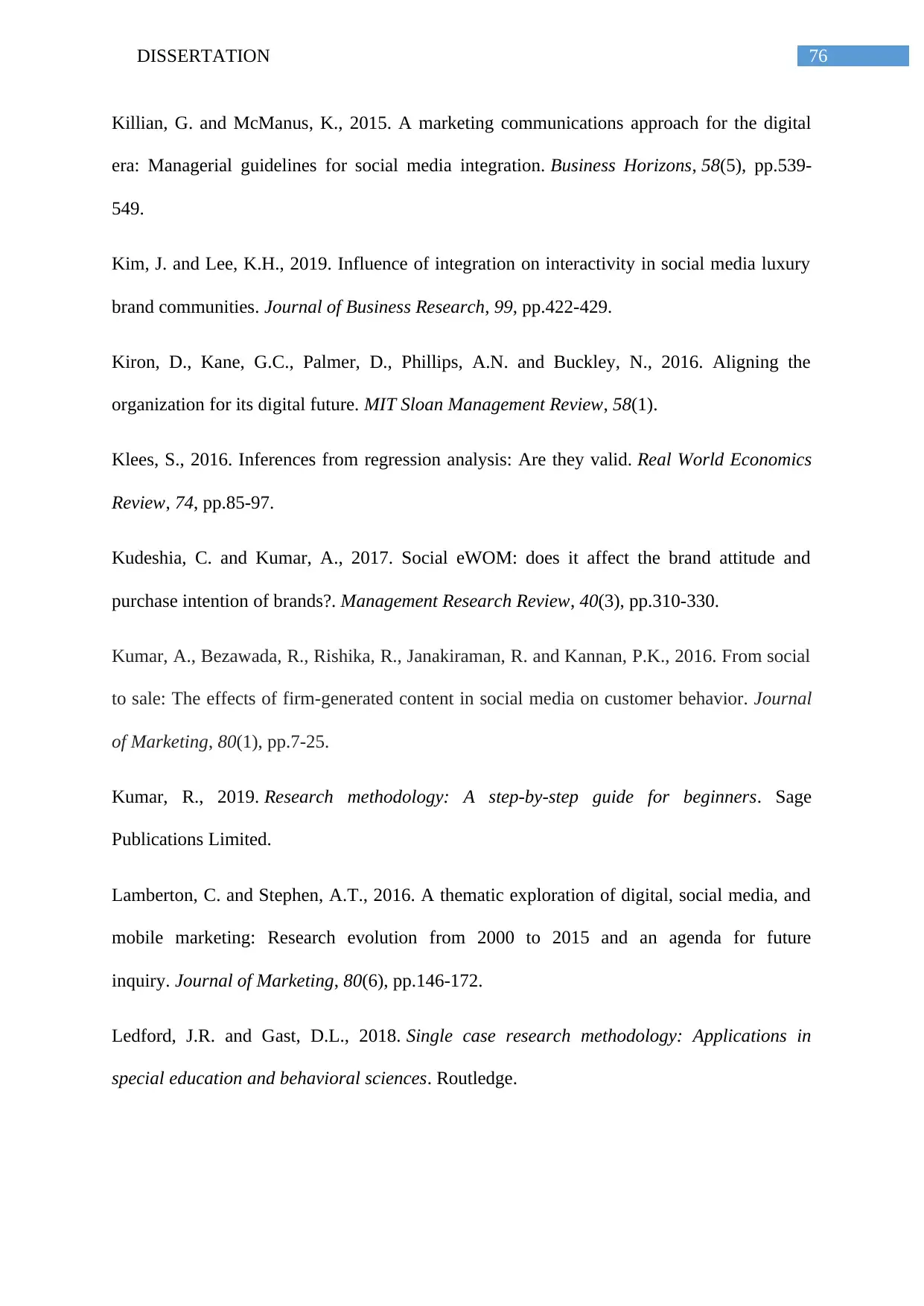
76DISSERTATION
Killian, G. and McManus, K., 2015. A marketing communications approach for the digital
era: Managerial guidelines for social media integration. Business Horizons, 58(5), pp.539-
549.
Kim, J. and Lee, K.H., 2019. Influence of integration on interactivity in social media luxury
brand communities. Journal of Business Research, 99, pp.422-429.
Kiron, D., Kane, G.C., Palmer, D., Phillips, A.N. and Buckley, N., 2016. Aligning the
organization for its digital future. MIT Sloan Management Review, 58(1).
Klees, S., 2016. Inferences from regression analysis: Are they valid. Real World Economics
Review, 74, pp.85-97.
Kudeshia, C. and Kumar, A., 2017. Social eWOM: does it affect the brand attitude and
purchase intention of brands?. Management Research Review, 40(3), pp.310-330.
Kumar, A., Bezawada, R., Rishika, R., Janakiraman, R. and Kannan, P.K., 2016. From social
to sale: The effects of firm-generated content in social media on customer behavior. Journal
of Marketing, 80(1), pp.7-25.
Kumar, R., 2019. Research methodology: A step-by-step guide for beginners. Sage
Publications Limited.
Lamberton, C. and Stephen, A.T., 2016. A thematic exploration of digital, social media, and
mobile marketing: Research evolution from 2000 to 2015 and an agenda for future
inquiry. Journal of Marketing, 80(6), pp.146-172.
Ledford, J.R. and Gast, D.L., 2018. Single case research methodology: Applications in
special education and behavioral sciences. Routledge.
Killian, G. and McManus, K., 2015. A marketing communications approach for the digital
era: Managerial guidelines for social media integration. Business Horizons, 58(5), pp.539-
549.
Kim, J. and Lee, K.H., 2019. Influence of integration on interactivity in social media luxury
brand communities. Journal of Business Research, 99, pp.422-429.
Kiron, D., Kane, G.C., Palmer, D., Phillips, A.N. and Buckley, N., 2016. Aligning the
organization for its digital future. MIT Sloan Management Review, 58(1).
Klees, S., 2016. Inferences from regression analysis: Are they valid. Real World Economics
Review, 74, pp.85-97.
Kudeshia, C. and Kumar, A., 2017. Social eWOM: does it affect the brand attitude and
purchase intention of brands?. Management Research Review, 40(3), pp.310-330.
Kumar, A., Bezawada, R., Rishika, R., Janakiraman, R. and Kannan, P.K., 2016. From social
to sale: The effects of firm-generated content in social media on customer behavior. Journal
of Marketing, 80(1), pp.7-25.
Kumar, R., 2019. Research methodology: A step-by-step guide for beginners. Sage
Publications Limited.
Lamberton, C. and Stephen, A.T., 2016. A thematic exploration of digital, social media, and
mobile marketing: Research evolution from 2000 to 2015 and an agenda for future
inquiry. Journal of Marketing, 80(6), pp.146-172.
Ledford, J.R. and Gast, D.L., 2018. Single case research methodology: Applications in
special education and behavioral sciences. Routledge.
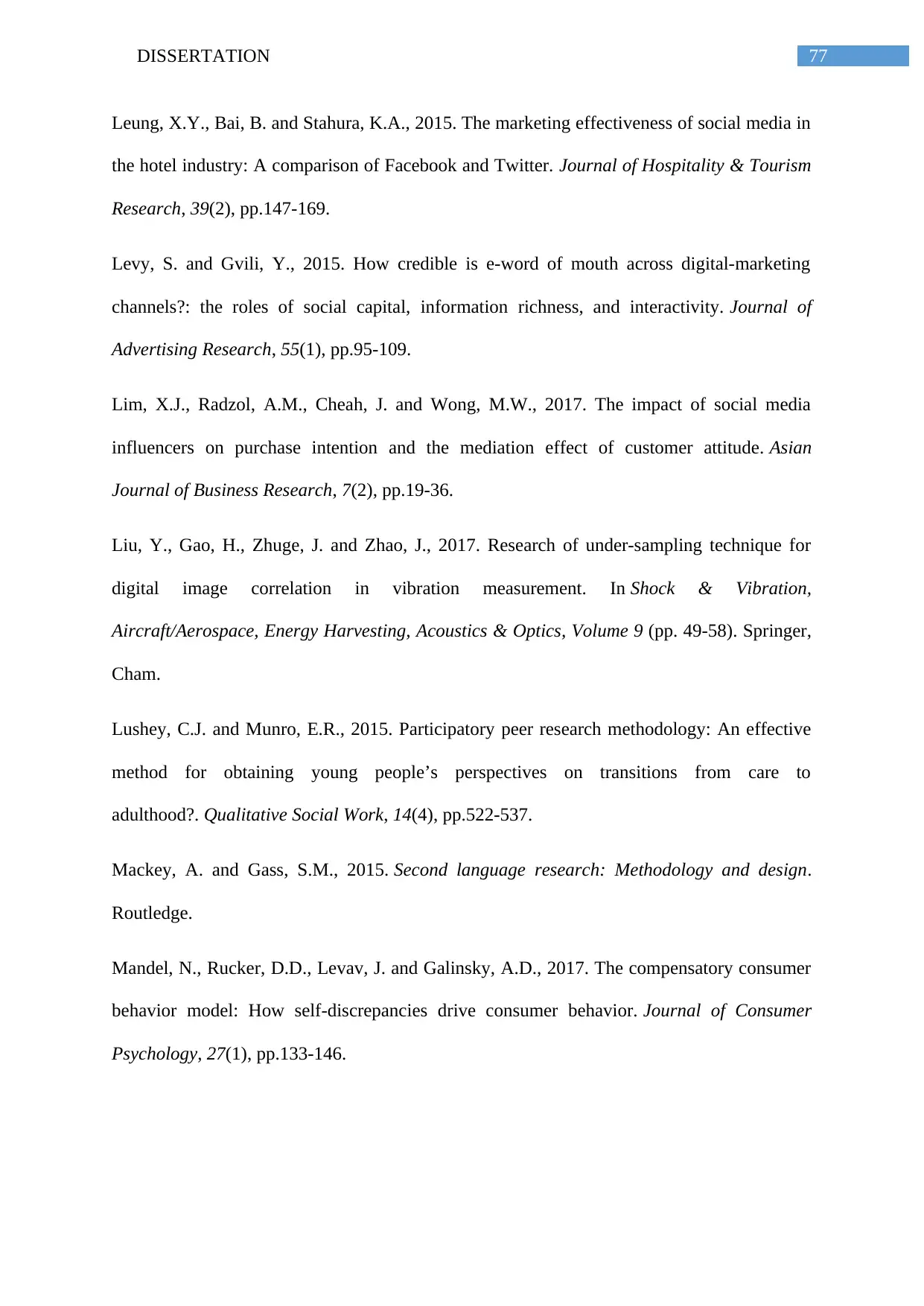
77DISSERTATION
Leung, X.Y., Bai, B. and Stahura, K.A., 2015. The marketing effectiveness of social media in
the hotel industry: A comparison of Facebook and Twitter. Journal of Hospitality & Tourism
Research, 39(2), pp.147-169.
Levy, S. and Gvili, Y., 2015. How credible is e-word of mouth across digital-marketing
channels?: the roles of social capital, information richness, and interactivity. Journal of
Advertising Research, 55(1), pp.95-109.
Lim, X.J., Radzol, A.M., Cheah, J. and Wong, M.W., 2017. The impact of social media
influencers on purchase intention and the mediation effect of customer attitude. Asian
Journal of Business Research, 7(2), pp.19-36.
Liu, Y., Gao, H., Zhuge, J. and Zhao, J., 2017. Research of under-sampling technique for
digital image correlation in vibration measurement. In Shock & Vibration,
Aircraft/Aerospace, Energy Harvesting, Acoustics & Optics, Volume 9 (pp. 49-58). Springer,
Cham.
Lushey, C.J. and Munro, E.R., 2015. Participatory peer research methodology: An effective
method for obtaining young people’s perspectives on transitions from care to
adulthood?. Qualitative Social Work, 14(4), pp.522-537.
Mackey, A. and Gass, S.M., 2015. Second language research: Methodology and design.
Routledge.
Mandel, N., Rucker, D.D., Levav, J. and Galinsky, A.D., 2017. The compensatory consumer
behavior model: How self-discrepancies drive consumer behavior. Journal of Consumer
Psychology, 27(1), pp.133-146.
Leung, X.Y., Bai, B. and Stahura, K.A., 2015. The marketing effectiveness of social media in
the hotel industry: A comparison of Facebook and Twitter. Journal of Hospitality & Tourism
Research, 39(2), pp.147-169.
Levy, S. and Gvili, Y., 2015. How credible is e-word of mouth across digital-marketing
channels?: the roles of social capital, information richness, and interactivity. Journal of
Advertising Research, 55(1), pp.95-109.
Lim, X.J., Radzol, A.M., Cheah, J. and Wong, M.W., 2017. The impact of social media
influencers on purchase intention and the mediation effect of customer attitude. Asian
Journal of Business Research, 7(2), pp.19-36.
Liu, Y., Gao, H., Zhuge, J. and Zhao, J., 2017. Research of under-sampling technique for
digital image correlation in vibration measurement. In Shock & Vibration,
Aircraft/Aerospace, Energy Harvesting, Acoustics & Optics, Volume 9 (pp. 49-58). Springer,
Cham.
Lushey, C.J. and Munro, E.R., 2015. Participatory peer research methodology: An effective
method for obtaining young people’s perspectives on transitions from care to
adulthood?. Qualitative Social Work, 14(4), pp.522-537.
Mackey, A. and Gass, S.M., 2015. Second language research: Methodology and design.
Routledge.
Mandel, N., Rucker, D.D., Levav, J. and Galinsky, A.D., 2017. The compensatory consumer
behavior model: How self-discrepancies drive consumer behavior. Journal of Consumer
Psychology, 27(1), pp.133-146.
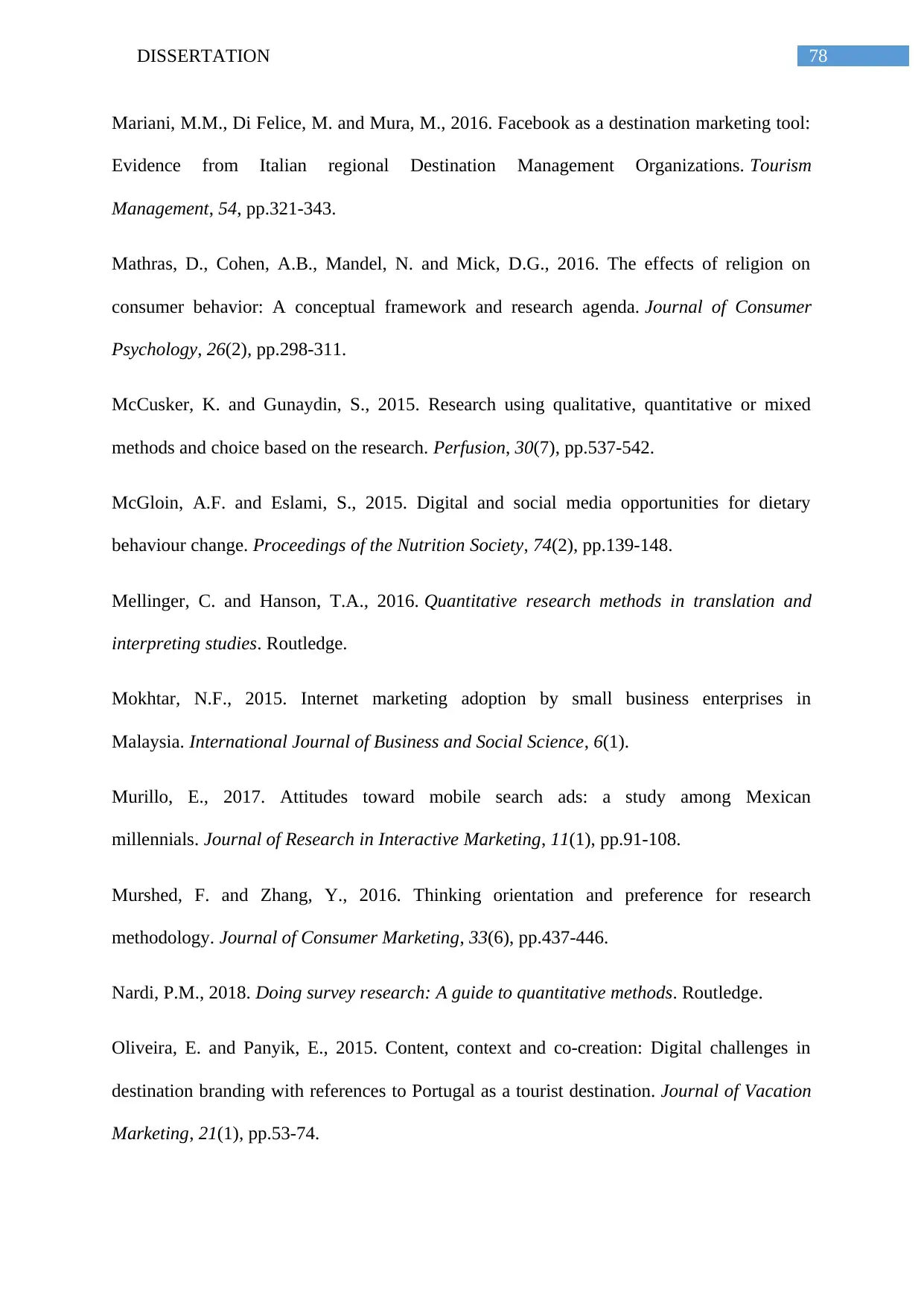
78DISSERTATION
Mariani, M.M., Di Felice, M. and Mura, M., 2016. Facebook as a destination marketing tool:
Evidence from Italian regional Destination Management Organizations. Tourism
Management, 54, pp.321-343.
Mathras, D., Cohen, A.B., Mandel, N. and Mick, D.G., 2016. The effects of religion on
consumer behavior: A conceptual framework and research agenda. Journal of Consumer
Psychology, 26(2), pp.298-311.
McCusker, K. and Gunaydin, S., 2015. Research using qualitative, quantitative or mixed
methods and choice based on the research. Perfusion, 30(7), pp.537-542.
McGloin, A.F. and Eslami, S., 2015. Digital and social media opportunities for dietary
behaviour change. Proceedings of the Nutrition Society, 74(2), pp.139-148.
Mellinger, C. and Hanson, T.A., 2016. Quantitative research methods in translation and
interpreting studies. Routledge.
Mokhtar, N.F., 2015. Internet marketing adoption by small business enterprises in
Malaysia. International Journal of Business and Social Science, 6(1).
Murillo, E., 2017. Attitudes toward mobile search ads: a study among Mexican
millennials. Journal of Research in Interactive Marketing, 11(1), pp.91-108.
Murshed, F. and Zhang, Y., 2016. Thinking orientation and preference for research
methodology. Journal of Consumer Marketing, 33(6), pp.437-446.
Nardi, P.M., 2018. Doing survey research: A guide to quantitative methods. Routledge.
Oliveira, E. and Panyik, E., 2015. Content, context and co-creation: Digital challenges in
destination branding with references to Portugal as a tourist destination. Journal of Vacation
Marketing, 21(1), pp.53-74.
Mariani, M.M., Di Felice, M. and Mura, M., 2016. Facebook as a destination marketing tool:
Evidence from Italian regional Destination Management Organizations. Tourism
Management, 54, pp.321-343.
Mathras, D., Cohen, A.B., Mandel, N. and Mick, D.G., 2016. The effects of religion on
consumer behavior: A conceptual framework and research agenda. Journal of Consumer
Psychology, 26(2), pp.298-311.
McCusker, K. and Gunaydin, S., 2015. Research using qualitative, quantitative or mixed
methods and choice based on the research. Perfusion, 30(7), pp.537-542.
McGloin, A.F. and Eslami, S., 2015. Digital and social media opportunities for dietary
behaviour change. Proceedings of the Nutrition Society, 74(2), pp.139-148.
Mellinger, C. and Hanson, T.A., 2016. Quantitative research methods in translation and
interpreting studies. Routledge.
Mokhtar, N.F., 2015. Internet marketing adoption by small business enterprises in
Malaysia. International Journal of Business and Social Science, 6(1).
Murillo, E., 2017. Attitudes toward mobile search ads: a study among Mexican
millennials. Journal of Research in Interactive Marketing, 11(1), pp.91-108.
Murshed, F. and Zhang, Y., 2016. Thinking orientation and preference for research
methodology. Journal of Consumer Marketing, 33(6), pp.437-446.
Nardi, P.M., 2018. Doing survey research: A guide to quantitative methods. Routledge.
Oliveira, E. and Panyik, E., 2015. Content, context and co-creation: Digital challenges in
destination branding with references to Portugal as a tourist destination. Journal of Vacation
Marketing, 21(1), pp.53-74.
Paraphrase This Document
Need a fresh take? Get an instant paraphrase of this document with our AI Paraphraser
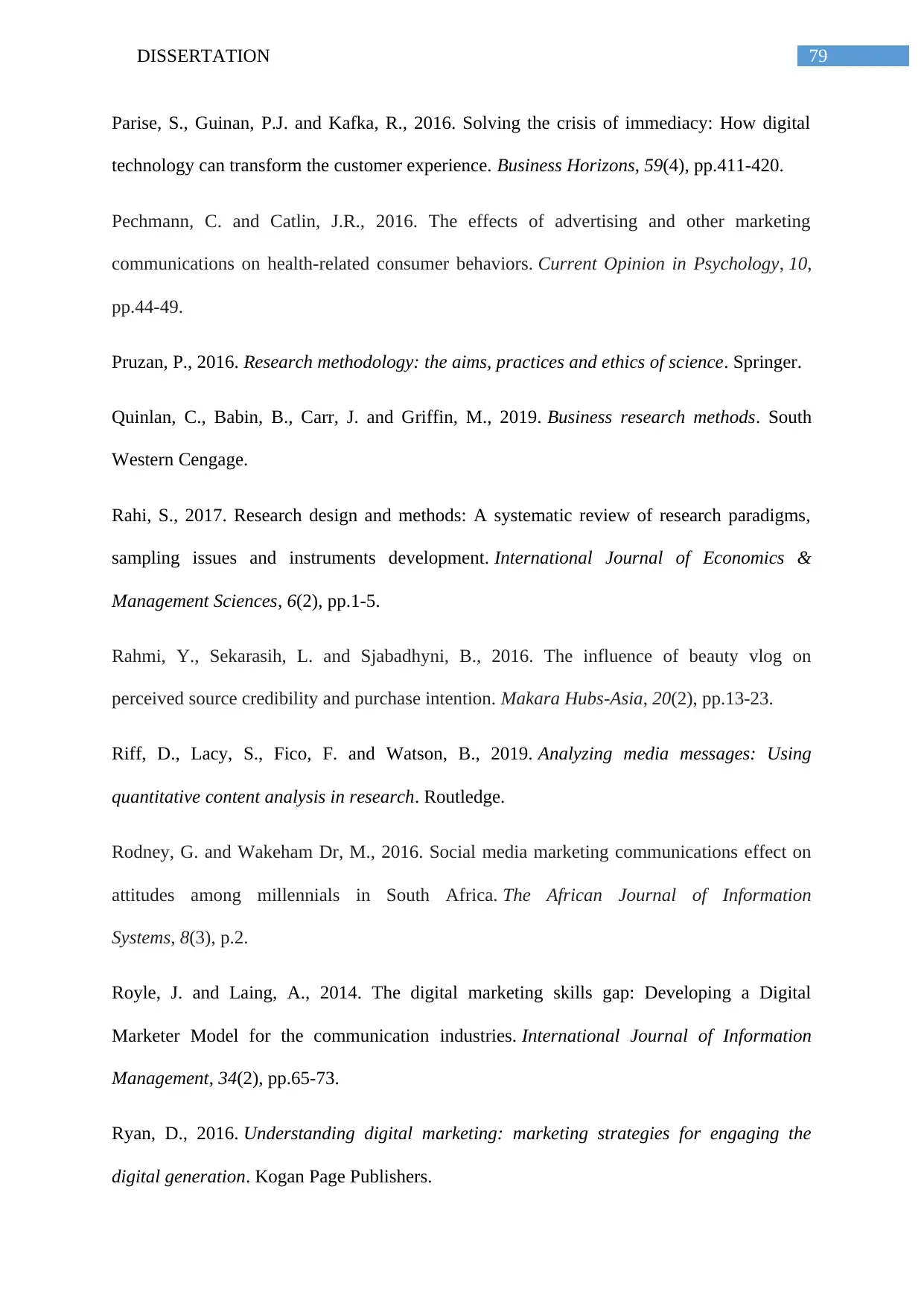
79DISSERTATION
Parise, S., Guinan, P.J. and Kafka, R., 2016. Solving the crisis of immediacy: How digital
technology can transform the customer experience. Business Horizons, 59(4), pp.411-420.
Pechmann, C. and Catlin, J.R., 2016. The effects of advertising and other marketing
communications on health-related consumer behaviors. Current Opinion in Psychology, 10,
pp.44-49.
Pruzan, P., 2016. Research methodology: the aims, practices and ethics of science. Springer.
Quinlan, C., Babin, B., Carr, J. and Griffin, M., 2019. Business research methods. South
Western Cengage.
Rahi, S., 2017. Research design and methods: A systematic review of research paradigms,
sampling issues and instruments development. International Journal of Economics &
Management Sciences, 6(2), pp.1-5.
Rahmi, Y., Sekarasih, L. and Sjabadhyni, B., 2016. The influence of beauty vlog on
perceived source credibility and purchase intention. Makara Hubs-Asia, 20(2), pp.13-23.
Riff, D., Lacy, S., Fico, F. and Watson, B., 2019. Analyzing media messages: Using
quantitative content analysis in research. Routledge.
Rodney, G. and Wakeham Dr, M., 2016. Social media marketing communications effect on
attitudes among millennials in South Africa. The African Journal of Information
Systems, 8(3), p.2.
Royle, J. and Laing, A., 2014. The digital marketing skills gap: Developing a Digital
Marketer Model for the communication industries. International Journal of Information
Management, 34(2), pp.65-73.
Ryan, D., 2016. Understanding digital marketing: marketing strategies for engaging the
digital generation. Kogan Page Publishers.
Parise, S., Guinan, P.J. and Kafka, R., 2016. Solving the crisis of immediacy: How digital
technology can transform the customer experience. Business Horizons, 59(4), pp.411-420.
Pechmann, C. and Catlin, J.R., 2016. The effects of advertising and other marketing
communications on health-related consumer behaviors. Current Opinion in Psychology, 10,
pp.44-49.
Pruzan, P., 2016. Research methodology: the aims, practices and ethics of science. Springer.
Quinlan, C., Babin, B., Carr, J. and Griffin, M., 2019. Business research methods. South
Western Cengage.
Rahi, S., 2017. Research design and methods: A systematic review of research paradigms,
sampling issues and instruments development. International Journal of Economics &
Management Sciences, 6(2), pp.1-5.
Rahmi, Y., Sekarasih, L. and Sjabadhyni, B., 2016. The influence of beauty vlog on
perceived source credibility and purchase intention. Makara Hubs-Asia, 20(2), pp.13-23.
Riff, D., Lacy, S., Fico, F. and Watson, B., 2019. Analyzing media messages: Using
quantitative content analysis in research. Routledge.
Rodney, G. and Wakeham Dr, M., 2016. Social media marketing communications effect on
attitudes among millennials in South Africa. The African Journal of Information
Systems, 8(3), p.2.
Royle, J. and Laing, A., 2014. The digital marketing skills gap: Developing a Digital
Marketer Model for the communication industries. International Journal of Information
Management, 34(2), pp.65-73.
Ryan, D., 2016. Understanding digital marketing: marketing strategies for engaging the
digital generation. Kogan Page Publishers.
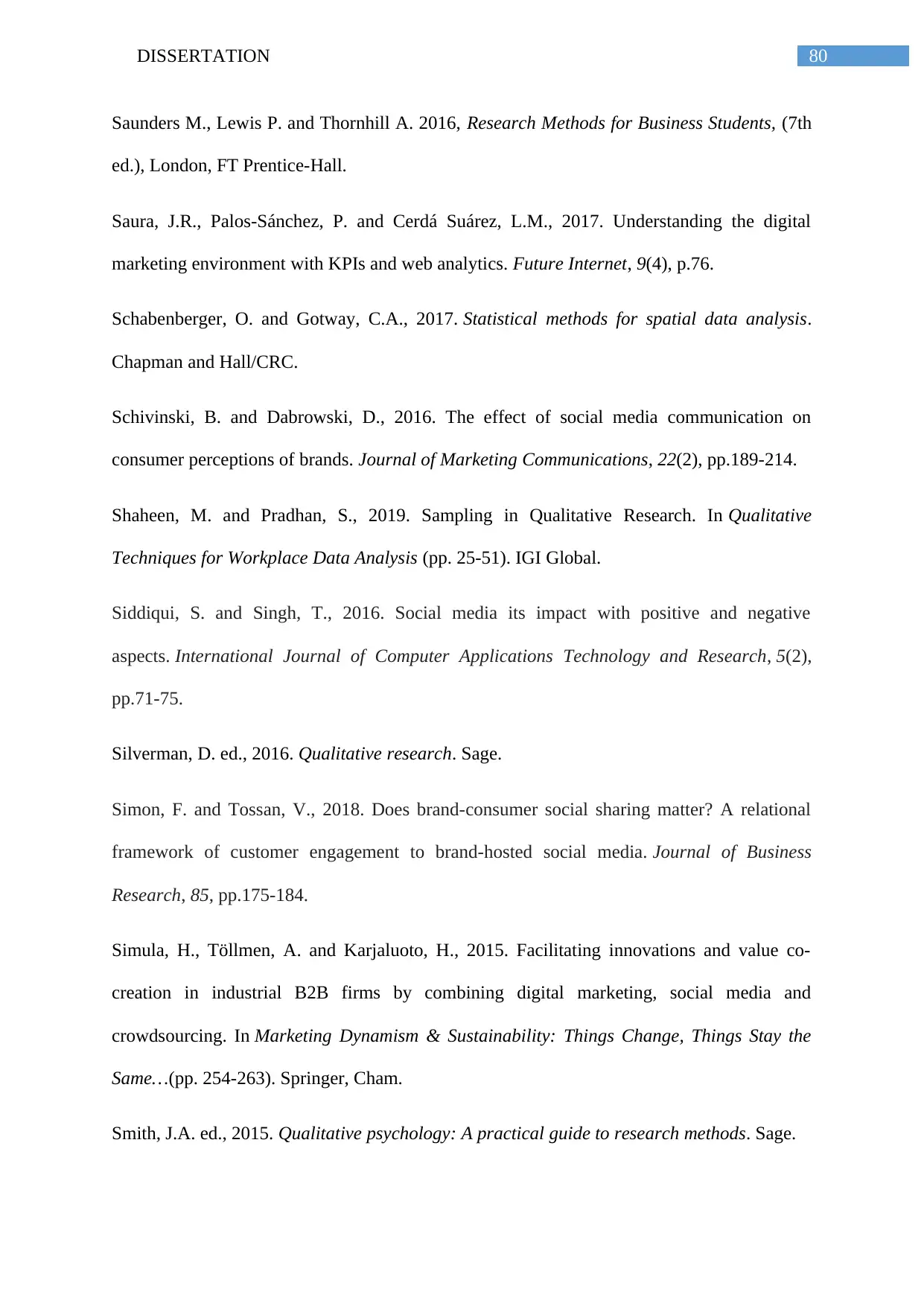
80DISSERTATION
Saunders M., Lewis P. and Thornhill A. 2016, Research Methods for Business Students, (7th
ed.), London, FT Prentice-Hall.
Saura, J.R., Palos-Sánchez, P. and Cerdá Suárez, L.M., 2017. Understanding the digital
marketing environment with KPIs and web analytics. Future Internet, 9(4), p.76.
Schabenberger, O. and Gotway, C.A., 2017. Statistical methods for spatial data analysis.
Chapman and Hall/CRC.
Schivinski, B. and Dabrowski, D., 2016. The effect of social media communication on
consumer perceptions of brands. Journal of Marketing Communications, 22(2), pp.189-214.
Shaheen, M. and Pradhan, S., 2019. Sampling in Qualitative Research. In Qualitative
Techniques for Workplace Data Analysis (pp. 25-51). IGI Global.
Siddiqui, S. and Singh, T., 2016. Social media its impact with positive and negative
aspects. International Journal of Computer Applications Technology and Research, 5(2),
pp.71-75.
Silverman, D. ed., 2016. Qualitative research. Sage.
Simon, F. and Tossan, V., 2018. Does brand-consumer social sharing matter? A relational
framework of customer engagement to brand-hosted social media. Journal of Business
Research, 85, pp.175-184.
Simula, H., Töllmen, A. and Karjaluoto, H., 2015. Facilitating innovations and value co-
creation in industrial B2B firms by combining digital marketing, social media and
crowdsourcing. In Marketing Dynamism & Sustainability: Things Change, Things Stay the
Same…(pp. 254-263). Springer, Cham.
Smith, J.A. ed., 2015. Qualitative psychology: A practical guide to research methods. Sage.
Saunders M., Lewis P. and Thornhill A. 2016, Research Methods for Business Students, (7th
ed.), London, FT Prentice-Hall.
Saura, J.R., Palos-Sánchez, P. and Cerdá Suárez, L.M., 2017. Understanding the digital
marketing environment with KPIs and web analytics. Future Internet, 9(4), p.76.
Schabenberger, O. and Gotway, C.A., 2017. Statistical methods for spatial data analysis.
Chapman and Hall/CRC.
Schivinski, B. and Dabrowski, D., 2016. The effect of social media communication on
consumer perceptions of brands. Journal of Marketing Communications, 22(2), pp.189-214.
Shaheen, M. and Pradhan, S., 2019. Sampling in Qualitative Research. In Qualitative
Techniques for Workplace Data Analysis (pp. 25-51). IGI Global.
Siddiqui, S. and Singh, T., 2016. Social media its impact with positive and negative
aspects. International Journal of Computer Applications Technology and Research, 5(2),
pp.71-75.
Silverman, D. ed., 2016. Qualitative research. Sage.
Simon, F. and Tossan, V., 2018. Does brand-consumer social sharing matter? A relational
framework of customer engagement to brand-hosted social media. Journal of Business
Research, 85, pp.175-184.
Simula, H., Töllmen, A. and Karjaluoto, H., 2015. Facilitating innovations and value co-
creation in industrial B2B firms by combining digital marketing, social media and
crowdsourcing. In Marketing Dynamism & Sustainability: Things Change, Things Stay the
Same…(pp. 254-263). Springer, Cham.
Smith, J.A. ed., 2015. Qualitative psychology: A practical guide to research methods. Sage.
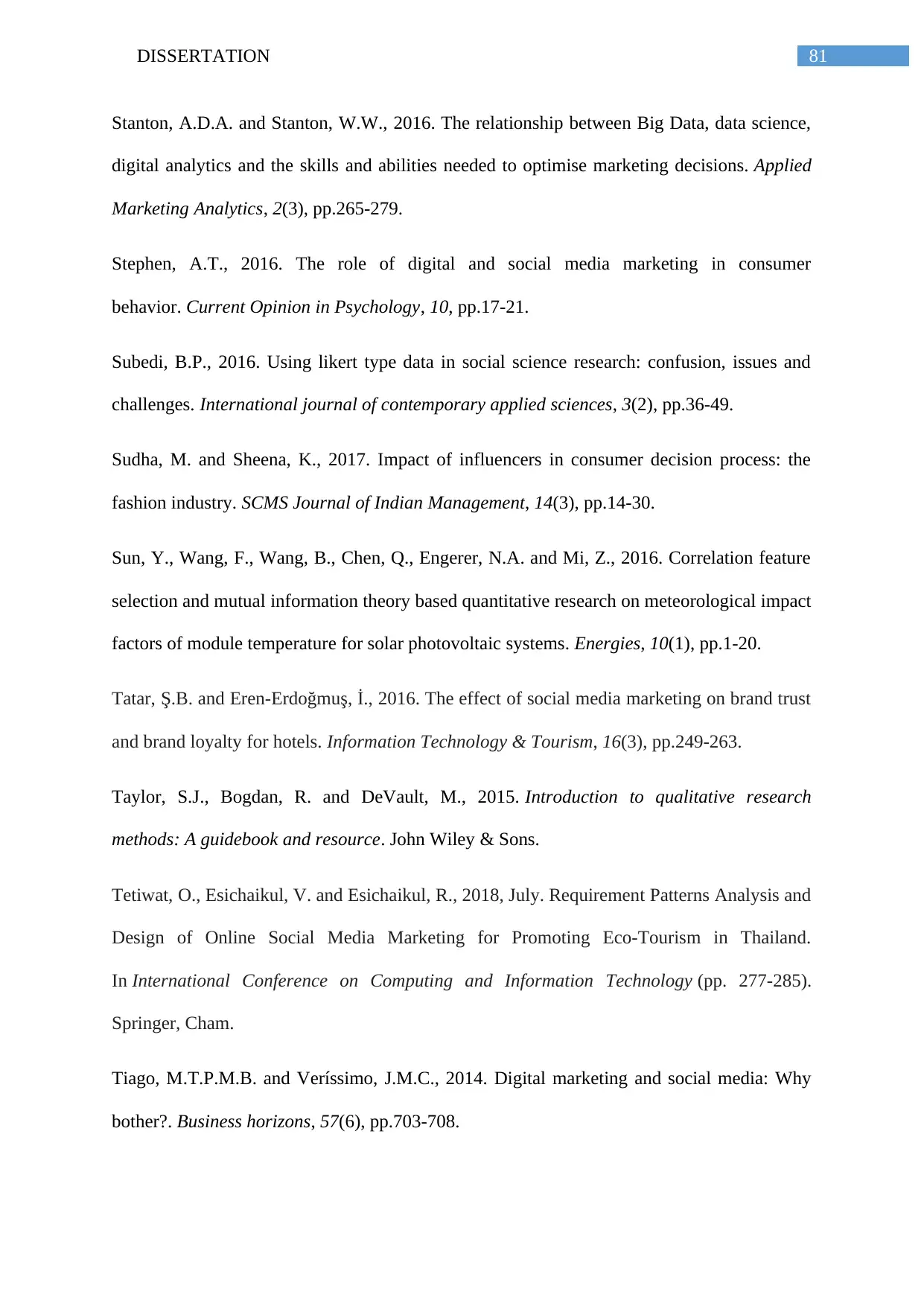
81DISSERTATION
Stanton, A.D.A. and Stanton, W.W., 2016. The relationship between Big Data, data science,
digital analytics and the skills and abilities needed to optimise marketing decisions. Applied
Marketing Analytics, 2(3), pp.265-279.
Stephen, A.T., 2016. The role of digital and social media marketing in consumer
behavior. Current Opinion in Psychology, 10, pp.17-21.
Subedi, B.P., 2016. Using likert type data in social science research: confusion, issues and
challenges. International journal of contemporary applied sciences, 3(2), pp.36-49.
Sudha, M. and Sheena, K., 2017. Impact of influencers in consumer decision process: the
fashion industry. SCMS Journal of Indian Management, 14(3), pp.14-30.
Sun, Y., Wang, F., Wang, B., Chen, Q., Engerer, N.A. and Mi, Z., 2016. Correlation feature
selection and mutual information theory based quantitative research on meteorological impact
factors of module temperature for solar photovoltaic systems. Energies, 10(1), pp.1-20.
Tatar, Ş.B. and Eren-Erdoğmuş, İ., 2016. The effect of social media marketing on brand trust
and brand loyalty for hotels. Information Technology & Tourism, 16(3), pp.249-263.
Taylor, S.J., Bogdan, R. and DeVault, M., 2015. Introduction to qualitative research
methods: A guidebook and resource. John Wiley & Sons.
Tetiwat, O., Esichaikul, V. and Esichaikul, R., 2018, July. Requirement Patterns Analysis and
Design of Online Social Media Marketing for Promoting Eco-Tourism in Thailand.
In International Conference on Computing and Information Technology (pp. 277-285).
Springer, Cham.
Tiago, M.T.P.M.B. and Veríssimo, J.M.C., 2014. Digital marketing and social media: Why
bother?. Business horizons, 57(6), pp.703-708.
Stanton, A.D.A. and Stanton, W.W., 2016. The relationship between Big Data, data science,
digital analytics and the skills and abilities needed to optimise marketing decisions. Applied
Marketing Analytics, 2(3), pp.265-279.
Stephen, A.T., 2016. The role of digital and social media marketing in consumer
behavior. Current Opinion in Psychology, 10, pp.17-21.
Subedi, B.P., 2016. Using likert type data in social science research: confusion, issues and
challenges. International journal of contemporary applied sciences, 3(2), pp.36-49.
Sudha, M. and Sheena, K., 2017. Impact of influencers in consumer decision process: the
fashion industry. SCMS Journal of Indian Management, 14(3), pp.14-30.
Sun, Y., Wang, F., Wang, B., Chen, Q., Engerer, N.A. and Mi, Z., 2016. Correlation feature
selection and mutual information theory based quantitative research on meteorological impact
factors of module temperature for solar photovoltaic systems. Energies, 10(1), pp.1-20.
Tatar, Ş.B. and Eren-Erdoğmuş, İ., 2016. The effect of social media marketing on brand trust
and brand loyalty for hotels. Information Technology & Tourism, 16(3), pp.249-263.
Taylor, S.J., Bogdan, R. and DeVault, M., 2015. Introduction to qualitative research
methods: A guidebook and resource. John Wiley & Sons.
Tetiwat, O., Esichaikul, V. and Esichaikul, R., 2018, July. Requirement Patterns Analysis and
Design of Online Social Media Marketing for Promoting Eco-Tourism in Thailand.
In International Conference on Computing and Information Technology (pp. 277-285).
Springer, Cham.
Tiago, M.T.P.M.B. and Veríssimo, J.M.C., 2014. Digital marketing and social media: Why
bother?. Business horizons, 57(6), pp.703-708.
Secure Best Marks with AI Grader
Need help grading? Try our AI Grader for instant feedback on your assignments.
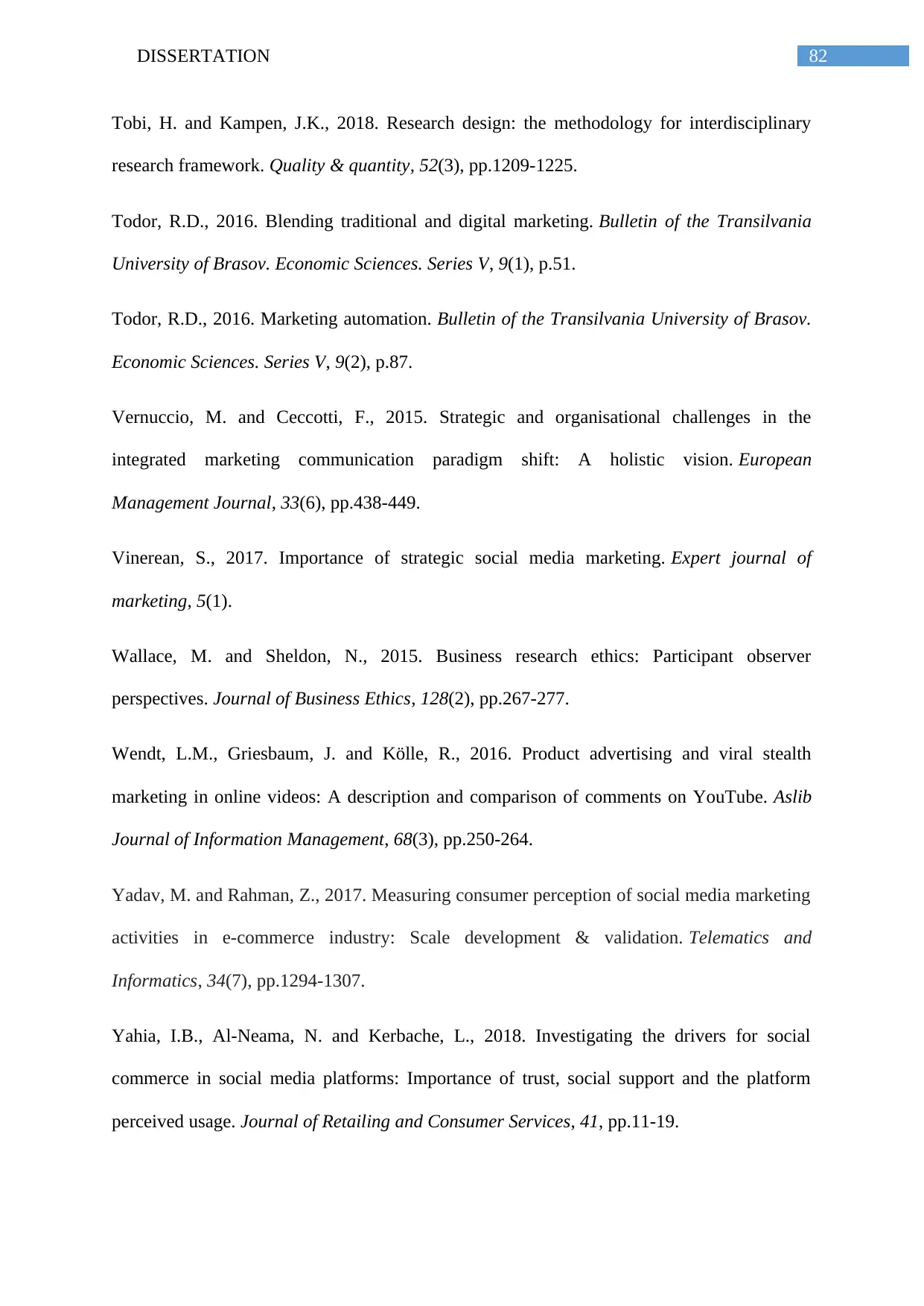
82DISSERTATION
Tobi, H. and Kampen, J.K., 2018. Research design: the methodology for interdisciplinary
research framework. Quality & quantity, 52(3), pp.1209-1225.
Todor, R.D., 2016. Blending traditional and digital marketing. Bulletin of the Transilvania
University of Brasov. Economic Sciences. Series V, 9(1), p.51.
Todor, R.D., 2016. Marketing automation. Bulletin of the Transilvania University of Brasov.
Economic Sciences. Series V, 9(2), p.87.
Vernuccio, M. and Ceccotti, F., 2015. Strategic and organisational challenges in the
integrated marketing communication paradigm shift: A holistic vision. European
Management Journal, 33(6), pp.438-449.
Vinerean, S., 2017. Importance of strategic social media marketing. Expert journal of
marketing, 5(1).
Wallace, M. and Sheldon, N., 2015. Business research ethics: Participant observer
perspectives. Journal of Business Ethics, 128(2), pp.267-277.
Wendt, L.M., Griesbaum, J. and Kölle, R., 2016. Product advertising and viral stealth
marketing in online videos: A description and comparison of comments on YouTube. Aslib
Journal of Information Management, 68(3), pp.250-264.
Yadav, M. and Rahman, Z., 2017. Measuring consumer perception of social media marketing
activities in e-commerce industry: Scale development & validation. Telematics and
Informatics, 34(7), pp.1294-1307.
Yahia, I.B., Al-Neama, N. and Kerbache, L., 2018. Investigating the drivers for social
commerce in social media platforms: Importance of trust, social support and the platform
perceived usage. Journal of Retailing and Consumer Services, 41, pp.11-19.
Tobi, H. and Kampen, J.K., 2018. Research design: the methodology for interdisciplinary
research framework. Quality & quantity, 52(3), pp.1209-1225.
Todor, R.D., 2016. Blending traditional and digital marketing. Bulletin of the Transilvania
University of Brasov. Economic Sciences. Series V, 9(1), p.51.
Todor, R.D., 2016. Marketing automation. Bulletin of the Transilvania University of Brasov.
Economic Sciences. Series V, 9(2), p.87.
Vernuccio, M. and Ceccotti, F., 2015. Strategic and organisational challenges in the
integrated marketing communication paradigm shift: A holistic vision. European
Management Journal, 33(6), pp.438-449.
Vinerean, S., 2017. Importance of strategic social media marketing. Expert journal of
marketing, 5(1).
Wallace, M. and Sheldon, N., 2015. Business research ethics: Participant observer
perspectives. Journal of Business Ethics, 128(2), pp.267-277.
Wendt, L.M., Griesbaum, J. and Kölle, R., 2016. Product advertising and viral stealth
marketing in online videos: A description and comparison of comments on YouTube. Aslib
Journal of Information Management, 68(3), pp.250-264.
Yadav, M. and Rahman, Z., 2017. Measuring consumer perception of social media marketing
activities in e-commerce industry: Scale development & validation. Telematics and
Informatics, 34(7), pp.1294-1307.
Yahia, I.B., Al-Neama, N. and Kerbache, L., 2018. Investigating the drivers for social
commerce in social media platforms: Importance of trust, social support and the platform
perceived usage. Journal of Retailing and Consumer Services, 41, pp.11-19.
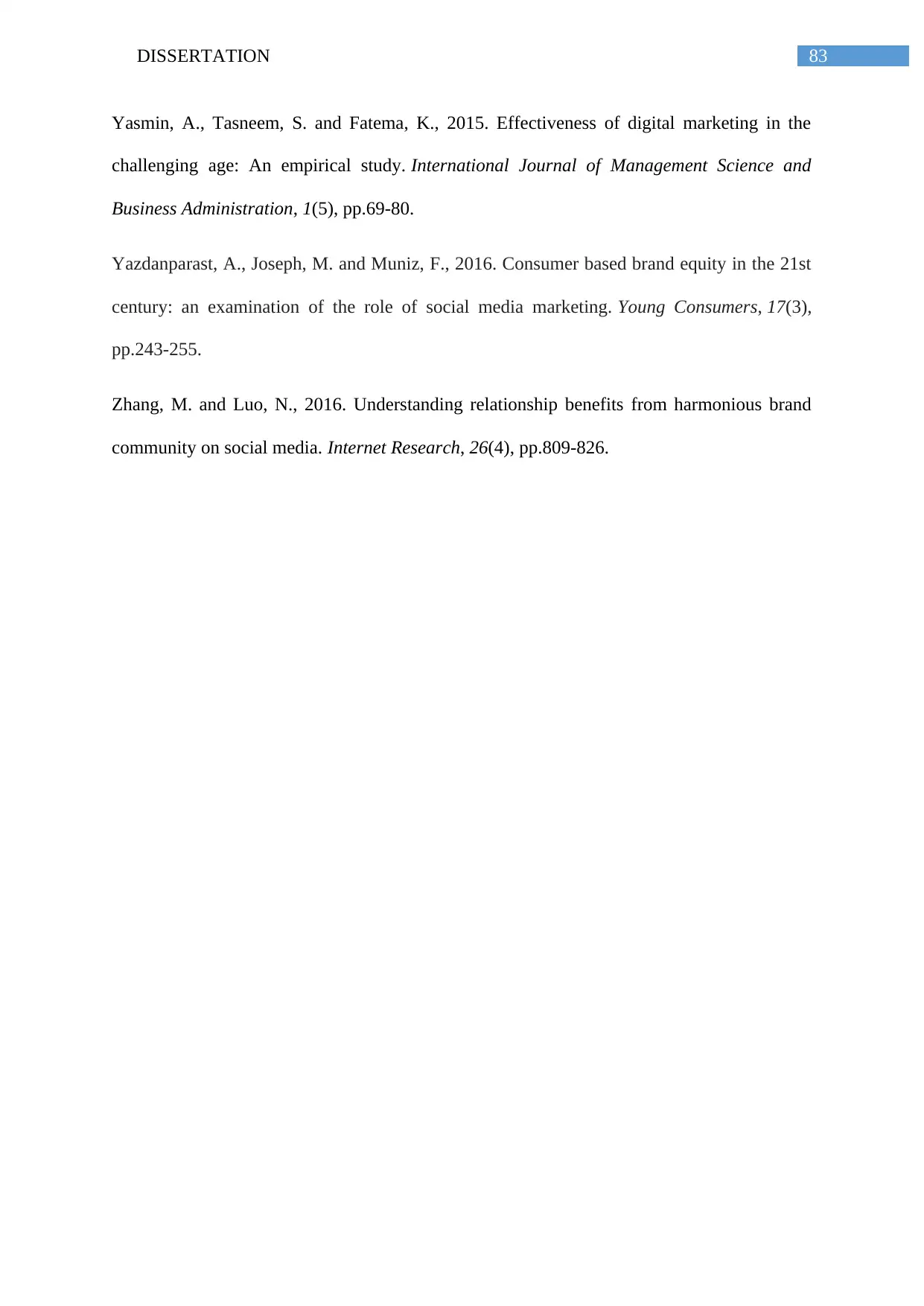
83DISSERTATION
Yasmin, A., Tasneem, S. and Fatema, K., 2015. Effectiveness of digital marketing in the
challenging age: An empirical study. International Journal of Management Science and
Business Administration, 1(5), pp.69-80.
Yazdanparast, A., Joseph, M. and Muniz, F., 2016. Consumer based brand equity in the 21st
century: an examination of the role of social media marketing. Young Consumers, 17(3),
pp.243-255.
Zhang, M. and Luo, N., 2016. Understanding relationship benefits from harmonious brand
community on social media. Internet Research, 26(4), pp.809-826.
Yasmin, A., Tasneem, S. and Fatema, K., 2015. Effectiveness of digital marketing in the
challenging age: An empirical study. International Journal of Management Science and
Business Administration, 1(5), pp.69-80.
Yazdanparast, A., Joseph, M. and Muniz, F., 2016. Consumer based brand equity in the 21st
century: an examination of the role of social media marketing. Young Consumers, 17(3),
pp.243-255.
Zhang, M. and Luo, N., 2016. Understanding relationship benefits from harmonious brand
community on social media. Internet Research, 26(4), pp.809-826.
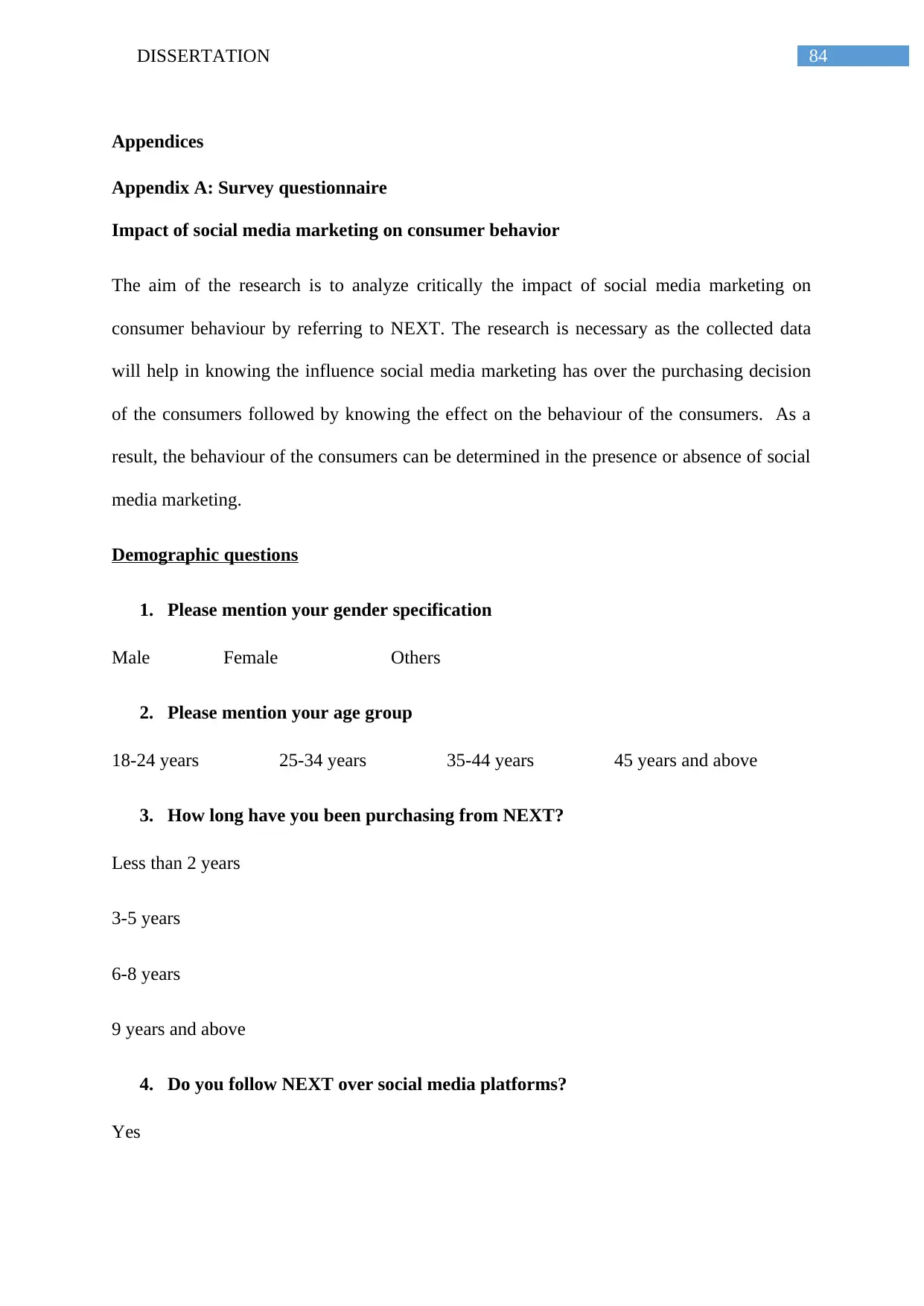
84DISSERTATION
Appendices
Appendix A: Survey questionnaire
Impact of social media marketing on consumer behavior
The aim of the research is to analyze critically the impact of social media marketing on
consumer behaviour by referring to NEXT. The research is necessary as the collected data
will help in knowing the influence social media marketing has over the purchasing decision
of the consumers followed by knowing the effect on the behaviour of the consumers. As a
result, the behaviour of the consumers can be determined in the presence or absence of social
media marketing.
Demographic questions
1. Please mention your gender specification
Male Female Others
2. Please mention your age group
18-24 years 25-34 years 35-44 years 45 years and above
3. How long have you been purchasing from NEXT?
Less than 2 years
3-5 years
6-8 years
9 years and above
4. Do you follow NEXT over social media platforms?
Yes
Appendices
Appendix A: Survey questionnaire
Impact of social media marketing on consumer behavior
The aim of the research is to analyze critically the impact of social media marketing on
consumer behaviour by referring to NEXT. The research is necessary as the collected data
will help in knowing the influence social media marketing has over the purchasing decision
of the consumers followed by knowing the effect on the behaviour of the consumers. As a
result, the behaviour of the consumers can be determined in the presence or absence of social
media marketing.
Demographic questions
1. Please mention your gender specification
Male Female Others
2. Please mention your age group
18-24 years 25-34 years 35-44 years 45 years and above
3. How long have you been purchasing from NEXT?
Less than 2 years
3-5 years
6-8 years
9 years and above
4. Do you follow NEXT over social media platforms?
Yes
Paraphrase This Document
Need a fresh take? Get an instant paraphrase of this document with our AI Paraphraser
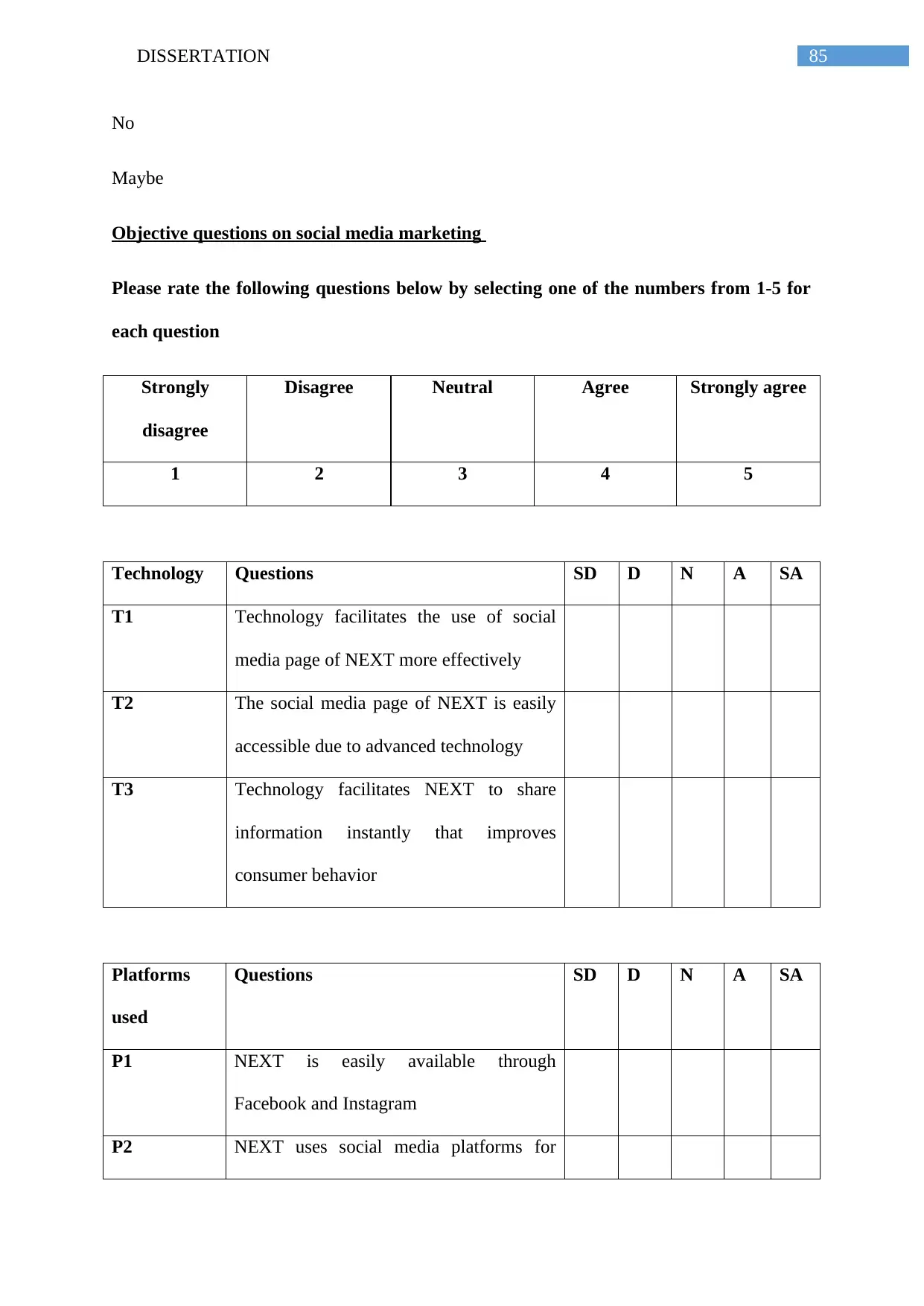
85DISSERTATION
No
Maybe
Objective questions on social media marketing
Please rate the following questions below by selecting one of the numbers from 1-5 for
each question
Strongly
disagree
Disagree Neutral Agree Strongly agree
1 2 3 4 5
Technology Questions SD D N A SA
T1 Technology facilitates the use of social
media page of NEXT more effectively
T2 The social media page of NEXT is easily
accessible due to advanced technology
T3 Technology facilitates NEXT to share
information instantly that improves
consumer behavior
Platforms
used
Questions SD D N A SA
P1 NEXT is easily available through
Facebook and Instagram
P2 NEXT uses social media platforms for
No
Maybe
Objective questions on social media marketing
Please rate the following questions below by selecting one of the numbers from 1-5 for
each question
Strongly
disagree
Disagree Neutral Agree Strongly agree
1 2 3 4 5
Technology Questions SD D N A SA
T1 Technology facilitates the use of social
media page of NEXT more effectively
T2 The social media page of NEXT is easily
accessible due to advanced technology
T3 Technology facilitates NEXT to share
information instantly that improves
consumer behavior
Platforms
used
Questions SD D N A SA
P1 NEXT is easily available through
Facebook and Instagram
P2 NEXT uses social media platforms for
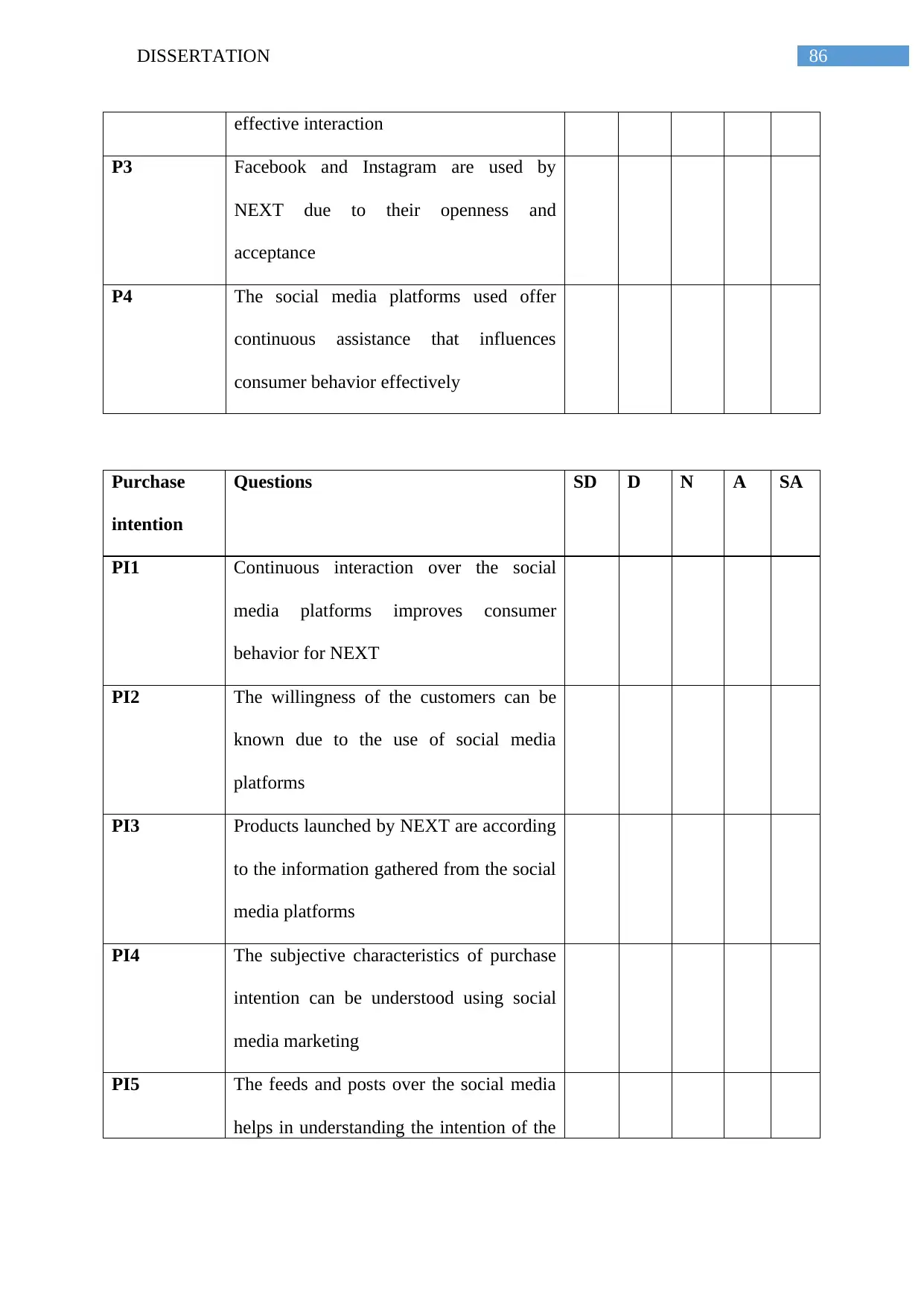
86DISSERTATION
effective interaction
P3 Facebook and Instagram are used by
NEXT due to their openness and
acceptance
P4 The social media platforms used offer
continuous assistance that influences
consumer behavior effectively
Purchase
intention
Questions SD D N A SA
PI1 Continuous interaction over the social
media platforms improves consumer
behavior for NEXT
PI2 The willingness of the customers can be
known due to the use of social media
platforms
PI3 Products launched by NEXT are according
to the information gathered from the social
media platforms
PI4 The subjective characteristics of purchase
intention can be understood using social
media marketing
PI5 The feeds and posts over the social media
helps in understanding the intention of the
effective interaction
P3 Facebook and Instagram are used by
NEXT due to their openness and
acceptance
P4 The social media platforms used offer
continuous assistance that influences
consumer behavior effectively
Purchase
intention
Questions SD D N A SA
PI1 Continuous interaction over the social
media platforms improves consumer
behavior for NEXT
PI2 The willingness of the customers can be
known due to the use of social media
platforms
PI3 Products launched by NEXT are according
to the information gathered from the social
media platforms
PI4 The subjective characteristics of purchase
intention can be understood using social
media marketing
PI5 The feeds and posts over the social media
helps in understanding the intention of the
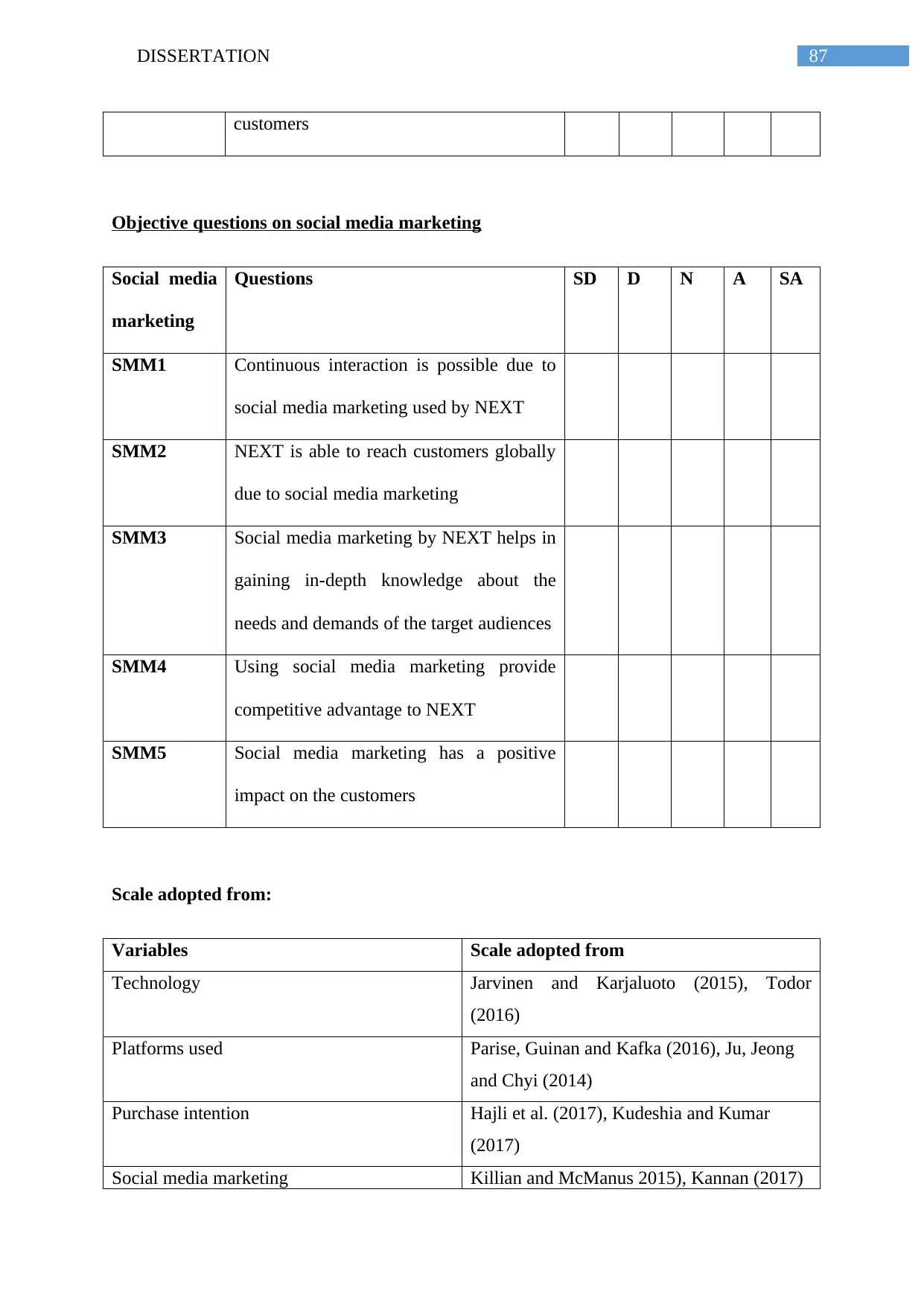
87DISSERTATION
customers
Objective questions on social media marketing
Social media
marketing
Questions SD D N A SA
SMM1 Continuous interaction is possible due to
social media marketing used by NEXT
SMM2 NEXT is able to reach customers globally
due to social media marketing
SMM3 Social media marketing by NEXT helps in
gaining in-depth knowledge about the
needs and demands of the target audiences
SMM4 Using social media marketing provide
competitive advantage to NEXT
SMM5 Social media marketing has a positive
impact on the customers
Scale adopted from:
Variables Scale adopted from
Technology Jarvinen and Karjaluoto (2015), Todor
(2016)
Platforms used Parise, Guinan and Kafka (2016), Ju, Jeong
and Chyi (2014)
Purchase intention Hajli et al. (2017), Kudeshia and Kumar
(2017)
Social media marketing Killian and McManus 2015), Kannan (2017)
customers
Objective questions on social media marketing
Social media
marketing
Questions SD D N A SA
SMM1 Continuous interaction is possible due to
social media marketing used by NEXT
SMM2 NEXT is able to reach customers globally
due to social media marketing
SMM3 Social media marketing by NEXT helps in
gaining in-depth knowledge about the
needs and demands of the target audiences
SMM4 Using social media marketing provide
competitive advantage to NEXT
SMM5 Social media marketing has a positive
impact on the customers
Scale adopted from:
Variables Scale adopted from
Technology Jarvinen and Karjaluoto (2015), Todor
(2016)
Platforms used Parise, Guinan and Kafka (2016), Ju, Jeong
and Chyi (2014)
Purchase intention Hajli et al. (2017), Kudeshia and Kumar
(2017)
Social media marketing Killian and McManus 2015), Kannan (2017)
Secure Best Marks with AI Grader
Need help grading? Try our AI Grader for instant feedback on your assignments.

88DISSERTATION
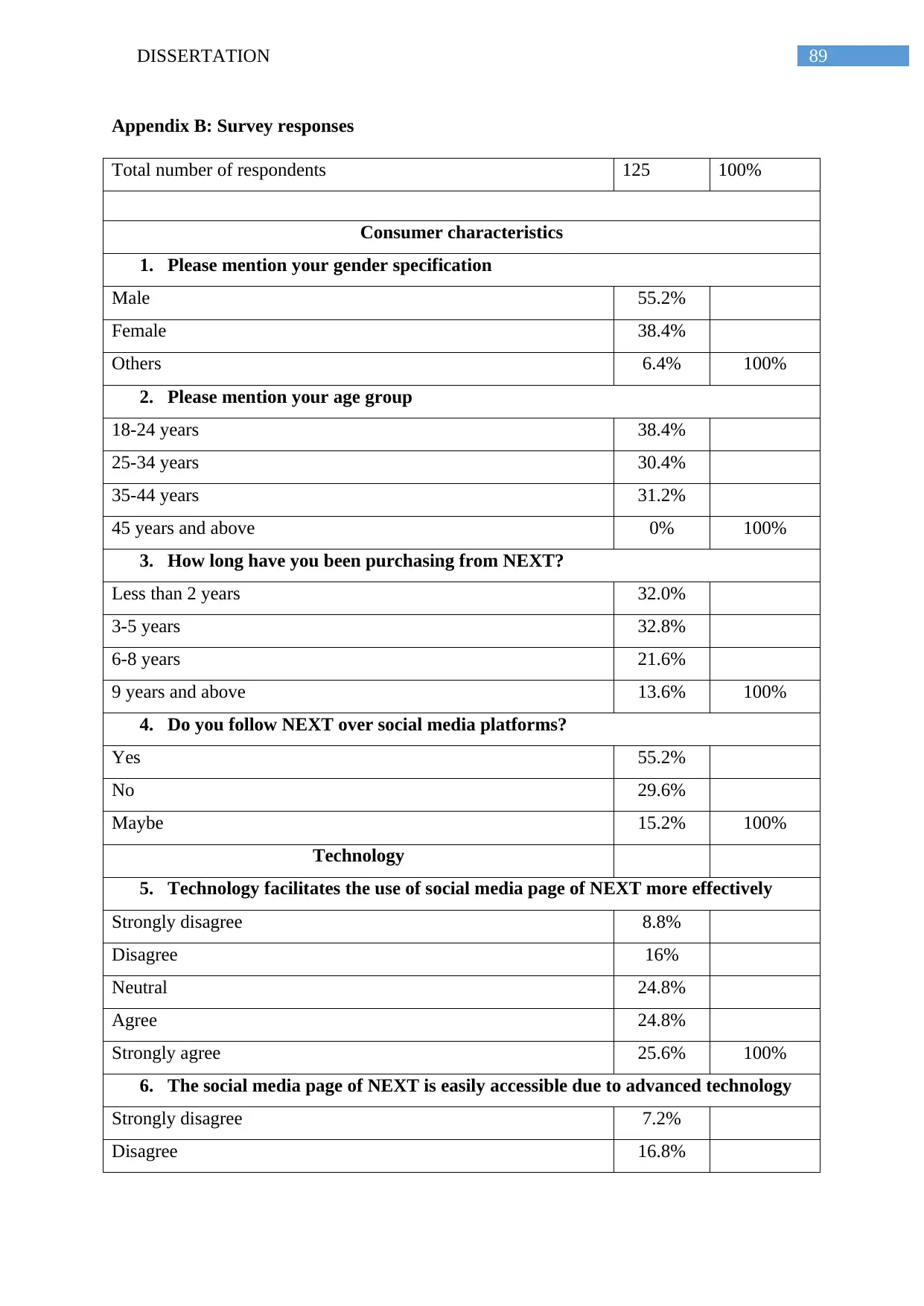
89DISSERTATION
Appendix B: Survey responses
Total number of respondents 125 100%
Consumer characteristics
1. Please mention your gender specification
Male 55.2%
Female 38.4%
Others 6.4% 100%
2. Please mention your age group
18-24 years 38.4%
25-34 years 30.4%
35-44 years 31.2%
45 years and above 0% 100%
3. How long have you been purchasing from NEXT?
Less than 2 years 32.0%
3-5 years 32.8%
6-8 years 21.6%
9 years and above 13.6% 100%
4. Do you follow NEXT over social media platforms?
Yes 55.2%
No 29.6%
Maybe 15.2% 100%
Technology
5. Technology facilitates the use of social media page of NEXT more effectively
Strongly disagree 8.8%
Disagree 16%
Neutral 24.8%
Agree 24.8%
Strongly agree 25.6% 100%
6. The social media page of NEXT is easily accessible due to advanced technology
Strongly disagree 7.2%
Disagree 16.8%
Appendix B: Survey responses
Total number of respondents 125 100%
Consumer characteristics
1. Please mention your gender specification
Male 55.2%
Female 38.4%
Others 6.4% 100%
2. Please mention your age group
18-24 years 38.4%
25-34 years 30.4%
35-44 years 31.2%
45 years and above 0% 100%
3. How long have you been purchasing from NEXT?
Less than 2 years 32.0%
3-5 years 32.8%
6-8 years 21.6%
9 years and above 13.6% 100%
4. Do you follow NEXT over social media platforms?
Yes 55.2%
No 29.6%
Maybe 15.2% 100%
Technology
5. Technology facilitates the use of social media page of NEXT more effectively
Strongly disagree 8.8%
Disagree 16%
Neutral 24.8%
Agree 24.8%
Strongly agree 25.6% 100%
6. The social media page of NEXT is easily accessible due to advanced technology
Strongly disagree 7.2%
Disagree 16.8%
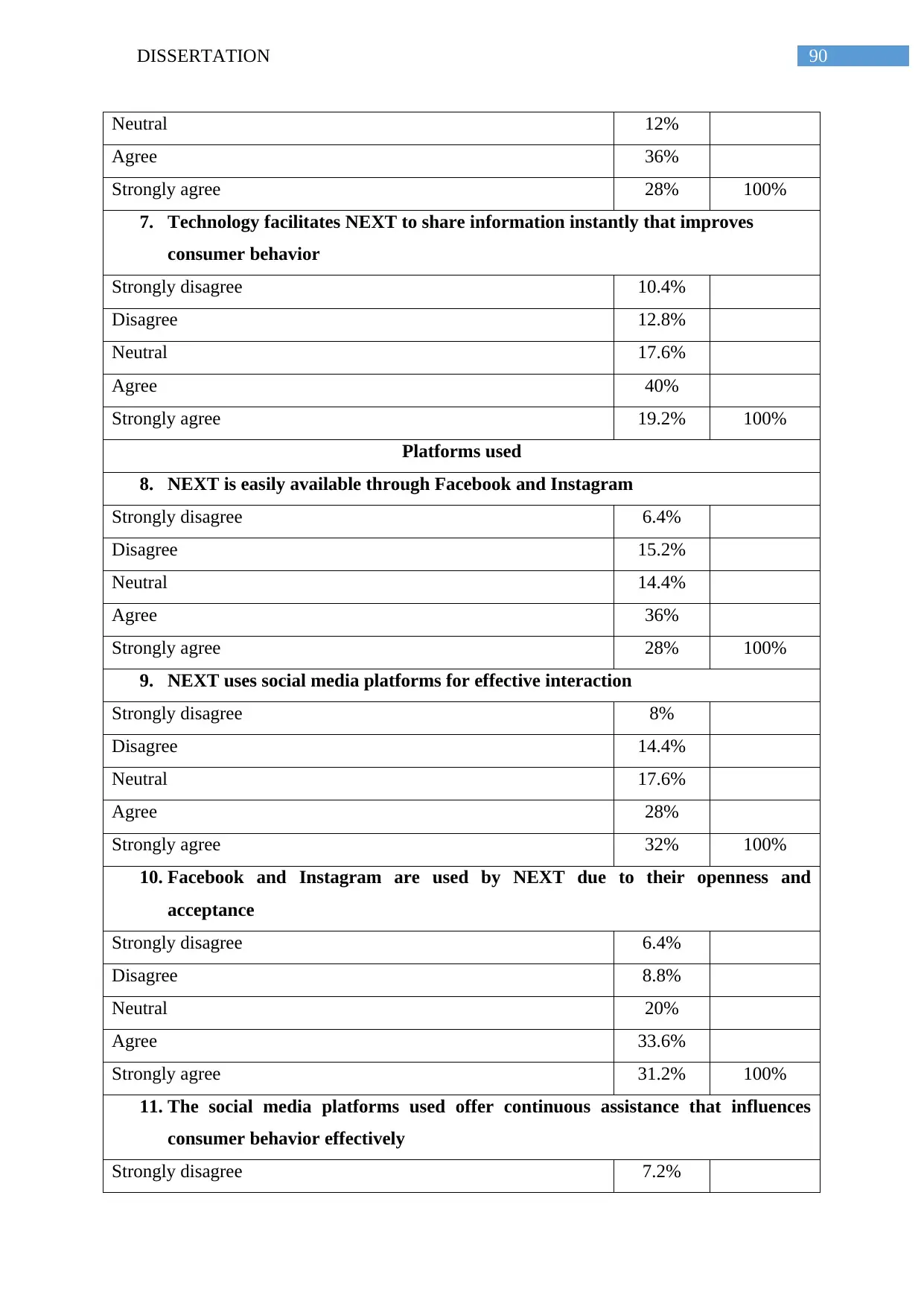
90DISSERTATION
Neutral 12%
Agree 36%
Strongly agree 28% 100%
7. Technology facilitates NEXT to share information instantly that improves
consumer behavior
Strongly disagree 10.4%
Disagree 12.8%
Neutral 17.6%
Agree 40%
Strongly agree 19.2% 100%
Platforms used
8. NEXT is easily available through Facebook and Instagram
Strongly disagree 6.4%
Disagree 15.2%
Neutral 14.4%
Agree 36%
Strongly agree 28% 100%
9. NEXT uses social media platforms for effective interaction
Strongly disagree 8%
Disagree 14.4%
Neutral 17.6%
Agree 28%
Strongly agree 32% 100%
10. Facebook and Instagram are used by NEXT due to their openness and
acceptance
Strongly disagree 6.4%
Disagree 8.8%
Neutral 20%
Agree 33.6%
Strongly agree 31.2% 100%
11. The social media platforms used offer continuous assistance that influences
consumer behavior effectively
Strongly disagree 7.2%
Neutral 12%
Agree 36%
Strongly agree 28% 100%
7. Technology facilitates NEXT to share information instantly that improves
consumer behavior
Strongly disagree 10.4%
Disagree 12.8%
Neutral 17.6%
Agree 40%
Strongly agree 19.2% 100%
Platforms used
8. NEXT is easily available through Facebook and Instagram
Strongly disagree 6.4%
Disagree 15.2%
Neutral 14.4%
Agree 36%
Strongly agree 28% 100%
9. NEXT uses social media platforms for effective interaction
Strongly disagree 8%
Disagree 14.4%
Neutral 17.6%
Agree 28%
Strongly agree 32% 100%
10. Facebook and Instagram are used by NEXT due to their openness and
acceptance
Strongly disagree 6.4%
Disagree 8.8%
Neutral 20%
Agree 33.6%
Strongly agree 31.2% 100%
11. The social media platforms used offer continuous assistance that influences
consumer behavior effectively
Strongly disagree 7.2%
Paraphrase This Document
Need a fresh take? Get an instant paraphrase of this document with our AI Paraphraser
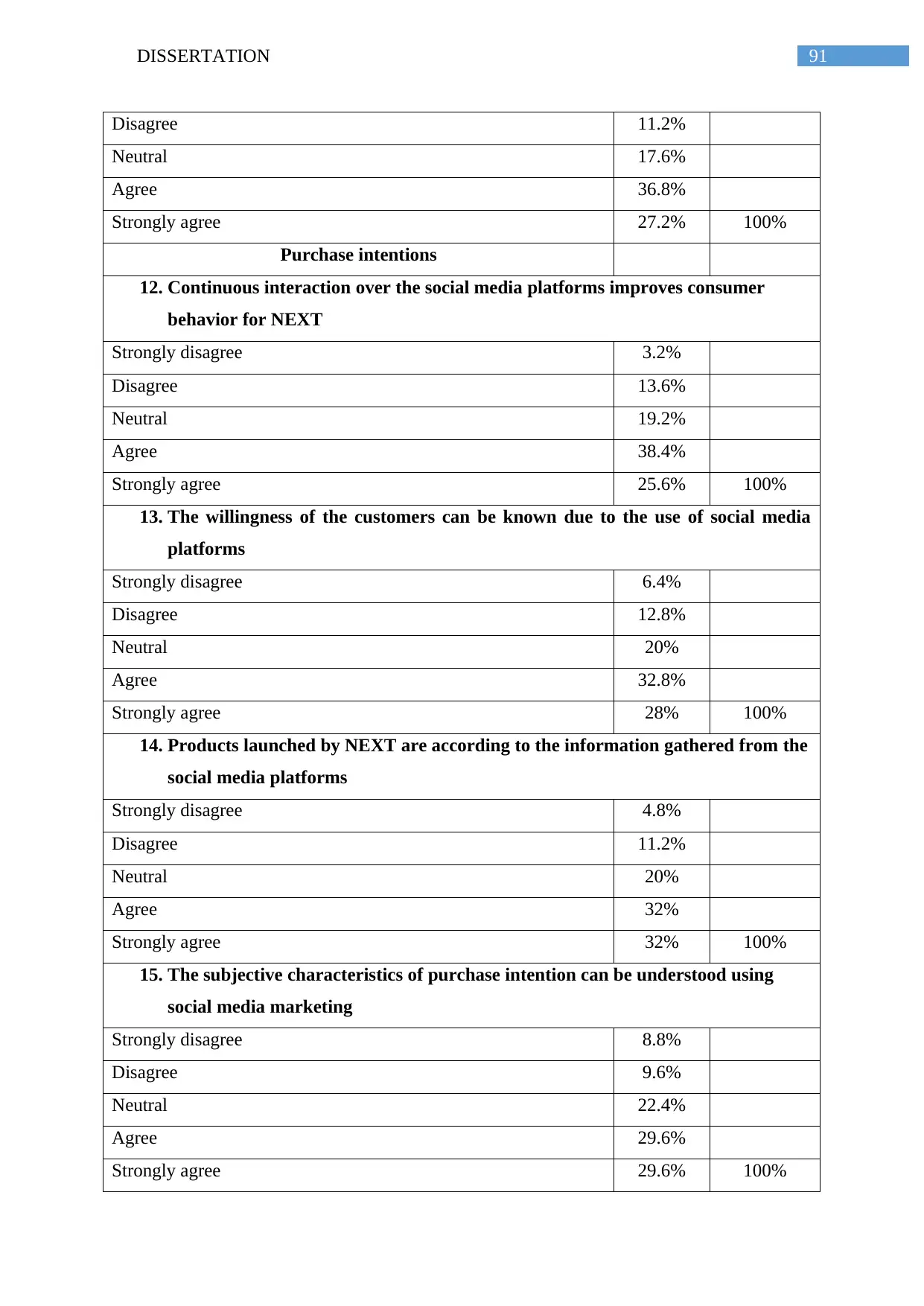
91DISSERTATION
Disagree 11.2%
Neutral 17.6%
Agree 36.8%
Strongly agree 27.2% 100%
Purchase intentions
12. Continuous interaction over the social media platforms improves consumer
behavior for NEXT
Strongly disagree 3.2%
Disagree 13.6%
Neutral 19.2%
Agree 38.4%
Strongly agree 25.6% 100%
13. The willingness of the customers can be known due to the use of social media
platforms
Strongly disagree 6.4%
Disagree 12.8%
Neutral 20%
Agree 32.8%
Strongly agree 28% 100%
14. Products launched by NEXT are according to the information gathered from the
social media platforms
Strongly disagree 4.8%
Disagree 11.2%
Neutral 20%
Agree 32%
Strongly agree 32% 100%
15. The subjective characteristics of purchase intention can be understood using
social media marketing
Strongly disagree 8.8%
Disagree 9.6%
Neutral 22.4%
Agree 29.6%
Strongly agree 29.6% 100%
Disagree 11.2%
Neutral 17.6%
Agree 36.8%
Strongly agree 27.2% 100%
Purchase intentions
12. Continuous interaction over the social media platforms improves consumer
behavior for NEXT
Strongly disagree 3.2%
Disagree 13.6%
Neutral 19.2%
Agree 38.4%
Strongly agree 25.6% 100%
13. The willingness of the customers can be known due to the use of social media
platforms
Strongly disagree 6.4%
Disagree 12.8%
Neutral 20%
Agree 32.8%
Strongly agree 28% 100%
14. Products launched by NEXT are according to the information gathered from the
social media platforms
Strongly disagree 4.8%
Disagree 11.2%
Neutral 20%
Agree 32%
Strongly agree 32% 100%
15. The subjective characteristics of purchase intention can be understood using
social media marketing
Strongly disagree 8.8%
Disagree 9.6%
Neutral 22.4%
Agree 29.6%
Strongly agree 29.6% 100%
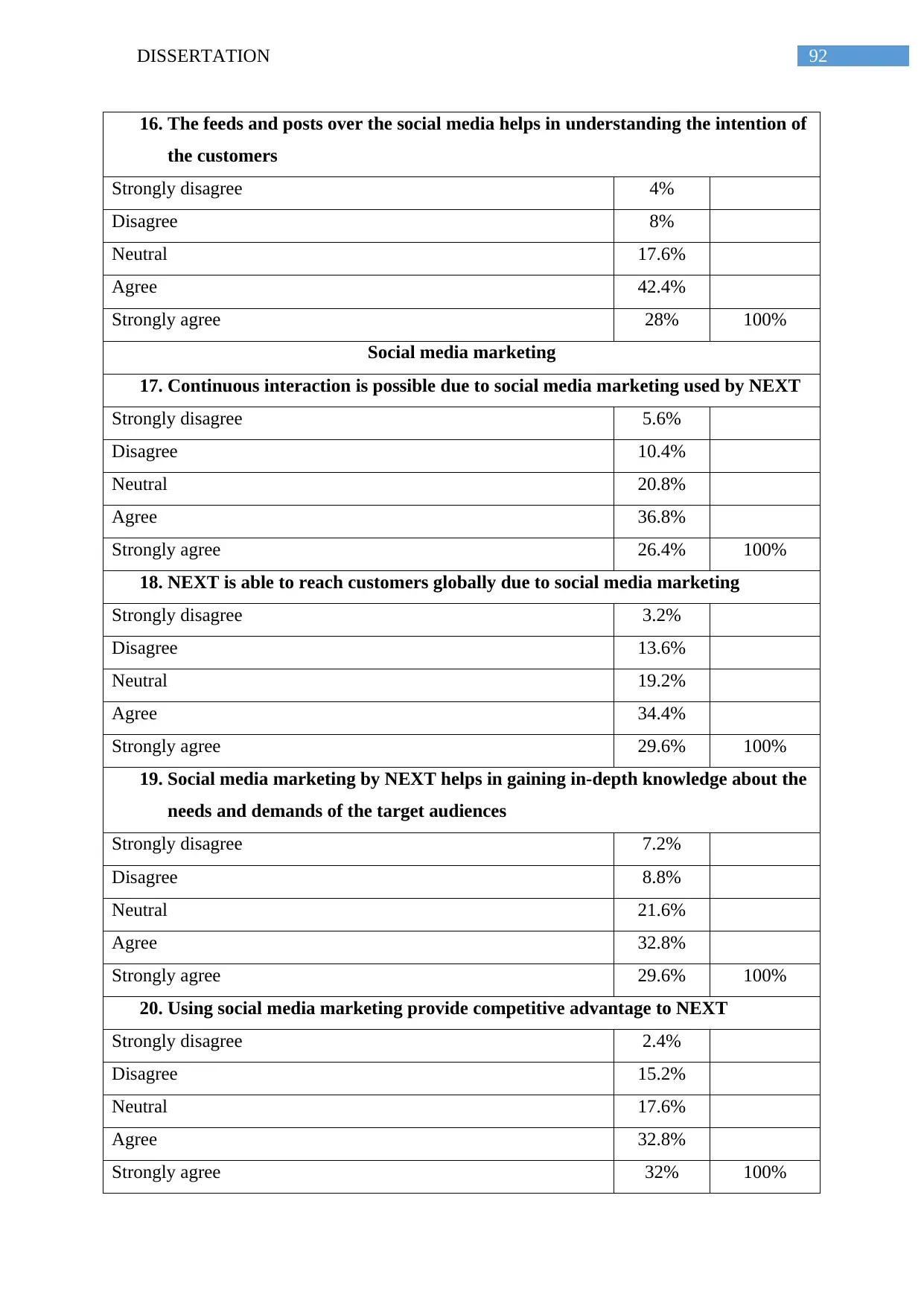
92DISSERTATION
16. The feeds and posts over the social media helps in understanding the intention of
the customers
Strongly disagree 4%
Disagree 8%
Neutral 17.6%
Agree 42.4%
Strongly agree 28% 100%
Social media marketing
17. Continuous interaction is possible due to social media marketing used by NEXT
Strongly disagree 5.6%
Disagree 10.4%
Neutral 20.8%
Agree 36.8%
Strongly agree 26.4% 100%
18. NEXT is able to reach customers globally due to social media marketing
Strongly disagree 3.2%
Disagree 13.6%
Neutral 19.2%
Agree 34.4%
Strongly agree 29.6% 100%
19. Social media marketing by NEXT helps in gaining in-depth knowledge about the
needs and demands of the target audiences
Strongly disagree 7.2%
Disagree 8.8%
Neutral 21.6%
Agree 32.8%
Strongly agree 29.6% 100%
20. Using social media marketing provide competitive advantage to NEXT
Strongly disagree 2.4%
Disagree 15.2%
Neutral 17.6%
Agree 32.8%
Strongly agree 32% 100%
16. The feeds and posts over the social media helps in understanding the intention of
the customers
Strongly disagree 4%
Disagree 8%
Neutral 17.6%
Agree 42.4%
Strongly agree 28% 100%
Social media marketing
17. Continuous interaction is possible due to social media marketing used by NEXT
Strongly disagree 5.6%
Disagree 10.4%
Neutral 20.8%
Agree 36.8%
Strongly agree 26.4% 100%
18. NEXT is able to reach customers globally due to social media marketing
Strongly disagree 3.2%
Disagree 13.6%
Neutral 19.2%
Agree 34.4%
Strongly agree 29.6% 100%
19. Social media marketing by NEXT helps in gaining in-depth knowledge about the
needs and demands of the target audiences
Strongly disagree 7.2%
Disagree 8.8%
Neutral 21.6%
Agree 32.8%
Strongly agree 29.6% 100%
20. Using social media marketing provide competitive advantage to NEXT
Strongly disagree 2.4%
Disagree 15.2%
Neutral 17.6%
Agree 32.8%
Strongly agree 32% 100%
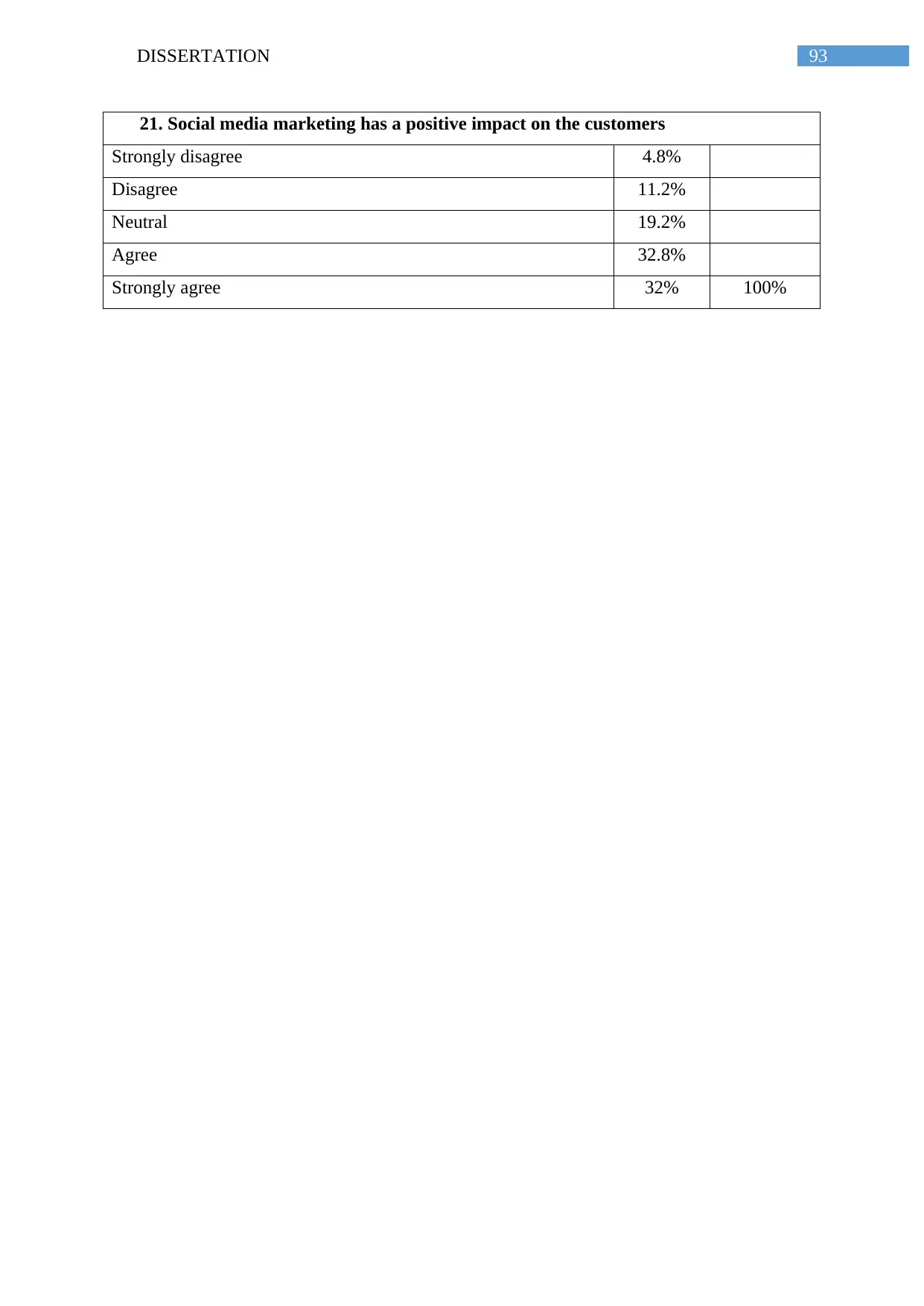
93DISSERTATION
21. Social media marketing has a positive impact on the customers
Strongly disagree 4.8%
Disagree 11.2%
Neutral 19.2%
Agree 32.8%
Strongly agree 32% 100%
21. Social media marketing has a positive impact on the customers
Strongly disagree 4.8%
Disagree 11.2%
Neutral 19.2%
Agree 32.8%
Strongly agree 32% 100%
Secure Best Marks with AI Grader
Need help grading? Try our AI Grader for instant feedback on your assignments.
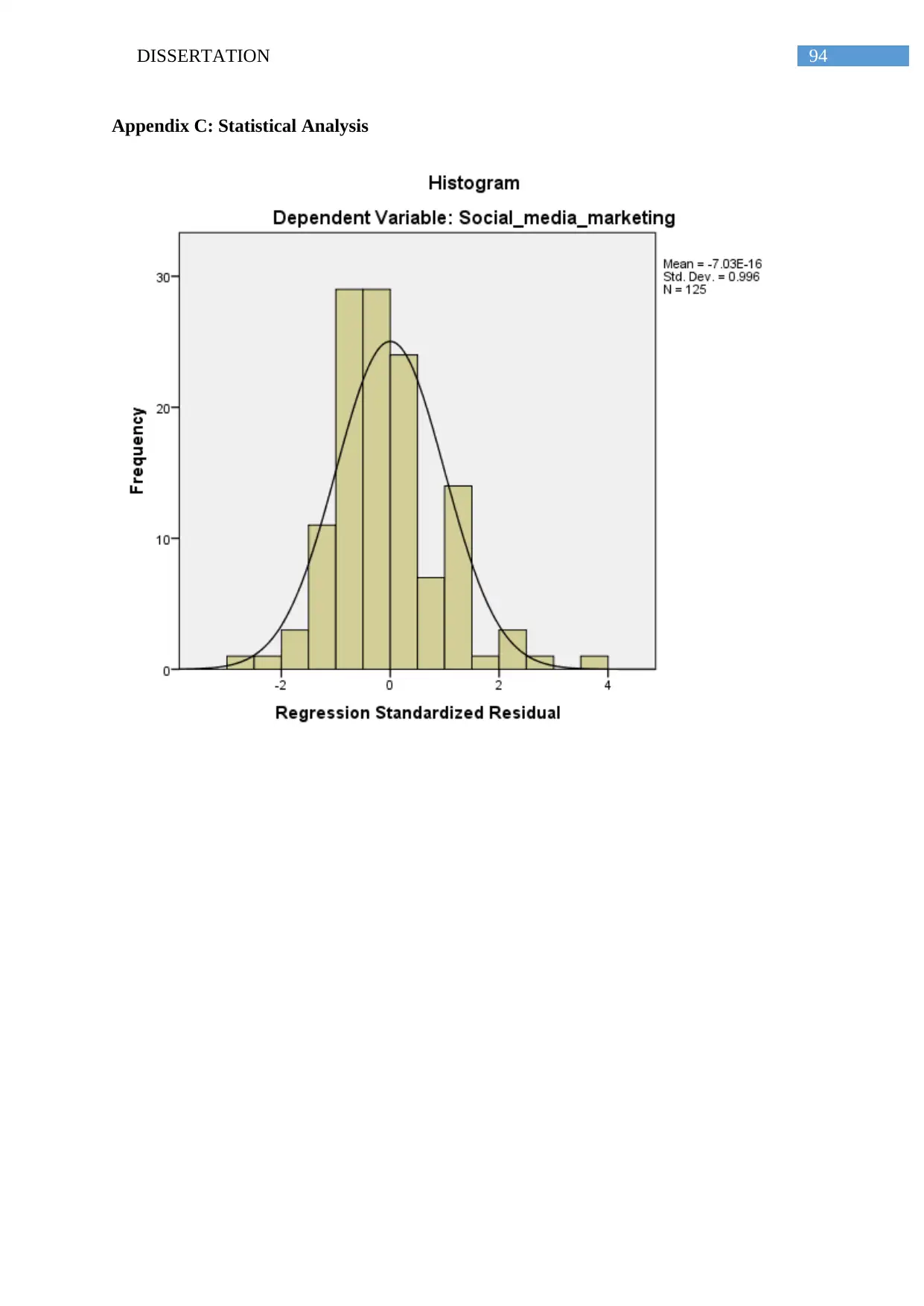
94DISSERTATION
Appendix C: Statistical Analysis
Appendix C: Statistical Analysis
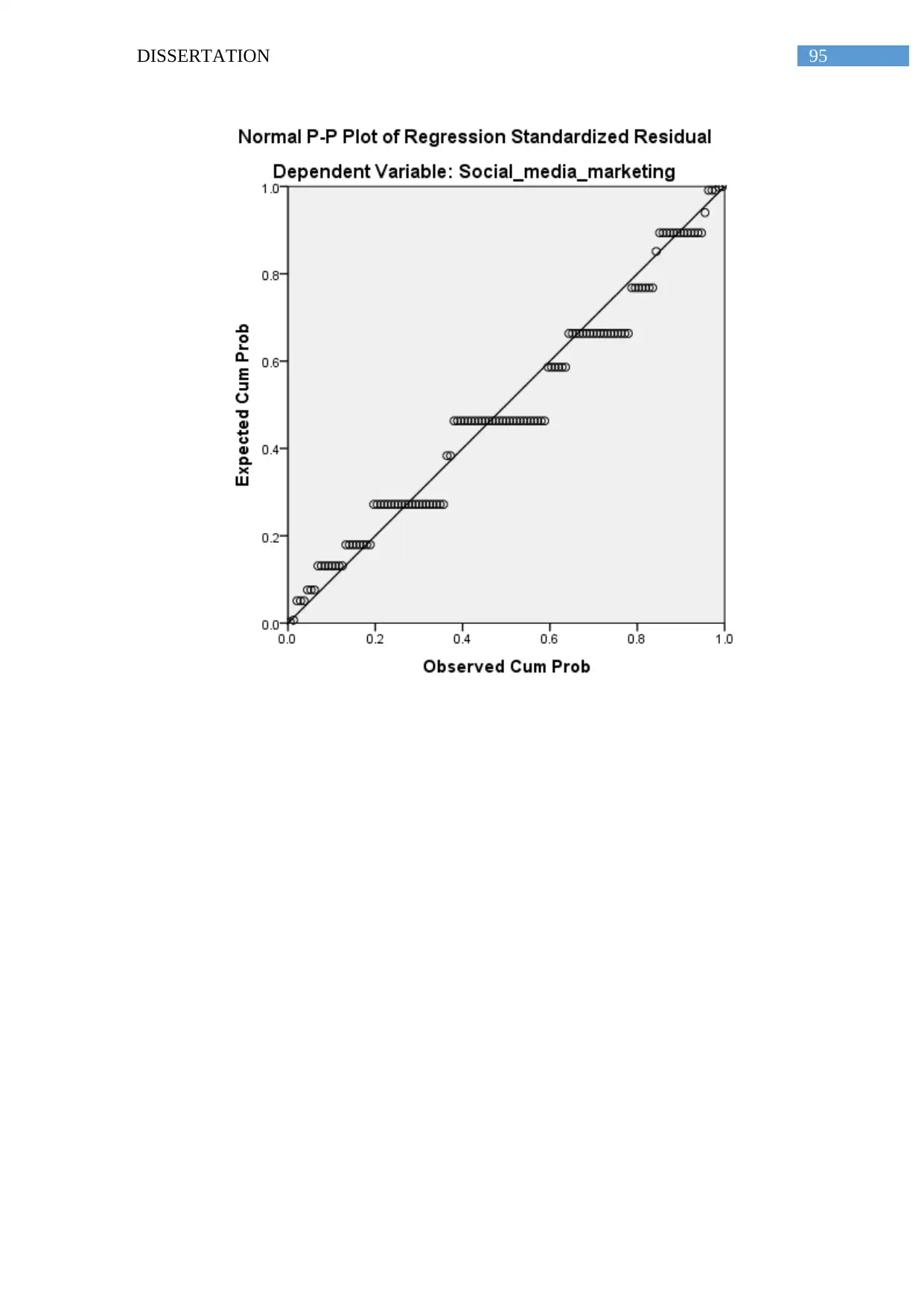
95DISSERTATION
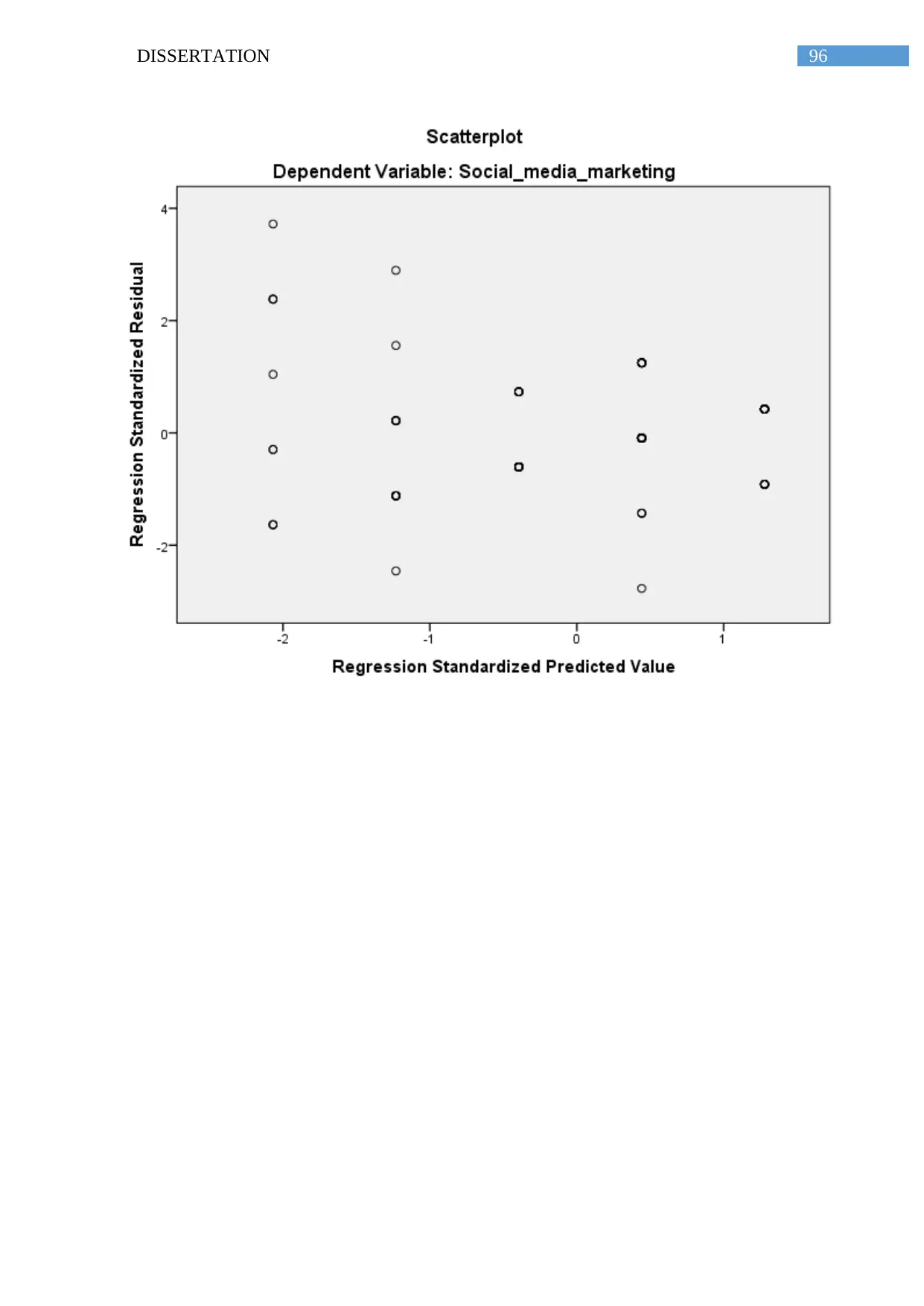
96DISSERTATION
Paraphrase This Document
Need a fresh take? Get an instant paraphrase of this document with our AI Paraphraser
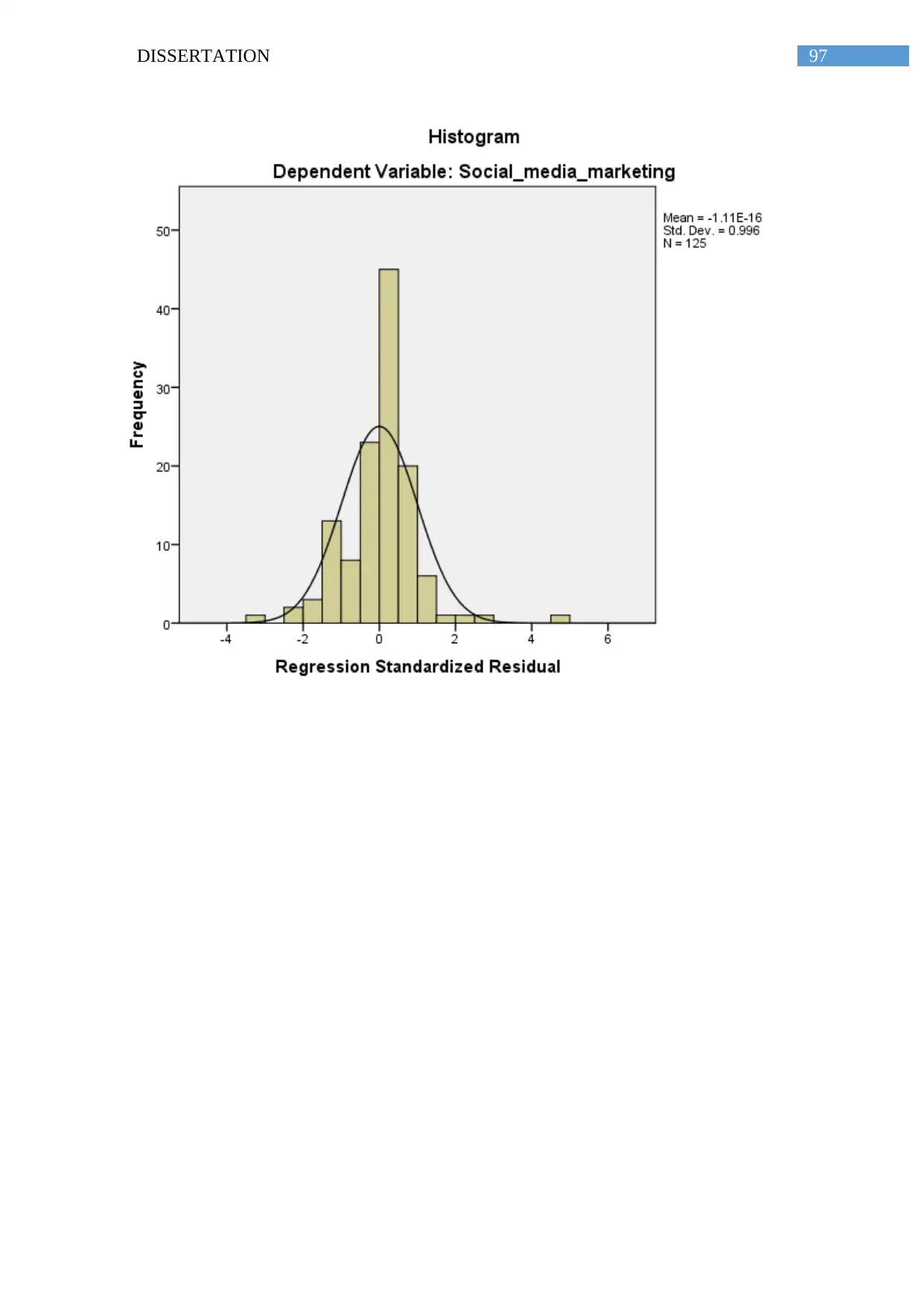
97DISSERTATION
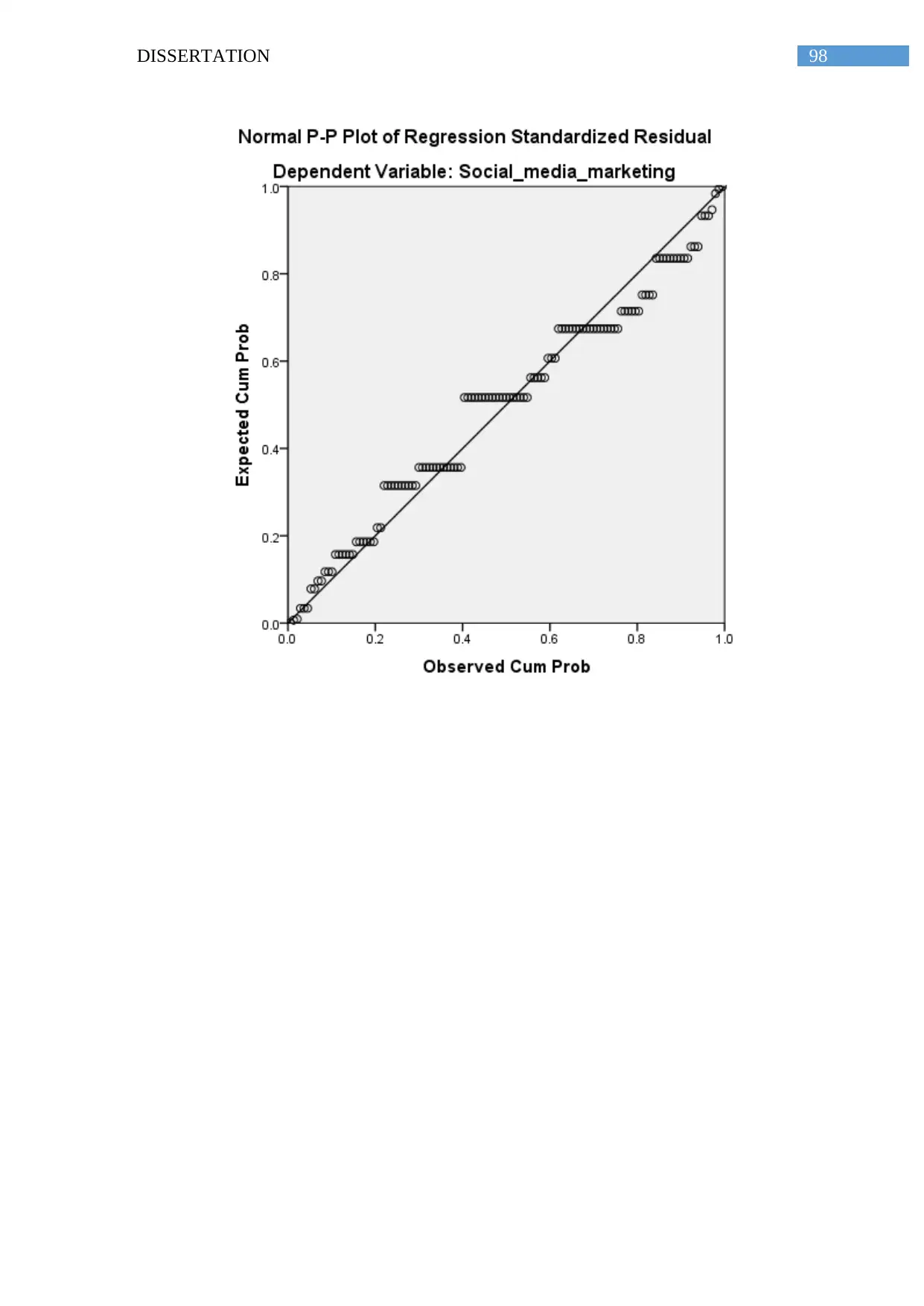
98DISSERTATION
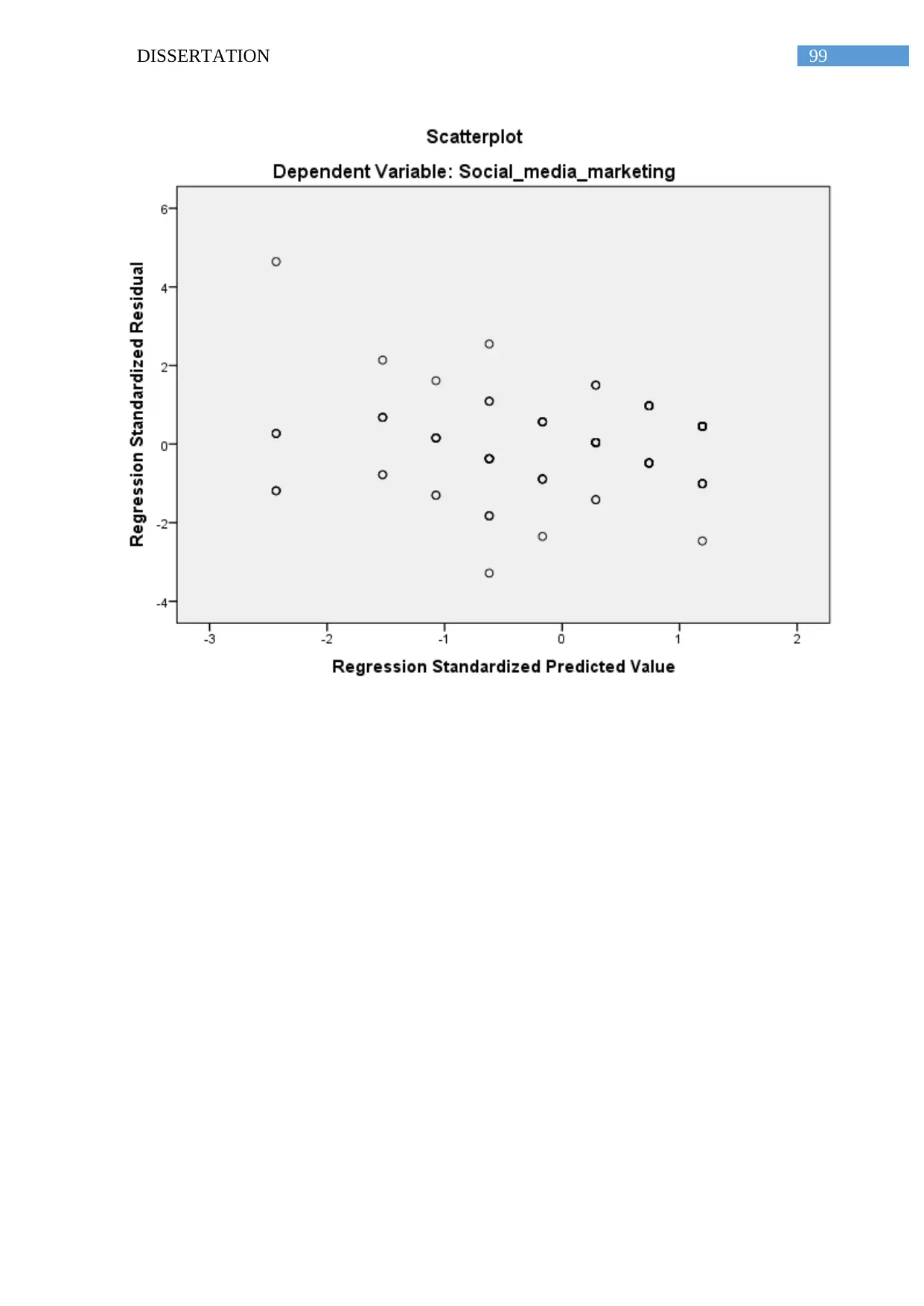
99DISSERTATION
Secure Best Marks with AI Grader
Need help grading? Try our AI Grader for instant feedback on your assignments.
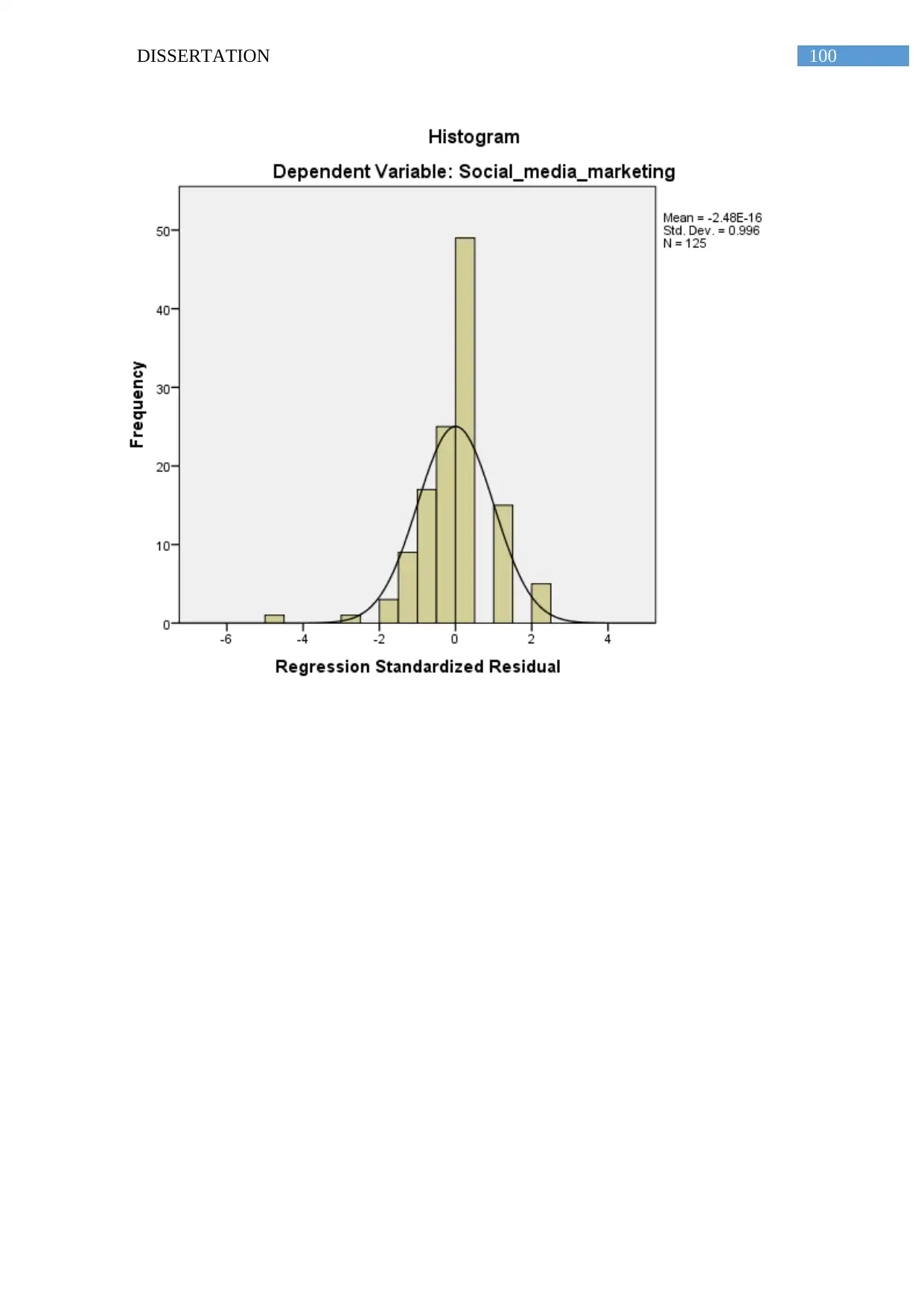
100DISSERTATION
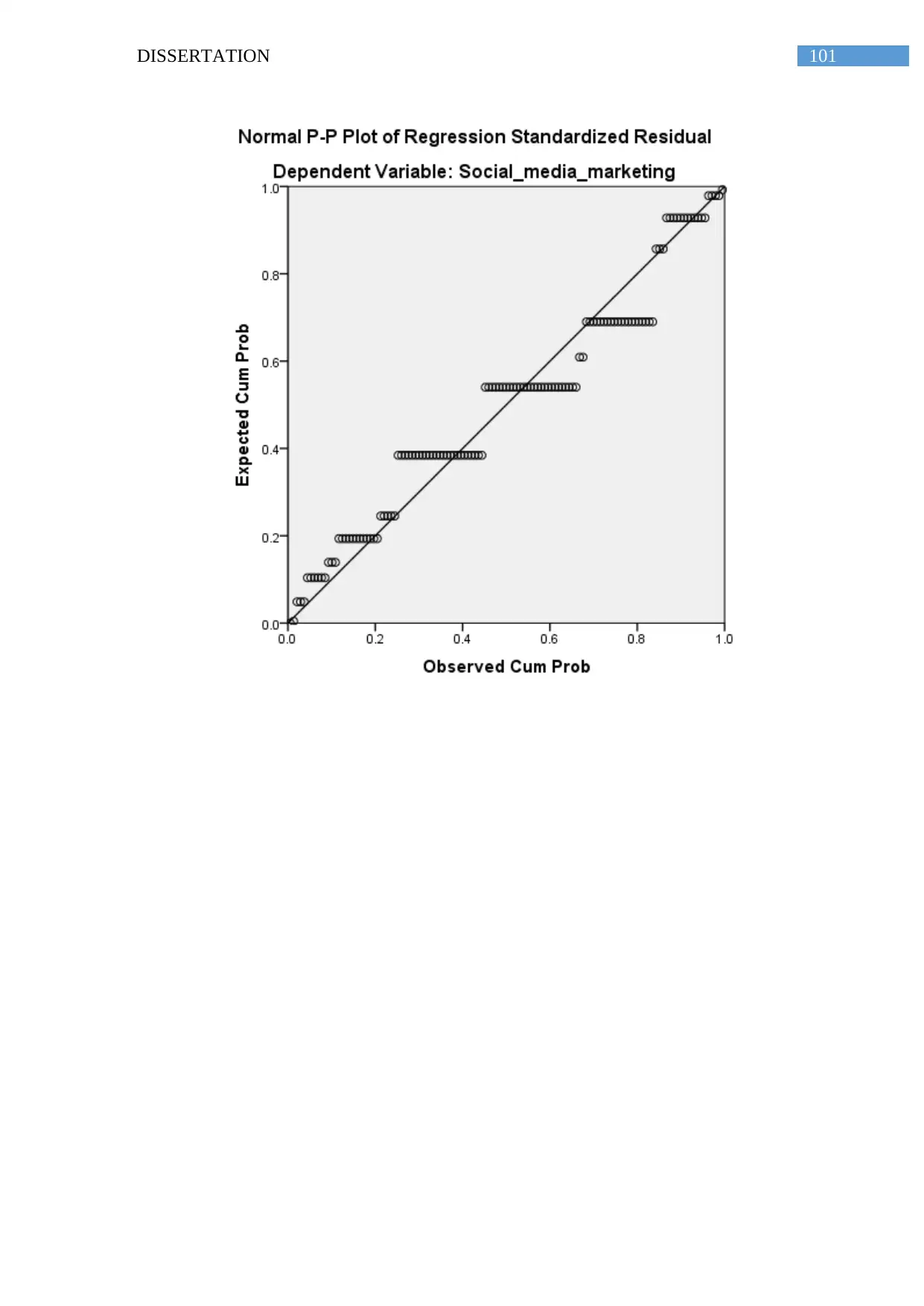
101DISSERTATION
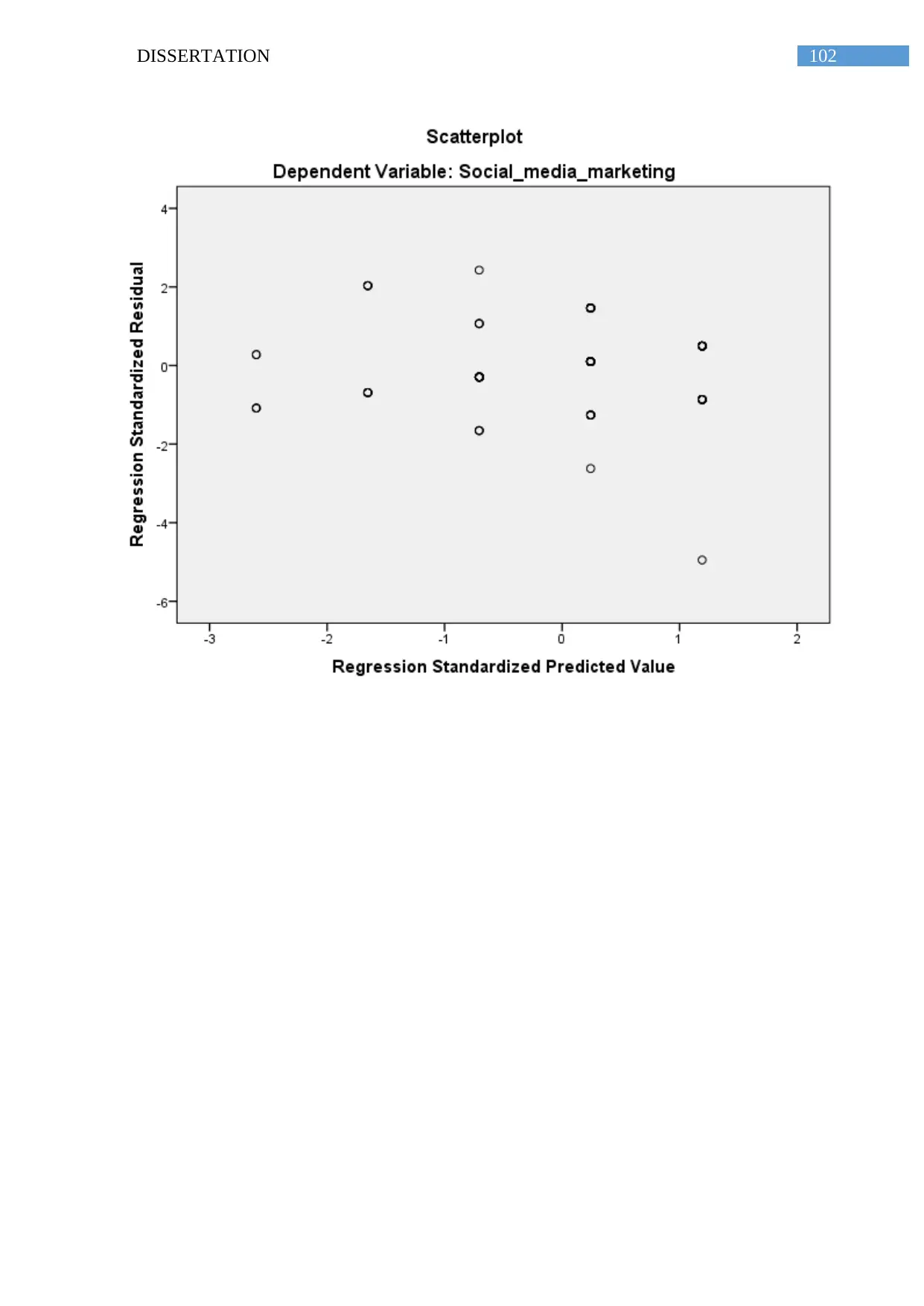
102DISSERTATION
Paraphrase This Document
Need a fresh take? Get an instant paraphrase of this document with our AI Paraphraser
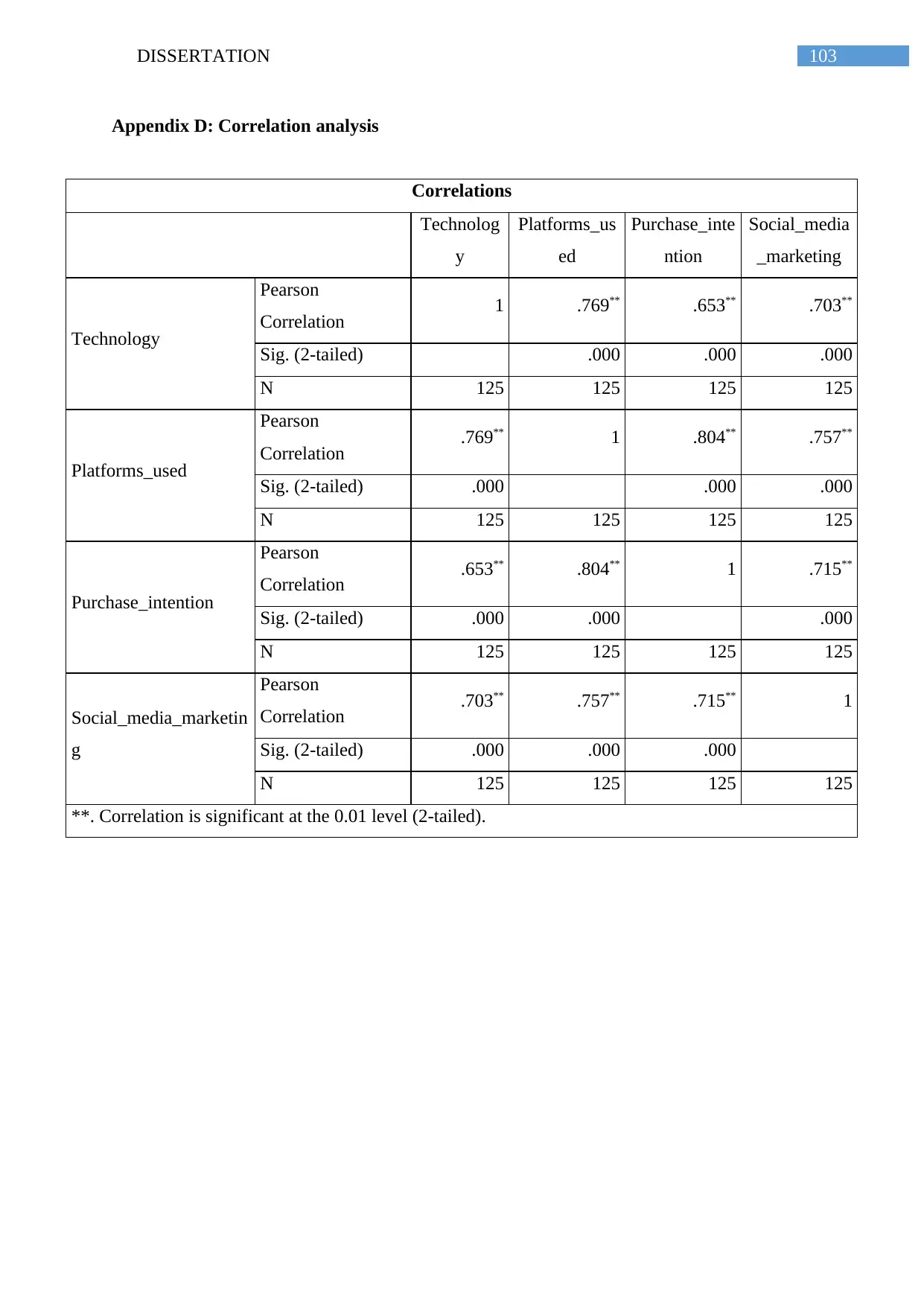
103DISSERTATION
Appendix D: Correlation analysis
Correlations
Technolog
y
Platforms_us
ed
Purchase_inte
ntion
Social_media
_marketing
Technology
Pearson
Correlation 1 .769** .653** .703**
Sig. (2-tailed) .000 .000 .000
N 125 125 125 125
Platforms_used
Pearson
Correlation .769** 1 .804** .757**
Sig. (2-tailed) .000 .000 .000
N 125 125 125 125
Purchase_intention
Pearson
Correlation .653** .804** 1 .715**
Sig. (2-tailed) .000 .000 .000
N 125 125 125 125
Social_media_marketin
g
Pearson
Correlation .703** .757** .715** 1
Sig. (2-tailed) .000 .000 .000
N 125 125 125 125
**. Correlation is significant at the 0.01 level (2-tailed).
Appendix D: Correlation analysis
Correlations
Technolog
y
Platforms_us
ed
Purchase_inte
ntion
Social_media
_marketing
Technology
Pearson
Correlation 1 .769** .653** .703**
Sig. (2-tailed) .000 .000 .000
N 125 125 125 125
Platforms_used
Pearson
Correlation .769** 1 .804** .757**
Sig. (2-tailed) .000 .000 .000
N 125 125 125 125
Purchase_intention
Pearson
Correlation .653** .804** 1 .715**
Sig. (2-tailed) .000 .000 .000
N 125 125 125 125
Social_media_marketin
g
Pearson
Correlation .703** .757** .715** 1
Sig. (2-tailed) .000 .000 .000
N 125 125 125 125
**. Correlation is significant at the 0.01 level (2-tailed).
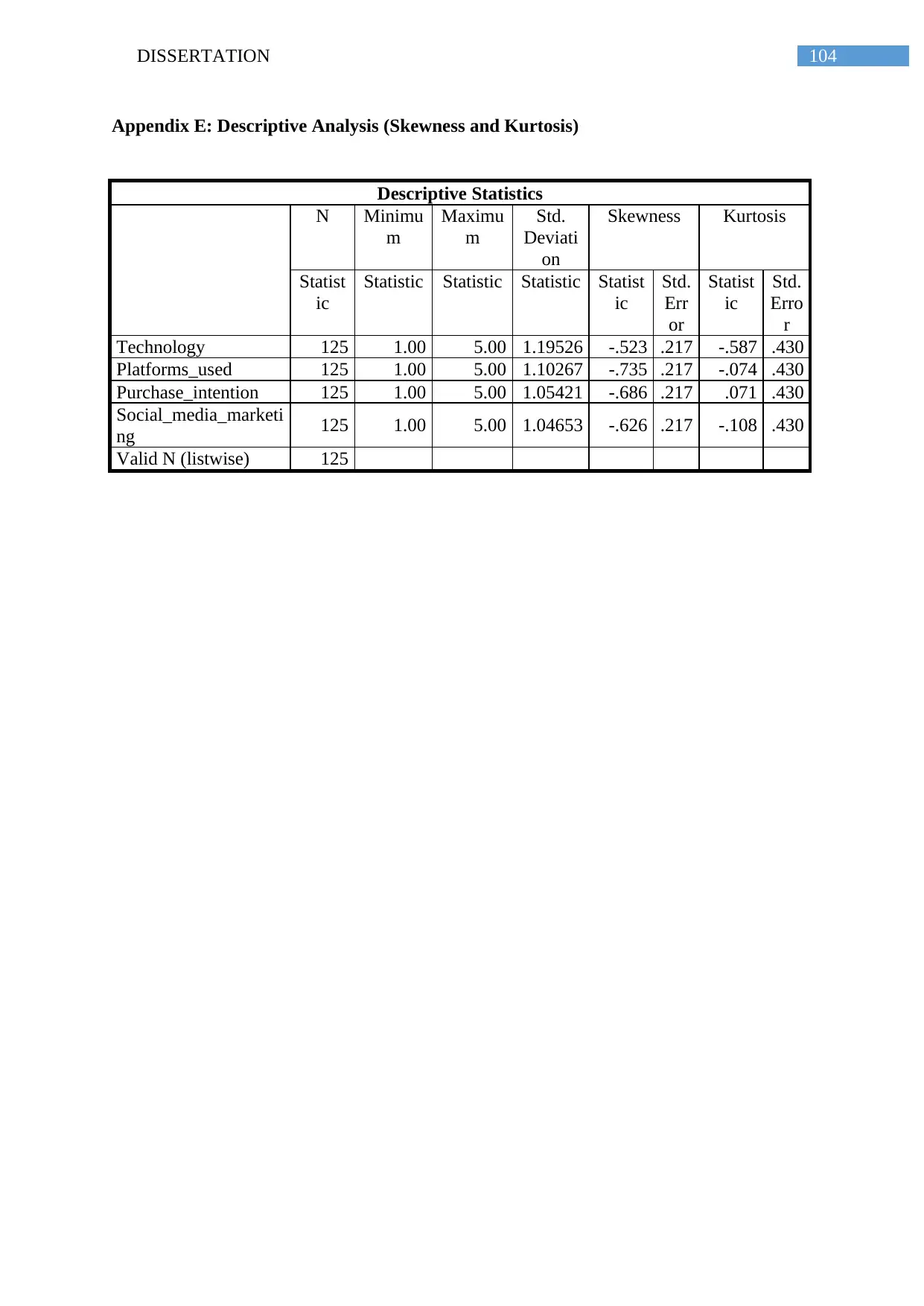
104DISSERTATION
Appendix E: Descriptive Analysis (Skewness and Kurtosis)
Descriptive Statistics
N Minimu
m
Maximu
m
Std.
Deviati
on
Skewness Kurtosis
Statist
ic
Statistic Statistic Statistic Statist
ic
Std.
Err
or
Statist
ic
Std.
Erro
r
Technology 125 1.00 5.00 1.19526 -.523 .217 -.587 .430
Platforms_used 125 1.00 5.00 1.10267 -.735 .217 -.074 .430
Purchase_intention 125 1.00 5.00 1.05421 -.686 .217 .071 .430
Social_media_marketi
ng 125 1.00 5.00 1.04653 -.626 .217 -.108 .430
Valid N (listwise) 125
Appendix E: Descriptive Analysis (Skewness and Kurtosis)
Descriptive Statistics
N Minimu
m
Maximu
m
Std.
Deviati
on
Skewness Kurtosis
Statist
ic
Statistic Statistic Statistic Statist
ic
Std.
Err
or
Statist
ic
Std.
Erro
r
Technology 125 1.00 5.00 1.19526 -.523 .217 -.587 .430
Platforms_used 125 1.00 5.00 1.10267 -.735 .217 -.074 .430
Purchase_intention 125 1.00 5.00 1.05421 -.686 .217 .071 .430
Social_media_marketi
ng 125 1.00 5.00 1.04653 -.626 .217 -.108 .430
Valid N (listwise) 125
1 out of 105
Related Documents
Your All-in-One AI-Powered Toolkit for Academic Success.
+13062052269
info@desklib.com
Available 24*7 on WhatsApp / Email
![[object Object]](/_next/static/media/star-bottom.7253800d.svg)
Unlock your academic potential
© 2024 | Zucol Services PVT LTD | All rights reserved.




